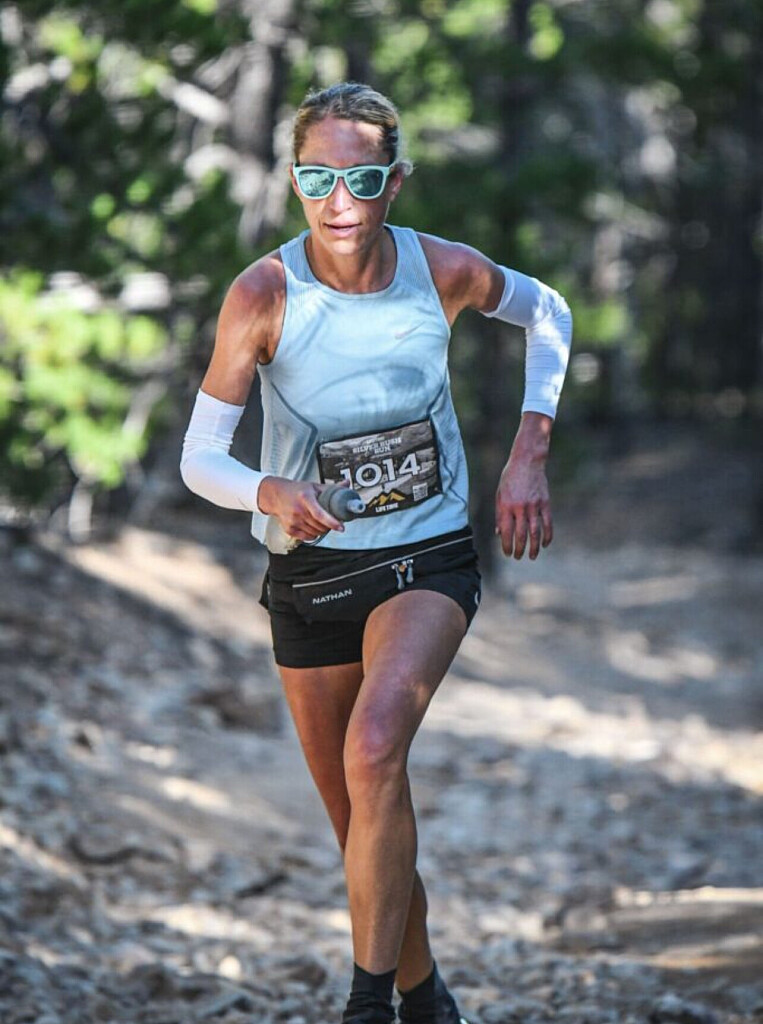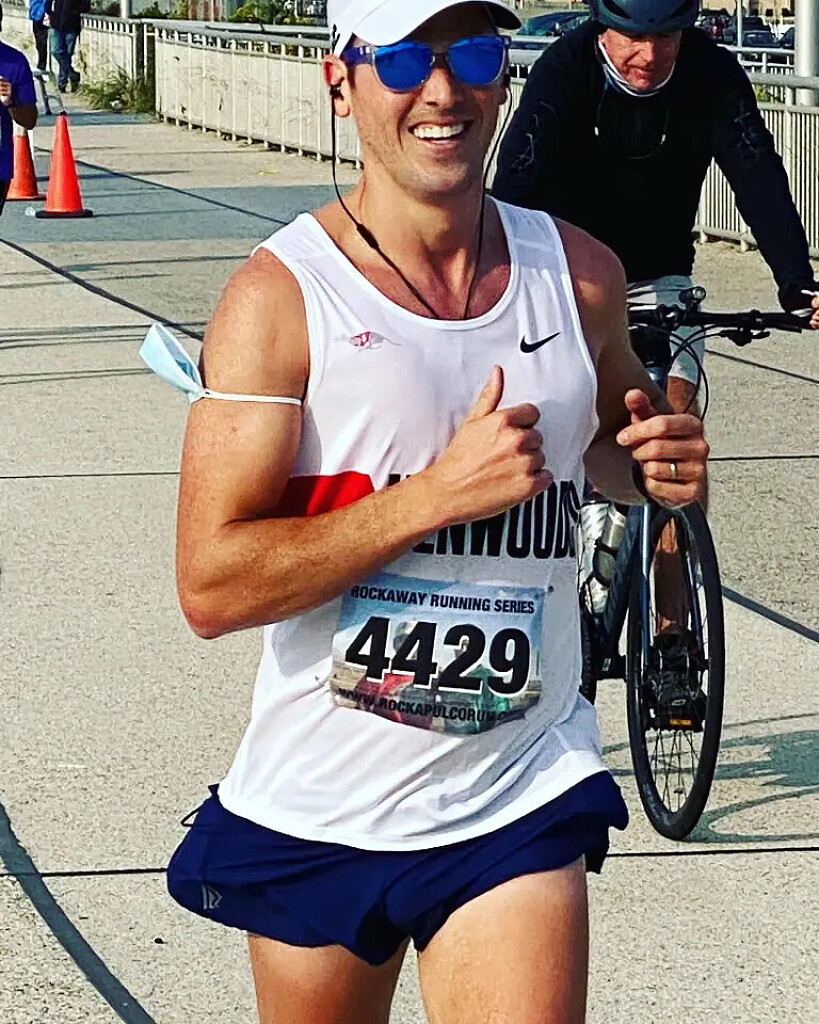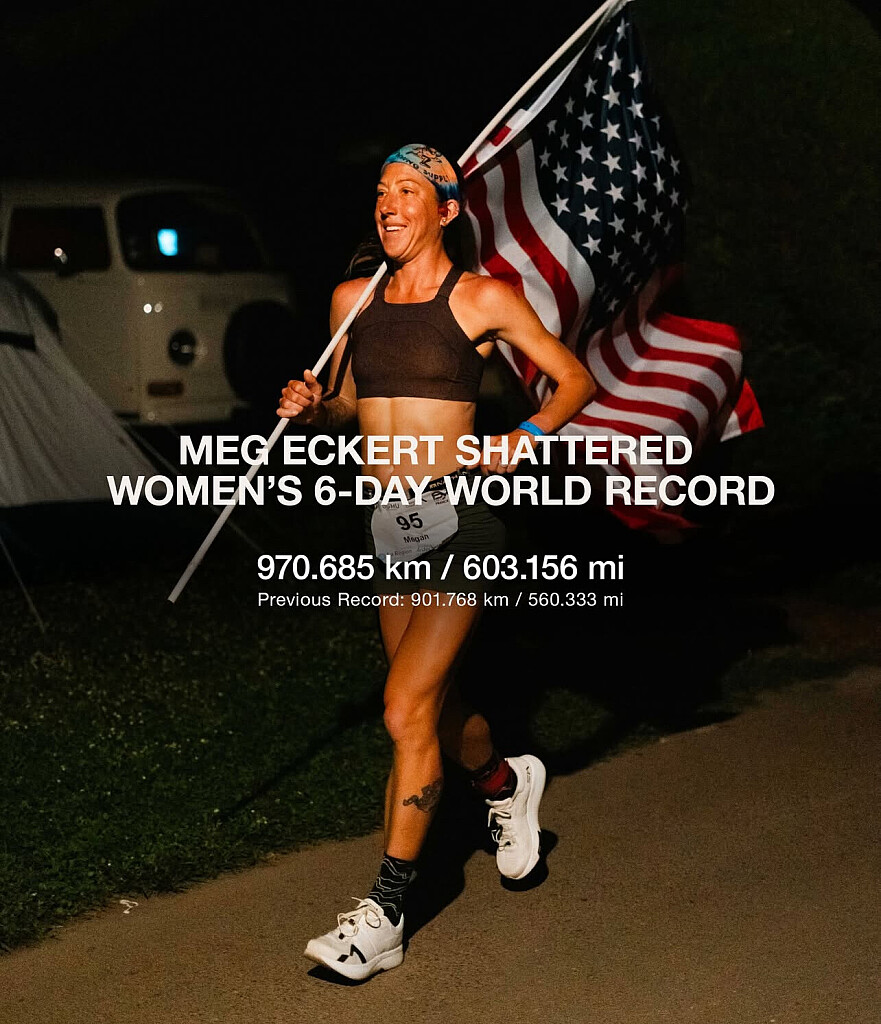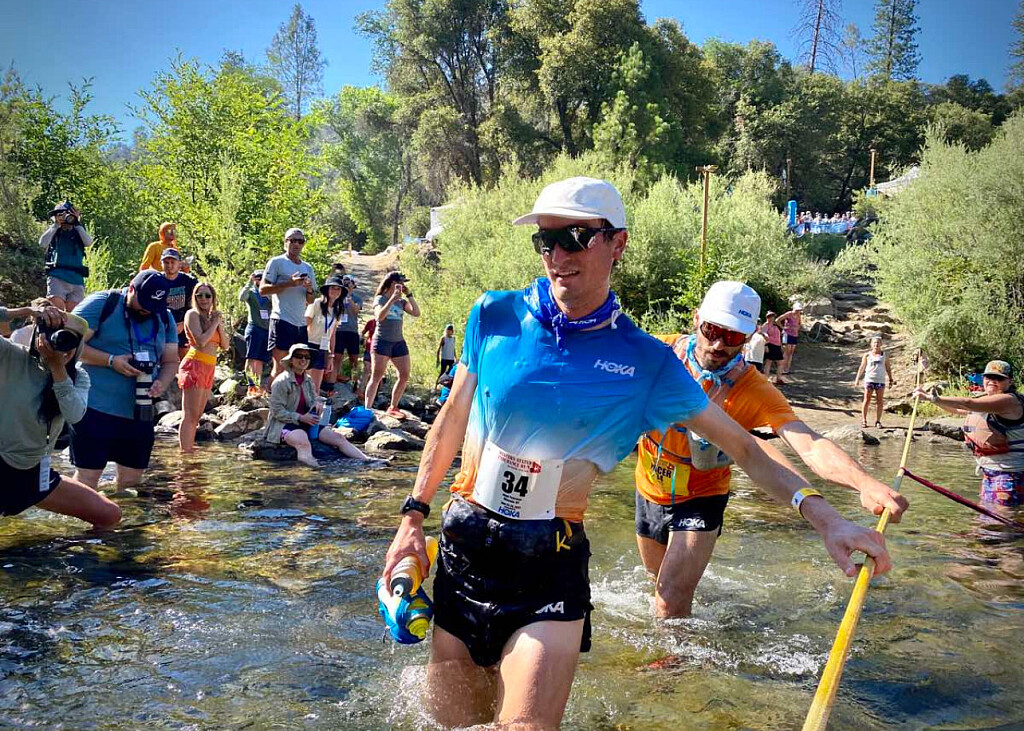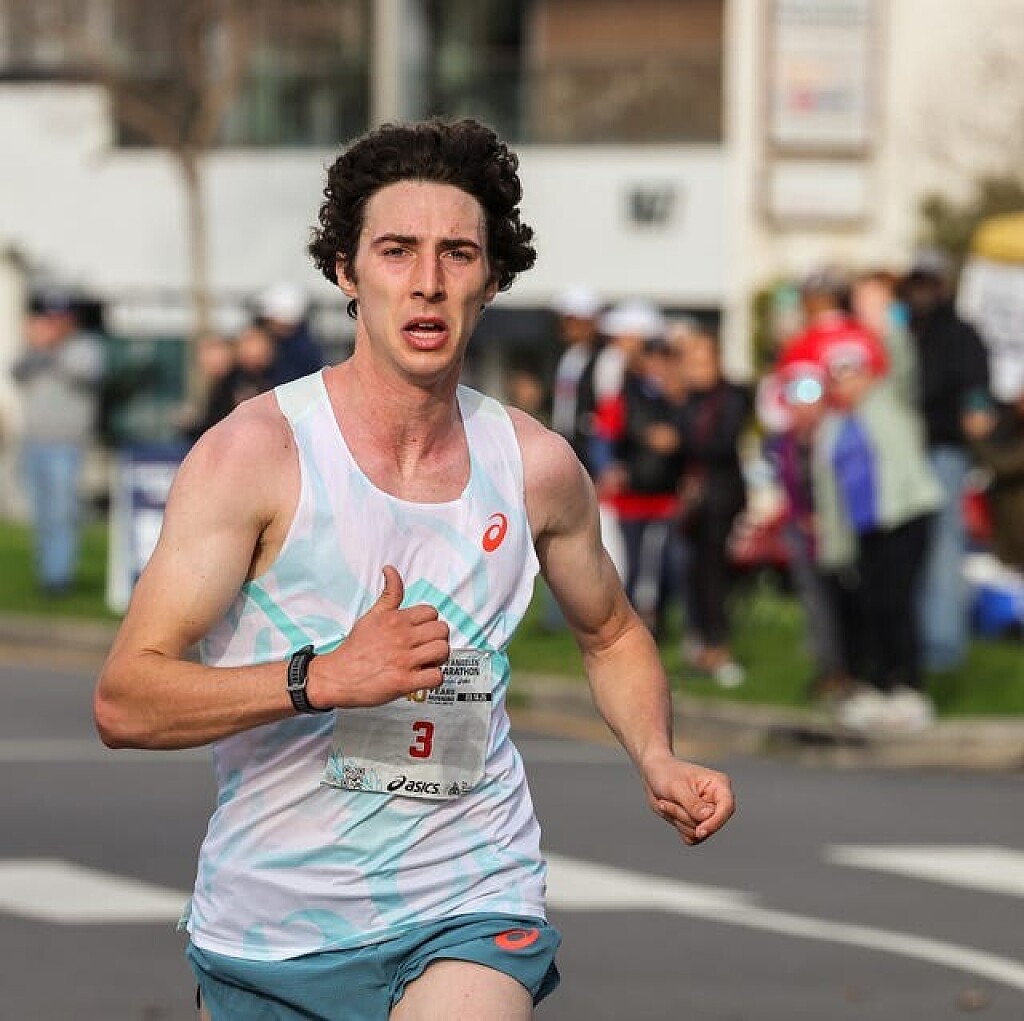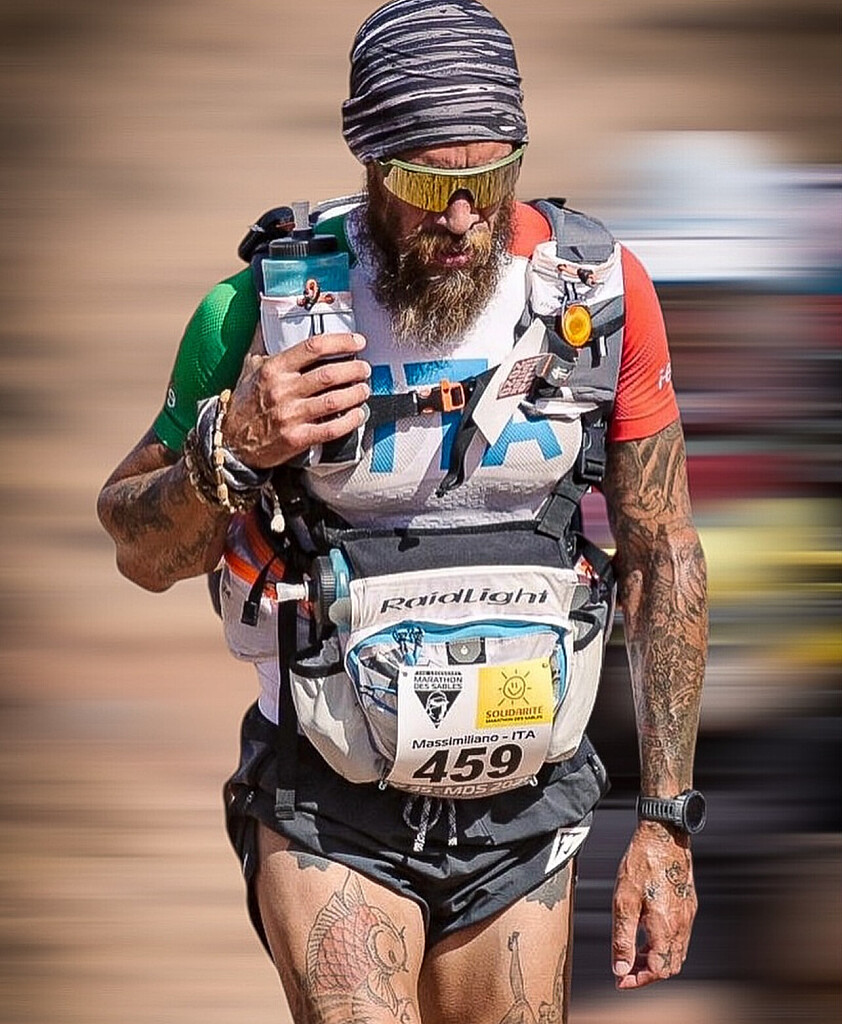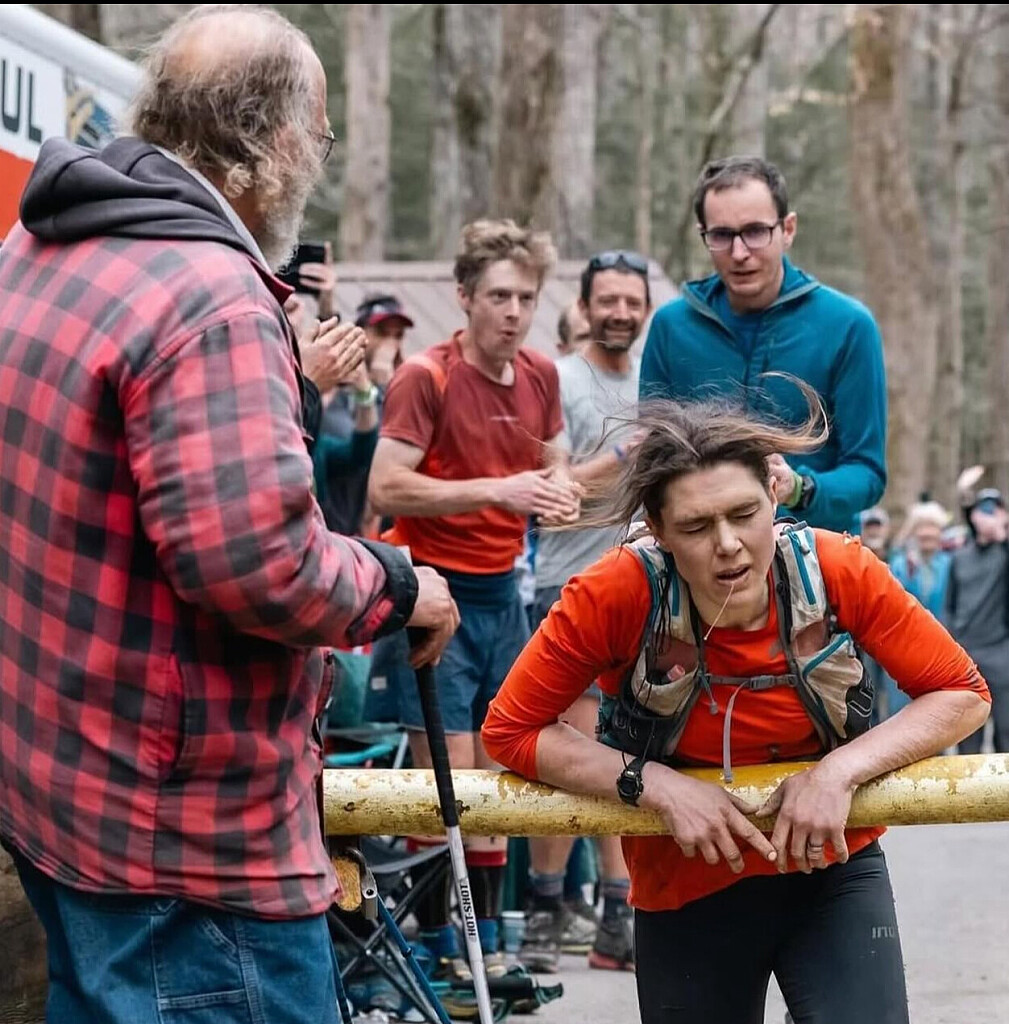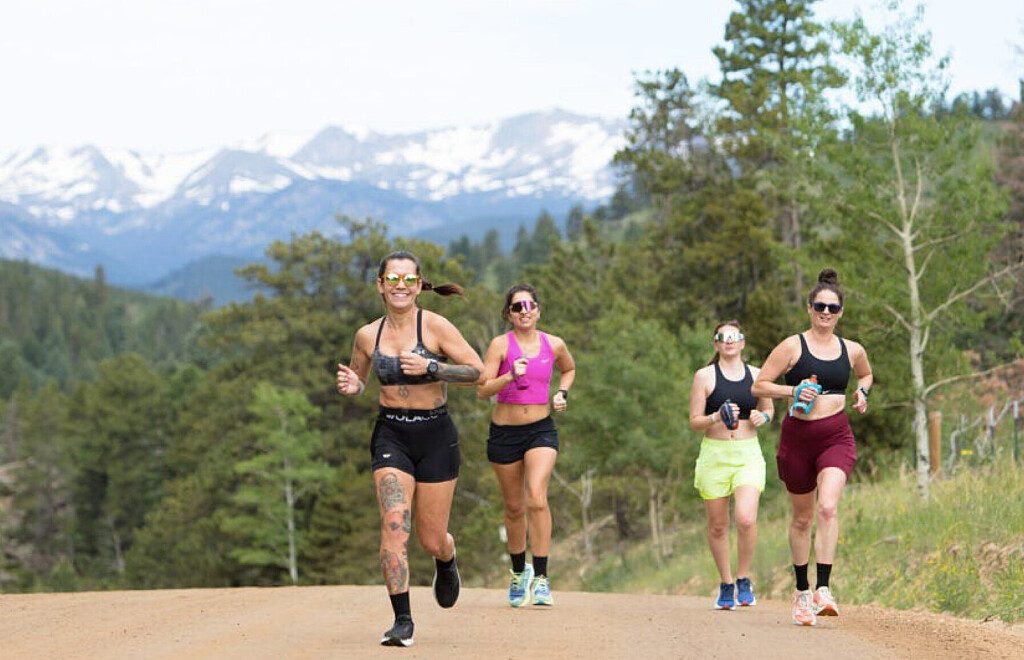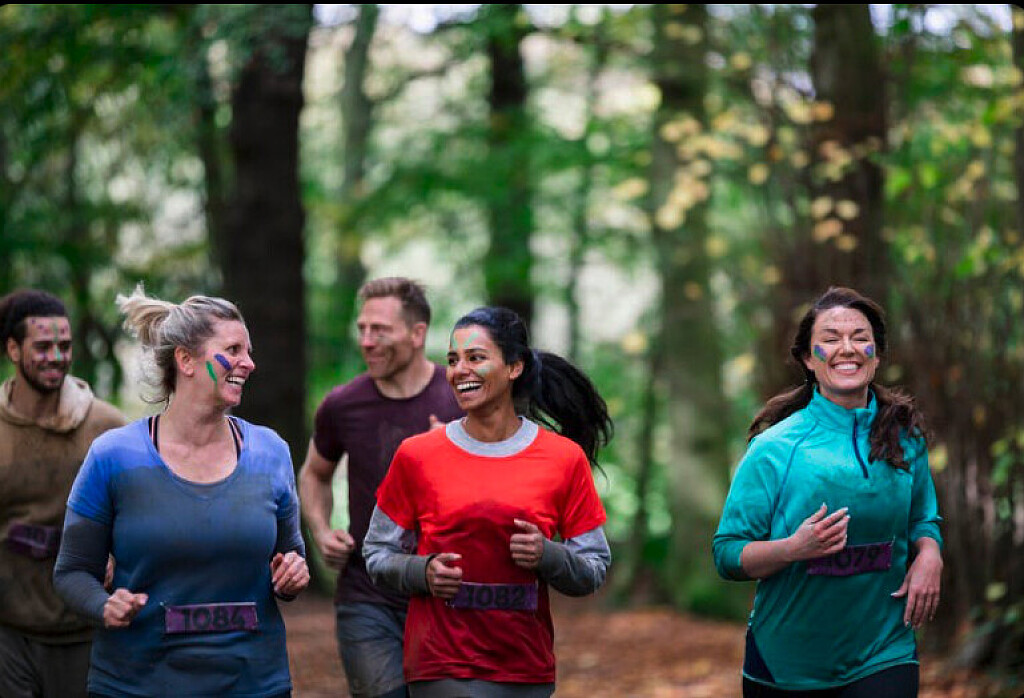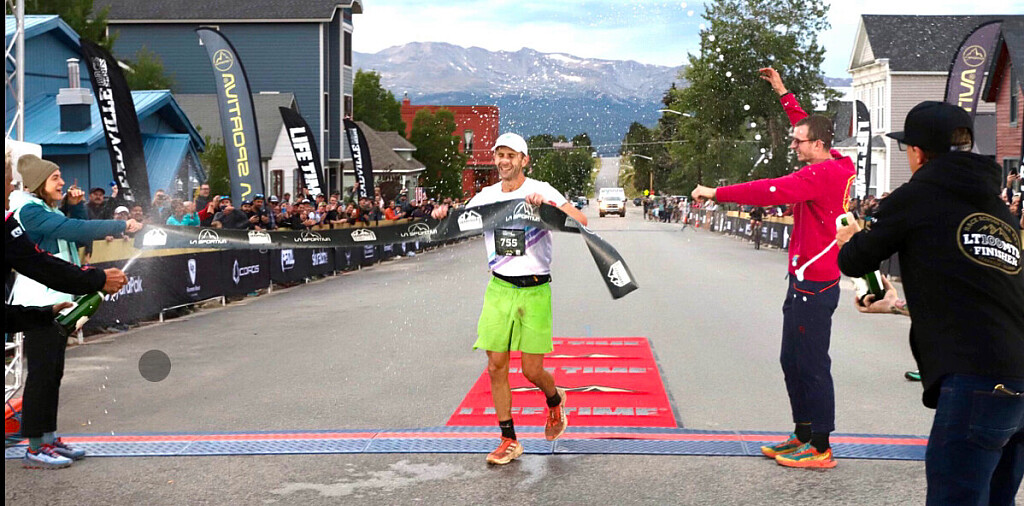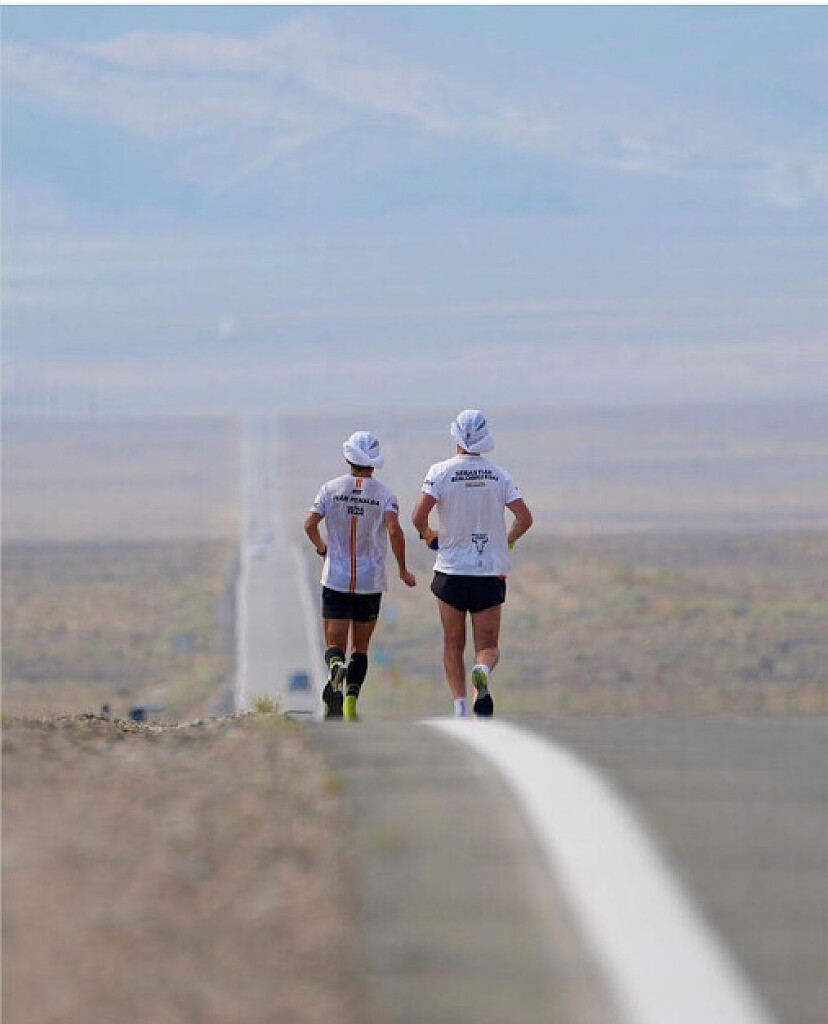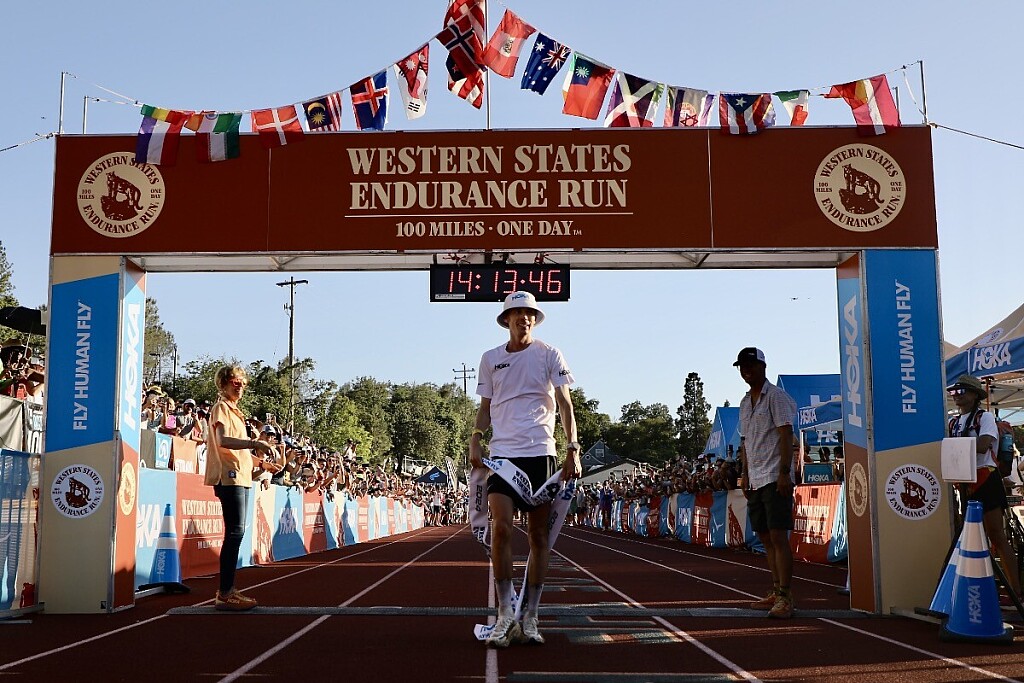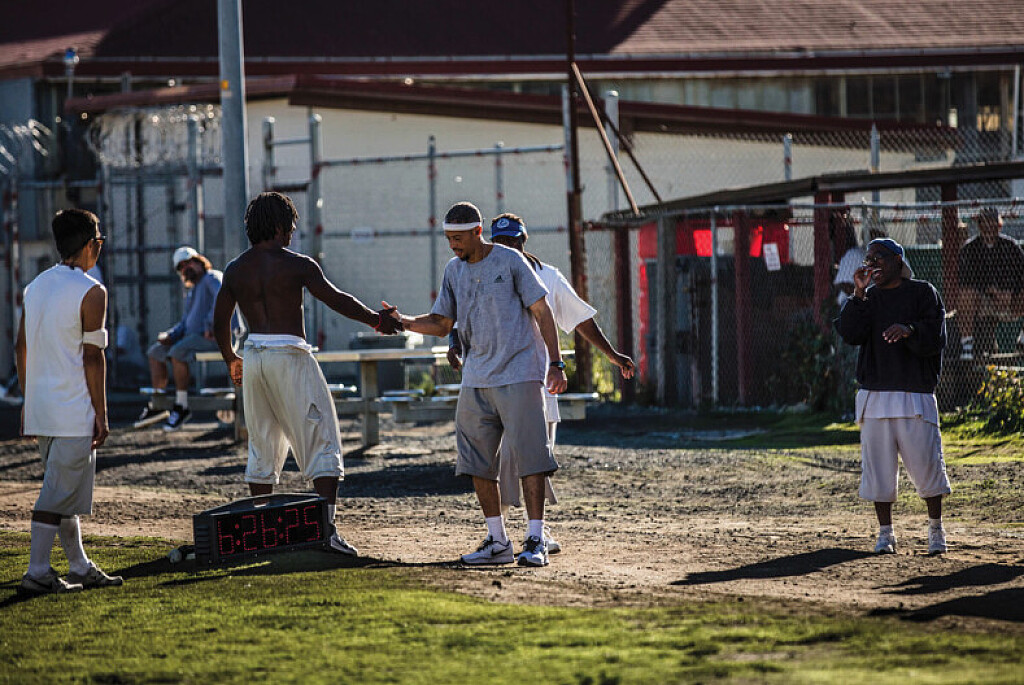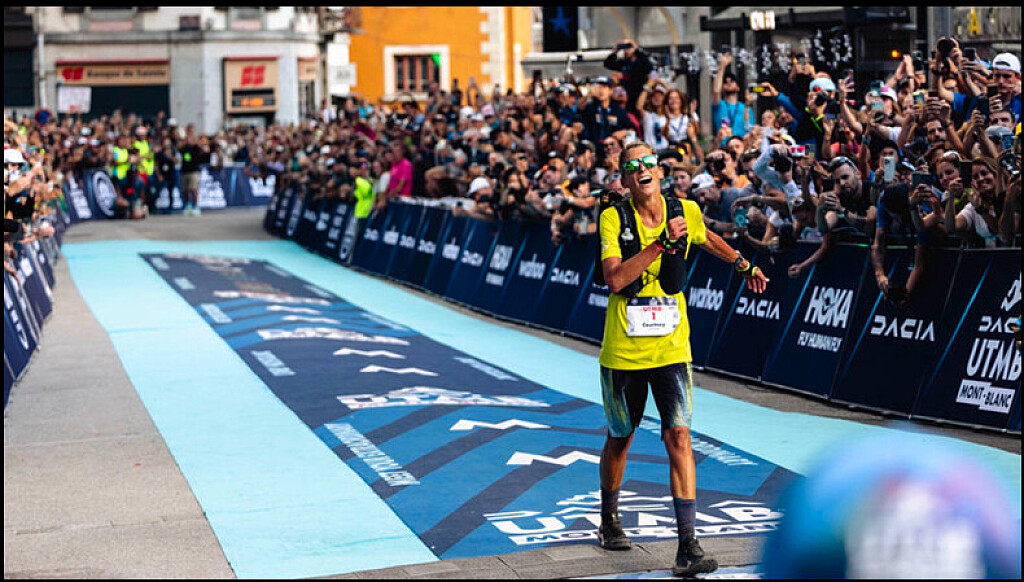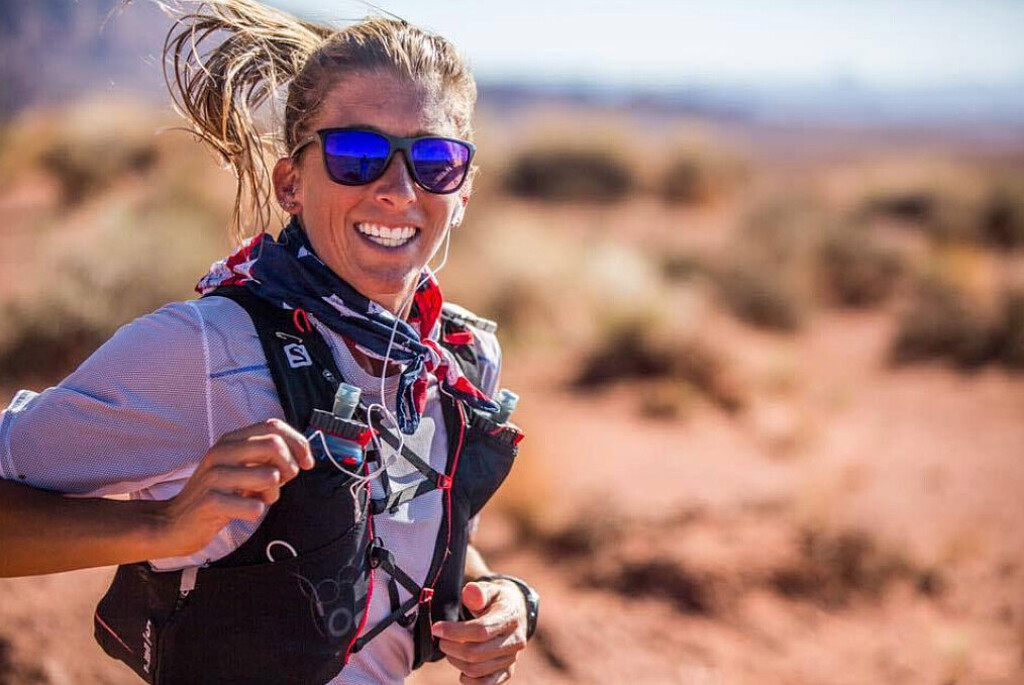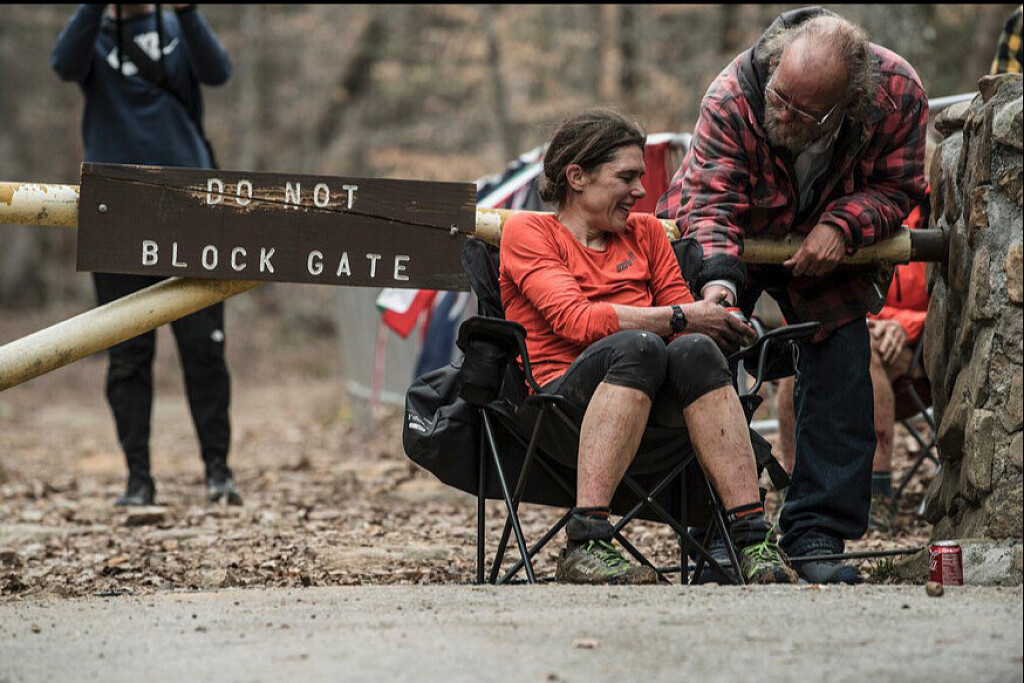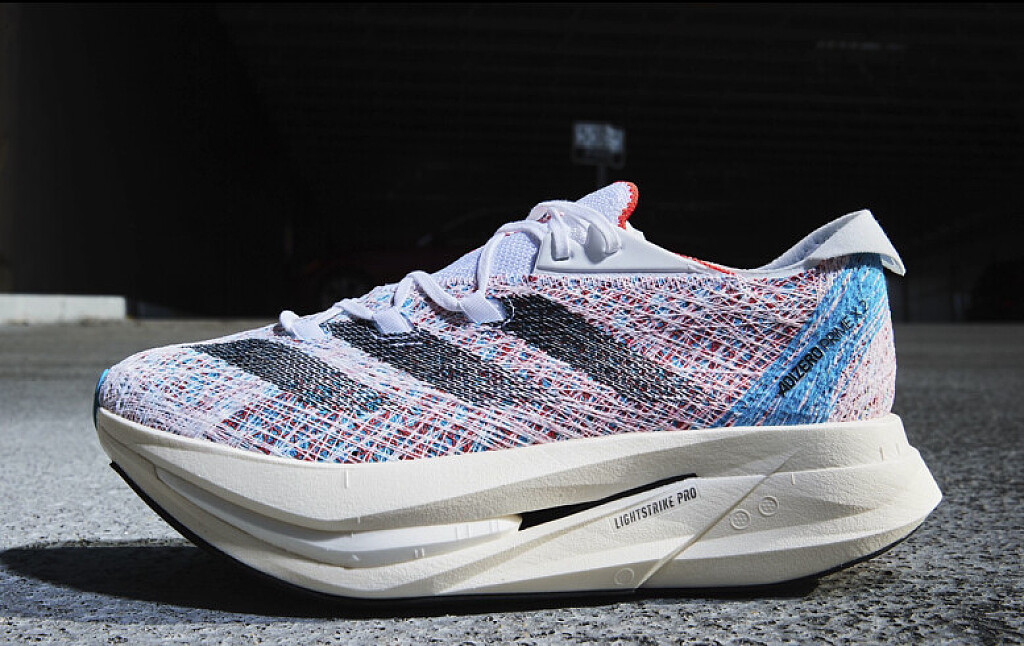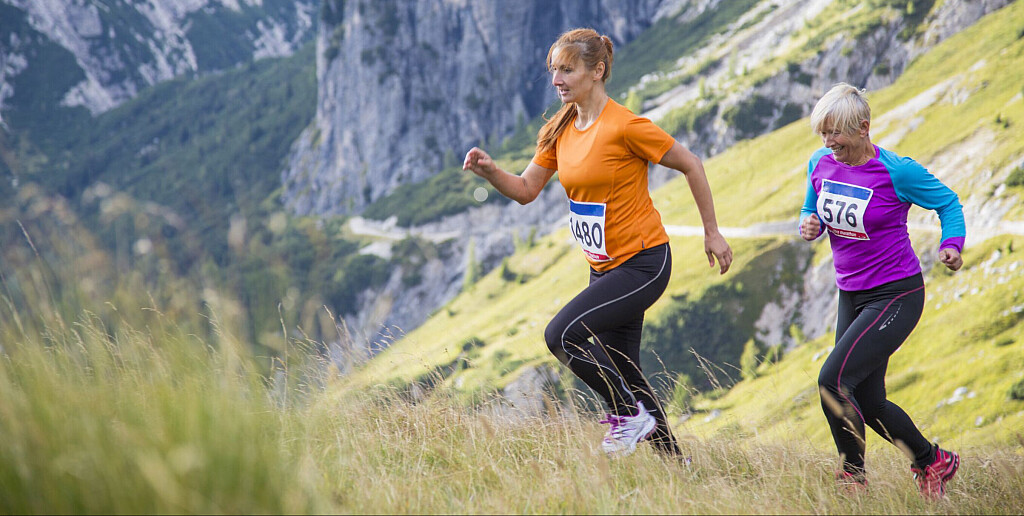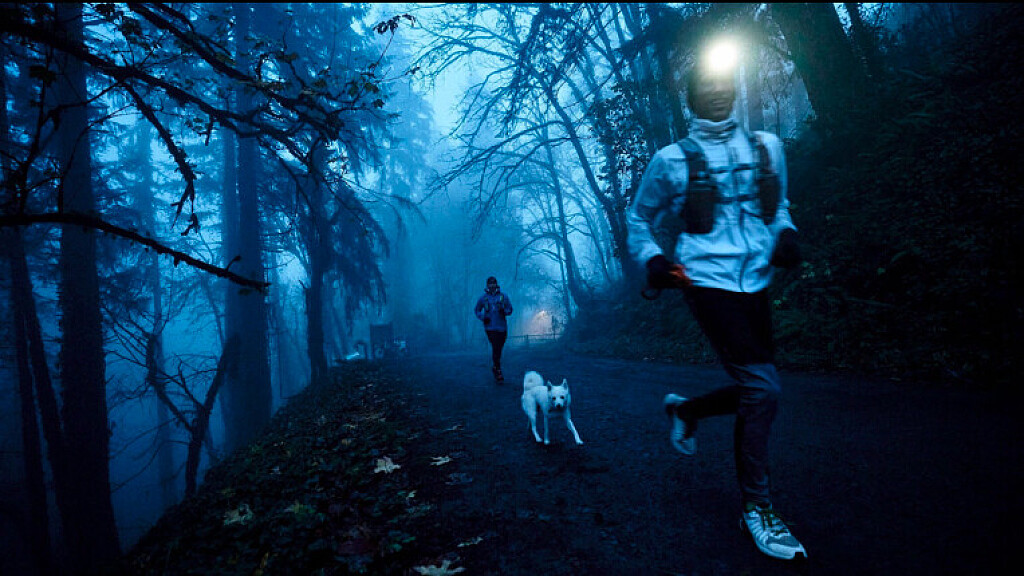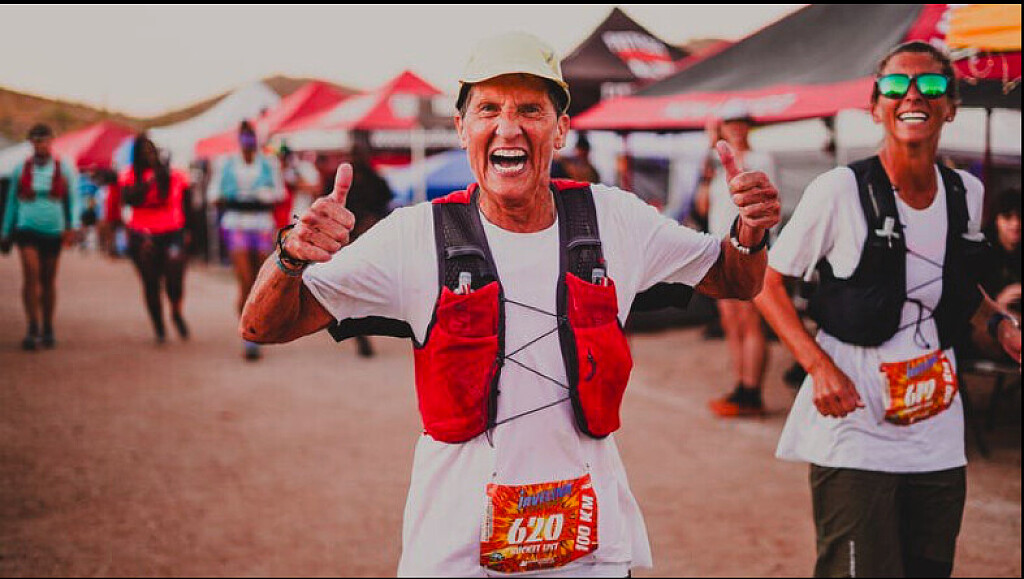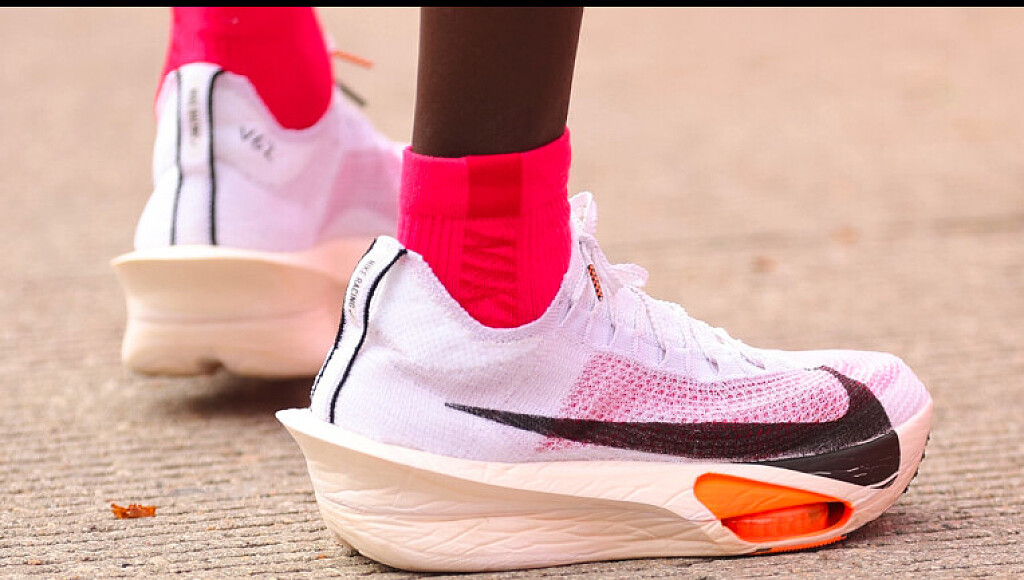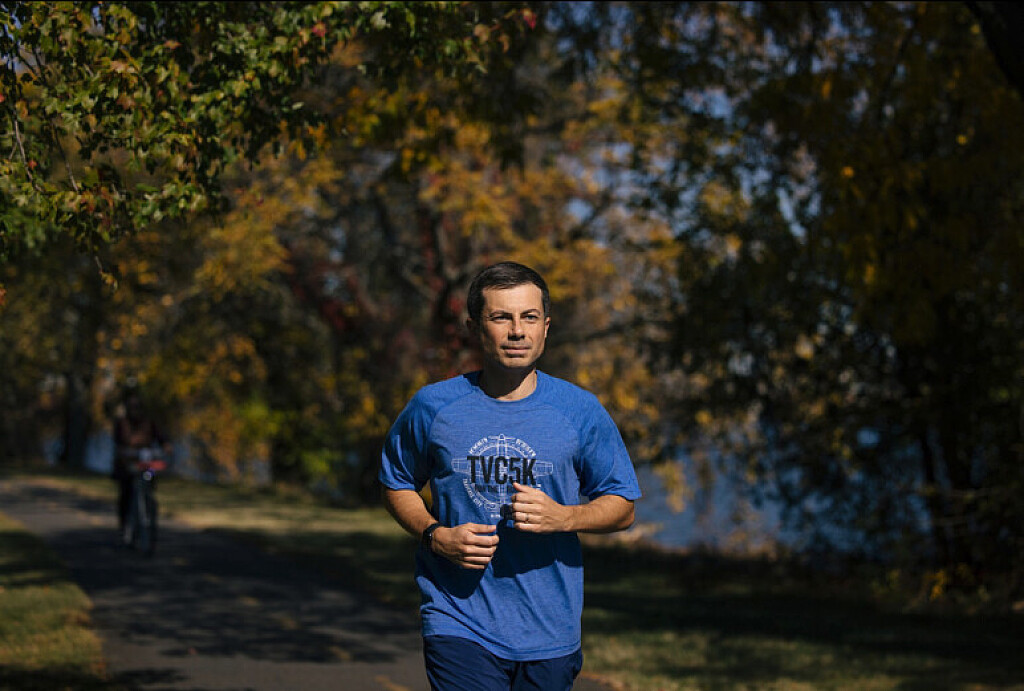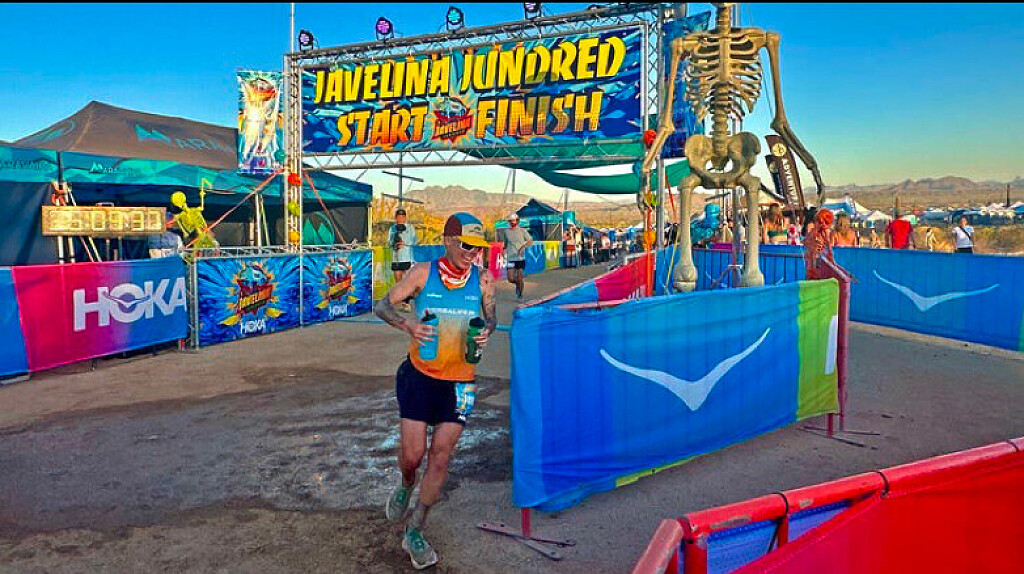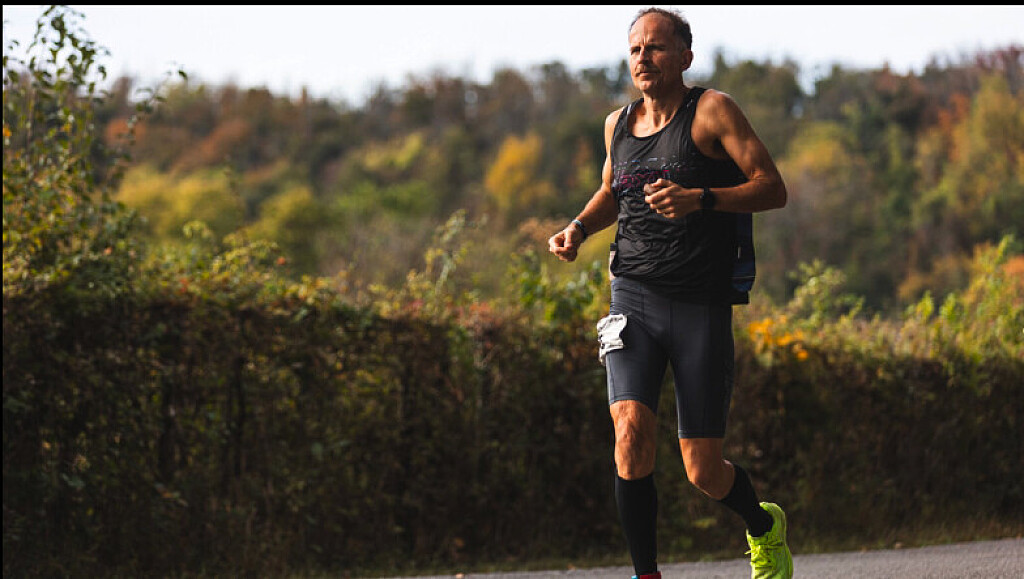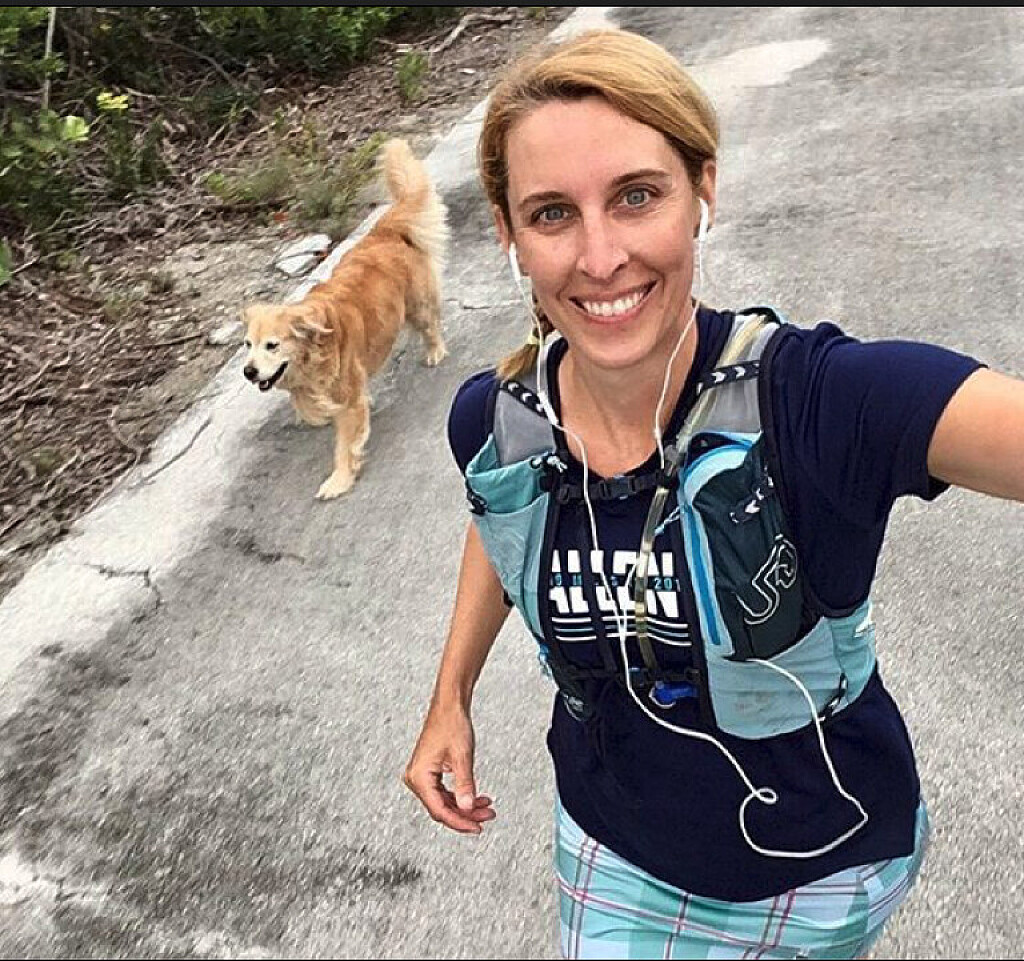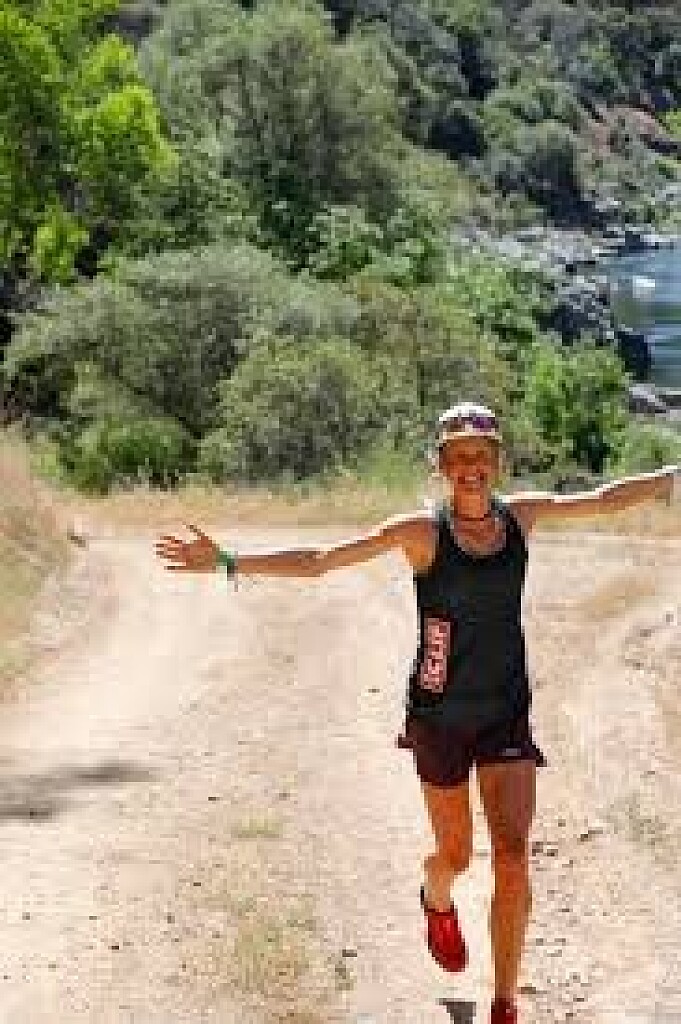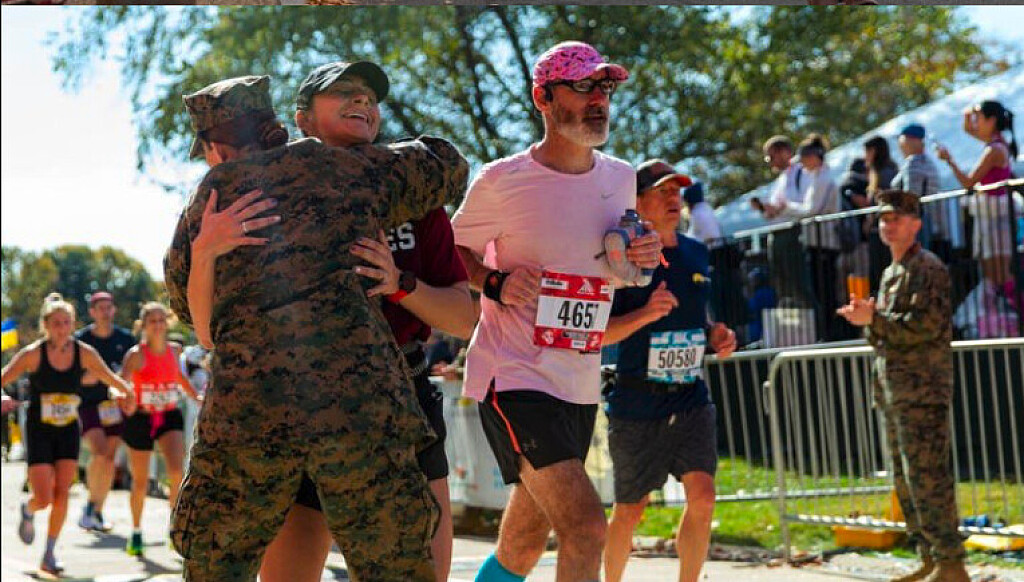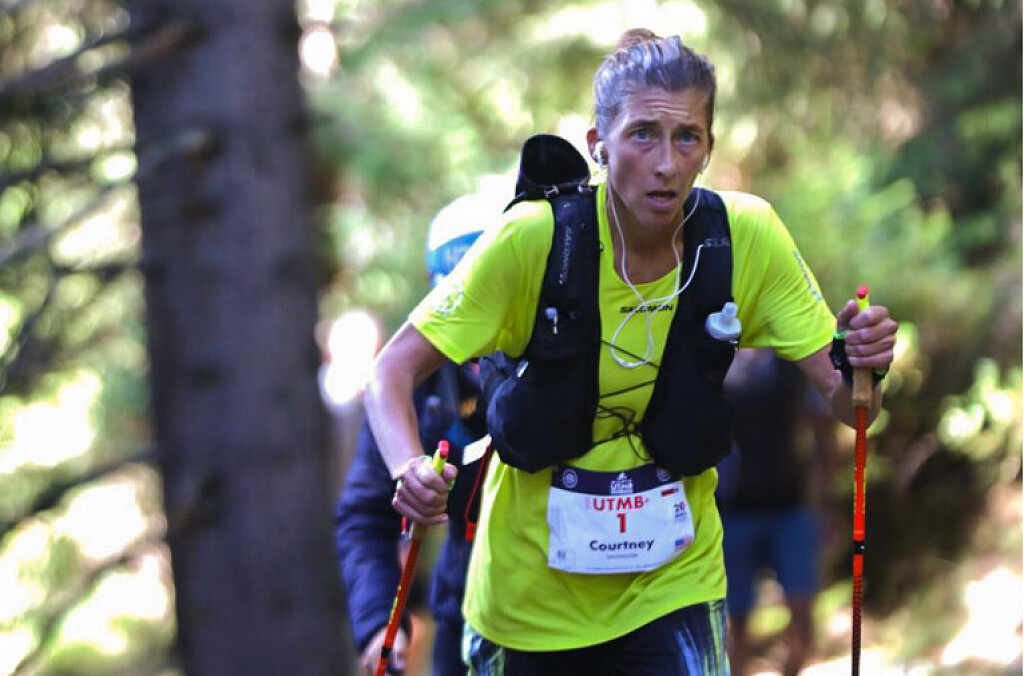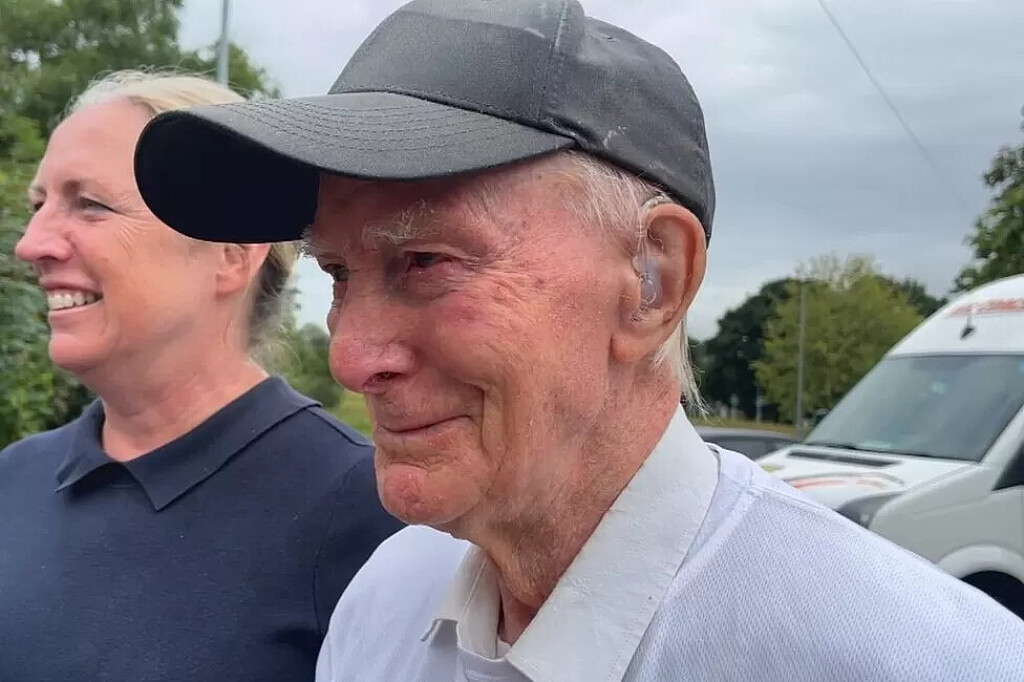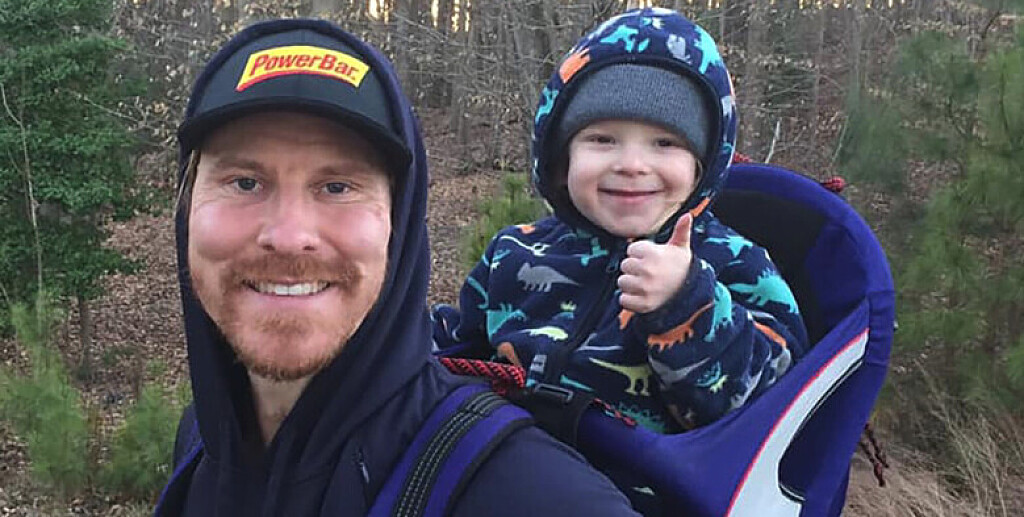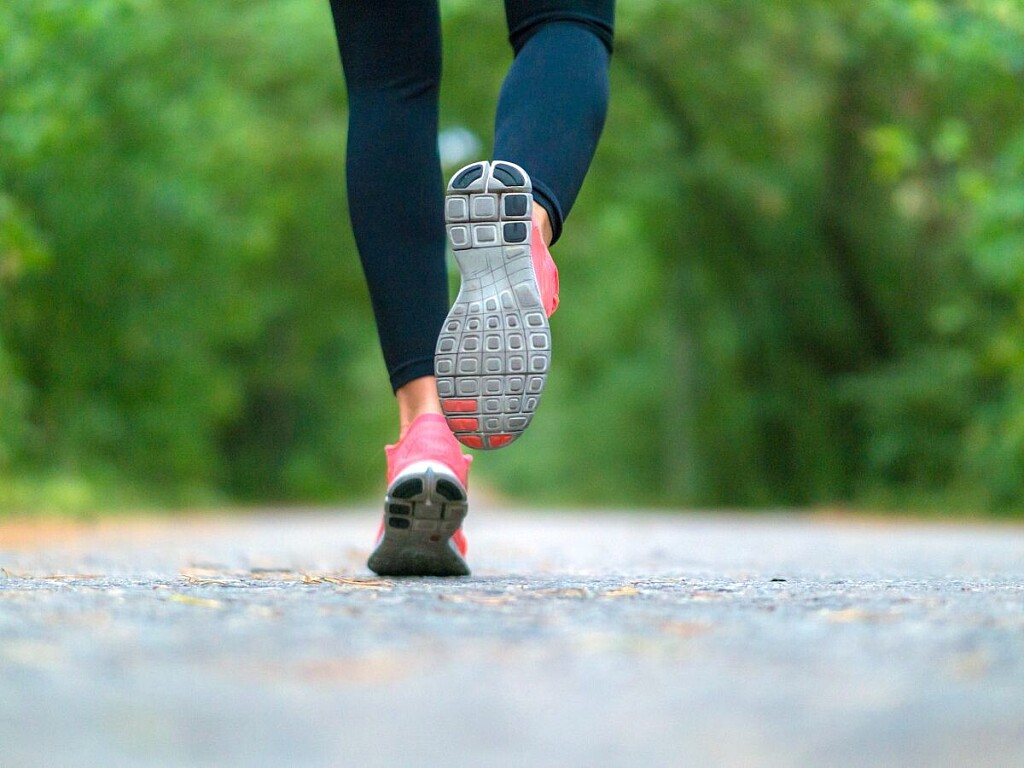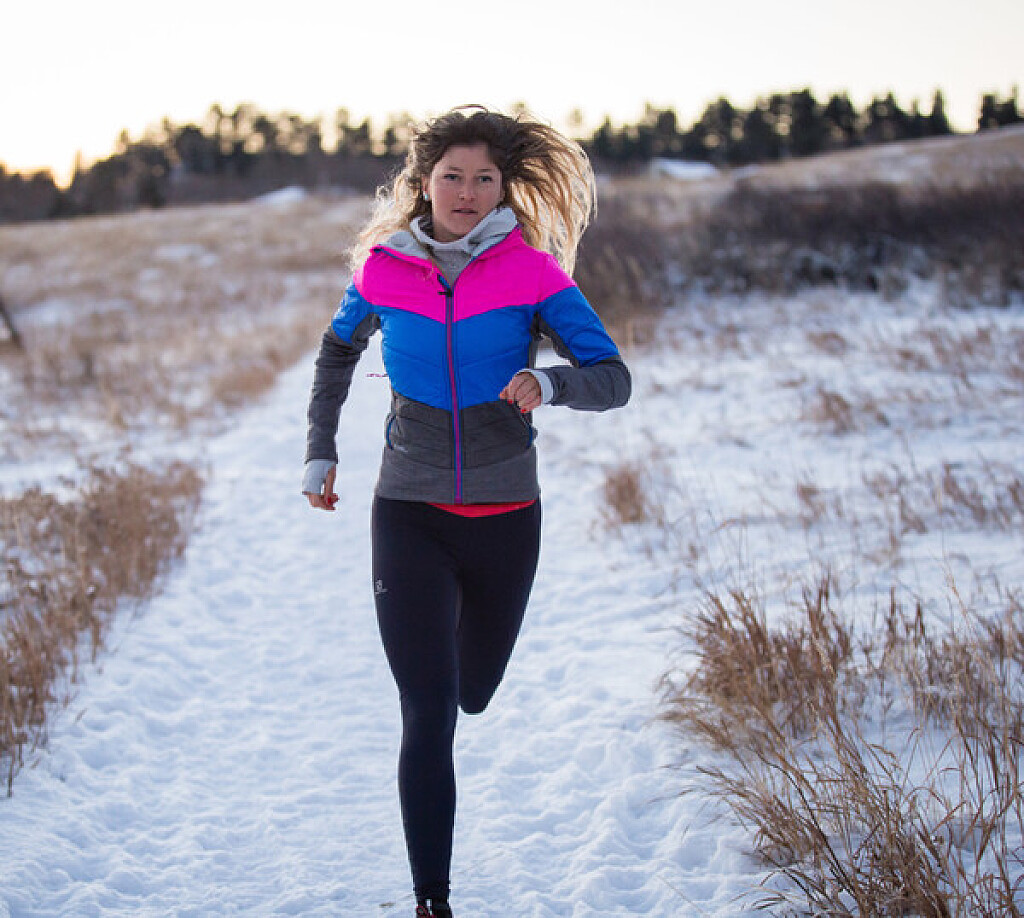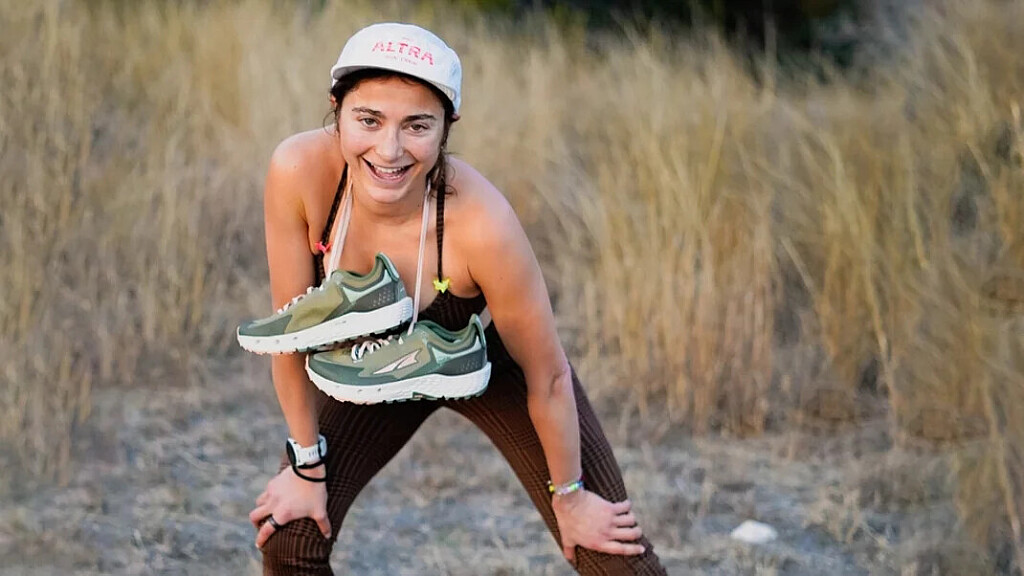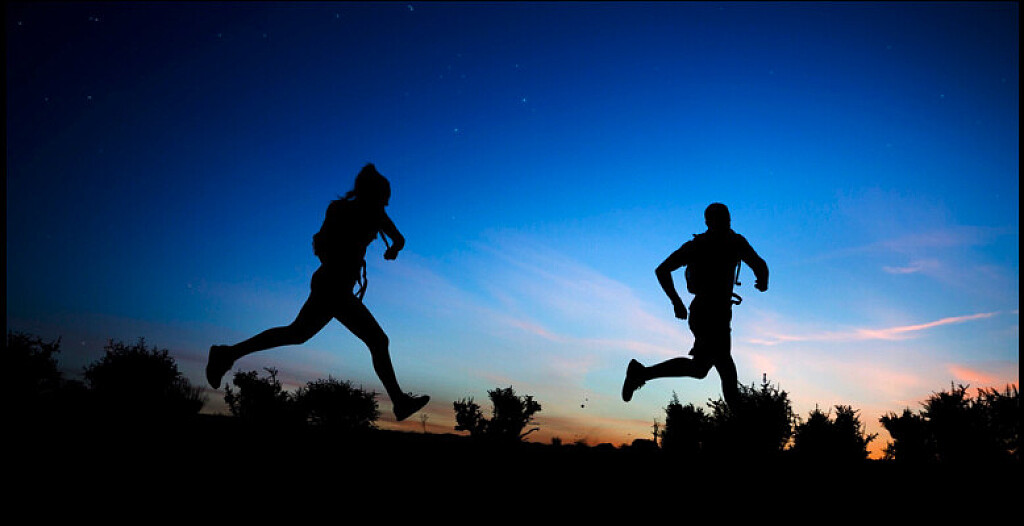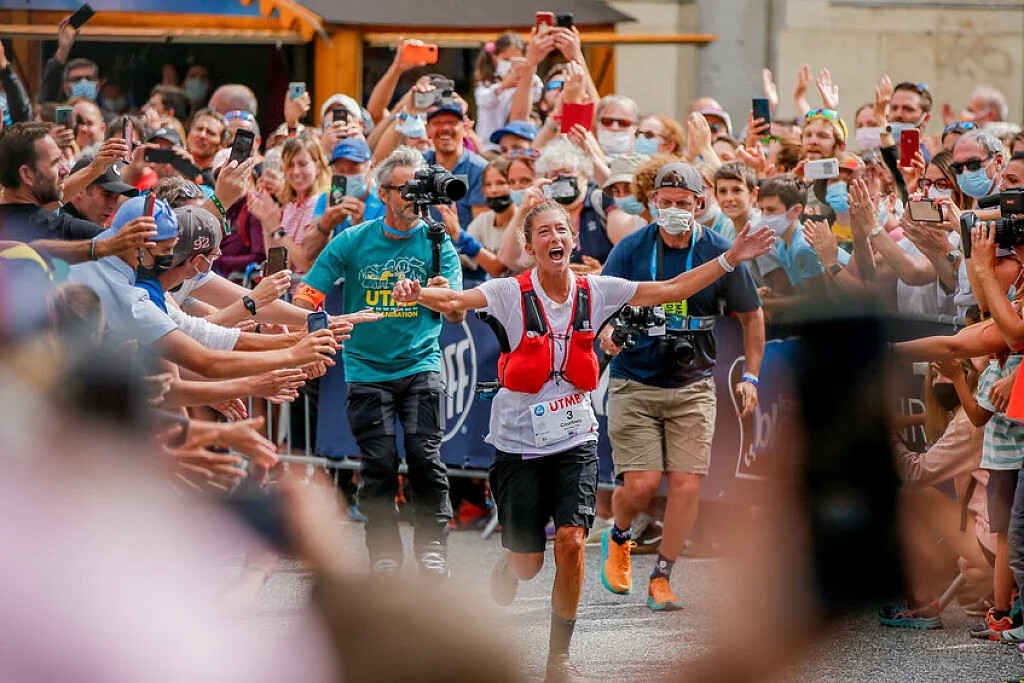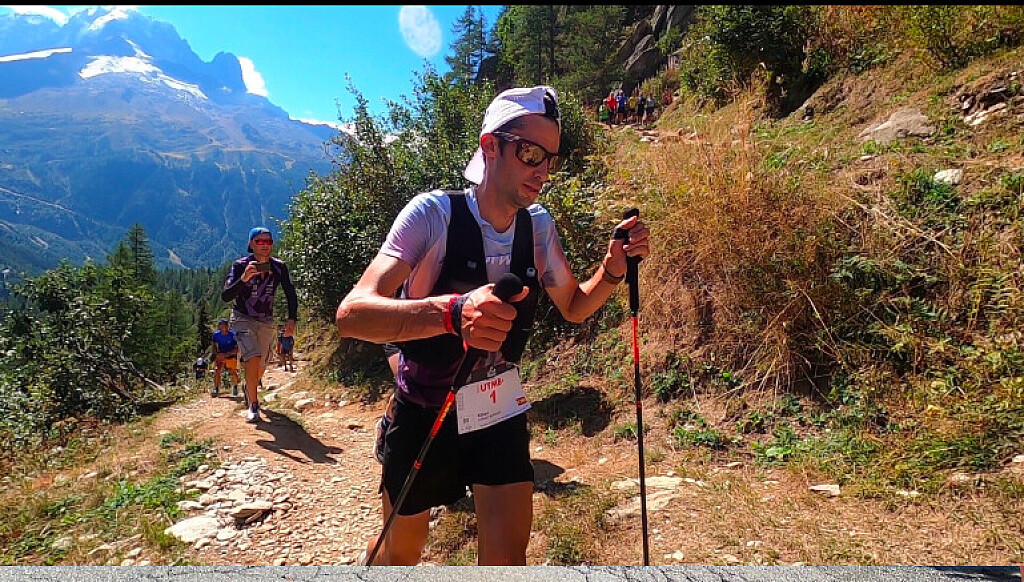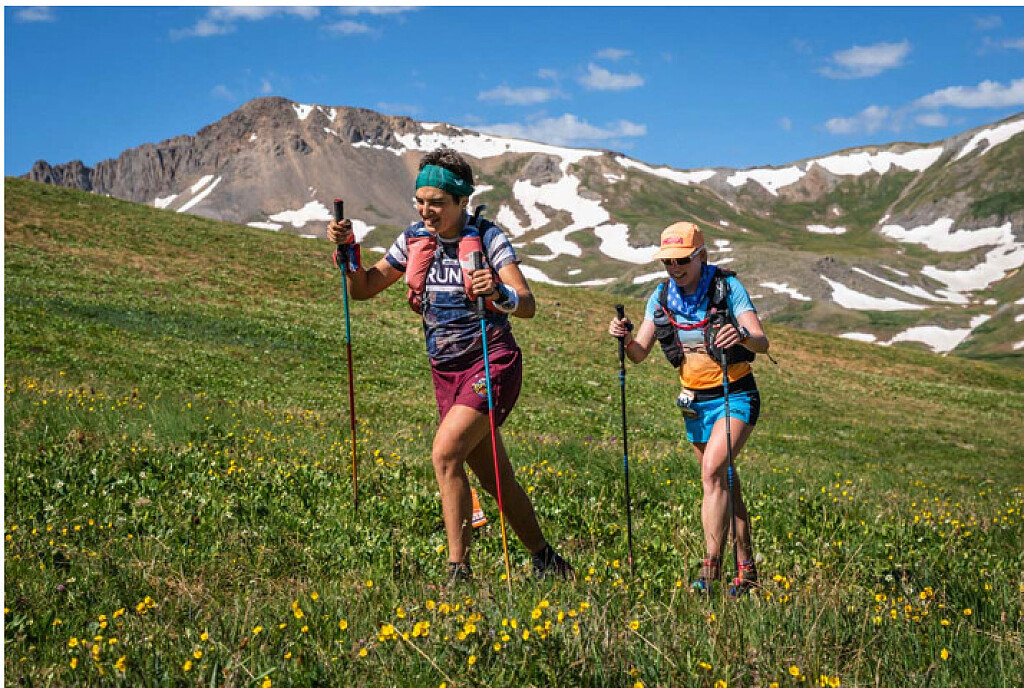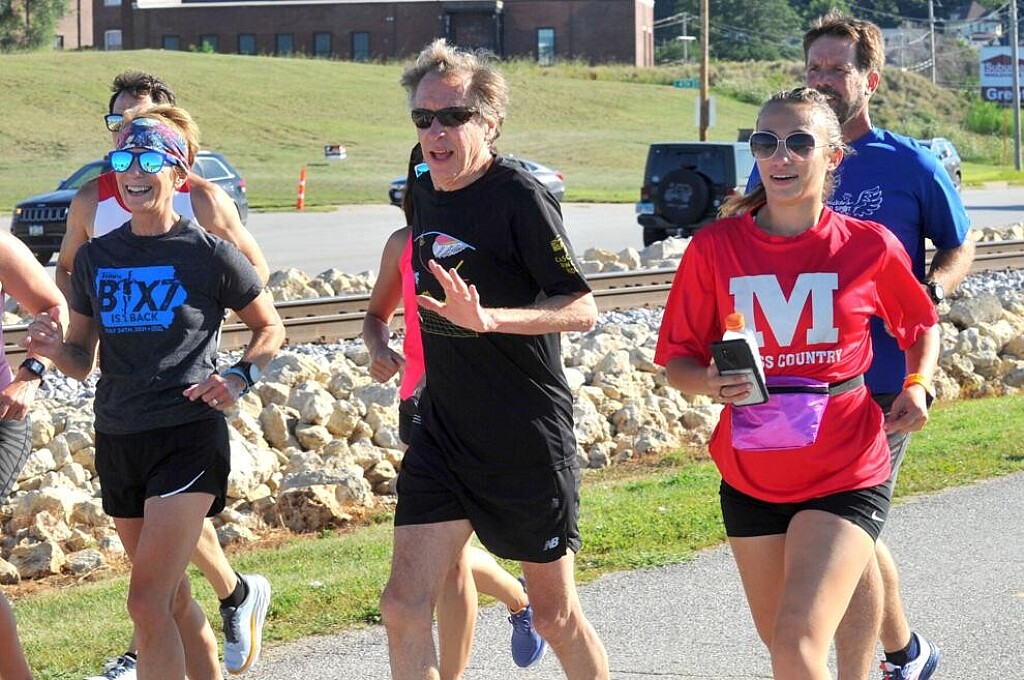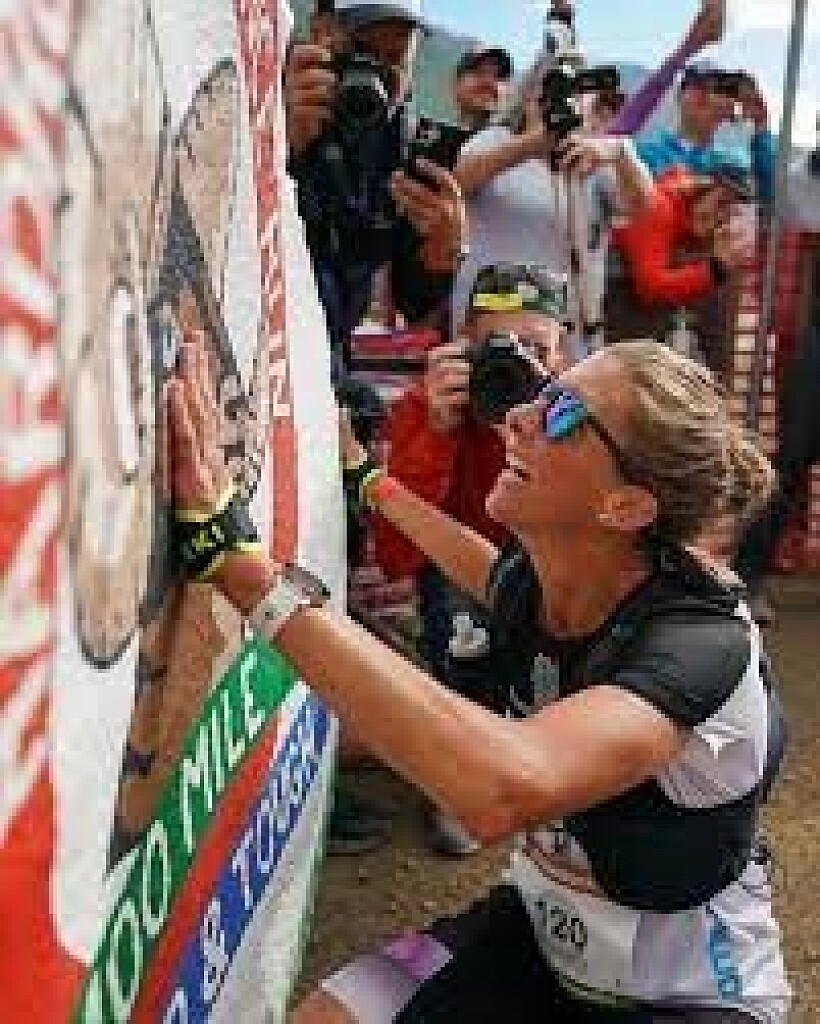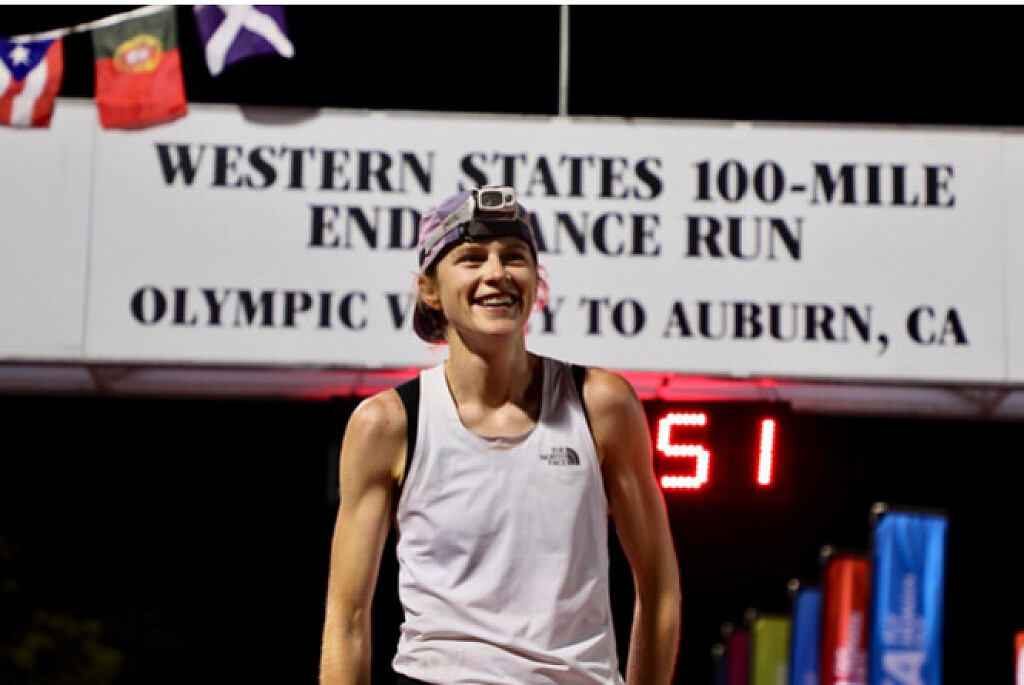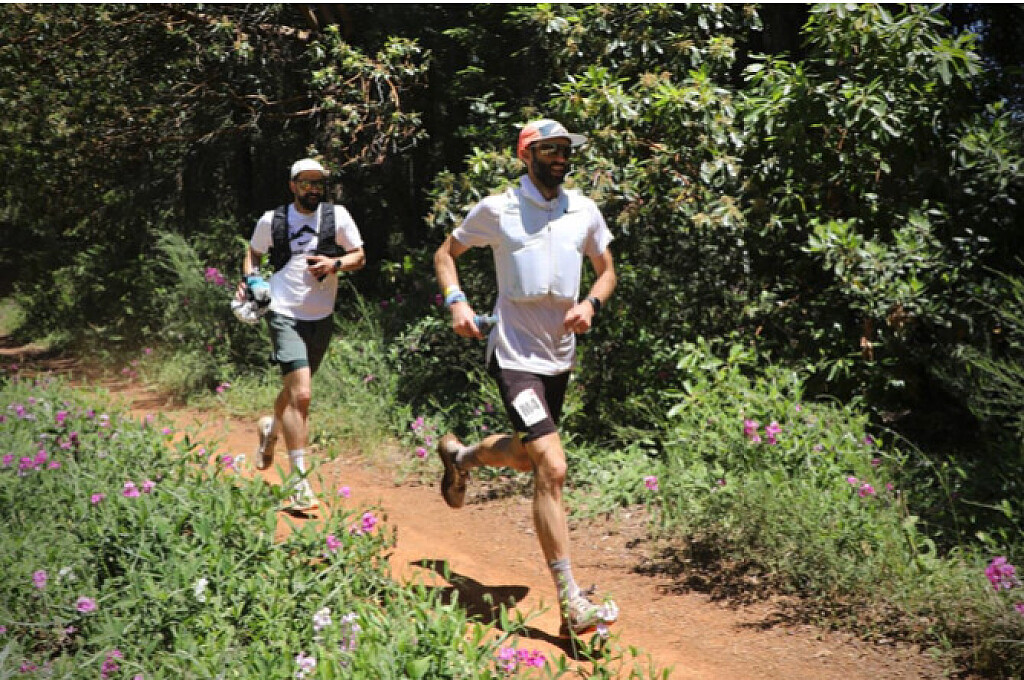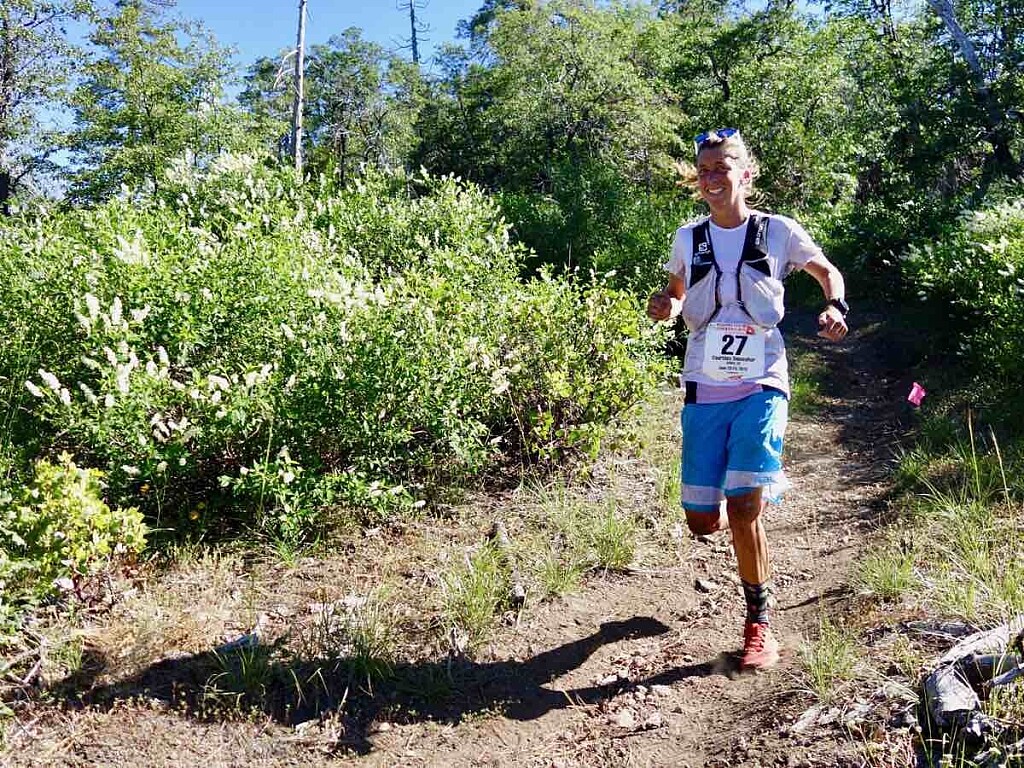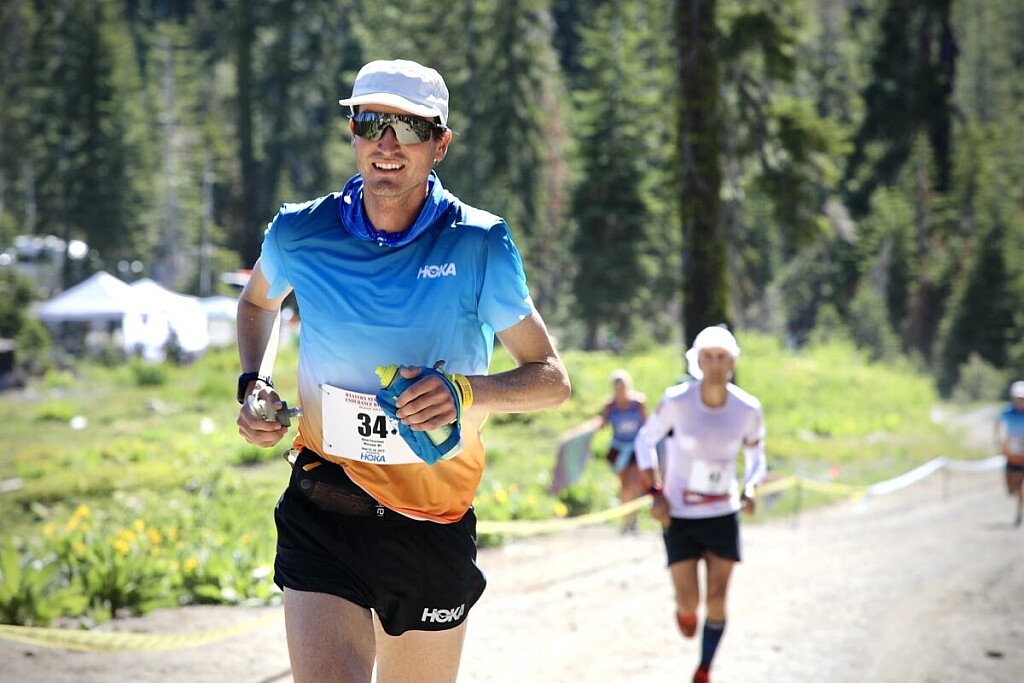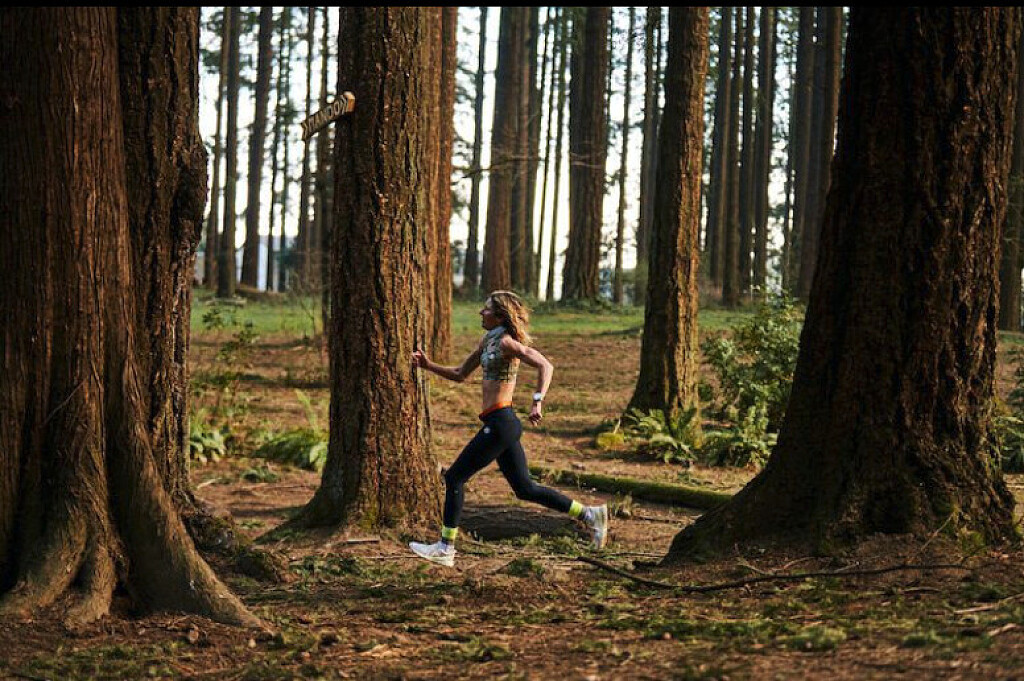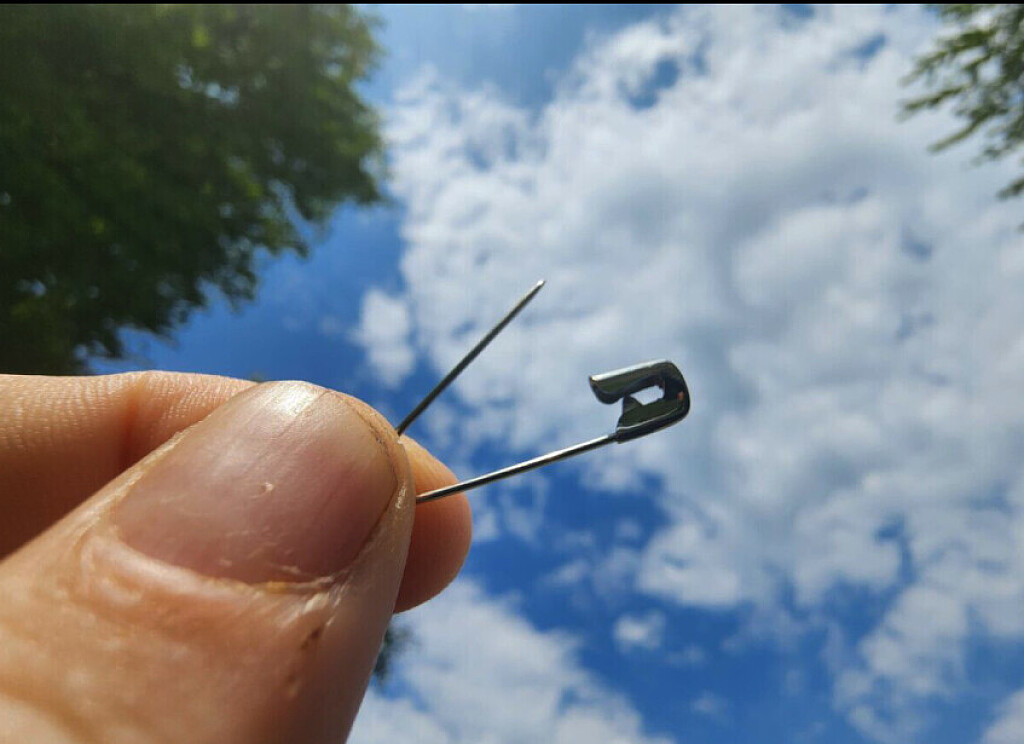Running News Daily
Running News Daily is edited by Bob Anderson. Send your news items to bob@mybestruns.com Advertising opportunities available. Train the Kenyan Way at KATA Kenya and Portugal owned and operated by Bob Anderson. Be sure to catch our movie A Long Run the movie KATA Running Camps and KATA Potato Farms - 31 now open in Kenya! https://kata.ke/
Index to Daily Posts · Sign Up For Updates · Run The World Feed
Articles tagged #100 mile
Today's Running News
Anne Flower Sets New Women’s 50-Mile World Record at the 2025 Tunnel Hill 50 Mile
In a stunning display of endurance and precision pacing, emergency-room physician and ultramarathon standout Anne Flower blazed to a new women’s world record of 5:18:57 for the 50-mile distance at the 2025 Tunnel Hill 50 Mile in Vienna, Illinois. The mark shatters the previous record of 5:31:56 held by Courtney Olsen, set on the same course last year.
Record-Setting Performance
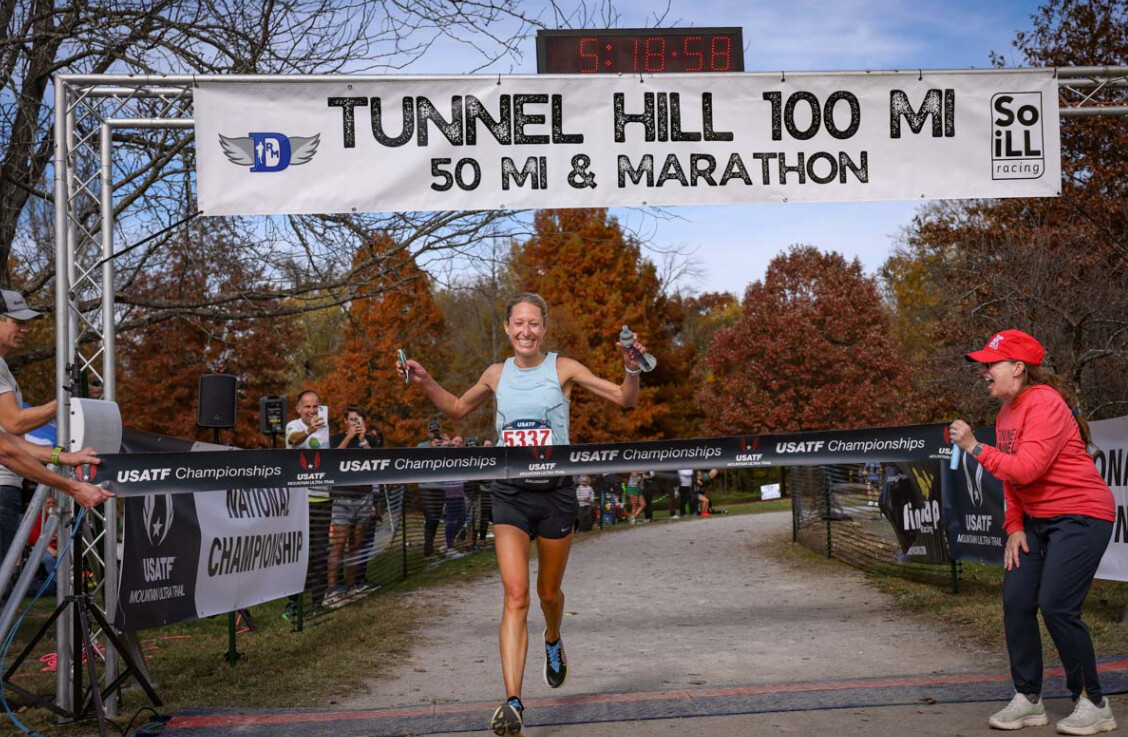
Held on the flat, crushed-gravel rails-to-trails route of the Tunnel Hill State Trail, the race has become a proving ground for world-class performances. Flower averaged an extraordinary 6:23 per mile (3:57 per kilometer) across the full 80.47 km course, running even splits and showing no signs of strain even as temperatures climbed later in the race.l
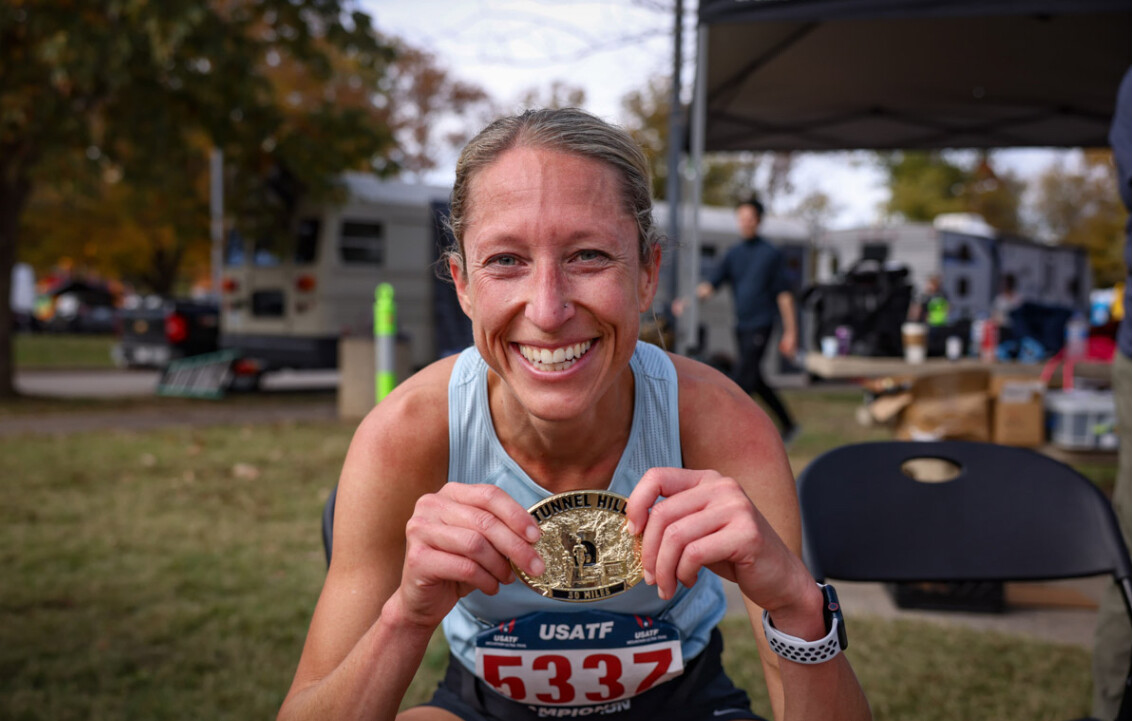
From the opening miles, Flower stayed well ahead of record pace, never faltering and closing strongly to seal a performance that redefines the women’s 50-mile standard. Olsen, competing in the 100k event this year, passed the 50-mile mark in 5:33:59—still an elite split, but more than 15 minutes behind Flower’s record pace.
From Marathons to Ultramarathons
Based in Colorado Springs, Colorado, Flower balances her demanding career as an emergency-room doctor with elite-level training. Before moving to the trails in 2019, she competed in marathons and took part in the 2020 U.S. Olympic Marathon Trials. Her road background shows in her efficient stride and disciplined pacing.
Over the past two seasons, she has built an impressive résumé:
Winner of the 2024 Javelina 100k
Champion of the 2025 Silver Rush 50 Mile
Record-breaker at the 2025 Leadville 100 Mile, where she eclipsed Ann Trason’s 31-year-old mark in her debut at the distance
These results paved the way for her dominant performance at Tunnel Hill, demonstrating both her endurance and her remarkable consistency.
Raising the Bar for Women’s Ultrarunning
Flower’s 5:18:57 isn’t just fast—it’s a historic leap forward. Taking more than 12 minutes off a world record at this level is rare, and doing so with such control underscores her potential for even greater achievements ahead.
Tunnel Hill has become synonymous with world-record performances, and Flower’s run further cements the race’s reputation as one of the premier venues for ultradistance excellence.
What’s Next
With records now at both 50 and 100 miles, Flower’s next challenge may be defending or lowering her new mark—or shifting her focus toward international championship events. Whatever path she chooses, her rise through the sport has been nothing short of extraordinary.
Anne Flower has proven that it’s possible to balance a demanding professional life with world-class athletic performance. Her blend of discipline, determination, and pure endurance has elevated her into the top tier of ultrarunning’s global elite.
by Boris Baron
Login to leave a comment
Oz Pearlman: Mentalist and Marathoner with a 2:23:52 Personal Best
Oz Pearlman is most known as a world-class mentalist and entertainer, dazzling audiences with mind-reading feats. While his stage act is about illusions and mind-reading, his running accomplishments are very real and recognized in the endurance community.
Oz has carved out a reputation as an elite runner, with marathon credentials and ultra-endurance performances that prove his strength goes far beyond the stage.
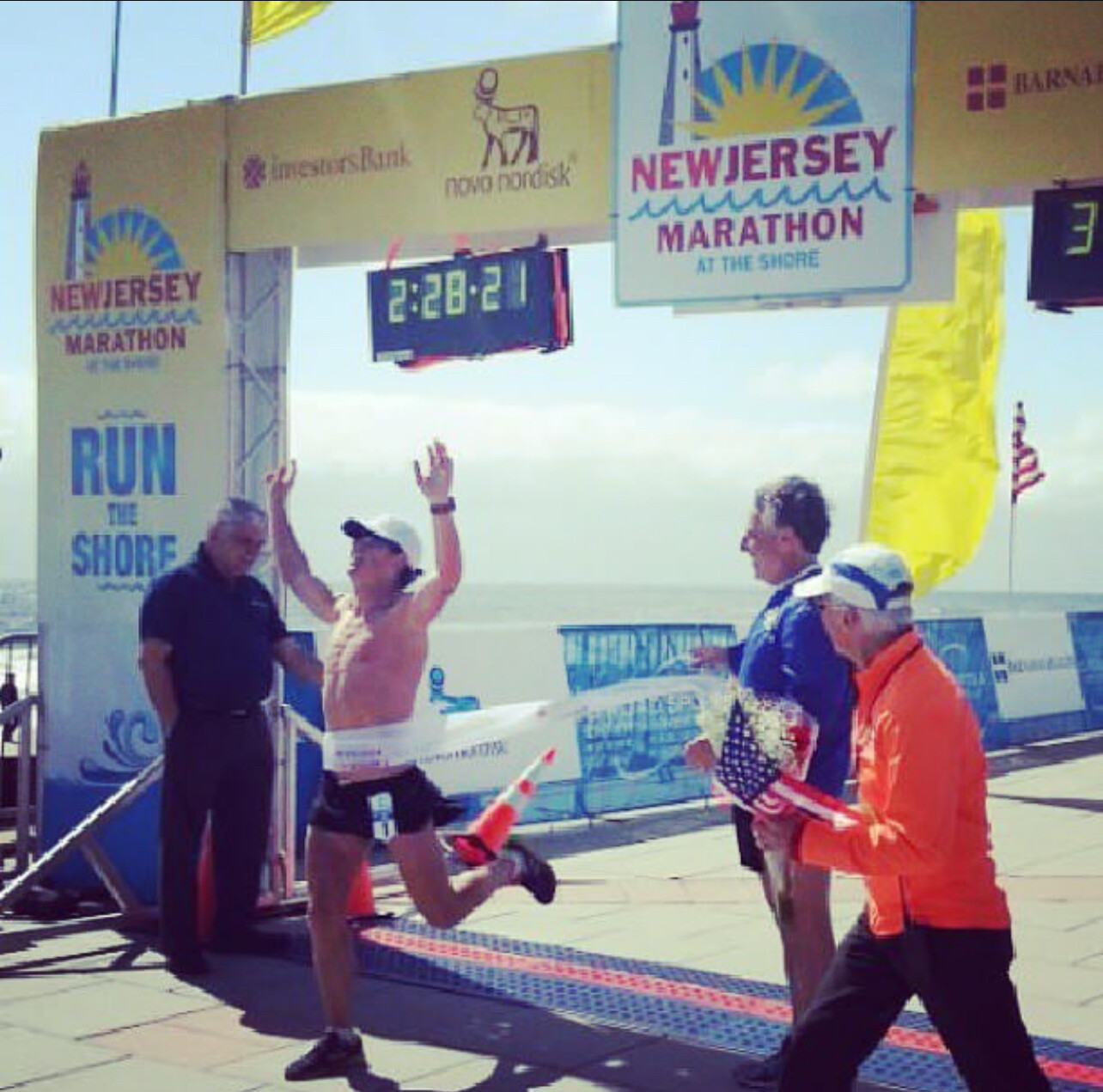
Marathon Credentials
Oz’s personal best marathon of 2:23:52, set at the Philadelphia Marathon in 2014, is a time most competitive runners can only dream of. He’s also posted:
• 2:26:59 at the 2014 New York City Marathon
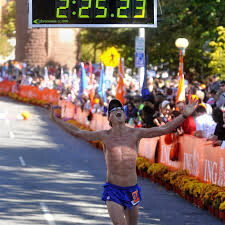
• 2:29:19 at the 2021 NYC Marathon
• 2:40:14 at the 2022 NYC Marathon

Along the way, he’s notched victories in regional races, including the New Jersey Marathon, underscoring his range and consistency.
From Marathons to Ultramarathons
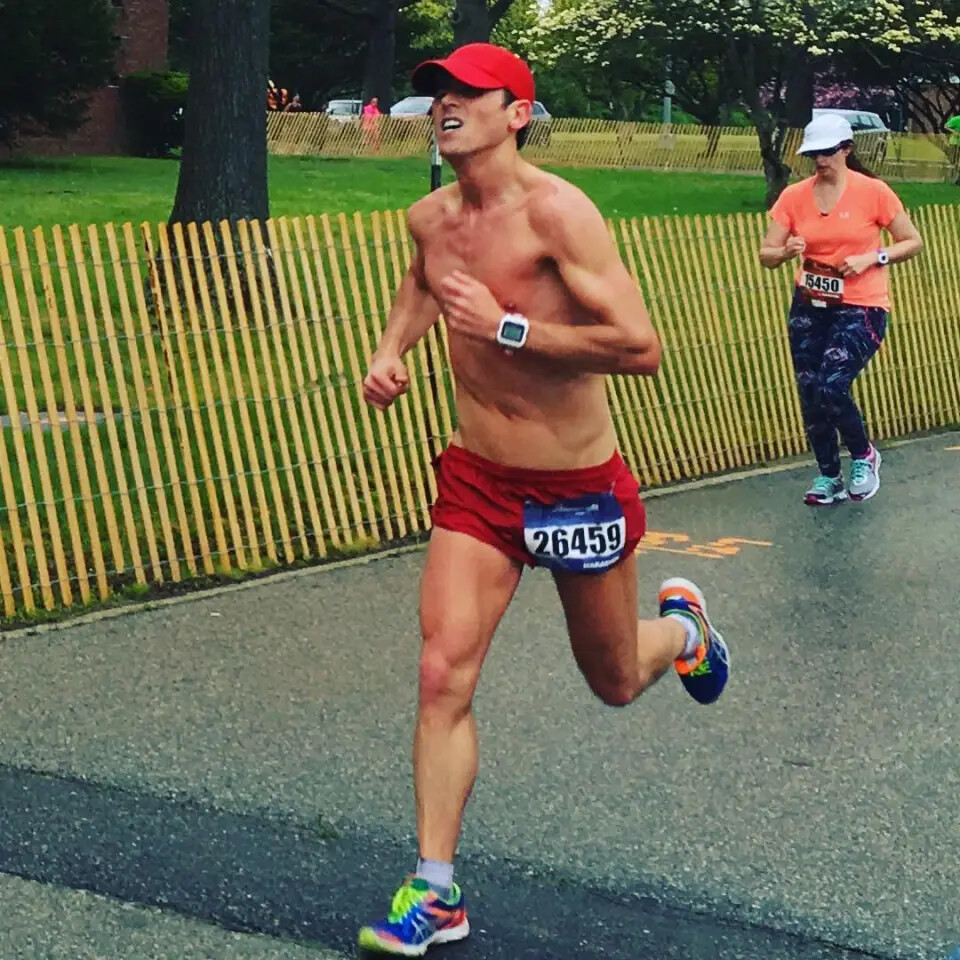
Oz didn’t stop at 26.2. He’s tested his limits in some of the sport’s toughest arenas:

• 100 miles in 16:53:25 at the Keys Ultra (2021), finishing second overall.
• 100 miles in 18:25:23 at the Umstead 100-Mile Endurance Run (2025).
• 117 miles in Central Park (2022), setting the record for most loops in a single day while raising funds for Ukrainian relief.
• A nonstop run from Montauk Point Lighthouse to Times Square — over 130 miles in 24 hours.
These efforts highlight not only his physical endurance but also his ability to push through the mental barriers that define ultra running.
Mind Over Miles
As a mentalist, Oz has honed a mastery of focus, patience, and mental toughness — qualities that translate seamlessly to distance running. Whether chasing sub-2:25 marathons or grinding through 100-mile ultras, he shows that success in endurance sport comes as much from the mind as from the legs.
Running With Purpose
Many of Oz’s longest challenges have doubled as fundraising efforts, proving that his running is about more than personal achievement. His Central Park ultra raised significant support for Ukraine, reflecting how he uses his talents — both on stage and on the course — to make an impact.
Oz Pearlman is more than an entertainer. He is a reminder that resilience, consistency, and the power of the mind can take us further than we imagine — sometimes all the way from Montauk to Manhattan.
by Boris Baron
Login to leave a comment
What Happens When the Finish Line Feels 100 Miles Away
We’ve all seen the footage: a runner, sometimes even an elite, staggering or crawling across the marathon finish line. It’s a powerful image—equal parts dramatic and heartbreaking. But what causes those jelly legs, and can it be prevented?
The Science of “Jelly Legs”
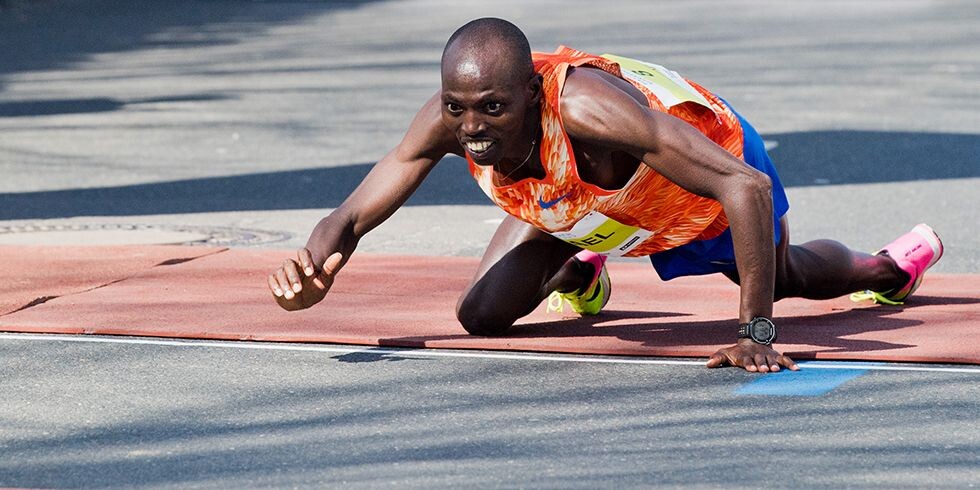
The feeling of wobbly or unresponsive legs at the end of a marathon is often the result of neuromuscular fatigue and metabolic depletion. After 26.2 miles, the body’s ability to send signals from the brain to the muscles can falter.
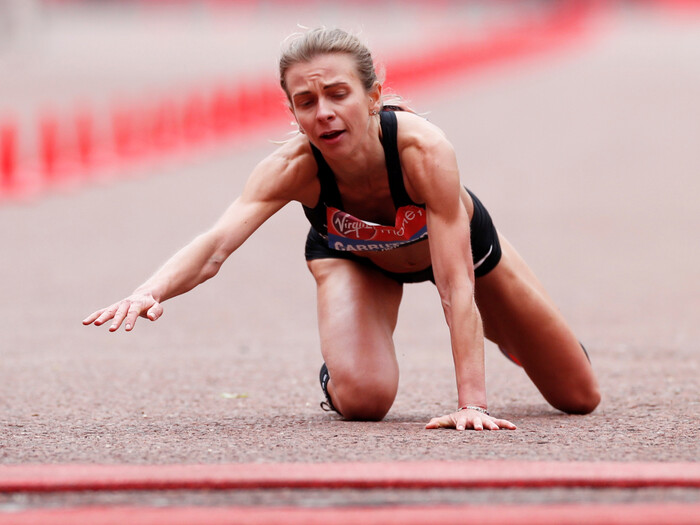
“You’re not just tired,” says Coach Jimmy Muindi, seven-time Honolulu Marathon champion. “Your legs stop responding to what your brain is telling them to do.”
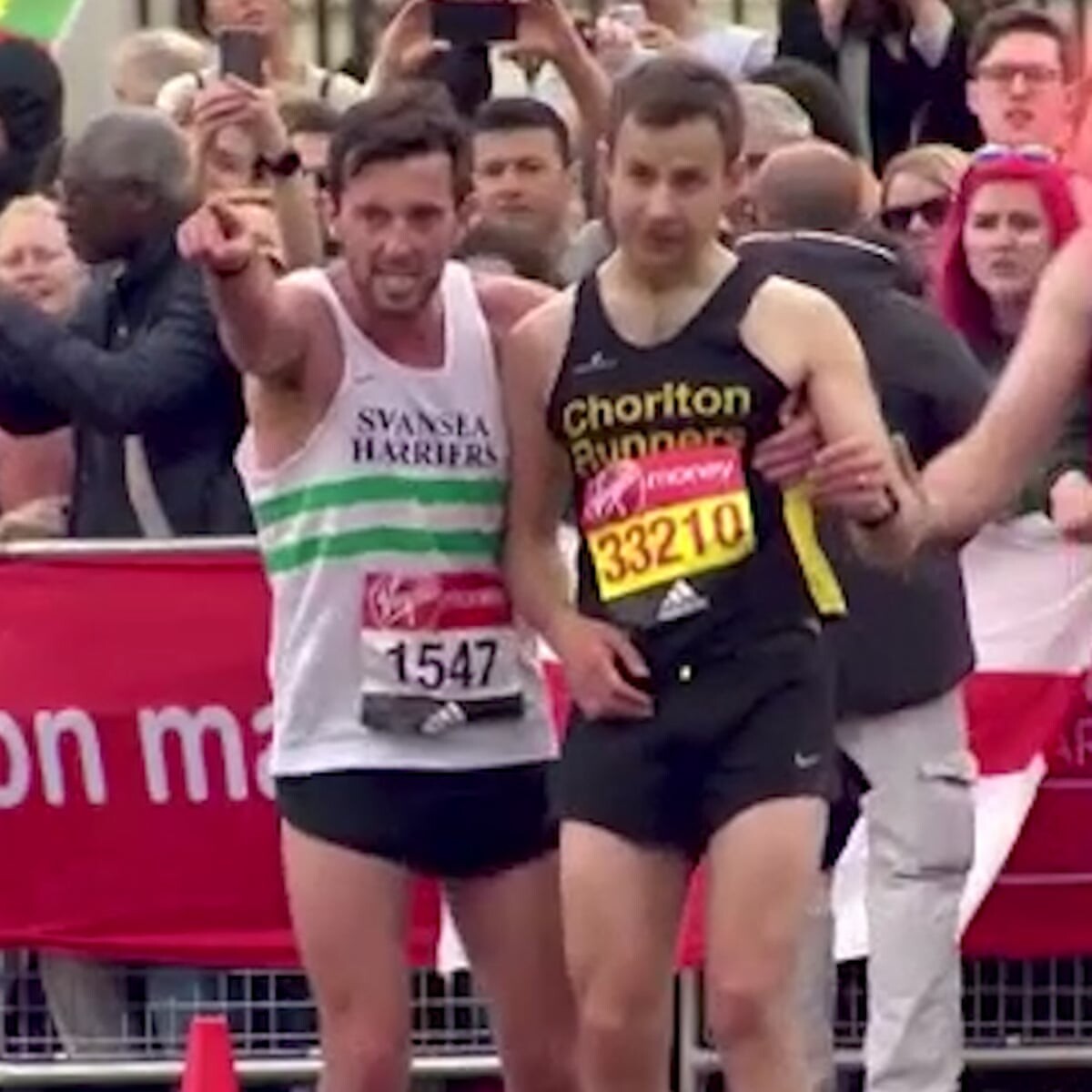
Key Causes
1. Glycogen Depletion
Muscles run on glycogen, and after two to three hours of running, those stores run dry—especially if fueling is inadequate.
2. Dehydration and Electrolyte Imbalance
Even a small loss in body fluid affects muscle function. Electrolyte imbalances (particularly low sodium or potassium) can trigger cramps and weakness.
3. Central Nervous System Fatigue
Your brain gets tired, too. Prolonged effort reduces the brain’s ability to send strong, coordinated signals to the muscles.
4. Improper Pacing
Going out too fast early in the race can lead to full-system shutdown in the final miles. Your body simply can’t hold that pace.
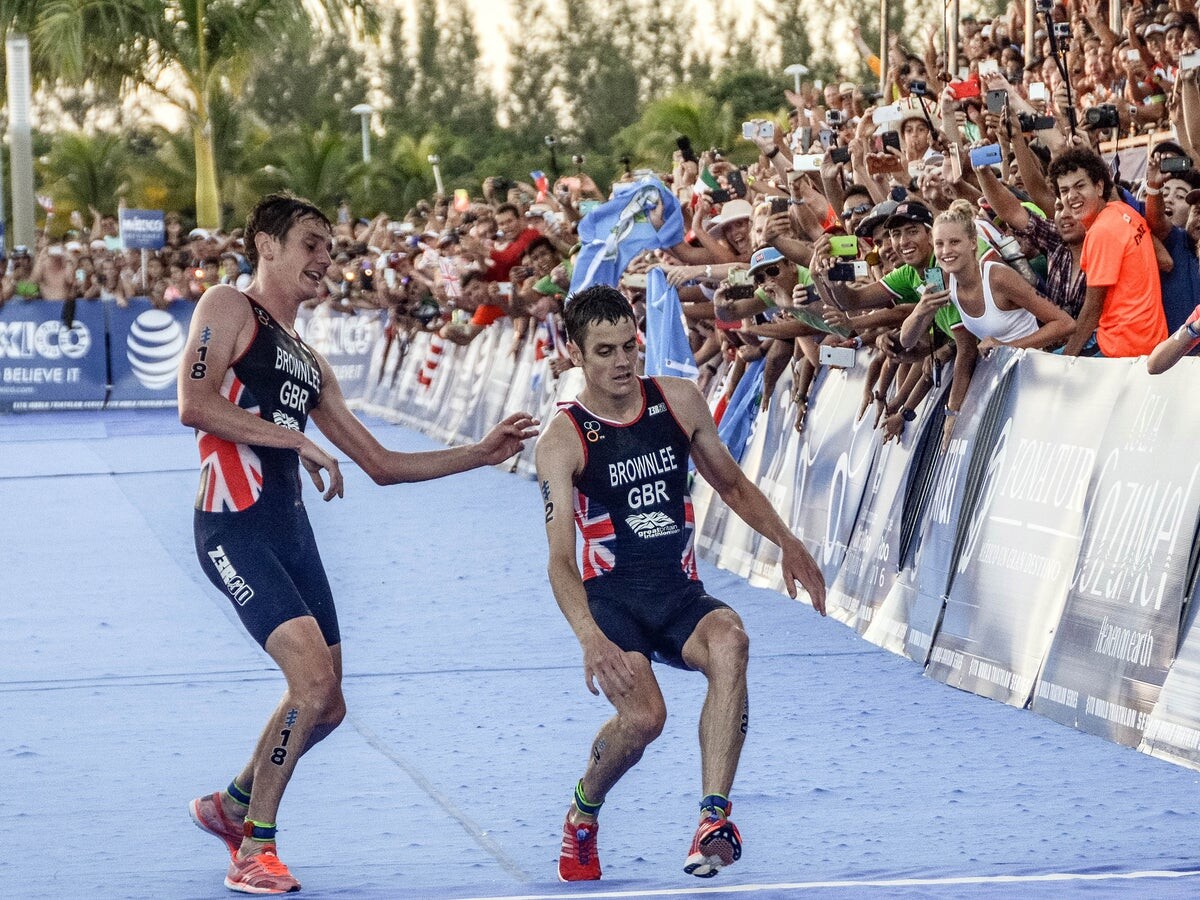
5. Heat and Humidity
Hot races amplify all of the above. Core temperature rises, making it harder for muscles to function efficiently.
Why It Even Happens to Elites
Elite runners push their bodies to the limit. Sometimes a miscalculation in pace, nutrition, or weather adjustment can bring even the strongest athlete to their knees—literally. And because they’re aiming for peak performance, they’re often operating on a knife’s edge.
In 2018, American runner Sarah Sellers nearly collapsed after finishing second at the Boston Marathon, a race defined by brutal weather. Others, like Gabriela Andersen-Schiess in the 1984 Olympics, became iconic for their final, staggering strides.
Prevention Strategies
• Dial in race-day nutrition. Practice fueling with gels, fluids, and electrolytes during training.
• Train your brain. Long runs, heat training, and race simulations help develop mental toughness and delay central fatigue.
• Know your pace. Use race predictors and experience to avoid going out too fast.
• Hydrate smart. Don’t just drink water—replace lost electrolytes.
Final Thought
Marathon running pushes the human body to its limits. Jelly legs and crawl finishes are not signs of weakness—they’re the body’s emergency brake. With smarter training and fueling, most runners can avoid it. But when it does happen, it reminds us how far people will go to finish what they started.
by Boris Baron
Login to leave a comment
Meg Eckert Smashes World Record running Over 600 Miles in Six Days
American ultrarunner Meg Eckert has just rewritten the record books. Covering a jaw-dropping 603.156 miles (970.685 kilometers) over six days, Eckert shattered the women’s six-day world record at the 24H World Challenge in Policoro, Italy, making headlines in the ultrarunning world.
The previous record of 576.6 miles (928.1 km) was held by Australia’s Dipali Cunningham, set in 2001. Eckert not only surpassed that mark—she obliterated it with consistent pacing, minimal rest, and an iron will that held up through blistering heat, exhaustion, and the mental toll of running for nearly a full week.
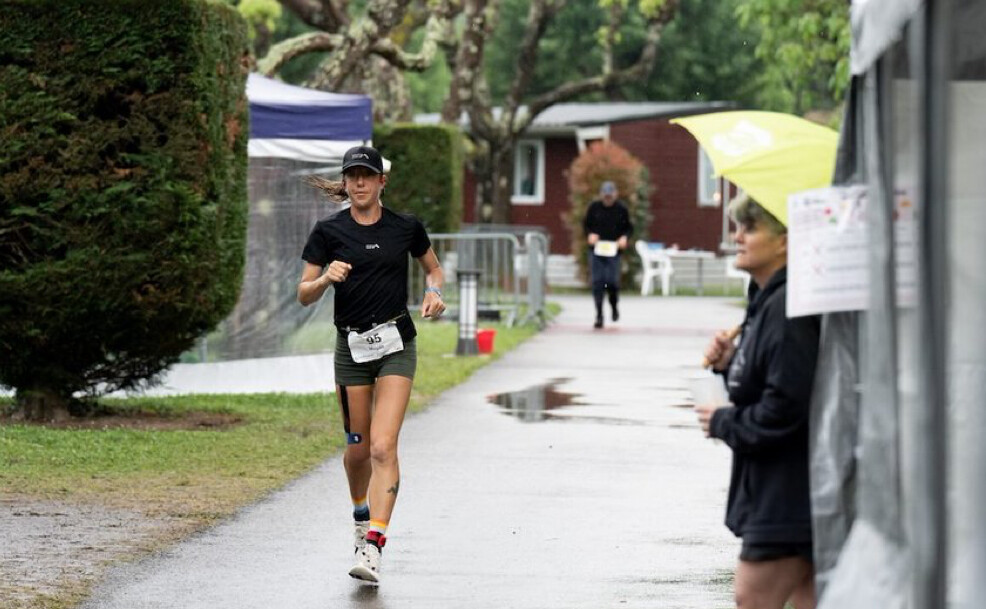
The six-day race is one of the ultimate endurance tests in ultrarunning, requiring not just physical toughness but strategic discipline. Athletes eat, rest, and sleep in short bursts, logging as many miles as possible around a looped course. Eckert averaged over 100 miles per day, an incredible feat. Many runners only average this in an entire month.
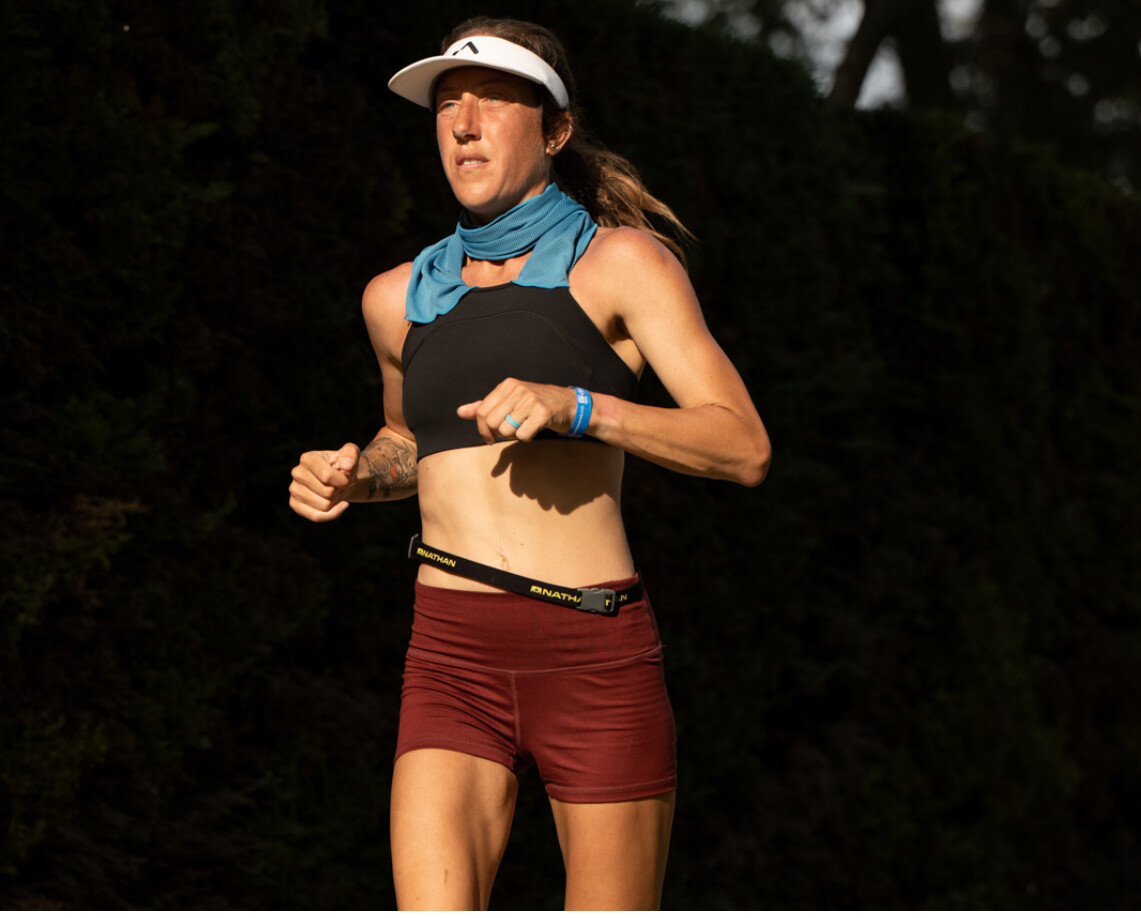
Eckert, 42, from the United States, has long been respected in the ultra community, but this performance launches her into an elite tier of historical significance. Her run wasn’t just about physical achievement—it was a showcase of mental strength and deep experience with multi-day racing.
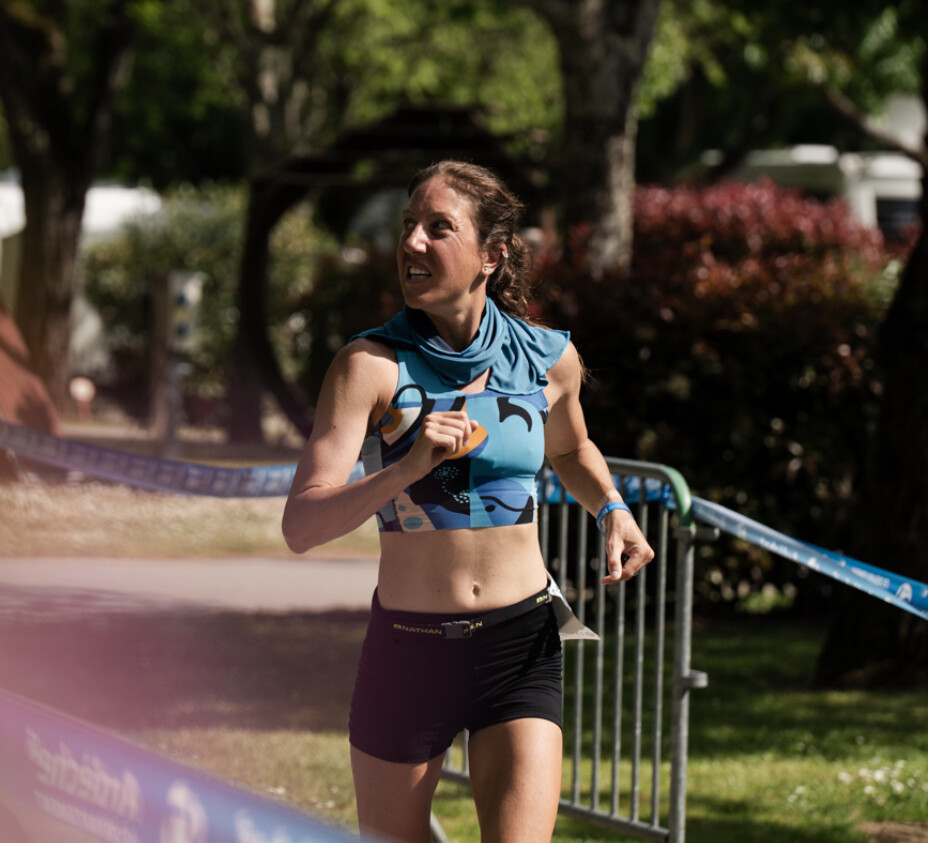
“It was about being in the moment, one lap at a time,” Eckert said afterward. “I knew what I was capable of, but to actually do it… that took everything.”
As more runners continue to push the boundaries of what the human body and mind can handle, performances like Eckert’s redefine the limits of endurance running. Her new world record is expected to stand as a monumental benchmark for years to come.
by Boris Baron
Login to leave a comment
One Mile or One Hundred The Battle for the Soul of the Mile in 2025
In 2025, the word “mile” carries very different meanings depending on who’s lacing up their shoes. For some, it’s about blistering speed—the chase for a personal best in an all-out sprint lasting just a few intense minutes. For others, it’s about endurance, grit, and surviving a 100-mile ultramarathon—not once, but four times in one season. While one version of the mile is measured in minutes, the other is measured in days, elevation, and blisters.
Both forms of running are surging in popularity, drawing passionate athletes and growing crowds. But which “mile” speaks to you?
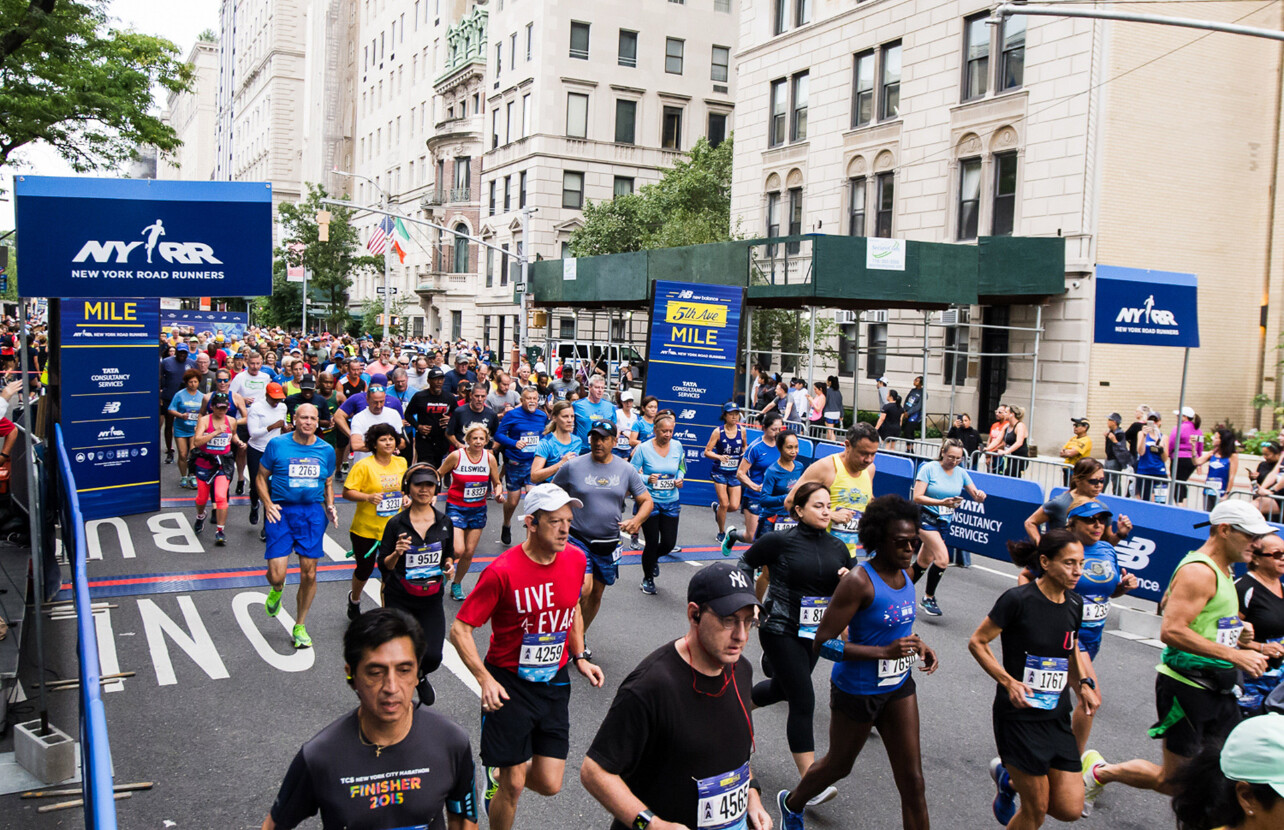
The Rise of the Road Mile
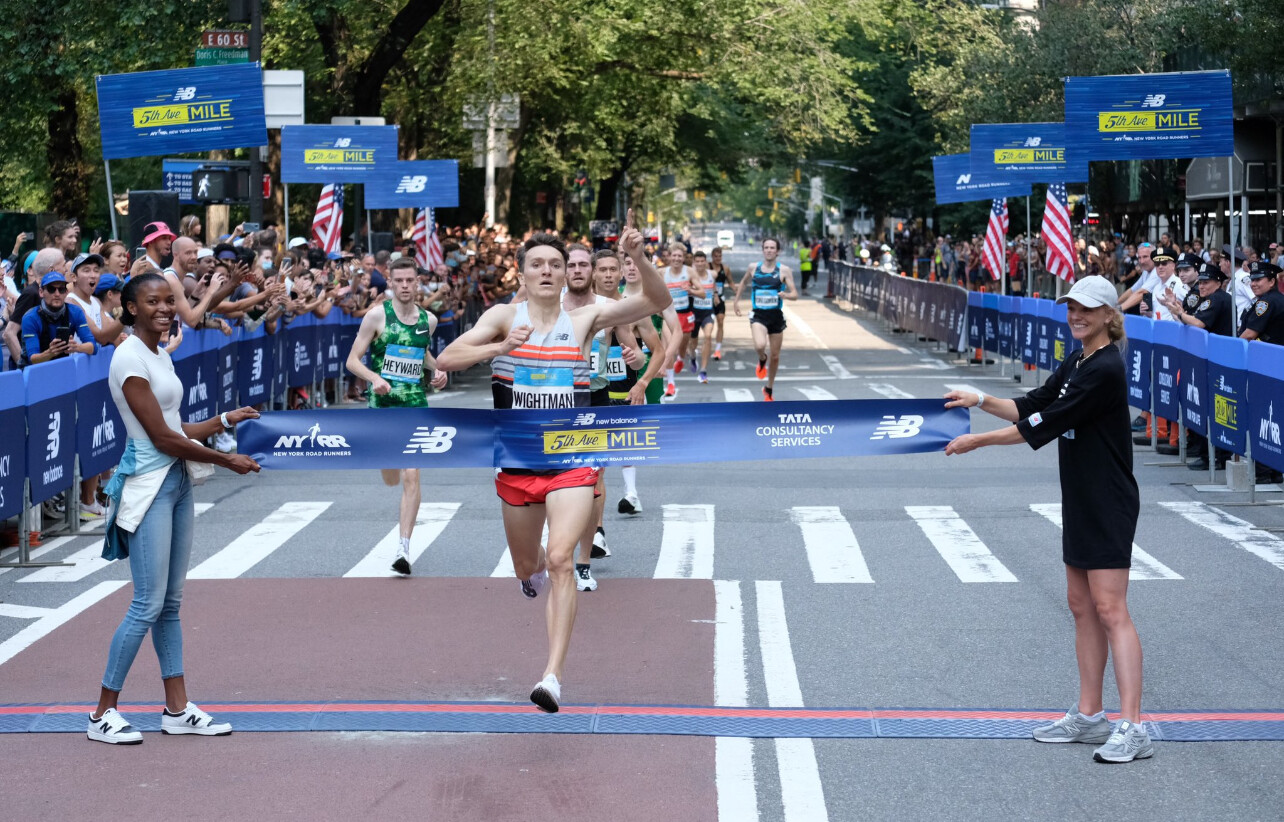
The road mile is back in the spotlight. Once overshadowed by the 5K and 10K, this short, intense race has re-emerged as a fan favorite. In cities across the U.S. and around the world, runners are lining up for high-stakes, high-speed showdowns that test both speed and tactical racing smarts.
One of the most iconic examples is the New Balance 5th Avenue Mile in New York City. Scheduled for Sunday, September 7, 2025, this legendary event draws elite professionals, masters athletes, and youth competitors for a one-mile drag race down Manhattan’s Fifth Avenue. With the skyline as a backdrop and cheering crowds lining the route, it offers one of the purest expressions of speed in road racing.
“It’s raw, it’s electric, and it’s over before you know it,” said one competitor who’s raced both marathons and the mile. “The road mile demands absolute precision—whether you’re aiming to break five minutes or six, you don’t get time to recover from a tactical mistake.”
Events like the Guardian Mile in Cleveland and the Grand Blue Mile in Iowa have followed suit, offering prize money, flat courses, and the kind of short-format excitement that appeals to both spectators and athletes. The mile, once seen as a track-specific discipline, has truly found a home on the road.
The Grand Slam of Ultrarunning
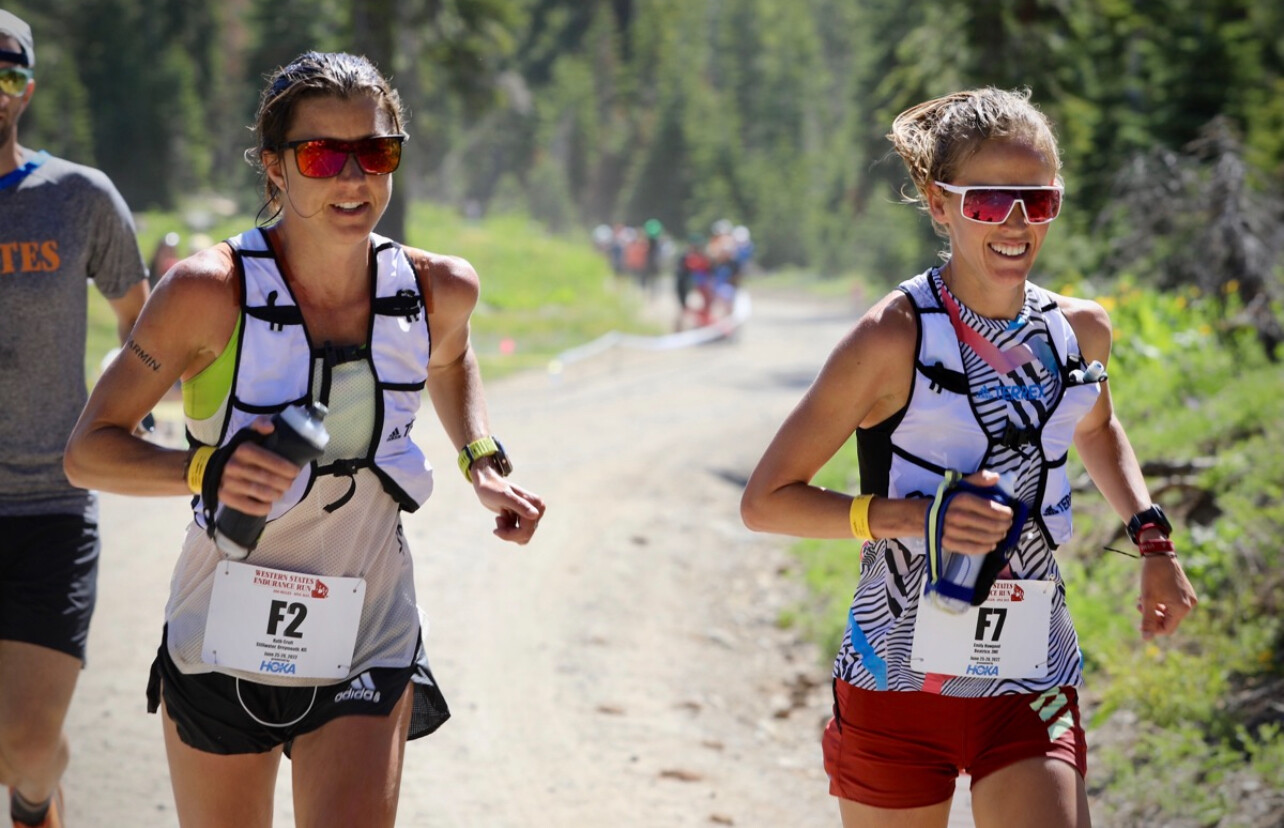
At the other extreme lies the Grand Slam of Ultrarunning—one of the sport’s most grueling and prestigious challenges. Often confused online with terms like “mile grand slam” due to the cumulative 400 miles of racing, the official name is simply The Grand Slam.
To earn this distinction, runners must complete four of the oldest and most iconic 100-mile trail races in the United States during a single summer. The core races typically include:
• Western States 100 (California)
• Vermont 100 Mile Endurance Run
• Leadville Trail 100 (Colorado)
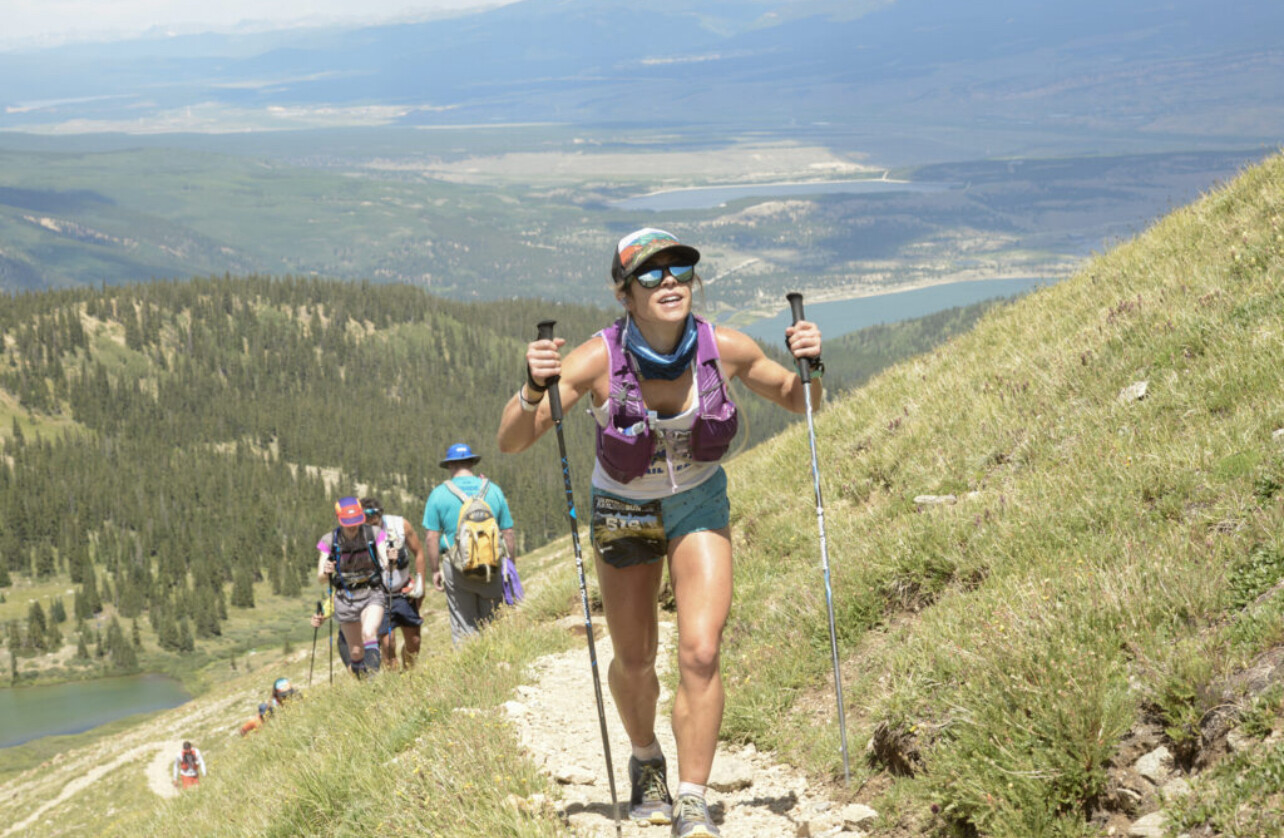
• Wasatch Front 100 (Utah)
Some years permit substitutions like the Old Dominion 100, depending on scheduling. Regardless of the lineup, the difficulty is staggering: thousands of feet of elevation gain, brutal cutoffs, altitude, heat, and sleep deprivation.
“To finish one 100-miler is an accomplishment,” said a veteran ultrarunner who’s completed the Slam. “To finish four in under 16 weeks—there’s nothing like it. It’s not about speed. It’s about survival, strategy, and heart.”
Since its formal inception in the 1980s, fewer than 400 runners have completed the Grand Slam—a testament to its difficulty and prestige.
Two Extremes, One Shared Spirit
At first glance, these two uses of the word “mile” couldn’t be more different. One is sleek and fast; the other is rugged and long. One ends before your legs even start to ache; the other pushes your limits for an entire day—and night.
But at their core, both disciplines require the same fuel: dedication, discipline, and the courage to test yourself. Whether it’s the final lean in a road mile or the final climb at mile 96 of a trail race, runners in both arenas are chasing something personal—and powerful.
Final Thought
So what does the mile mean in 2025? For some, it’s a tactical burn over 1,760 yards. For others, it’s the slow, steady march of 100 trail miles—repeated four times. Either way, the mile remains one of the sport’s most meaningful measures of challenge.
by Boris Baron
Login to leave a comment
Matt Richtman - The Unexpected Hero of American Distance Running
On March 16, 2025, Matt Richtman stunned the running world by becoming the first American man in 31 years to win the Los Angeles Marathon. His time—2:07:56—was not only a personal best, but also the seventh-fastest marathon time in U.S. history. What made the victory even more remarkable was how he got there: no professional training group, no high-profile coach, just relentless work, self-belief, and a deep-rooted passion for the sport.
Humble Beginnings in a Running Family
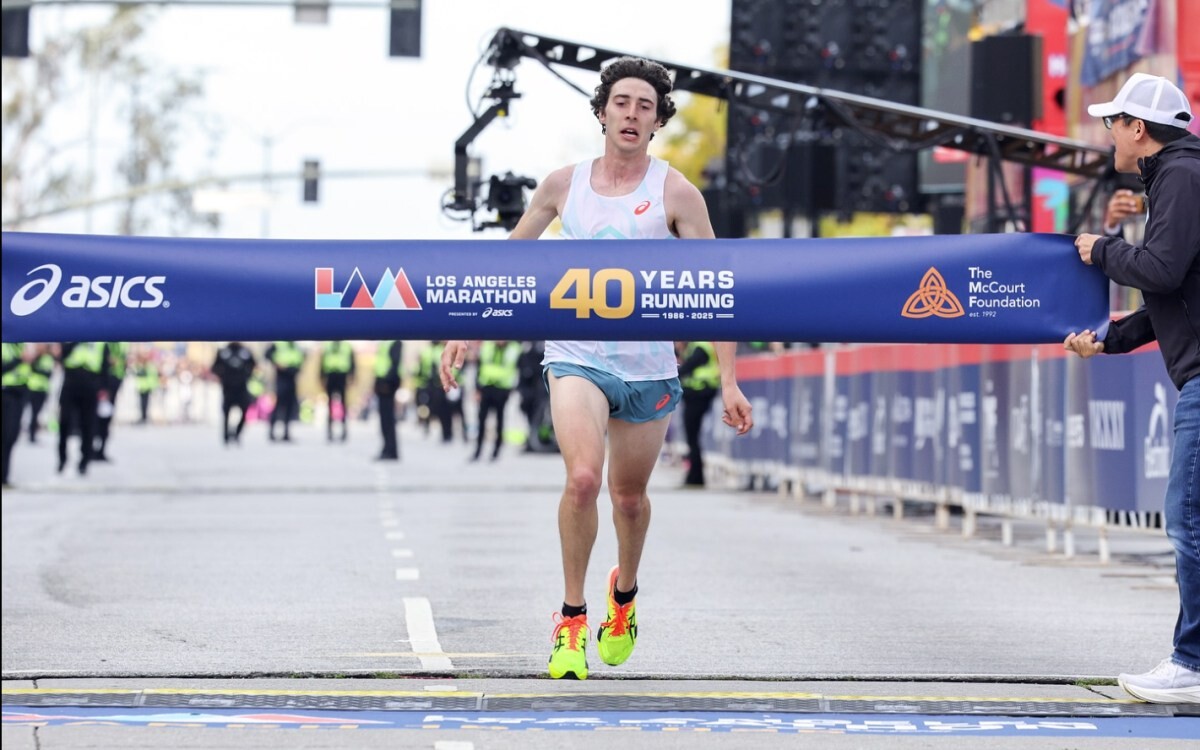
Born on January 13, 2000, in Elburn, Illinois, Richtman was raised in a family where running was part of the fabric of life. His parents, Tom and Karen, along with his sisters, Rebecca and Rachel, were known locally as “The Running Richtmans.” Inspired by that environment, Matt began running competitively in middle school and quickly rose through the ranks.
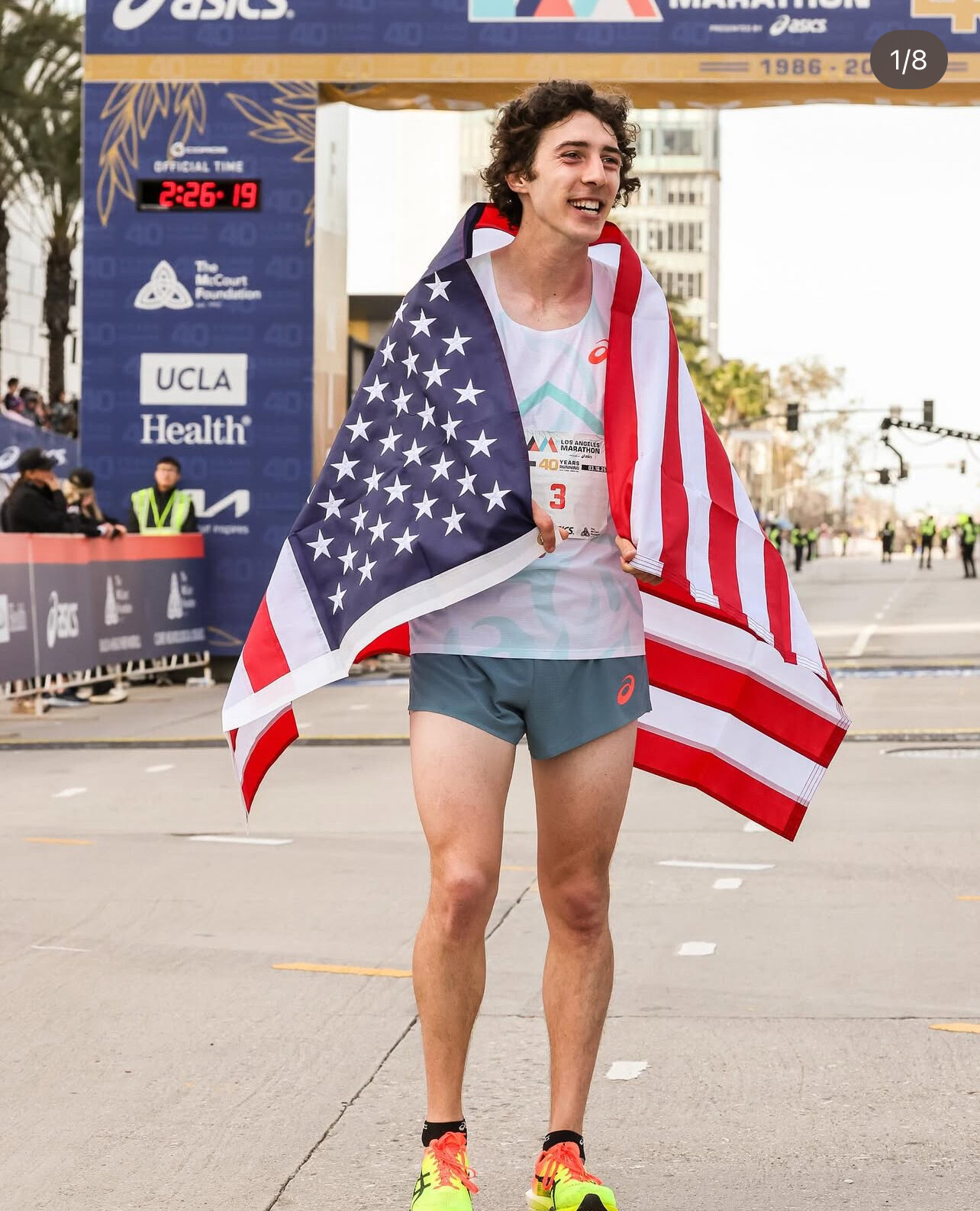
In 2017, as a senior at Kaneland High School, he won the Illinois Class 2A cross-country state title. From there, he ran at Bradley University before transferring to Montana State University, where he earned All-Big Sky honors and became a standout on the cross-country and track teams. He graduated in 2023 with a degree in mechanical engineering.
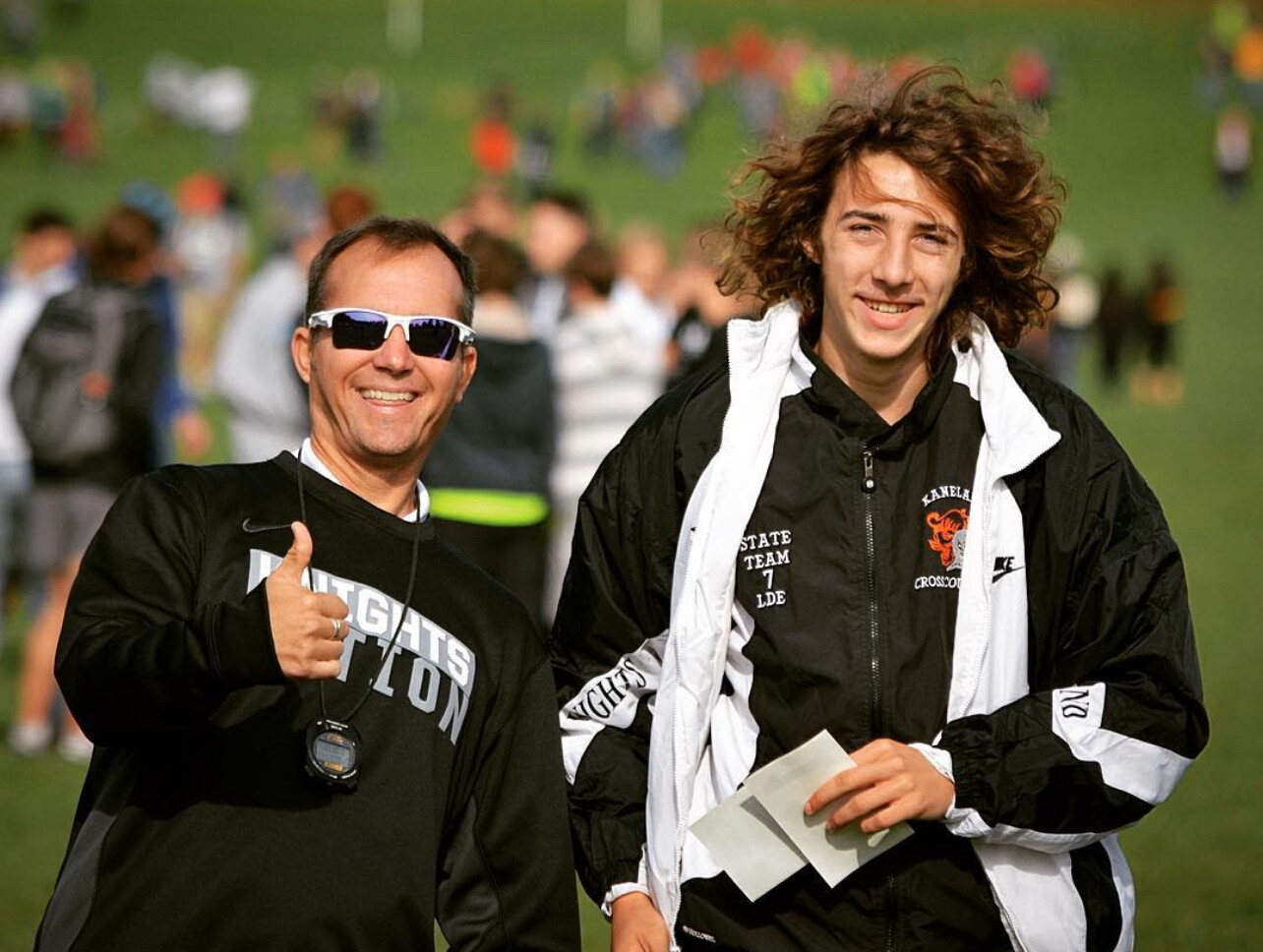
A Blue-Collar Approach to Greatness
After college, Richtman returned to Illinois to work with his father’s carpentry business and volunteered as a coach at his former high school. Though his path diverged from the traditional elite training pipeline, he continued to train with quiet intensity.
In October 2024, Richtman made his marathon debut at the Twin Cities Marathon, finishing fourth in 2:10:47. That performance earned him a sponsorship from ASICS, allowing him to train full-time. Still, he remained self-coached and based in Bozeman, Montana, where he trained with a small group that included former Montana State teammates.
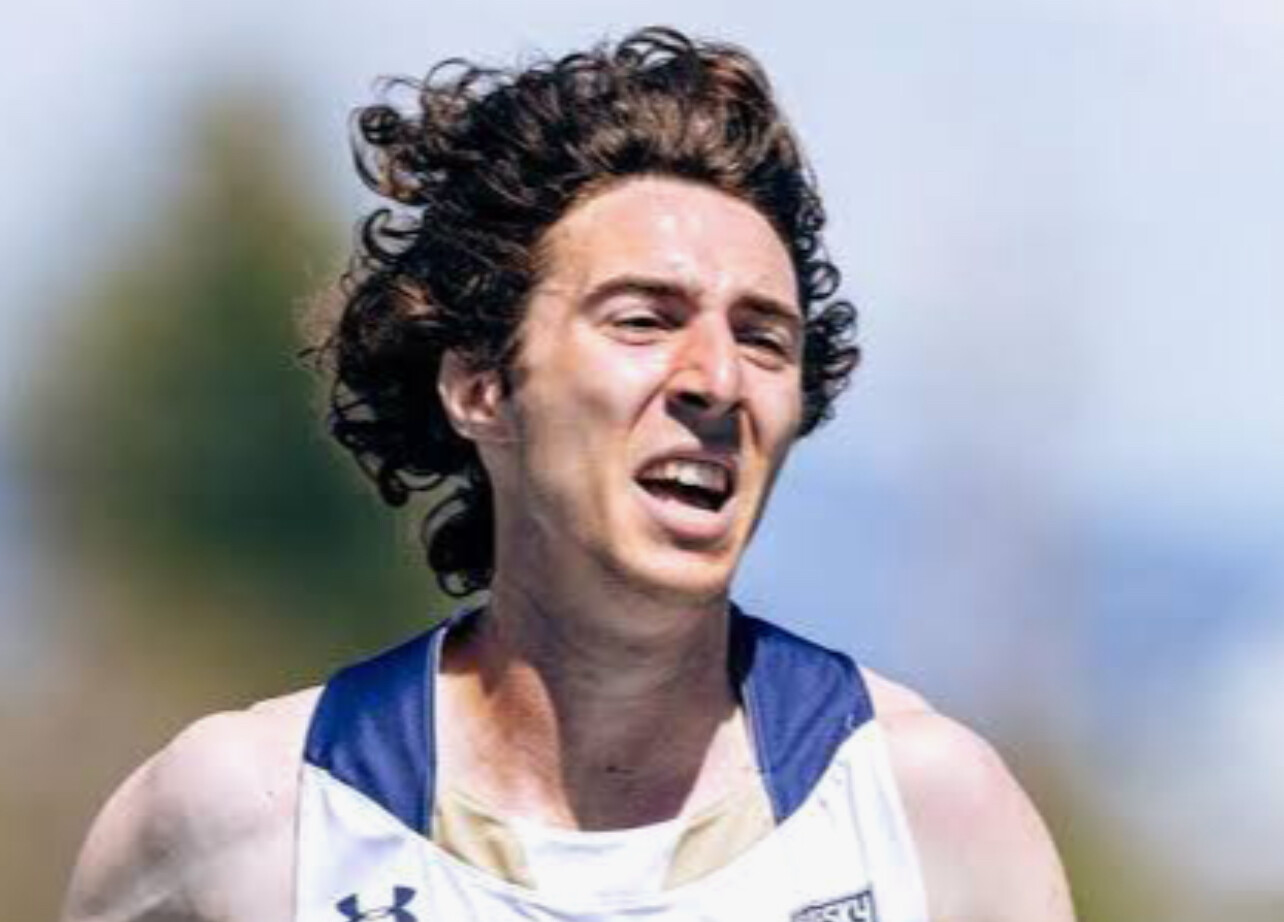
His training emphasized consistency over flash: weekly mileage exceeding 100 miles, long progression runs, and mile repeats with short recovery. No altitude camps. No super team. Just hard work.
Making History in Los Angeles
At the 2025 LA Marathon, Richtman took control in the late miles and never looked back. He crossed the finish line alone, arms raised, breaking a 31-year drought for American men at this race. It was a breakthrough not just for Richtman, but for American distance running.
In post-race interviews, Richtman humbly credited his support system and years of preparation. His father, watching from the finish line, said it best: “Matt trains every day, rain or snow. He earned this.”
What’s Next?
With his sudden rise to national prominence, Richtman now has his eyes on the global stage. He hopes to represent the United States at future World Championships and at the 2028 Los Angeles Summer Olympics—poetically, back where it all started.
Whether or not he joins a professional group or continues to go it alone, one thing is certain: Matt Richtman has proven that there’s more than one path to greatness. His win in LA was more than just a race—it was a reminder of what’s possible when talent meets tenacity.
by Boris Baron
Login to leave a comment
Los Angeles Marathon
The LA Marathon is an annual running event held each spring in Los Angeles, Calif. The 26.219 mile (42.195 km) footrace, inspired by the success of the 1984 Summer Olympic Games, has been contested every year since 1986. While there are no qualifying standards to participate in the Skechers Performnce LA Marathon, runners wishing to receive an official time must...
more...What It Takes to Go Beyond 26.2 - Taking on the Ultra
For many runners, crossing the marathon finish line is the pinnacle of endurance racing. But for an increasing number of athletes, 26.2 miles is just the beginning. The ultramarathon—defined as any race longer than a marathon—has surged in popularity, drawing runners eager to test their limits over 50K (31 miles), 100K (62 miles), 50 miles, 100 miles, and beyond.
But how do you make the leap from marathoner to ultramarathoner? What does it take to conquer these longer distances? Let’s break it down
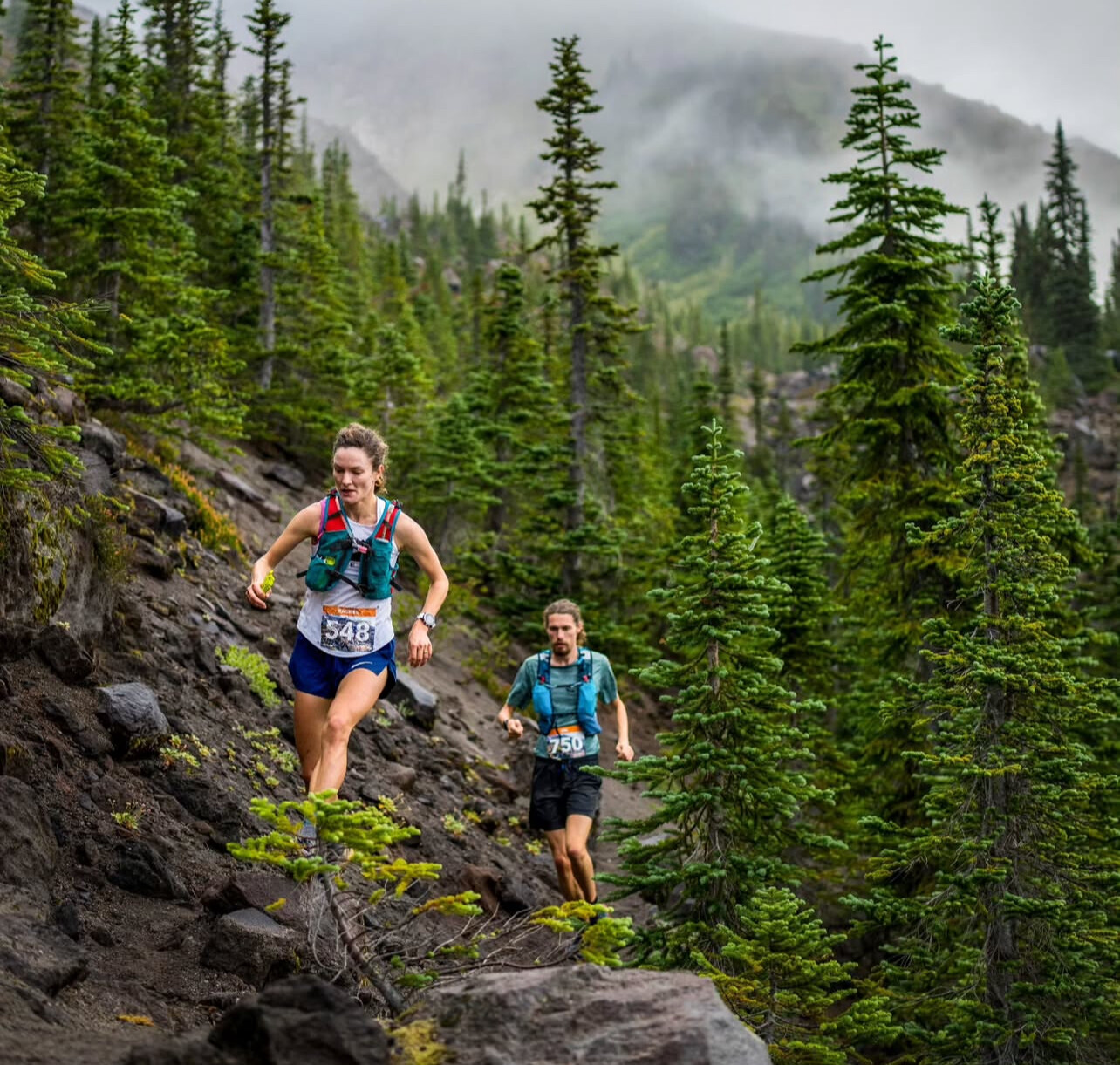
The Key Differences Between a Marathon and an Ultra
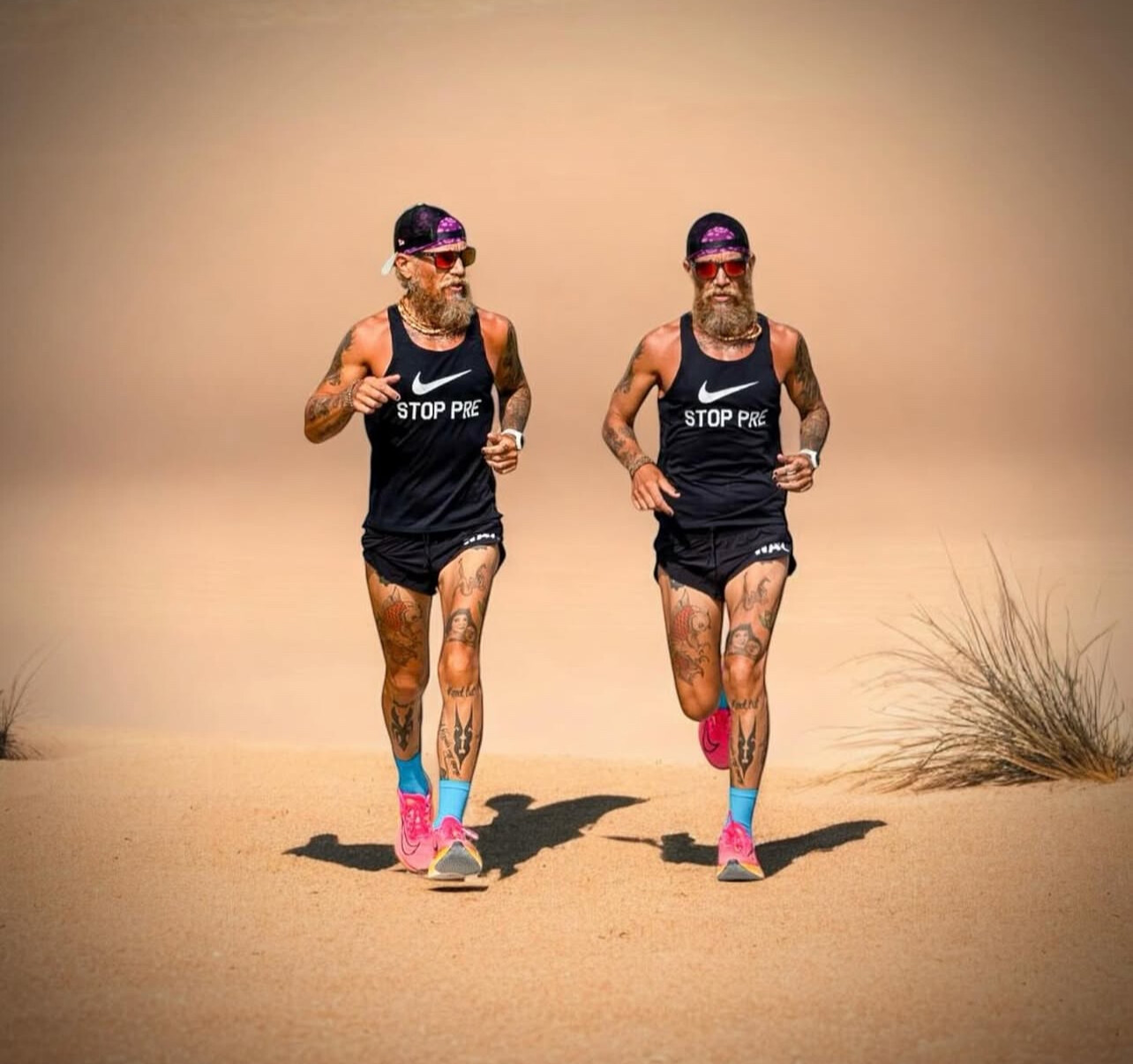
While both require strong endurance, an ultramarathon is a completely different beast from a road marathon. Here’s what sets them apart:
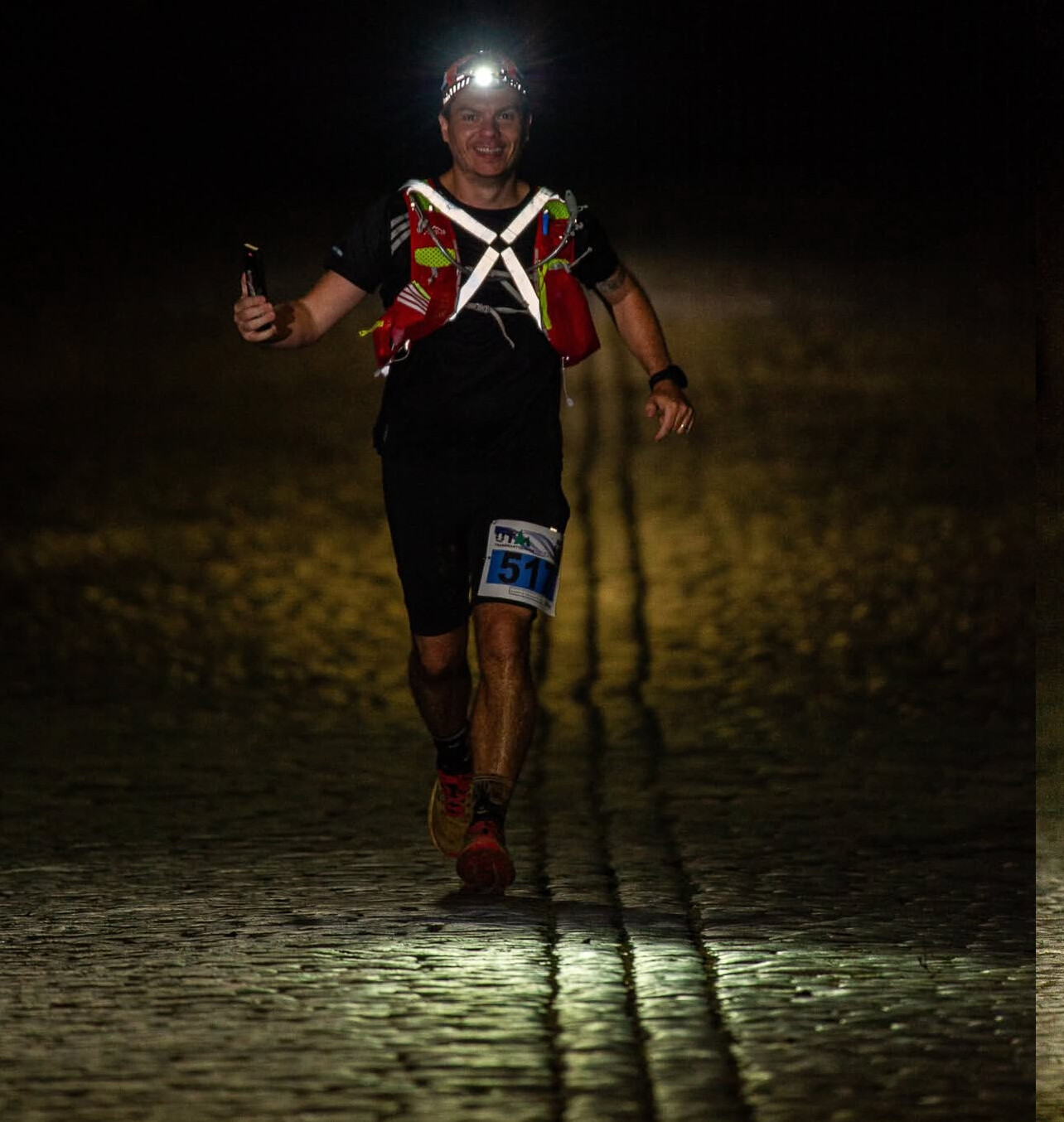
• Pacing Is Crucial – In a marathon, you can push your pace hard and still hold on. In an ultra, going out too fast can be a disaster. Starting conservatively is essential.
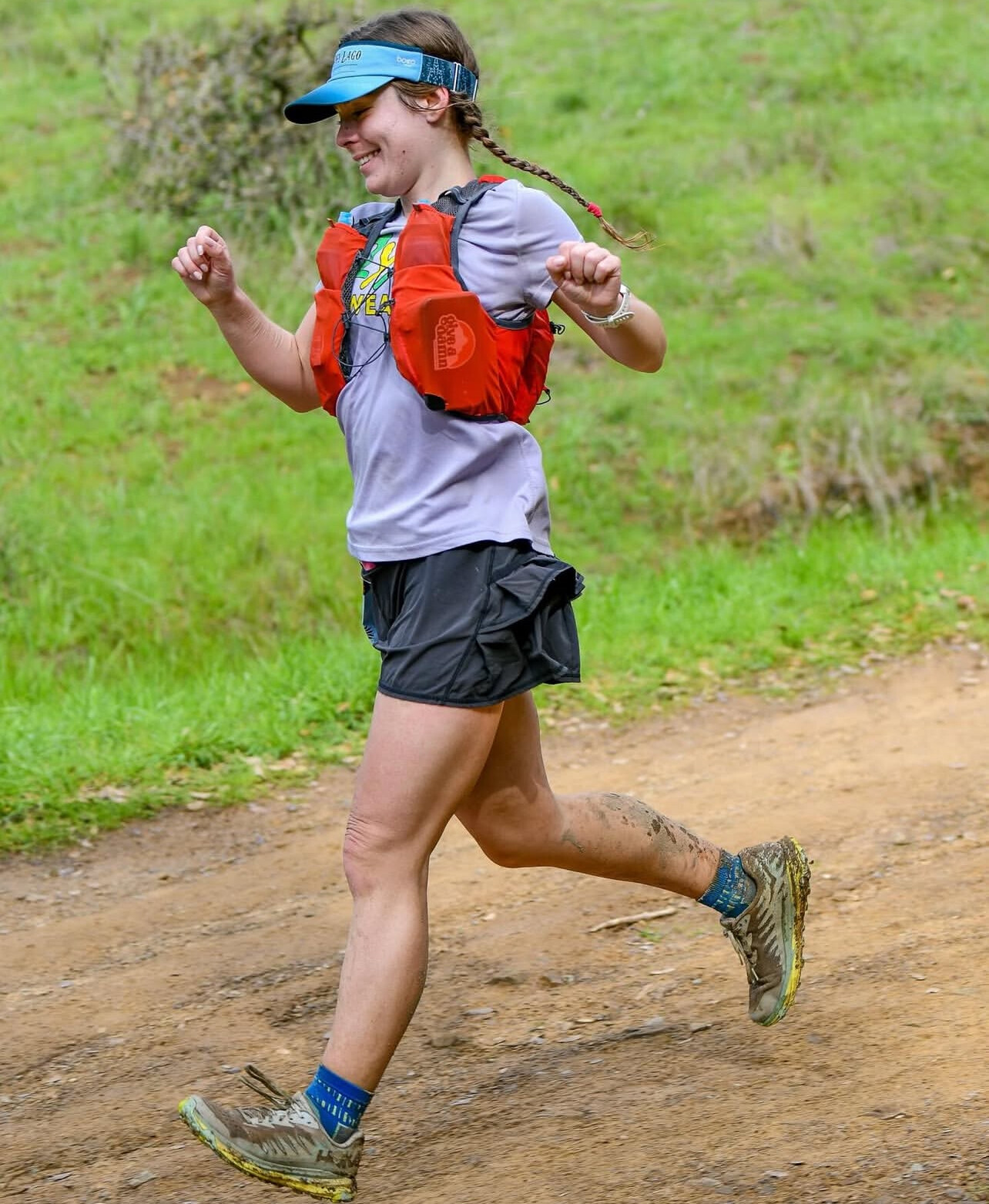
• Nutrition Matters More – Running beyond 26.2 miles means your body will need real food, not just energy gels. Successful ultrarunners eat a mix of carbohydrates, protein, and fatto sustain energy levels.
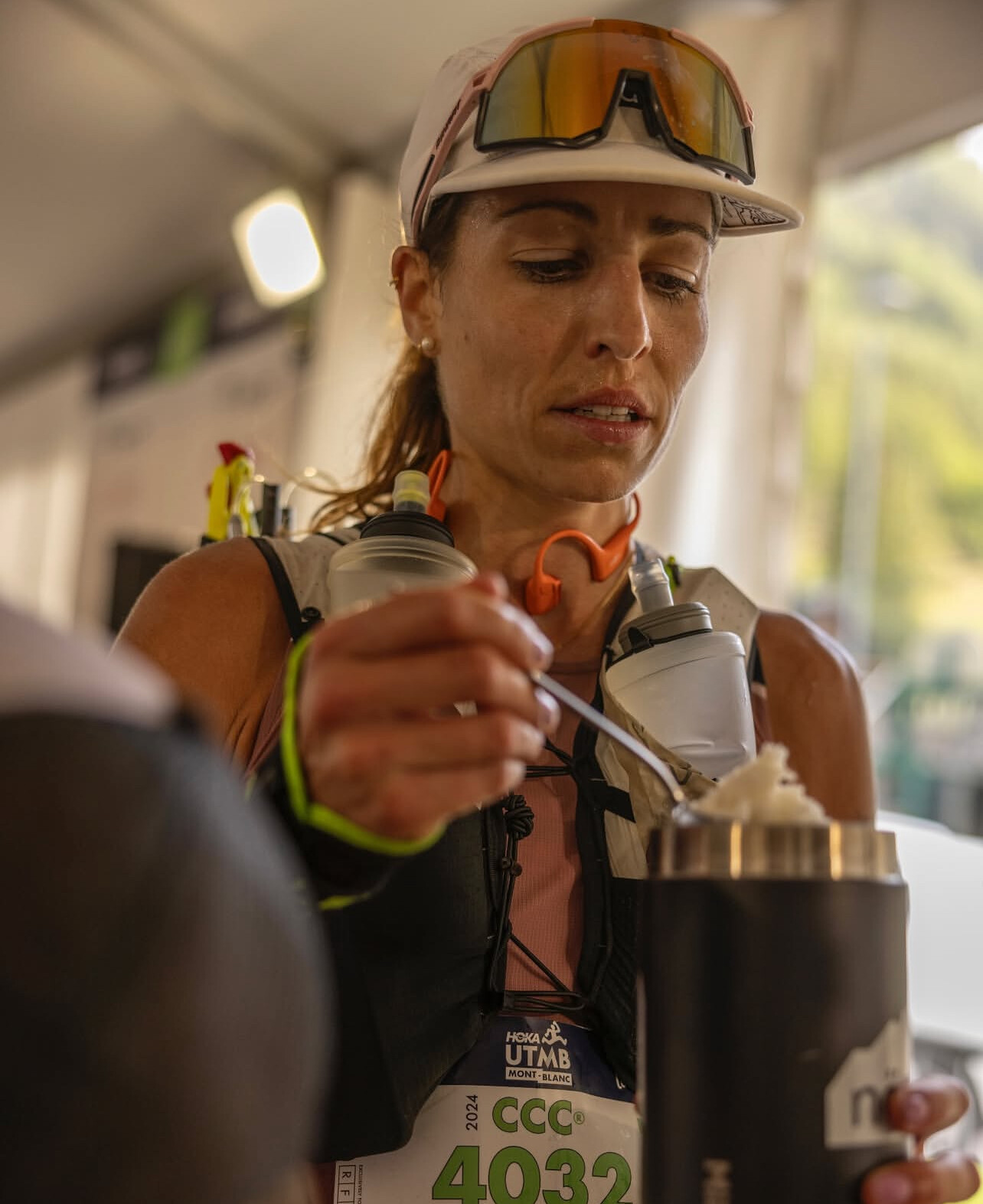
• Trail Running Dominates – Many ultras take place on rugged trails, requiring technical footwork, elevation gains, and varying terrain.
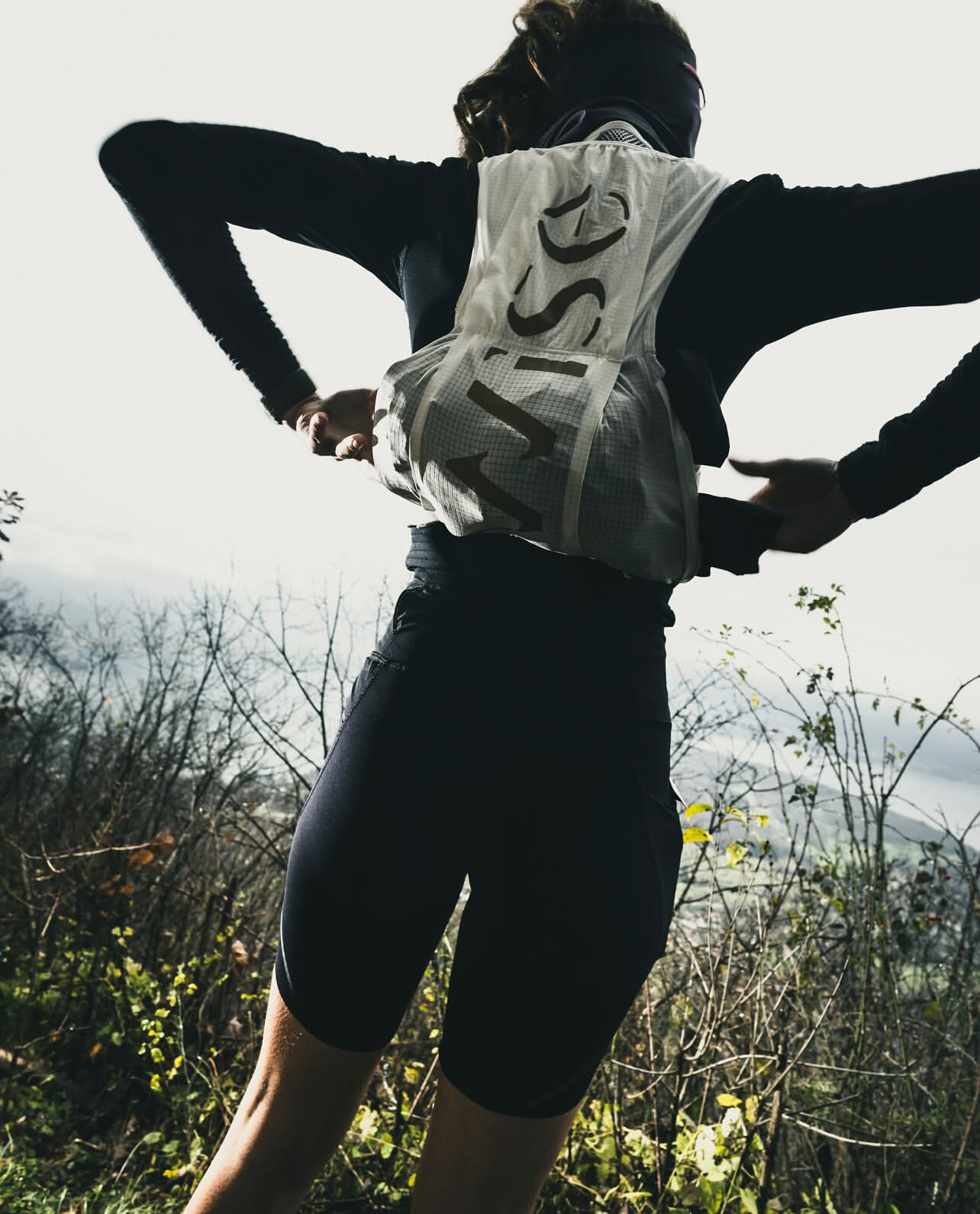
• Mental Fortitude is Everything – Ultramarathons test your mental resilience as much as your physical endurance. Learning to embrace discomfort and keep moving forward is key.
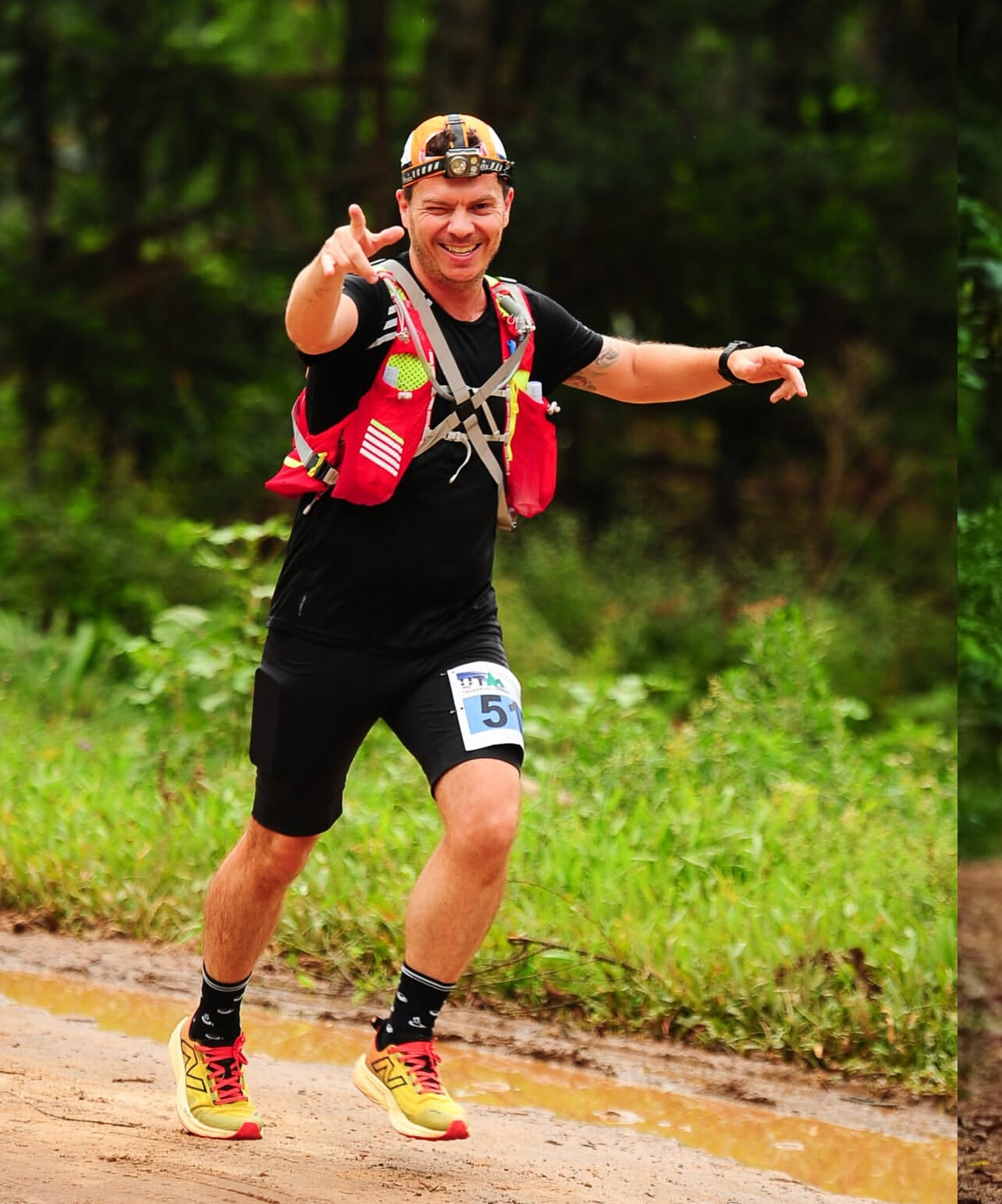
How to Train for an Ultramarathon
1. Build Your Base (Time on Feet > Speedwork)
Training for an ultra isn’t just about miles—it’s about spending long hours on your feet. Instead of focusing on speed, ultra training prioritizes slow, steady endurance.
• Increase Weekly Mileage Gradually – Aim for at least 50-70 miles per week for a 50K and 70-100 miles per week for a 100K or 100-miler.
• Back-to-Back Long Runs – Instead of one long run, many ultra plans include two long runs on consecutive days to simulate running on tired legs.
• Practice Hiking – Even elite ultrarunners hike the steep sections. Practicing power hiking helps conserve energy on climbs.
2. Strength Training & Mobility Work
Ultras put serious strain on your body. Strength training improves durability, while mobility work helps prevent injuries.
• Core Work – A strong core stabilizes you on technical trails.
• Leg Strength – Squats, lunges, and step-ups strengthen the quads, hamstrings, and calves.
• Ankle & Foot Mobility – Essential for navigating uneven terrain.
3. Master Race-Day Nutrition
Unlike marathons, where fueling is simpler, ultramarathon nutrition requires strategy.
• Eat Real Food – Ultras often include PB&J sandwiches, bananas, pretzels, and broth. Find what works for you in training.
• Stay Hydrated & Balance Electrolytes – Dehydration or electrolyte imbalances can end your race early.
• Fuel Frequently – Many ultrarunners eat every 30-45 minutes to avoid bonking.
4. Train for the Terrain
If your ultra is on technical trails, hills, or mountains, training in similar conditions is critical.
• Hill Repeats – Strengthen quads for long descents.
• Technical Trail Running – Practice on rocky or root-filled trails to improve footing.
• Night Running – Many ultras involve running in the dark, so get used to using a headlamp.
Mental Strategies for an Ultramarathon
Running an ultra is as much mental as physical. Even the fittest runners struggle if they aren’t mentally prepared.
• Break the Race Into Sections – Instead of focusing on the total distance, mentally divide the race into aid station segments.
• Have a Mantra – Simple phrases like “Relentless forward motion” or “One step at a time”can help during tough moments.
• Expect Lows—And Know They Pass – Every ultrarunner experiences physical and mental lows, but pushing through leads to new highs.
Choosing Your First Ultra
Not sure where to start? Here are three great entry points into ultramarathoning:
1. 50K Trail Race – A great intro, only 5 miles longer than a marathon but often on trails with varying terrain.
2. 50-Mile Race – A serious jump, requiring race-day nutrition and pacing mastery.
3. Timed Ultras (6-Hour or 12-Hour Races) – Rather than a set distance, these races challenge runners to cover as much distance as possible in a fixed time.
Should You Run an Ultra?
If you love endurance challenges, embrace the grind, and enjoy long hours on the trail, ultramarathoning might be your next big adventure. The transition from marathon to ultra isn’t just about running farther—it’s about running smarter, stronger, and with a mindset prepared for anything.
by Boris Baron
Login to leave a comment
Only one women has ever finished the Barkley Marathons since it started in 1986 - Jasmin Paris
Jasmin Paris cemented her place in ultrarunning history by becoming the first woman to finish the Barkley Marathons in 2024. Known for her endurance and mental toughness, Paris completed the brutal 100-mile course in 59 hours, 58 minutes, and 21 seconds, finishing with just 99 seconds to spare.
A seasoned ultrarunner and former winner of the Spine Race, she battled extreme terrain, sleep deprivation, and navigation challenges to achieve this groundbreaking feat. Her success not only shattered barriers but also proved that women can conquer one of the toughest endurance events ever devised, inspiring runners worldwide.
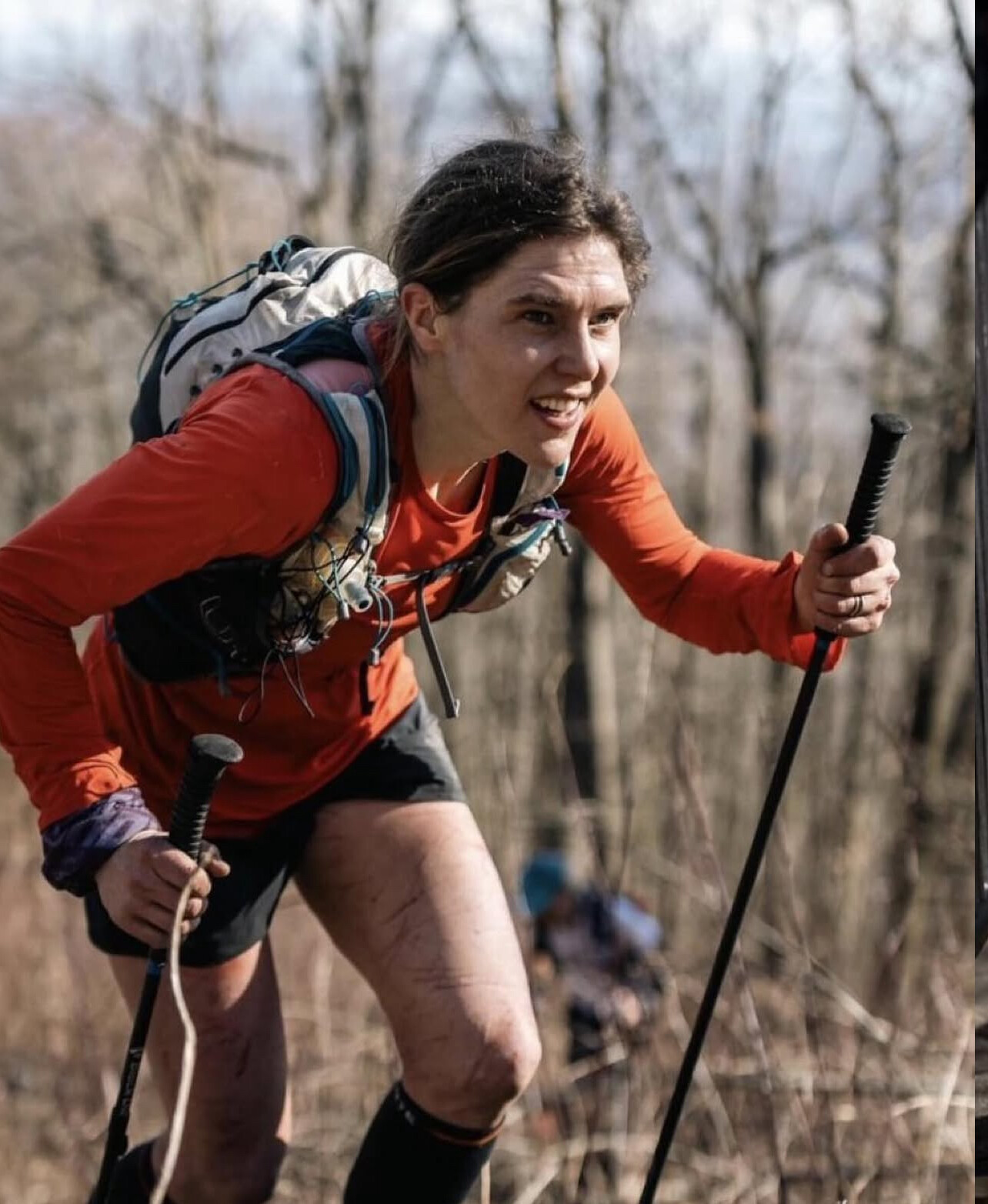
The Barkley Marathons often called the hardest foot race on the planet has long been a symbol of ultimate endurance in the ultrarunning community Established in 1986 this grueling event challenges participants to complete five approximately 20 mile loops totaling around 100 miles within a 60 hour limit Historically the race has seen a minuscule completion rate with only 15 different individuals finishing between 1986 and 2022
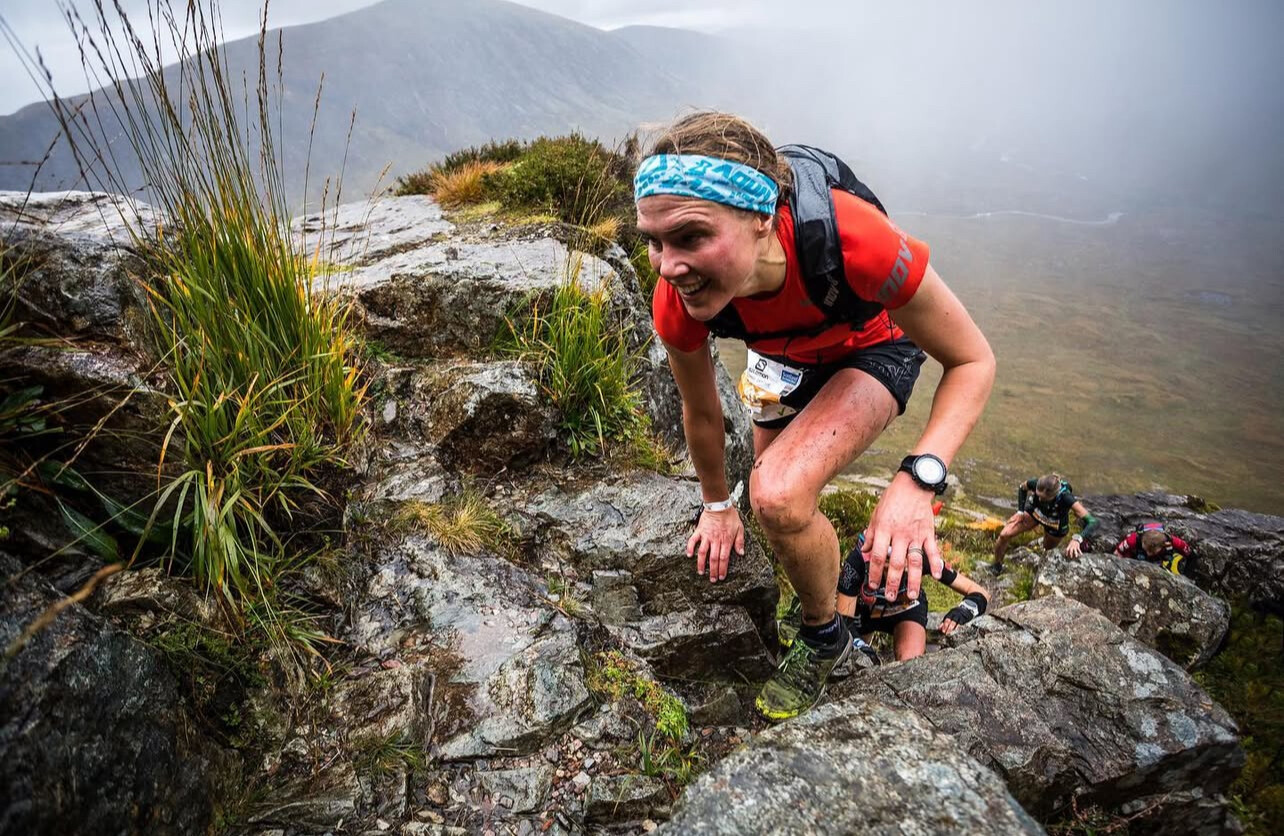
A Surge in Finishers
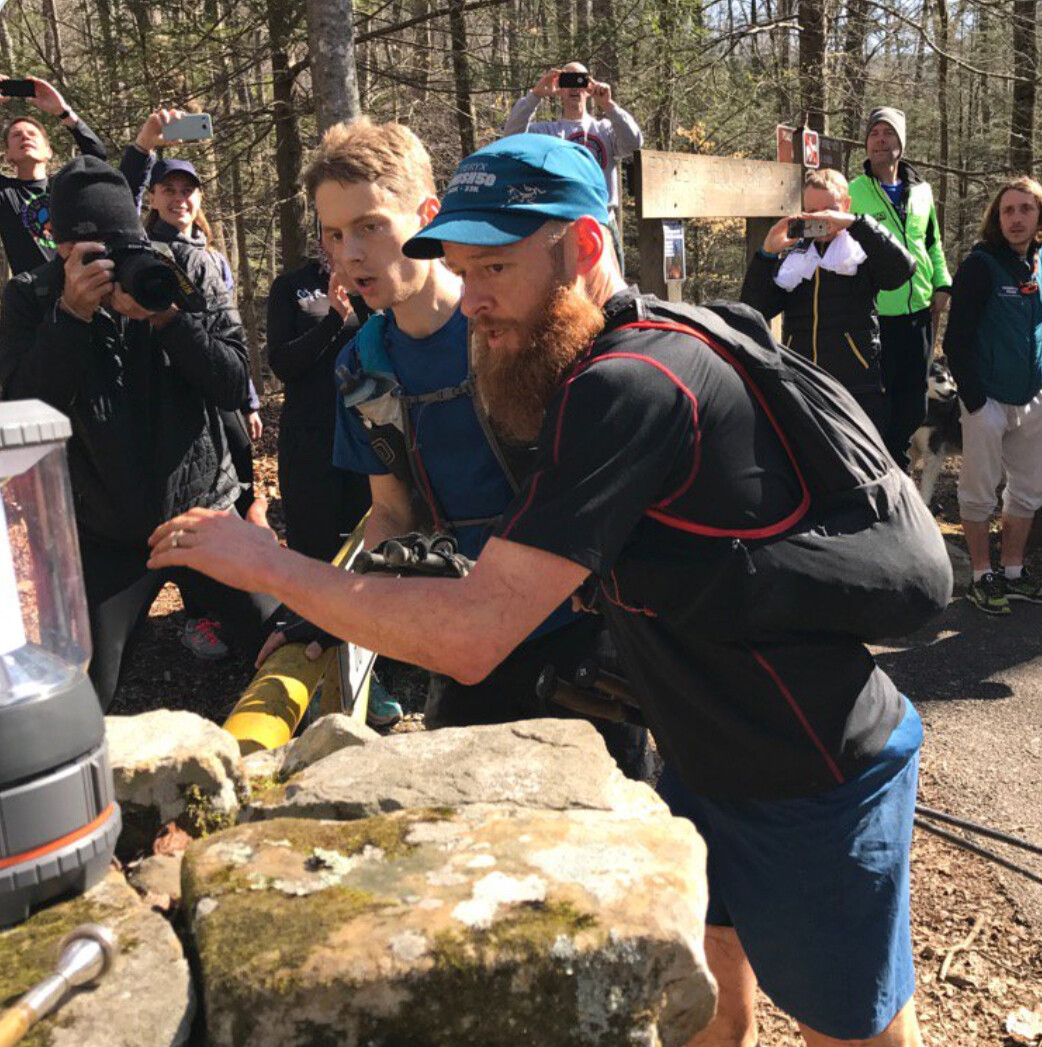
The 2023 edition marked a significant shift Three runners Aurelien Sanchez John Kelly and Karel Sabbe successfully completed the course Kelly who had previously finished in 2017 was joined by Sanchez a debutant and Sabbe who had come close in prior attempts This uptick in completions prompted discussions about the race’s evolving difficulty
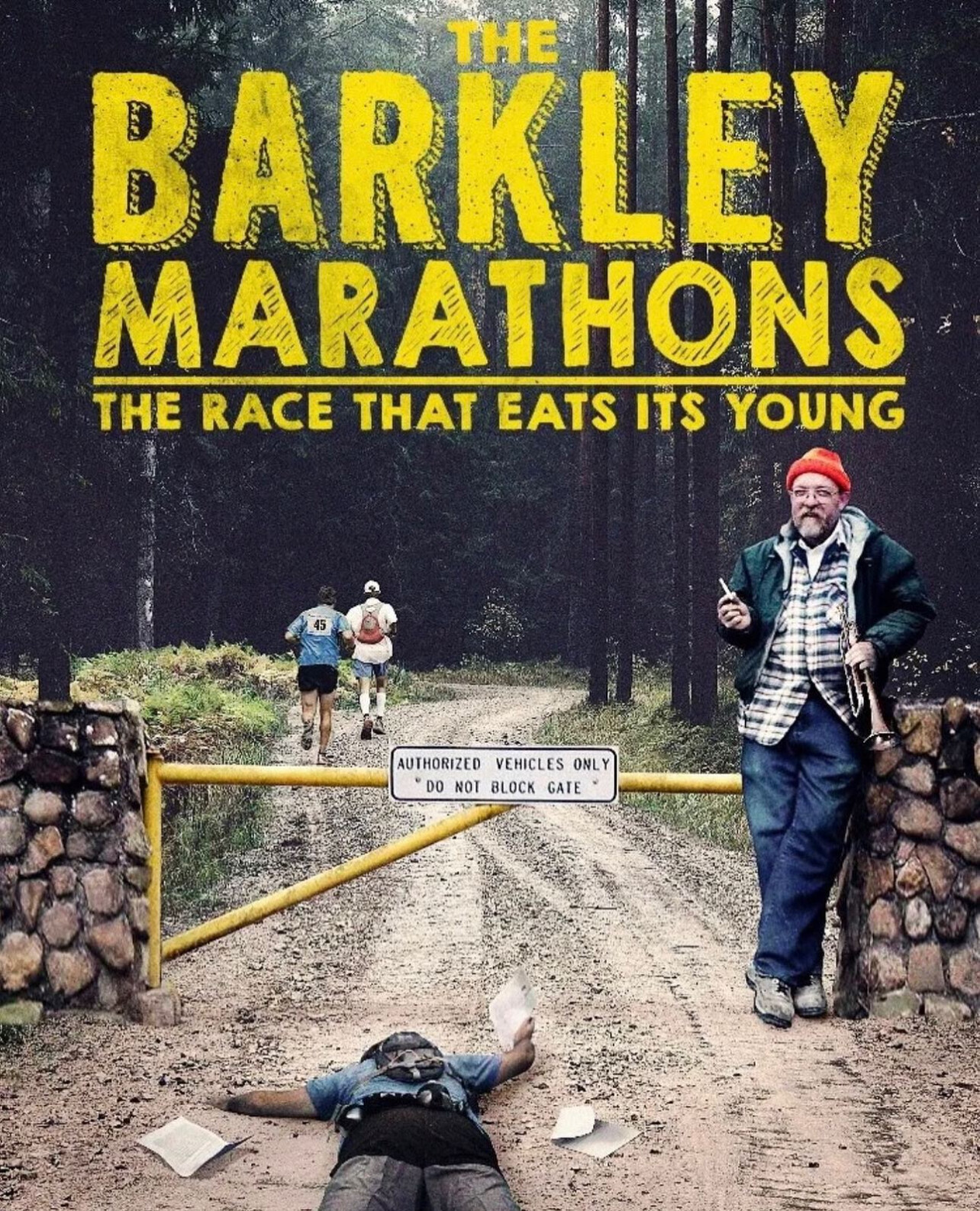
The trend continued in 2024 with an unprecedented five finishers
• John Kelly Secured his third completion reinforcing his status among elite ultrarunners
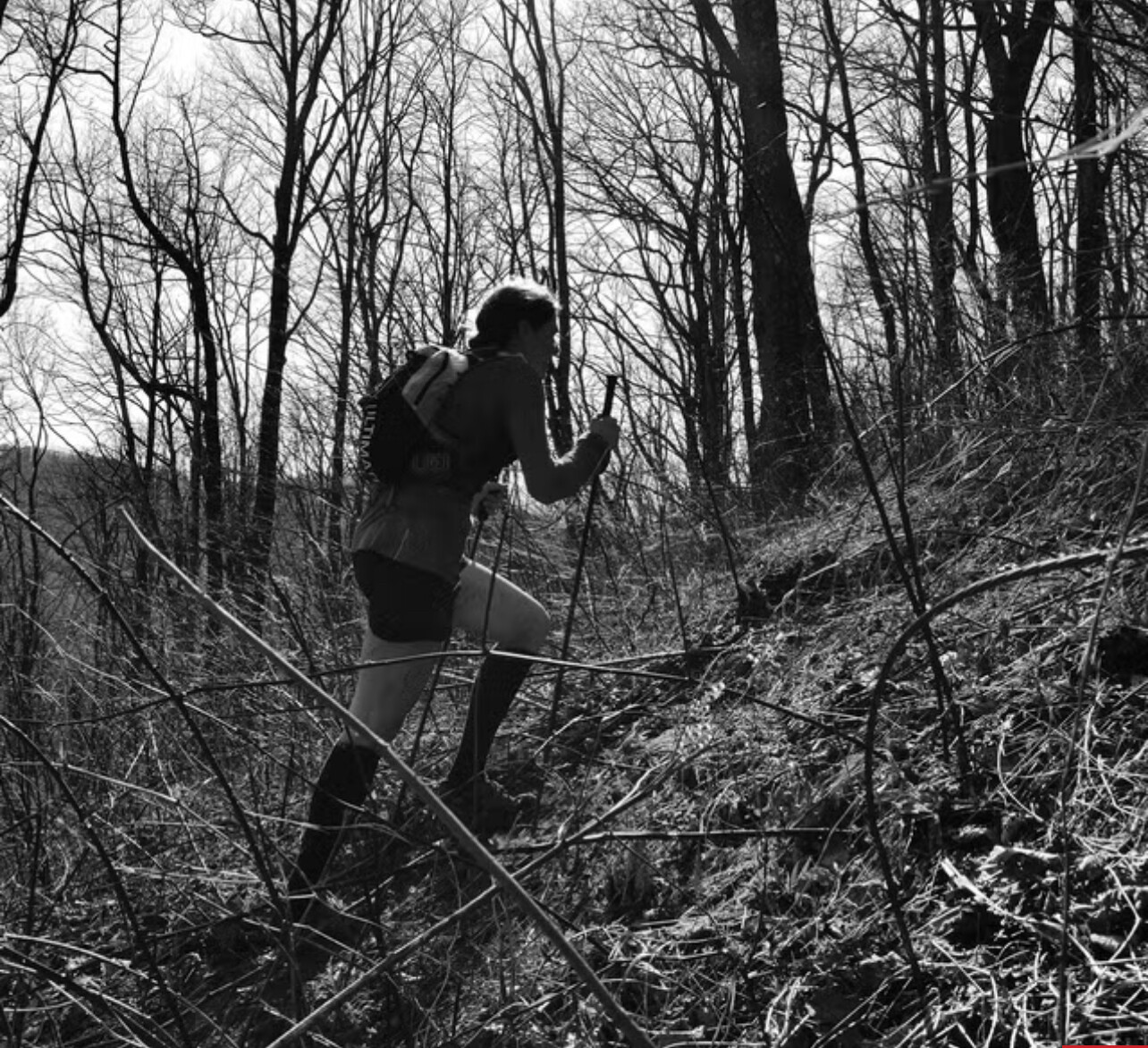
• Jared Campbell Achieved a remarkable fourth finish showcasing enduring resilience
• Ihor Verys A newcomer who defied expectations with a successful debut
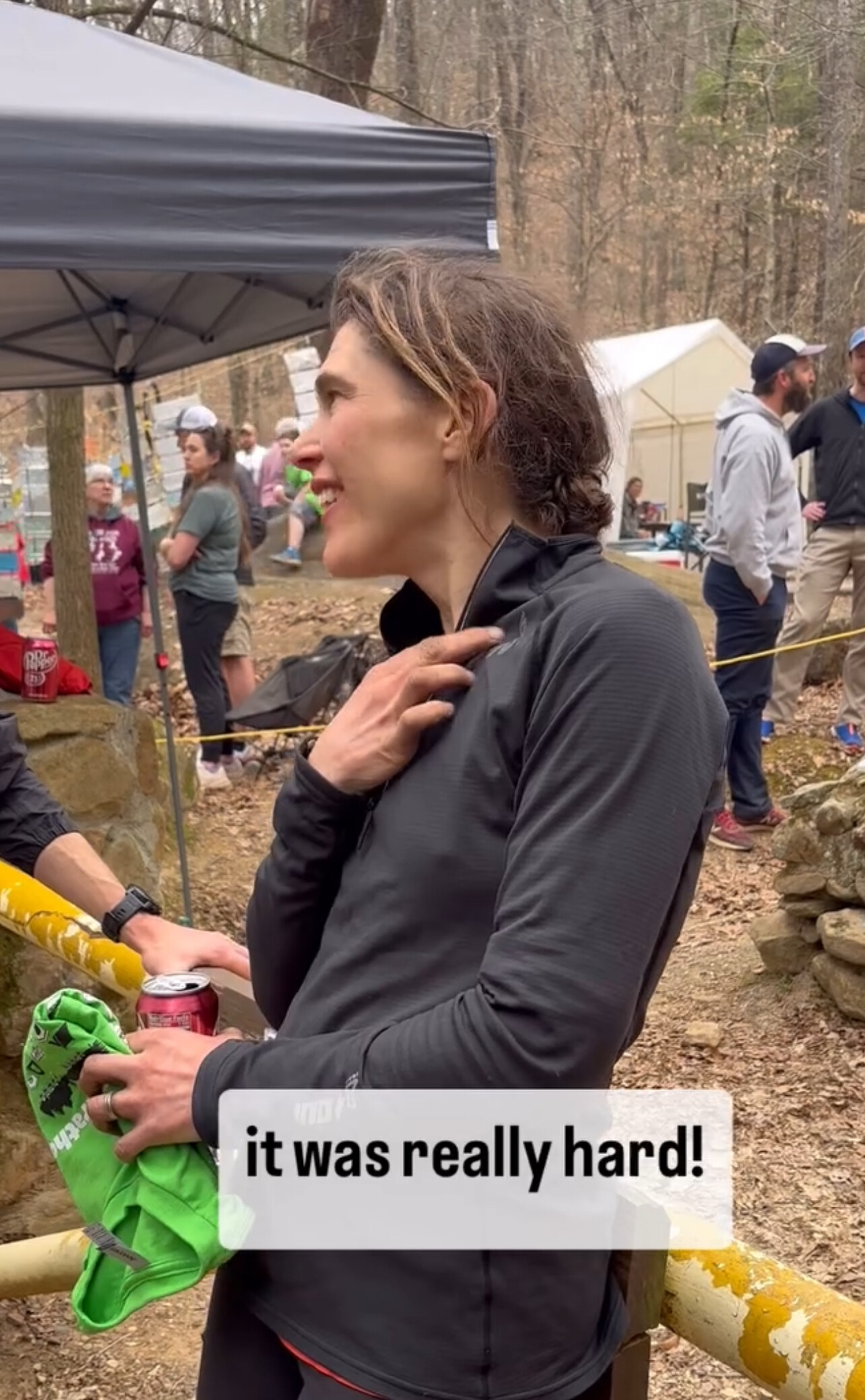
• Greig Hamilton Demonstrated exceptional endurance to join the finishers ranks
• Jasmin Paris Made history as the first woman to complete the Barkley Marathons finishing with just 99 seconds to spare
Paris’s groundbreaking achievement garnered international attention highlighting both her personal triumph and a potential shift in the race’s perceived difficulty
Anticipating the 2025 Edition
The exact date for the 2025 Barkley Marathons remains undisclosed adhering to the event’s tradition of secrecy Historically the race occurs between mid March and early April often aligning with April Fools Day Participants typically receive a 12 hour notice before the start signaled by the blowing of a conch shell by race director Gary Lazarus Lake Cantrell
In light of the recent increase in finishers Cantrell has hinted at making the 2025 course more challenging While specific changes have not been confirmed the goal is to restore the race’s notorious difficulty potentially reducing the number of successful completions

The Barkleys Enduring Challenge
Despite the recent surge in finishers the Barkley Marathons remains an extreme test of endurance navigation and mental fortitude Each year approximately 40 runners are selected to face the unpredictable course with the vast majority unable to complete it As the 2025 edition approaches the ultrarunning community eagerly awaits to see how the race will evolve and who if anyone will overcome its relentless challenges
by Boris Baron
Login to leave a comment
It is amazing that anyone can tackle such a course but they have including the first woman in 2024! - Bob Anderson 3/17 10:21 pm This event is insane and they are going to make the course even harder? - Bob Anderson 3/18 8:40 am |
5 Things Most Marathoners Shouldn’t Worry About
Marathon training can be overwhelming, but some things just aren't worth the stress
With the abundance of marathon training advice available today, figuring out how best to prepare can seem as daunting as the race itself. There are training plans for every ability level, books dedicated exclusively to the subject of marathon nutrition, and accessories for problems you probably didn’t know existed. For someone with limited time to dedicate to the inherently absurd pursuit of racing 26.2 miles, the question may arise: How much of this stuff do I really need to worry about?

Of course, the answer depends on your goals. Anyone looking to qualify for the Olympic Trials will be fine-tuning their training down to the last detail. But for the average marathon runners, it’s easy to miss the forest for the trees.
To help cut through some of the clutter and distill those aspects of marathon training that matter most, we consulted Mario Fraioli, a former collegiate All-American and head coach of the digital coaching service Ekiden. (He also writes a weekly newsletter called the Morning Shakeout.) Fraioli has coached several elite-level athletes, but we picked his brain about what the rest us should be most focused on.
There’s No Magic Marathon Diet
One reason long runs are indispensable to marathon training is that they give you a chance to practice taking in food and drink in a race scenario. When it comes to nutrition-related aspects of marathon prep, figuring out what will work for you in a race is more crucial than worrying about things like “carbo-loading” or trying to find a perfect marathoner’s diet.
Of course, a healthy diet will bolster your chances of racing well, and you’ll need to eat more as you burn more calories, but what constitutes a healthy diet for the average runner doesn’t dramatically differ from a healthy diet in general.
Ingesting gels during the late stages of a race, on other hand, poses a unique challenge that you should prepare for.
“In marathoning, fueling is the X-factor for a lot of people,” Fraioli says, noting that it’s essential to figure out beforehand how your body responds to taking on food after two hours of running. Then there’s the mechanics of it—things like learning to squeeze a plastic cup so you can drink its contents midstride without sending most of it straight up your nose.
“Drinking on the run is something a lot of people, even top pros, struggle with, because they don’t practice it,” Fraioli says.
You Don’t Have to Hit the Track
For most advanced marathon runners, training includes a combination of long runs at or near race pace, as well as short, fast interval workouts. If you can’t fit both into your schedule, it’s best to prioritize the former.
In recent years, fitness media has heralded the benefits of high-intensity interval training, or HIIT, often with the purpose of explaining how the short, fast repetitions can also benefit those preparing for long races. There’s no question that HIIT is a great way to build fitness quickly, but this shouldn’t obscure the fact that, ultimately, long runs are the closest simulation of what you’ll face in a marathon.
The bottom line is that while you can still achieve a very good result in the marathon without incorporating short intervals into your training, missing your long runs will lead to race-day disaster. (Case in point: 60-year-old 2:45 marathoner David Walters hardly runs any short stuff anymore, but, well, he’s still pretty good.)
“Even for most competitive marathoners who are not elite, they are running somewhere between two hours and 30 minutes and three hours and 30 minutes. That’s a lot of time on your feet,” Fraioli says. “Just from that standpoint, the long run carries a greater importance—so you’re comfortable being out on your feet and running that long.”
Focus on Your Own Training Plan, Not the Pros’
Fraioli has recently noticed a lot of very good amateurs trying to emulate the workouts of world-class runners. This is not a wise approach.
“Some runners look at all these wild workouts—40K at 95 percent marathon pace—and they’ll think, ‘Well, if this is what the top people in the world are doing, I’m going to tailor that to my own training,’” he says. “They don’t always realize that for these athletes, it’s their full-time job, and they’ve built up being able to handle that level of stress over the course of many years.”
Instead of trying to figure out what Galen Rupp is doing, the most valuable training log you can consult is your own. Fraioli has documented his training since his high school running days and says it’s like a personal reference text that provides healthy perspective on his entire running career. Such journals are a both great way to see how far you’ve come and an essential resource when it comes to planning your next training cycle.
Save the Racing Flats for When You Qualify for Boston
Yes, we’ve published articles about the benefit of racing in flats, and there have certainly been exciting innovations on this front, but for the majority of marathoners, the procurement of lightweight racing shoes is literally one of the last things they should be concerned about.
“I think racing flats falls into that last 5 percent,” says Fraioli. “Most people should look to optimize the other 95 percent of training elements first.”
If you’re new to marathoning, it’s advisable to complete a few races in the same running shoe you’re used for training, rather than opting for a lightweight model right off the bat. (For advice on picking the perfect shoe, look here.) Down the line, racing flats can increase running efficiency and help shave a few seconds off your finishing time, but they also offer less in the way of cushioning and support. Think of them as a reward to give yourself after your first breakthrough marathon performance.
Your Training Plan Is a Guide, Not an Instruction Manual
There’s no question that training for a marathon requires discipline, but discipline shouldn’t be confused with dogmatic adherence to a prescribed training plan. When putting together a workout schedule for a future race, it’s impossible to know how you’re going to feel on a particular day, eight weeks into your training. Furthermore, you probably can’t anticipate external factors that can cut into your time, whether that’s a workplace fiasco or sudden snowstorm.
Like elsewhere in life, flexibility is key. Once you accept the fact that you may be able to run only four days in a given week, you can focus on making sure to include those workouts that are most important—for example, the weekly long run mentioned above.
“I think there are too many people trying to cram 100 miles into what for them should be a 50-mile week, rather than thinking about what they should be prioritizing,” says Fraioli.
“You don’t want to chase [mileage] numbers for numbers’ sake. You want to prioritize the training elements that will yield the biggest returns for you, based on how much time you have available.”
Login to leave a comment
How Much Mileage Should You Run?
Less is not more. More is almost always more—within reason, and with a plan.People complicate it, but running is like almost every other activity. Want to be a good pianist? Practice a lot. Want to be a great surgeon? Cut a lot of people open.In both activities, it is important that your practice has some direction. Mindlessly slamming the piano keys or taking a knife to grandma during her afternoon nap will not make you an expert (nor popular with the neighbors). But in all cases, the common denominator of expertise is time invested.
It took me way too many years to learn this lesson. In summer 2010, I had just graduated college after gradually getting into running over the previous four years. I was running 20 to 30 mostly hard miles per week (along with some biking), thinking I was doing things right. Then, I found a dog-eared copy of the cult-classic novel Once a Runner, and everything changed.
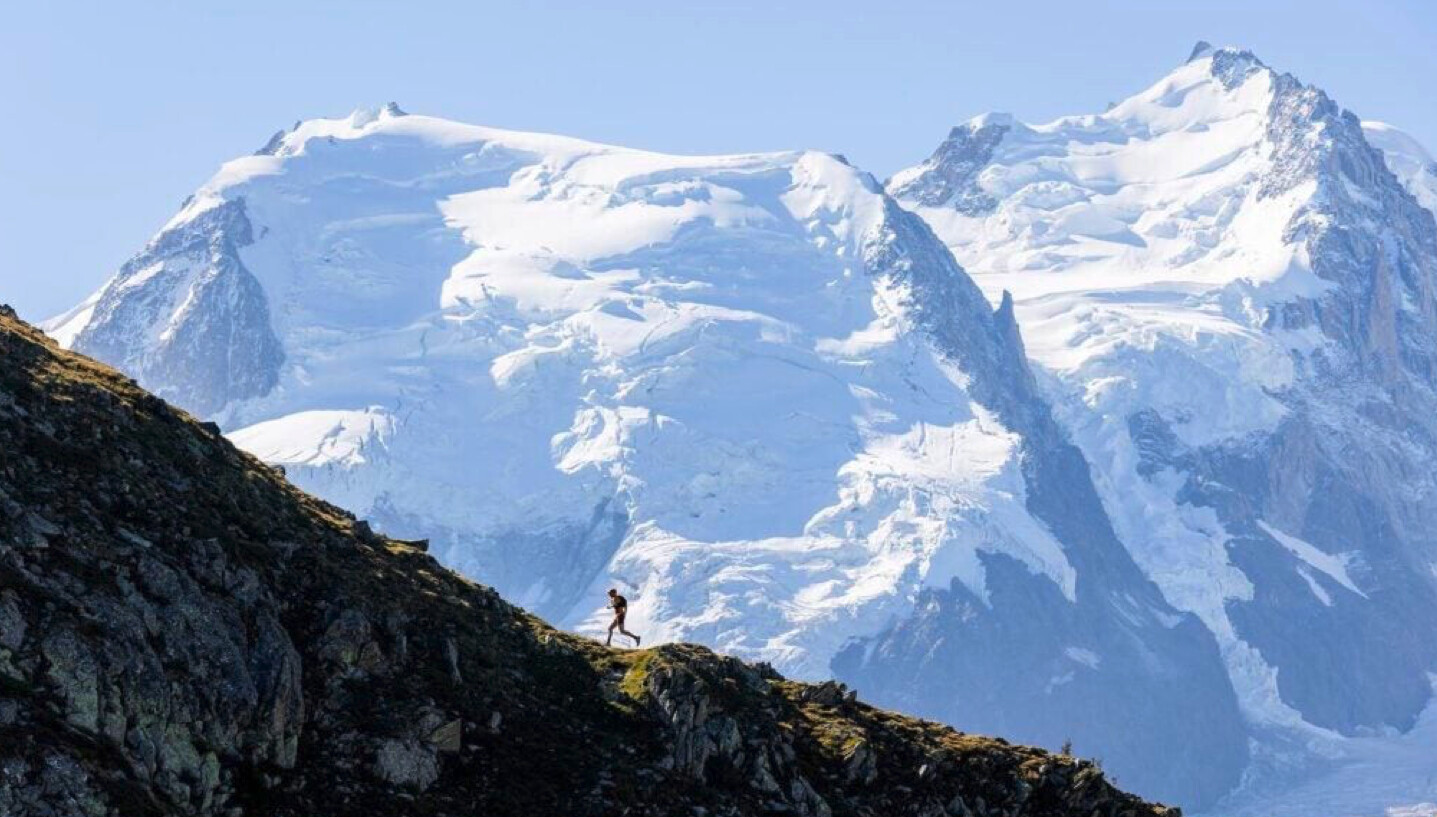
Once a Runner tells the fictional story of Quenton Cassidy, who goes to the woods, trains his butt off, and ends up winning an Olympic medal. It wasn’t the melodramatic prose or poignant narrative that struck me—it was the mileage. Cassidy was running as much in a day as I was running in a week.
After adding a few more dog ears to the book and returning it to the library, I gobbled up every resource on running training I couldAs Cassidy said, “The only true way is to marshal the ferocity of your ambition over the course of many days, weeks, months, and (if you could finally come to accept it) years. The Trial of Miles; Miles of Trials.”What makes running different than activities like the piano is that doing it too much or too hard will result in injury. The injury conundrum makes running unique, and, in my opinion, is the main reason coaches exist. How can we keep you healthy and avoid burnout while maximizing your volume? That question is running training distilled down to its essence.
I’ve written about how to stay healthy before. Cliff notes version: run easy most of the time, practice injury prevention, and eat as hard as you train. But I haven’t confronted the other piece: How much running should you be doing?
How much mileage you should run depends on whether your goal is to finish strong (defined here as being confident that you have done enough training to reach the finish line smiling, even on a bad day) or perform optimally (being confident that you are doing the most you possibly can to reach your running potential). Both are great goals, and both come with different types of sacrifices and planning.To Finish Strong
The general guidelines for finishing strong (and smiling) are below. These mileage totals give you the volume needed to be sure your legs are prepared for racing the distance, with enough training to do the necessary long runs and avoid the race-day trauma that results from running on unprepared legs. (Endurance-based cross training, like biking or Elliptigo, does not count toward total mileage, but can be a valuable addition to a training program.)5K: 10 miles per week (over at least 2 runs)
10K: 15 miles per week (over at least 3 runs)
Half-marathon: 25 miles per week (over at least 3 runs)
Marathon: 30 miles per week (over at least 4 runs)
50 miles: 40 miles per week (over at least 4 runs)
100 miles: 40 miles per week (over at least 4 runs)
Longer races require more volume, and more volume requires more runs per week; concentrating too much mileage in too few runs increases injury risk.
At this level, 100 miles requires the same volume as 50 miles, because in those races, you will be stepping into the deep, dark abyss of the unknown no matter what. So if you are just aiming to finish strong, it is more important to focus on key long efforts (and pray to the ultra-gods profusely for their favor).
To Perform OptimallyPerformance is a tricky, deceiving monster. Much of elite performance is dictated by choosing the right parents. Therefore, we aren’t talking about absolute race performance here, but personal performance relative to genetic capabilities.
The numbers below represent peak sustained volume, or the highest volume you will achieve and sustain for at least a month during hard training.
This formulation is overly simple—you should work up to this volume slowly over time, building a base then adding workouts and modifying total volume based on periodization principles. Remember, volume comes with diminishing returns and is highly individual, so be careful not to run too much for you.
5K to 10K: 6 to 12 hours per week
Half-marathon to 50K: 7 to 15 hours per week
50 to 100 miles: 8 to 16 hoursThat is quite the range, but gives you an idea of the numbers you want to work toward over time. The lower end is for injury-prone or time-crunched runners, especially those who have not run high mileage previously.
These numbers are in time (rather than distance) to account for variances in terrain—steeper, more technical trails are slower, but have a similar aerobic stimulus. Finally, these numbers go out the window for older runners—injuries are more likely for runners in their 50s, 60s and 70s.
A less accurate but clearer way to picture it is in optimal miles per week, assuming non-technical terrain and a consistently durable runner:
5K to 10K: 50-70 miles per week (women), 70-90 (men)
Half-marathon to 50K: 60-90 (women), 70-110 (men)
50 to 100 miles: 60-110 (women), 80-120 (men)If you’re anything like me when I first started learning about training, you may be saying, “That is a lot of mileage!” Good. That is the point of this article—being an expert takes a lot of time, and it’s essential to acknowledge it whether you are a runner or a pianist.
Still, these numbers are not hard-and-fast rules, just guidelines. Just because you can’t reach these numbers doesn’t mean you won’t be amazing at running.
Remember, never increase mileage by more than 10 percent in a week (and 3 to 5 percent if you’ve never run higher mileage before). It took me two years to go from 20 to 30 miles per week to 90 miles per week.
No matter what, always be extremely attentive to injury. Staying healthy is the most important part of running, and durability is a talent in its own right.
There may be shortcuts to good (or even great) performance, but there are no shortcuts to your best performance. Plan for the long term, methodically increase volume and do smart workouts once or twice a week after you have a solid running base.
To put it another way, it’s all about the
Login to leave a comment
In His First 100-Miler, David Roche Demolishes the Legendary Leadville 100 Course Record
Matt Carpenter’s record stood for 19 years.
In his first 100-mile race of his career, trail runner and coach David Roche took down a legendary record in the sport. On Saturday, the 36-year-old broke Matt Carpenter’s storied Leadville 100 course record from 2005, winning in 15:26:34—over a 16-minute improvement of the record.
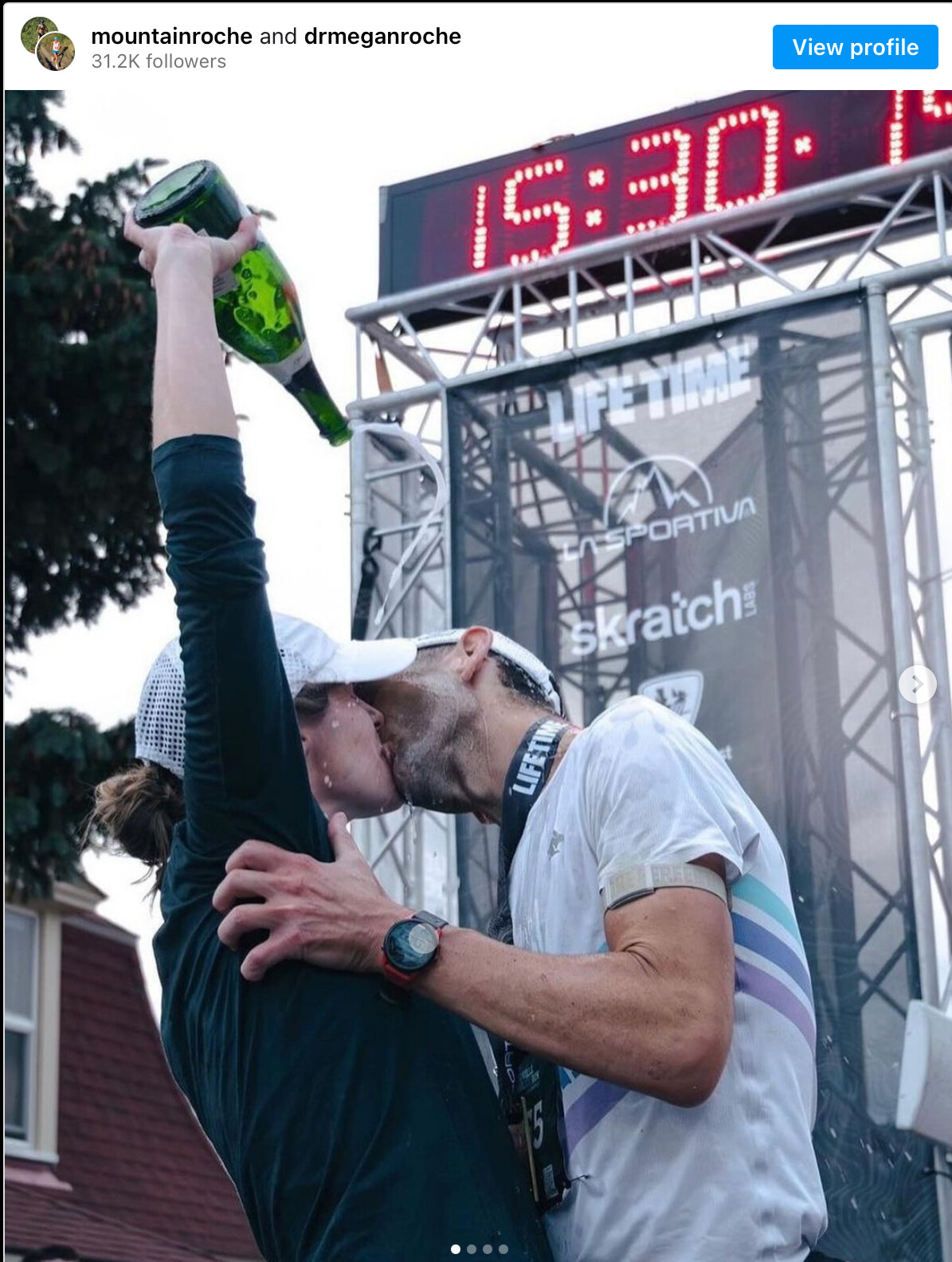
Roche won the men’s race by 30 minutes, on the dot. Adrian Macdonald was second in 15:56:34, and Ryan Montgomery placed third with a time of 16:09:40. In the women’s race Mary Denholm dominated, winning in 18:23:51. Zoë Rom took runner-up honors (21:27:41) while Julie Wright rounded out the podium in 21:48:57.
The Leadville course is notoriously difficult, primarily due to its situation at high altitude. The town of Leadville, Colorado—where the race starts and ends—sits at 10,119 feet above sea level. The “Race Across the Sky” covers more than 18,000 feet of vertical gain and at its highest point, runners reach an elevation of 12,600 feet. (For context, “high altitude” is generally considered to begin around 5,000 feet above sea level.)
Roche went out aggressively and built a sizable cushion on Carpenter’s record of 15:42:59. At the halfway mark, Roche was ahead of course-record pace by over 25 minutes, according to iRunFar. By the 87.4 mile split, the gap had decreased to 15 minutes, but it was enough of a buffer for Roche to maintain.
After the race, Roche posted on Instagram recapping the feat and noting some prerace nerves.
“I put a big scary goal out there early this year: chasing the historic 15:42 Leadville 100 course record by one of the GOATs, Matt Carpenter,” he wrote. “Approaching my first 100 miler, though, I’m not sure I truly believed. I kept joking about where I’d drop out and what my order would be at the Leadville Taco Bell.”
While Roche is an accomplished trail runner, he’s historically had the most success at shorter distances, like the half marathon and 50K. In 2014, he was named the 2014 USATF Sub-Ultra Trail Runner of the Year, and he’s represented Team USA internationally.
Roche, along with his wife, Megan, are well-known in the running community for their coaching business and podcast: Some Work, All Play (SWAP). According to its website, SWAP’s professional roster includes athletes like mountain running world champion Grayson Murphy, three-time Barkley Marathons finisher John Kelly, and steeplechaser/mountain runner Allie Ostrander.
Login to leave a comment
The Incredibly Specific, Occasionally Gross Food We Eat to Fuel Our Ultras
The strangest and most distinct snacks we can’t live without when we’re on the trail all day The Ultra-Trail du Mont-Blanc (UTMB) World Series Finals kick off on August 26 and run through September 1. The annual finale is made up of three races: the Ultra Trail du Mont Blanc Orsières-Champex-Chamonix (50K), the Ultra Trail du Mont Blanc Courmayeur-Champex-Chamonix (100K), and the classic UTMB (100M), across France, Italy, and Switzerland.
Sure, crowds come for the world-class athletes and spectacular views of the Alps, but, some might argue, another big draw is the food—and even the race participants get a taste on the course. Much of the fuel at aid stations are sourced from nearby communities, who bring their best. Think: locally made croissants, bread, cheese, and prosciutto.
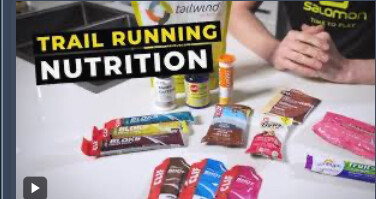
But for those of us who haven’t had the pleasure of running by tents filled with freshly baked French baguettes on our long runs, here’s the weird, the specific, and the sometimes gross on how we fuel our adventures.
On a 13-hour, nearly 10,000-vertical foot ridge scramble/romp through the high peaks in New Mexico a few years ago, I fueled with the food of the gods: birthday cake in a bag. I had somehow scammed my way into having three cakes at my birthday dinner a few nights prior and figured the calorie-to-weight ratio of buttercream frosting couldn’t be far off from Gu. So I cut a generous piece of birthday cake, put it in a Ziploc, and stashed it in my pack. By the time I went to eat it, it had lost all structure and I could easily squeeze it directly into my mouth from a hole —Abigail Barronian, senior editor, Outside
The last time I ran 100 miles, it was a self-supported multi-day journey through the English countryside. The bad news: no aid stations. The good news: pubs and cafes at far greater frequency. I was able to refill my vest with raisin scones and coffee every ten miles. By itself, a scone is pretty dry. But combined with a mouthful of coffee (or even water), it becomes an easy-to-digest, carby snack that’s just the right amount of sweet. Plus, it’s perfectly sized to fit in a chest pocket.
—Corey Buhay, interim managing editor, Backpacker
I have been blessed with a rock-solid stomach and have never had gastrointestinal issues during any run or race. That gives me the freedom to consume just about anything, but I notably veer away from energy gels and opt for real food—either the breakfast burritos or ramen noodles available at aid stations or peanut butter tortilla wraps (sometimes with Nutella) and Pay Day candy bars (because they don’t melt and have a good blend of calories, carbs, fat and protein). I have also been known to drink pickle juice straight from the jar for the sodium content. I love the taste!
—Brian Metzler, editor-in-chief, RUN
I’m all about having a variety of guilty pleasure snacks on hand during an ultra! My favorite is a specific mix from Trader Joe’s called Many Things Snack Mix, with honey-roasted peanuts, sweet and spicy Chex-like cereal squares, pretzel sticks, and bread chips. It’s basically Chex mix. I put it in a Ziploc bag and relish being able to eat it without guilt during my run (because when I eat it at home, it’s never really fulfilling any kind of nutritional need and I always eat too much of it!).
I’ll also pack a Ziploc bag with gummy bears, and then another one with half of a peanut butter and jelly sandwich. Peanuts and peanut butter go down easy for me while also providing a bit of a “stick to your ribs” satiety, while the gummy bears have a fun texture and come with a sugar rush. A PB&J sandwich kind of combines both sides of that, and then the Chex mix—as long as it has some spicy pieces—wakes up my taste buds.
Login to leave a comment
Harvey Lewis races Badwater 135 for the 13th time in a row
This year’s edition of Badwater 135, dubbed the “world’s toughest foot race,” kicked off on Monday, plunging runners into the brutal extremes of California’s Death Valley. This year’s race featured the return of fan favorites, including Backyard Ultra world champion Harvey Lewis, a two-time Badwater winner making his 13th consecutive appearance, and fellow American Pete Kostelnick, also a two-time champion, who made a remarkable comeback after a severe car accident in Leadville. American Shaun Burke claimed the overall victory amidst the scorching heat, while Norwegian Line Caliskaner triumphed in the women’s category, finishing an impressive second overall.
The 135-mile (217km) race kicks off at the Badwater Basin, which, at 85 metres below sea level, is the lowest point in North America. This year’s race saw temperatures hitting a scorching 51 degrees Celsius. Runners who finish under the 48-hour mark earn the prestigious Badwater 135 belt buckle.
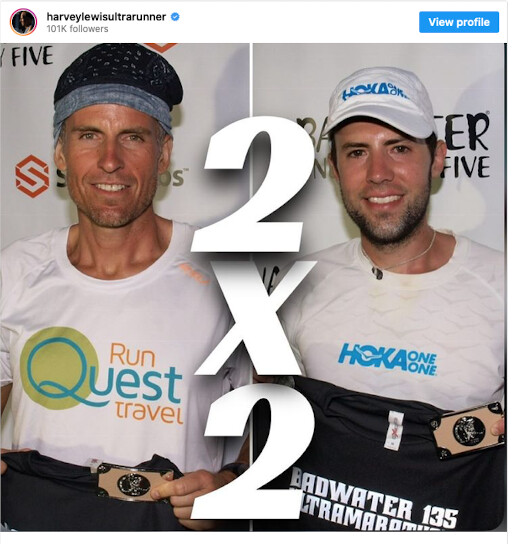

In 2023, Viktoria Brown of Whitby, Ont., was the only Canadian in the field of 100 runners and finished in 30:11:52 securing fourth among the women and claiming 13th place overall. This year’s race saw two Canadians joining the ranks—Frances Picard of Quebec, and Hannah Perry from Canmore, Alta.
Men’s race
Last year’s men’s champion, Simen Holvik of Norway, led for much of the race—in 2023, Holvik was second to U.S. runner Ashley Paulson, who finished first overall and took two hours off her own women’s course record. Burke, who received a late invite to the event in June, steadily closed the gap, eventually overtaking him before the 108-mile timing point. Holvik did not finish the race, leaving Burke unchallenged for the remainder.
Burke completed Badwater for the first time in 2023, when he was sixth overall and fourth among the men. Spanish runner Iván Penalba Lopez claimed the second men’s spot (third overall) in 28:06:34 in his third finish of the race, and Michael Ohler of Germany completed the men’s podium and third man (fourth overall) in 28:24:25. Kostelnick succeeded in finishing his come-back race, crossing the line in 35:28:55; Lewis followed in 36:41:22.
Picard, who was tackling the race for the first time, was still on course at the time of publication.
Top men
Shaun Burke (U.S.) 23:29:00 Iván Penalba Lopez of Alfafar (Spain) 28:06:34 Michael Ohler (Germany) 28:24:25
Women’s race
Caliskaner became the first Norwegian woman to complete the event, finishing second overall. An accomplished ultrarunner, in 2023 52-year-old Calinskaner won both the Berlin Wall Race (100 miles), and the Thames Path 100-miler. She maintained a narrow lead over Micah Morgan of the U.S. early on and added to her lead as the race progressed. Caliskaner finished in 27:36:27, over two hours ahead of Morgan, who finished in 29:11:28, second among the women and fifth overall.
Josephine Weeden of the U.S. rounded out the women’s podium in 33:26:37. Absent from this year’s race was American Ashley Paulson, who won the women’s race for the past two years and took the overall title last year. Alberta’s Perry was still on course at the time of publication but had passed through the 108-mile aid station in 29 hours and 51 minutes.
Top women
Line Caliskaner (Norway) 27:36:27 Micah Morgan (U.S.) 29:11:28 Josephine Weeden (U.S.) 33:26:37
by Running magazine
Login to leave a comment
Western States 100: Walmsley Wins a Fourth Time While Schide Rocks the Women’s Field
For hours, Katie Schide (pre-race and post-race interviews) chased ghosts. For hours, Jim Walmsley (pre-race and post-race interviews) and Rod Farvard (post-race interview) chased each other. And in the end, after 100 courageous, gutsy miles at one of the world’s most iconic ultramarathons, it was Schide and Walmsley who won a fast, dramatic 2024 Western States 100.
Schide, an American who lives in France, was on pace to break the course record until late in the race, while Americans Walmsley and Farvard battled throughout most of the second half of the race, alternating the lead as late as mile 85.
Schide’s winning time was 15:46:57, just over 17 minutes behind Courtney Dauwalter’s 2023 course record, almost an hour faster than her own time last year, and the second fastest women’s time ever. Walmsley, meanwhile, won his fourth Western States in 14:13:45, the second fastest time ever — only behind his own record of 14:09:28 that he set in 2019.
Second and third in the men’s race came down to an epic sprint finish on the track between Farvard and Hayden Hawks (pre-race and post-race interviews), who finished in 14:24:15 and 14:24:31, respectively.
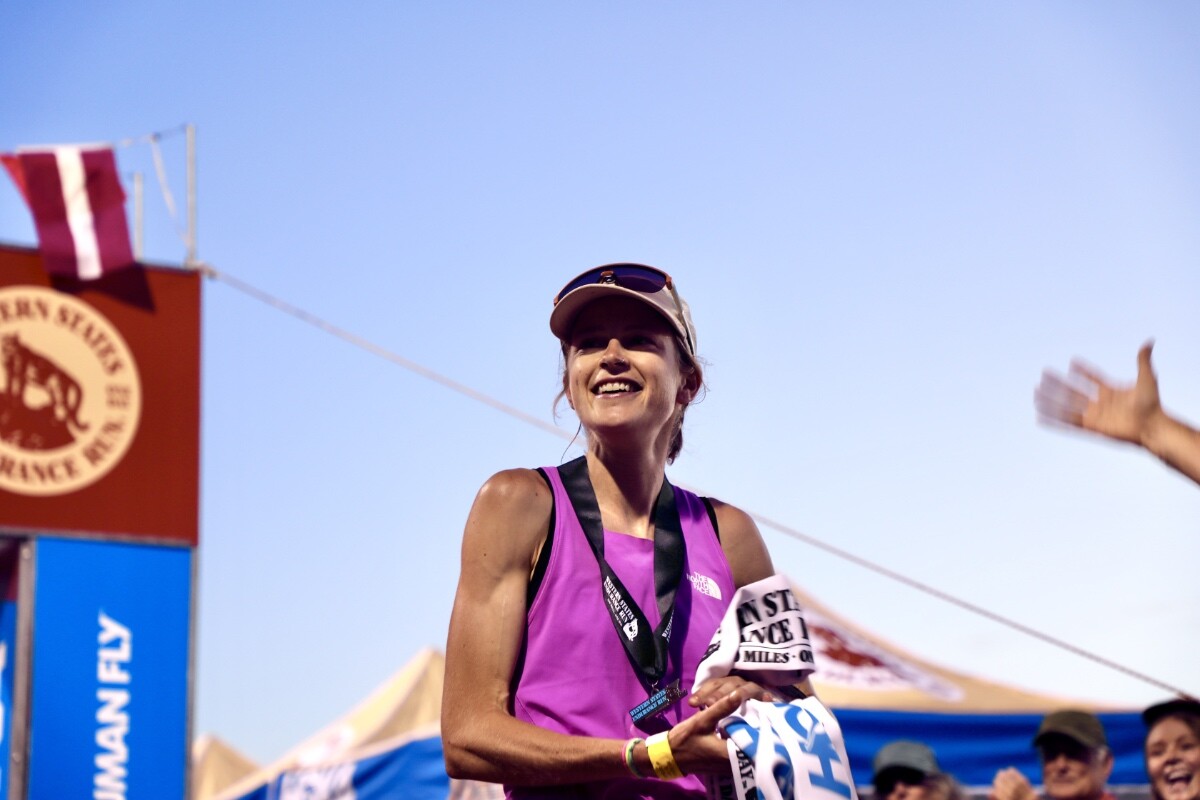
In the women’s race for the podium, Fu-Zhao Xiang (pre-race and post-race interviews) finished second in 16:20:03, and Eszter Csillag (pre-race and post-race interviews) took third for the second time in a row, in 16:42:17.
Both races featured one of the deepest and most competitive fields in race history, with the men’s top five all coming in faster than last year’s winning time, and the women’s top 10 finishing just under 40 minutes faster than last year’s incredibly competitive top 10.
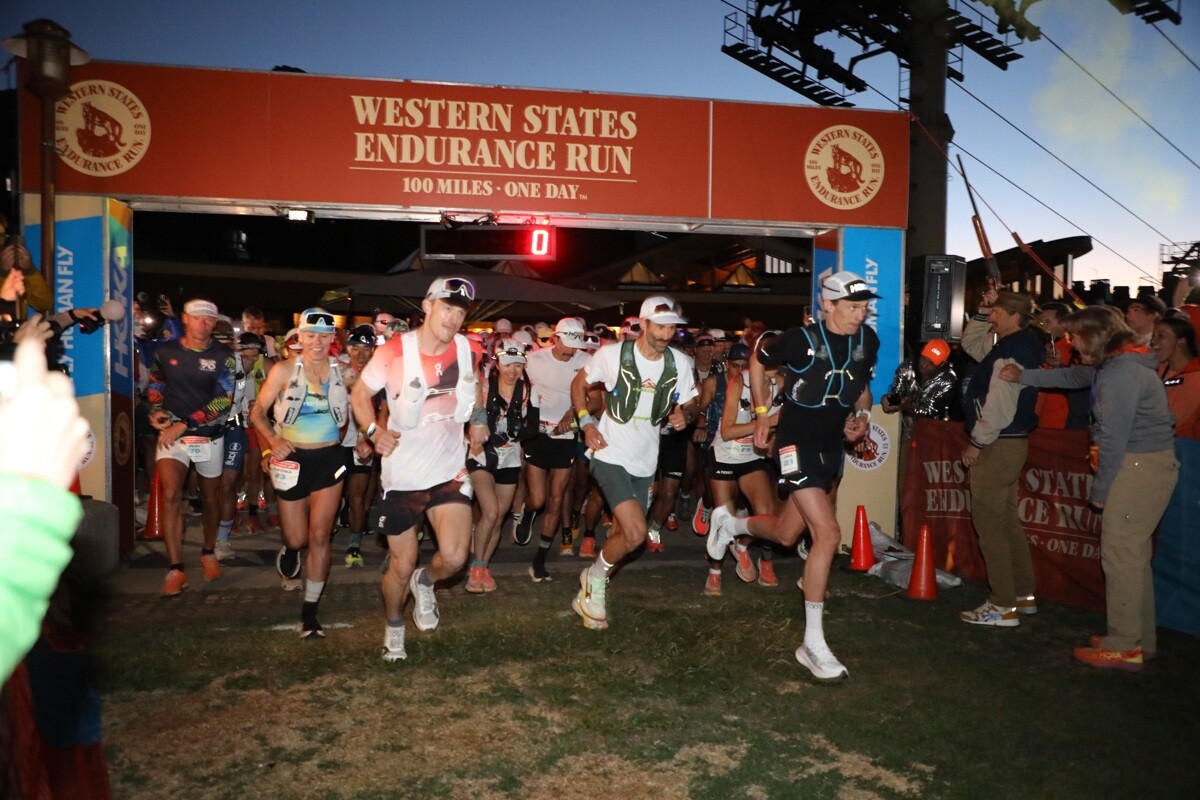
At 5 a.m. on Saturday, June 29, they were all among the 375 runners who began the historic route from Olympic Valley to Auburn, California, traversing 100.2 miles of trail with 18,000 feet of elevation gain and 22,000 feet of loss. After last year’s cool temperatures, the weather at this year’s race was a bit warmer, albeit with a notable lack of snow in the high country. The high temperature in Auburn was in the low 90s Fahrenheit.
A special thanks to HOKA for making our coverage of the Western States 100 possible!
2024 Western States 100 Men’s Race
In his return to the race that propelled him to the heights of global trail running and his first ultra on American soil in three years, Jim Walmsley (pre-race interview) demonstrated why he is, once again, the king of Western States. Before the race, Walmsley exuded a calmness that perhaps eluded him during his first attempts, when he attacked it with an obsessive intensity that led him to famously take a wrong turn and then dropping out in back-to-back years.
“We’ll just roll with what plays out and just kind of see what happens in the race,” he said in his pre-race interview. There’s a marked difference when compared to his remarks from his interview before the 2016 race.
What happened in the race was this: In his fourth Western States, Rod Farvard (post-race interview) had the race of his life to push Walmsley like he’d never been pushed before in his long history with the event.
Farvard — a 28-year-old from Mammoth Lakes, California, who has improved his finish each year at the race, from a DNF in 2021 to 41st place in 2022 to 11th place last year — put himself in a strong position from the start, leading a large pack of runners that included Walmsley at the top of the Escarpment, the 2,500-foot climb in the first four miles of the race. For the next 45-plus miles, Farvard remained in the top 10, part of a chase pack of American Hayden Hawks (pre-race and post-race interviews), Kiwi Dan Jones (pre-race interview), and Chinese runner Guo-Min Deng, among others.
At the Robinson Flat aid station at mile 30 — the symbolic end of the runners’ time in the high country, which features an average elevation of around 7,000 feet — Walmsley, who started the race conspicuously wearing all black, came through in 4:24 looking fast and smooth, now wearing an ice-soaked white shirt. Jones, the 2024 Tarawera 102k champion and fifth-place finisher in his Western States debut last year, and Hawks, who set the course record at February’s Black Canyons 100k after dropping out of last year’s Western States, followed about 90 seconds later. The two runners, frequent training partners, ran together frequently throughout the day, with Hawks often foregoing ice at aid stations.
After the trio of Walmsley, Hawks, and Jones went through Last Chance at mile 43 together, Walmsley put nearly two minutes on them up the climb to Devil’s Thumb. “I was with everybody at the bottom,” he said, according to the race’s official livestream.
About halfway through, at mile 49.5, the order remained the same: Walmsley in the lead with an elapsed time of 6:58, followed by Jones one minute back, Hawks two minutes back, and Farvard just over two and a half minutes back. The rest of the top 10 were last year’s 17th-place finisher Dakota Jones; 2024 Transvulcania Ultramarathon champion Jon Albon (pre-race interview), who is from the U.K. but lives in Norway; 2023 fourth-place finisher Jia-Sheng Shen (China) (pre-race interview); 2023 Canyons 100k champion Cole Watson; Western States specialist Tyler Green (pre-race interview); and Jupiter Carera (Mexico).
Then began a thrilling, chaotic second half of the race — featuring a gripping back-and-forth between Walmsley and Farvard, a wildfire near the course, a two-man river crossing, and a sprint finish on the track.
It all started when Walmsley entered Michigan Bluff at mile 55, again looking calm and in control, changing shirts and getting doused with ice. Farvard came in just behind him and left the aid station first, leading the race for the first time since the first climb up the Escarpment. The same routine took place seven miles later at Foresthill: Walmsley entering first, Farvard leaving first.
For the next 18 miles, the two runners alternated in the lead. By mile 78, they were so close that they were crossing the American River at the same time. Their battle underscored the overall depth of the field at this year’s race: At mile 80, the top five men were within 16 minutes of one another.
Around then, the 15-acre Creek Fire, which started not long before, was visible from the final quarter of the course and crews were temporarily not permitted to travel to the Green Gate aid station at mile 80 because the route to it passed close to the fire. Eventually, a reroute was established for crews to get to Green Gate and, later, after the wildfire was controlled, the regular route was reopened.
At Green Gate, Farvard came through in the lead, with Walmsley four minutes back and looking like he was hurting. It was then, perhaps, that the thought entered people’s minds: Could Farvard really take down the champ?
But Jim Walmsley is Jim Walmsley for a reason, and he again proved why he is among the world’s best. Against the ropes, facing one of his first real challenges in the race that shaped him, he delivered, entering the next aid station, Auburn Lake Trails at mile 85, more than a minute earlier than Farvard. He had made up five minutes in five miles.
Walmsley never trailed again, increasing his lead to 11 minutes by the Pointed Rocks aid station at mile 94 and then picking up his crew, including his wife, Jess Brazeau, at Robie Point to run the final mile with him. He entered the track at Placer High School to loud cheers, his loping stride still looking smooth, stopping a few steps short of the tape to wave to the crowd and raise his arms in triumph. He had done it again.
Behind him, Farvard was fading but determined to cap an extraordinary race with a second-place finish. Hawks, who had made up five minutes on Farvard in the couple miles between Pointed Rocks and Robie Point, was on the hunt, and by the time he stepped on the track, Farvard was within sight.
It was then that fans were treated to one of the most unique sights in all of ultrarunning: After 100 miles of racing, two men were sprinting against each other on a track. In the end, Farvard’s lead held, and he finished 16 seconds ahead of Hawks. He collapsed at the finish line — a fitting end to an epic performance.
Dan Jones ended a strong race with a fourth-place finish in 14:32:29, with Caleb Olson capping an impressive second half of the race — from 11th at mile 53 to fifth in 14:40:12 at the finish. All five men ran a time that would have won the race last year.
Behind Olson came Jon Albon, running 14:57:01 in his 100-mile running-race debut, followed by the surgical Tyler Green, who finished in seventh for his fourth straight top 10 finish at the race. Green’s time of 15:05:39 also marked a new men’s masters course record, breaking the 2013 Mike Morton record of 15:45:21.
Rounding out the top 10 were Jia-Sheng Shen in eighth with a time of 15:09:49, Jonathan Rea in ninth who methodically moved his way up during the last 60 miles to finish in 15:13:10; and Chris Myers in 10th in 15:18:25.
2024 Western States 100 Women’s Race
Through the high country, into and out of the canyons, and along the river of the world’s oldest 100-mile trail race, Katie Schide (pre-race and post-race interviews) raced only the ghosts of the clock and history. Smiling throughout, she seemed unaffected by the solitude and the enormity of the possibility that lay before her: to attempt to break the course record of one of the world’s most iconic trail races.
Schide, an American who lives in France, came into the race as the clear favorite, and for good reason: She finished second last year, breaking Ellie Greenwood’s previously untouchable 2012 course record by more than three minutes and losing to only Courtney Dauwalter, who broke Greenwood’s record by an astounding 78 minutes on her way to a historic Western States-Hardrock 100-UTMB triple win. Schide, winner of the 2022 UTMB and 2023 Diagonale des Fous 100 Mile, spent the last two-and-a-half months in Flagstaff, Arizona, training for Western States, winning this year’s Canyons 100k in an impressive tune-up and putting in a monster training block.
In her pre-race interview, Schide said that she had thought about ways to improve her race from last year, which perhaps should have been the first warning to her competition. The second, then, was her immediate separation from the women’s chase pack: She summited the Escarpment, a 2,500-foot climb during the first four miles, in first place and never looked back. By the first aid station — Lyon Ridge at 10 miles — she was already 12 minutes under course record pace, and by Robinson Flat at mile 30, she was 21 minutes ahead of second-place Emily Hawgood (pre-race interview), from Zimbabwe but living in the U.S.
The lead only ballooned from there. By Dusty Corners at mile 38, Schide was an incredible 26 minutes under course record pace, and though she lost a few minutes from that pace by the time she climbed up to Michigan Bluff at mile 55, her smile had not waned even slightly. She smoothly entered the iconic aid station, doused herself with ice, changed shirts, and was soon on her way. She never sat down.
Twenty-seven minutes behind her was Hawgood, looking to build on back-to-back fifth-place finishes. Eszter Csillag (pre-race and post-race interviews), a Hungarian who lives in Hong Kong, followed soon after, in the same third spot she finished in last year.
After them ran a dense pack of women: Only 16 minutes separated Hawgood in second from Lotti Brinks in 11th.
At the halfway point, the top 10 were Schide, 33 minutes up in an elapsed time of 7:26; Csillag; Hawgood; Chinese runner Fu-Zhao Xiang (pre-race and post-race interviews), the fourth-place finisher at last year’s UTMB; Lin Chen (China); American Heather Jackson, a versatile former triathlete who recently finished fifth at a competitive 200-mile gravel bike race; ultrarunning veteran Ida Nilsson (pre-race interview), a Swede living in Norway; Becca Windell, second in this year’s Black Canyon 100k; 2023 CCC winner Yngvild Kaspersen (Norway); and Rachel Drake, running her 100-mile debut.
Schide, easily identifiable in her pink shirt, maintained her large lead throughout the second half of the race, remaining calm, controlled, and upbeat throughout the tough canyon miles. By Foresthill at mile 62, she was 19 minutes ahead of course record pace and 48 minutes ahead of the second-place Xiang. Schide’s stride still looked smooth as she waved to fans and even high-fived a cameraman.
Schide’s aggressive pace eventually slowed — by Green Gate at mile 80, her lead on the course record had dissipated — but her spirits did not. After a quick sponge bath at Auburn Lake Trails aid station at mile 85, she fell behind course-record pace for the first time all day, only 15 miles remained until the finish.
Schide entered the track a couple of hours later, running with her crew and no headlamp. She would finish before dark. She stopped for a hug on the final straightaway and lifted the tape with, of course, a smile.
Xiang had methodically pulled away from Hawgood and Csillag during an incredibly strong second half to win the battle for second. Fu-Zhao Xiang finished in 16:20:03 for the third fastest time in race history. Chen, who dropped out at mile 78, was one of the few elite runners who had a DNF on this day, which was categorized by a lack of attrition in both the women’s and men’s elite races.
Eszter Csillag came in about 22 minutes behind Xiang in 16:42:17 for her second consecutive third-place finish, a 30-minute improvement from last year — a statistic that perhaps exemplifies the speed of this year’s race better than any other.
The battle for fourth and fifth was nearly as close as Farvard and Hawks’s race for second in the men’s race a couple of hours earlier.
At Pointed Rocks at mile 94, Hawgood led by barely two minutes, running hard and straight through the aid station. Kaspersen, meanwhile, was drinking Coke and made up almost a minute by Robie Point.
Emily Hawgood’s lead ultimately held, and she finished fourth in 16:48:43 to improve her finish from prior years by one spot. Yngvild Kaspersen was less than two minutes back in 16:50:39. Ida Nilsson capped a strong day to finish sixth in 16:56:52 and break Ragna Debats’s masters course record by almost 45 minutes. That means the top six women all finished in under 17 hours in a race that had only ever had three women finish under that mark — and two of them, Dauwalter and Schide, were last year.
The rest of the top 10 were Heather Jackson in seventh in 17:16:43, and, in close succession, Rachel Drake in 17:28:35, Priscilla Forgie (Canada) in 17:30:24, and Leah Yingling in 17:33:54.
The top 10 women were all faster than the 12th-fastest time in race history going into the day.
by Robbie Harms
Login to leave a comment
Hardrock 100
100-mile run with 33,050 feet of climb and 33,050 feet of descent for a total elevation change of 66,100 feet with an average elevation of 11,186 feet - low point 7,680 feet (Ouray) and high point 14,048 feet (Handies Peak). The run starts and ends in Silverton, Colorado and travels through the towns of Telluride, Ouray, and the ghost town...
more...TWENTY-ONE YEARS AGO, HE WAS INCARCERATED FOR LIFE. LAST YEAR, HE RAN THE NYC MARATHON A RADICALLY CHANGED MAN.
RAHSAAN ROUNDED THOMAS A CORNER. Gravel underfoot gave way to pavement, then dirt. Another left turn, and then another. In the distance, beyond the 30-foot wall and barbed wire separating him from the world outside, he could see the 2,500-foot peak of Mount Tamalpais. He completed the 400-meter loop another 11 times for an easy three miles.
Rahsaan wasn’t the only runner circling the Yard that evening in the fall of 2017. Some 30 people had joined San Quentin State Prison’s 1,000 Mile Club by the time Rahsaan arrived at the prison four years prior, and the group had only grown since. Starting in January each year, the club held weekly workouts and monthly races in the Yard, culminating with the San Quentin Marathon—105 laps—in November. The 2017 running would be Rahsaan’s first go at the 26.2 distance.
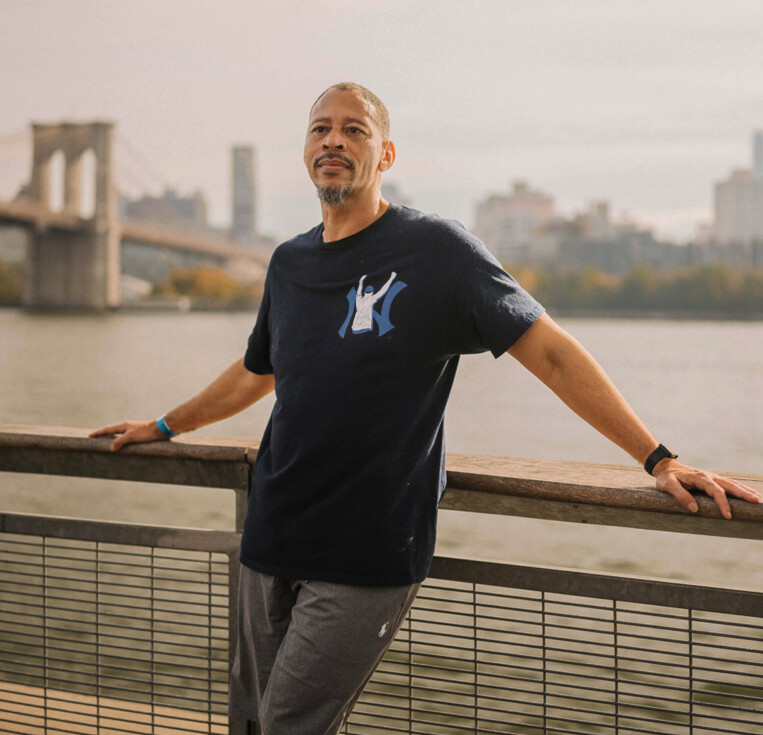
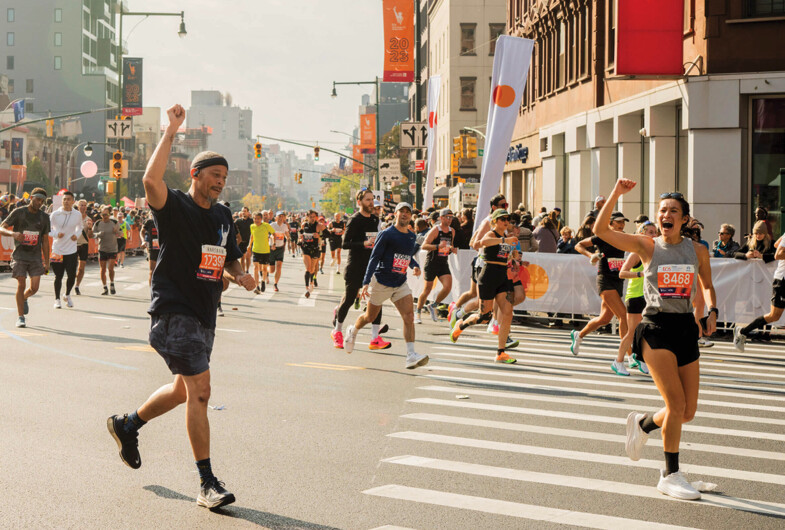
For Rahsaan and the other San Quentin runners, Mount Tam, as it’s known, had become a beacon of hope. It’s the site of the legendary Dipsea, a 7.4-mile technical trail from Mill Valley to Stinson Beach. After the 1,000 Mile Club was founded in 2005, it became tradition for club members who got released to run that trail; their stories soon became lore among the runners still inside. “I’ve been hearing about the Dipsea for the longest,” Rahsaan says.
Given his sentence, he never expected to run it. Rahsaan was serving 55 years to life for second-degree murder. Life outside, let alone running over Mount Tam all the way to the Pacific, felt like a million miles away. But Rahsaan loved to run—it gave him a sense of freedom within the prison walls, and more than that, it connected him to the community of the 1,000 Mile Club. So if the volunteer coaches and other runners wanted to talk about the Dipsea, he was happy to listen.
We’ll get to the details of Rahsaan’s crime later, but it’s useful to lead with some enduring truths: People can grow in even the harshest environments, and running, whether around a lake or a prison yard, has the power to change lives. In fact, Rahsaan made a lot of changes after he went to prison: He became a mentor to at-risk youth, began facing the reality of his violence, and discovered the power of education and his own pen. Along the way, Rahsaan also prayed for clemency. The odds were never in his favor.
To be clear, this is not a story about a wrongful conviction. Rahsaan took the life of another human being, and he’s spent more than two decades reckoning with that fact. He doesn’t expect forgiveness. Rather, it’s a story about a man who you could argue was set up to fail, and for more than 30 years that’s exactly what he did. But it’s also a story of navigating the delta between memory and fact and finding peace in the idea that sometimes the most formative things in our lives may not be exactly as they seem. And mostly, it’s a story of transformation—of learning to do good in a world that too often encourages the opposite.
RAHSAAN “NEW YORK” THOMAS GREW UP IN BROWNSVILLE, A ONE-SQUARE-MILE SECTION OF EASTERN Brooklyn wedged between Crown Heights and East New York. As a kid he’d spend hours on his Commodore 64 computer trying to code his own games. He loved riding his skateboard down the slope of his building’s courtyard. On weekends, he and his friends liked to play roller hockey there, using tree branches for sticks and a crushed soda can for a puck.
Once a working-class Jewish enclave, Brownsville started to change in the 1960s, when many white families relocated to the suburbs, Black families moved in, and city agencies began denying residents basic services like trash pickup and streetlight repairs. John Lindsay, New York’s mayor at the time, once referred to the area as “Bombsville” on account of all the burned-out buildings and rubble-filled empty lots. By 1971, the year after Rahsaan was born, four out of five families in Brownsville were on government assistance. More than 50 years later, Brownsville still has a poverty rate close to 30 percent. The neighborhood’s credo, “Never ran, never will,” is typically interpreted as a vow of resilience in the face of adversity. For some, like Rahsaan, it has always meant something else: Don’t back down.
The first time Rahsaan didn’t run, he was 5 or 6 years old. He had just moved into Atlantic Towers, a pair of 24-story buildings beset with rotting walls and exposed sewer pipes that housed more than 700 families. Three older kids welcomed him with their fists. Even if Rahsaan had tried to run, he wouldn’t have gotten far. At that age, Rahsaan was skinny, slow, and uncoordinated. He got picked on a lot. Worse, he was light-skinned and frequently taunted as “white boy.” The insult didn’t even make sense to Rahsaan, whose mother is Black and whose father was Puerto Rican. “I feel Black,” he says. “I don’t feel [like] anything else. I feel like myself.”
Rahsaan hated being called white. It was the mid-1970s; Roots had just aired on ABC, and Rahsaan associated being white with putting people in chains. Five-Percent Nation, a Black nationalist movement founded in Harlem, had risen to prominence and ascribed godlike status to Black men. Plus, all the best athletes were Black: Muhammad Ali. Reggie Jackson. Kareem Abdul-Jabbar. In Rahsaan’s world, somebody white was considered physically inferior.
Raised by his mother, Jacqueline, Rahsaan never really knew his father, Carlos, who spent much of Rahsaan’s childhood in prison. In 1974, Jacqueline had another son, Aikeem, with a different man, and raised her two boys as a single mom. Carlos also had another son, Carl, whom Rahsaan met only once, when Carl was a baby. Still, Rahsaan believed “the myth,” as he puts it now, that one day Carlos would return and relieve him, his mom, and Aikeem of the life they were living. Jacqueline had a bachelor’s degree in sociology and worked three jobs to keep her sons clothed and fed. She nurtured Rahsaan’s interest in computers and sent him to a parochial school that had a gifted program. Rahsaan describes his family as “upper-class poor.” They had more than a lot of families, but never enough to get out of Brownsville, away from the drugs and the violence.
Some traumas are small but are compounded by frequency and volume; others are isolated occurrences but so significant that they define a person for a lifetime. Rahsaan remembers his grandmother telling him that his father had been found dead in an alley, throat slashed, wallet missing. Rahsaan was 12 at the time, and he understood it to mean his father had been murdered for whatever cash he had on him—maybe $200, not even. Now he would never come home.
Rahsaan felt like something he didn’t even have had been taken from him. “It just made me different, like, angry,” he says. By the time he got to high school, Rahsaan resolved to never let anyone take anything from him or his family again. “I started feeling like, next time somebody tryin’ to rob me, I’m gonna stab him,” he says. He started carrying a knife, a razor, rug cutters—“all kinds of sharp stuff.” Rahsaan never instigated a fight, but he refused to back down when threatened or attacked. It was a matter of survival.
The first time Rahsaan picked up a gun, it was to avenge his brother. Aikeem, who was 14 at the time, had been shot in the leg by a guy in the neighborhood who was trying to rob him and Rahsaan. A few months later, Rahsaan saw the shooter on the street, ran to the apartment of a drug dealer he knew, and demanded a gun. Rahsaan, then 18, went back outside and fired three shots at the guy. Rahsaan was arrested and sent to Rikers Island, then released after three days: The guy he’d shot was wanted for several crimes and refused to testify against Rahsaan.
By day, Rahsaan tried to lead a straight life. He graduated from high school in 1988 and got a job taking reservations for Pan Am Airways. He lost the job after Flight 103 exploded in a terrorist bombing over Scotland that December, and the company downsized. Rahsaan got a new job in the mailroom at Debevoise & Plimpton, a white-shoe law firm in midtown Manhattan. He could type 70 words a minute and hoped to become a paralegal one day.
Rahsaan carried a gun to work because he’d been conditioned to expect the worst when he returned to Brownsville at night. “If you constantly being traumatized, you constantly feeling unsafe, it’s really hard to be in a good mind space and be a good person,” he says. “I mean, you have to be extraordinary.”
After high school, some of Rahsaan’s friends went to Old Westbury, a state university on Long Island with a rolling green campus. He would sometimes visit them, and at a Halloween party one night, he got into a scrape with some other guys and fired his gun. Rahsaan spent the next year awaiting trial in county jail, the following year at Cayuga State Prison in upstate New York, and another 22 months after that on work release, living in a halfway house in Queens. He got a job working the merch table for the Blue Man Group at Astor Place Theater, but the pay wasn’t enough to support the two kids he’d had not long after getting out of Cayuga.
He started selling a little crack around 1994, when he was 24. By 27 he was dealing full-time. He didn’t want to be a drug dealer, though. “I just felt desperate,” he says. Rahsaan had learned to cut hair in Cayuga, and he hoped to save enough money to open a barbershop.
He never got that opportunity. By the summer of 1999, things in New York had gotten too hot for Rahsaan and he fled to California. For the first time in his 28 years, Rahsaan Thomas was on the run.
EVERY RUNNER HAS AN ORIGIN STORY. SOME START IN SCHOOL, OTHERS TAKE UP RUNNING TO IMPROVE their health or beat addiction. Many stories share common themes, if not exact details. And some, like Rahsaan’s, are absolutely singular.
Rahsaan drove west with ambitions to break into the music business. He wanted to be a manager, maybe start his own label. His new girlfriend would join him a week later in La Jolla, where they’d found an apartment, so Rahsaan went first to Big Bear, a small town deep in the San Bernardino Mountains 100 miles east of Los Angeles. It’s where Ryan Hall grew up, and where he discovered running at age 13 by circling Big Bear Lake—15 miles—one afternoon on a whim. Hall has recounted that story so many times that it’s likely even better known than the American records he would go on to set in the half and full marathons.
Rahsaan didn’t know anything about Ryan Hall, who at the time was just about to start his junior year at Big Bear High School and begin a two-year reign as the California state cross-country champion. He didn’t even know there was a lake in Big Bear. Rahsaan went to Big Bear to box with a friend, Shannon Briggs, a two-time World Boxing Organization heavyweight champion.
Briggs and Rahsaan had grown up together in Atlantic Towers. As kids they liked to ride bikes in the courtyard, and later they went to the same high school in Fort Greene. But Briggs’s mom had become addicted to drugs by his sophomore year, and they were evicted from the Towers. Briggs and Rahsaan lost touch. Briggs began spending time at a boxing gym in East New York; often he’d sleep there. He had talent in the ring. People thought he might even be the next Mike Tyson, another native of Brownsville who was himself a world heavyweight champ from 1986 to 1989.
Briggs went pro in 1991, and by the end of that decade he was earning seven figures fighting guys like George Foreman and Lennox Lewis. Rahsaan was at those fights. The two had reconnected in 1996, when Rahsaan was trying to rebuild his life after prison and Briggs’s boxing career was on the rise. In August 1999, Briggs was gearing up to fight Francois Botha, a South African known as the White Buffalo, and had decamped to Big Bear to train. “He was like, ‘Yo, come live with me, bro,’” Rahsaan recalls.
Briggs was running three miles a day to increase his stamina. His route was a simple out-and-back on a wooded trail, and on one of Rahsaan’s first days there, he decided to join him. Rahsaan hadn’t done so much as a push-up since getting out of prison, but he wanted to hang with his friend. Briggs and his training partners set off at their usual clip; within a few minutes they’d disappeared from Rahsaan’s view. By the time they were doubling back, he’d barely made it a half mile.
Rahsaan never liked feeling physically inferior. So back in La Jolla, he started running a few times a week, going to the gym, whatever it took. Before long he was up to five miles. And the next time he ran with Briggs, he could keep up. After that, he says, “Running just became my thing.”
FOR YEARS, RAHSAAN HAD BUCKED AT TAKING RESPONSIBILITY for the murder that sent him to prison. The other guys had guns, too, he insisted. If he hadn’t shot them, they’d have shot him. It was self-defense.
In the moment, he had no reason to think otherwise. It was April 2000. A friend had arranged to sell $50,000 worth of weed, and Rahsaan went along to help. They met in the parking lot of a strip mall in L.A., broad daylight. The buyers brought guns instead of cash, things went sideways, and, in a flash of adrenaline, Rahsaan used the 9mm he’d packed for protection, killing one man and putting the other in critical condition. He was 29 and had been in California eight months.
After awaiting trial for three years in the L.A. County jails, Rahsaan was sentenced to 55 years to life. But for the crushing finality of it, the grim interminability, the prospect of never seeing the outside world again, he was on familiar ground. Even Brownsville had been a kind of prison—one defined, as Rahsaan puts it now, by division and neglect, a world unto itself that societal forces made nearly impossible to escape. He was used to life inside.
Rahsaan spent the next 10 years shuttling between maximum security facilities, the bulk of those years at Calipatria State Prison, 30 miles from the Mexican border. By the time he got to San Quentin, he was 42.
As part of the prison’s restorative justice program, Rahsaan met a mother of two young men who’d been shot, one killed and the other critically injured. Her pain, her dignity, her ability to forgive her sons’ shooters prompted Rahsann to reflect on his own crime. “It made me feel like, damn, I did this to his mother,” he says. “I did this to my mother. You don’t do that to Black mothers. They go through so much.”
ABOUT 2 MILLION PEOPLE ARE INCARCERATED IN THE UNITED States today, roughly eight times as many as in the early 1970s. Nearly half of them are Black, despite Black Americans representing only 13 percent of the U.S. population.
This disparity reflects what the legal scholar and author Michelle Alexander calls “the new Jim Crow,” an invisible system of oppression that has impeded Black men in particular since the days of slavery. In her book of the same title, Alexander unpacks 400 years of policies and social attitudes that have created a society in which one in three Black males will be incarcerated at some point in their lives, and where even those who have been paroled often face a lifetime of discrimination and disenfranchisement, like losing the right to vote. If you hit a wall every time you try to do something, are you really free? More than half of the people released from U.S. jails and prisons return within three years.
After Rahsaan got out of Cayuga back in 1992, with a felony on his permanent record, he’d had trouble doing just about anything legit: renting an apartment, finding a decent job, securing a loan. Though he’d paid for the Mercedes SUV he drove to California, the lease was in his girlfriend’s name. Selling crack had provided financial solvency, and his success in New York made him feel invincible. One weed deal in California seemed easy enough. But he wasn’t naive. Rahsaan packed a gun, and if he felt he had to use it, he would.
Today Rahsaan feels deep remorse for what transpired from there. But back then he saw no other way. “When we have a grievance, we hold court in the street,” he says of growing up in the Brownsville projects. “There’s no court of law, there’s no lawsuits.” Even while incarcerated, Rahsaan continued to meet threats with violence. But he also found that in prison, as in Brownsville, respect was temporary. “If you stab somebody, people leave you alone,” he says. “But you gotta keep doing it.”
Not long after Rahsaan got to Calipatria, around 2003 or 2004, an older man named Samir pulled him aside. “Youngster, there’s nobody that you can beat up that’s gonna get you out of prison,” Rahsaan remembers Samir saying. “In fact, that’s gonna make it worse.” Rahsaan thought about Muhammad Ali, how he would get his opponents angry on purpose so they’d swing until they wore themselves out. He realized that when you’re angry, you’re not thinking clearly or moving effectively. You’re not responding; you’re reacting.
The next time Rahsaan saw Samir was in the yard at Calipatria. They were both doing laps, and the two men started to run together. Rahsaan told Samir about the impact his words had on him, how they helped him see he’d always let “somebody else’s hangup become my hangup, somebody else’s trauma become my trauma.” Each time that happened, he realized, he slid backward.
Rahsaan began exploring various religions. He liked how the men in the Muslim prayer group at Calipatria encouraged him to think about his past, and the way they talked about God’s plan. He thought back to that day in April 2000 and came to believe that God would have gotten him out of that situation without a gun. “If I was meant to die, I was meant to die,” he says. “If I’m not, I’m not.” He started to see confrontations as tests. “I stopped feeding into the negativity and started passing the test, and I’ve been passing it consistently since,” he says.
CLAIRE GELBART PLACED HER BELONGINGS IN A PLASTIC TRAY AND WALKED THROUGH THE METAL detectors at the visitors’ entrance at San Quentin. She crossed the Yard to the prison’s newsroom. It was late fall of 2017, and Gelbart had started volunteering with the San Quentin Journalism Guild, an initiative to teach incarcerated people the fundamentals of newswriting and interviewing techniques.
Historically infamous for housing people like Charles Manson and Sirhan Sirhan, the man convicted of killing Robert Kennedy, and for having the only death row for men in California, San Quentin has in recent years instituted reforms. By the time Rahsaan arrived, the facility was offering dozens of programs, had an onsite college, and granted some of the individuals housed there considerable freedom of movement. Hundreds of volunteers pass through its gates every year.
Rahsaan was in the newsroom working on a story for the San Quentin News, where he was a staff writer. Gelbart and Rahsaan started to chat, and within minutes they were bonding over running. They talked about the San Quentin Marathon—in which Rahsaan was proud to have placed 13th out of 13 finishers in 6 hours, 12 minutes, and 23 seconds—and Gelbart’s plans to run her first half marathon that spring. “It was like I lost all sense of place and time,” Gelbart says, “like I could have been in a coffee shop in San Francisco talking to someone.”
In weekly visits over the next year, Gelbart and Rahsaan talked about their families, their hopes for the future. Gelbart had just graduated from Tufts University with dreams of being a writer. Rahsaan was working toward a college degree, writing for numerous outlets like the Marshall Project and Vice, and learning about podcasting and documentary filmmaking. In 2019, when Gelbart was offered a job in New York, she told Rahsaan she felt torn about leaving—they’d become close friends. They made a pact that if Rahsaan ever got out of prison, they would run the New York City Marathon together. “We couldn’t think of a better thing to celebrate him coming home,” Gelbart says.
When Rahsaan was sentenced, he still had hope for a successful appeal. But when his appeal was denied in 2011, he realized he was never going home. His parole date was set for 2085.
At the time, though, the political appetite for mass incarceration was starting to shift. Gray Davis, who was governor of California from 1999 to 2003, had never granted a single pardon; and his successor, Arnold Schwarzenegger, granted only 15. Then, between 2011 and 2019, Governor Jerry Brown pardoned or commuted the sentences of more than 1,300 people. Studies show that the recidivism rate among those who had been serving life sentences is less than 5 percent in a number of states, including California. And according to the U.S. Bureau of Justice, 98 percent of people convicted of homicide who are released from prison do not commit another murder.
In the fall of 2018, Governor Brown approved Rahsaan for commutation, but it was now up to his successor, Gavin Newsom, to follow through. And until a release date was set, there were no guarantees.
Back at San Quentin, Rahsaan was busier than ever. He was working on his fourth film, Friendly Signs, a documentary funded by the Marshall Project and the Sundance Institute; it was about fellow 1,000 Mile Club member Tommy Lee Wickerd’s efforts to start an ASL program to aid a group of deaf and hard-of-hearing newcomers to the prison. He had recently been named chair of the San Quentin satellite chapter of the Society of Professional Journalists and became a cohost and coproducer of Ear Hustle, a popular podcast about life in San Quentin that in 2020 was a finalist for a Pulitzer Prize. He was also sketching out plans for a nonprofit, Empowerment Ave, to build connections to the outside world for other incarcerated writers and artists and to advocate for fair compensation. And after five years, he was just one history class away from getting his associate’s degree from Mount Tamalpais College.
In January 2020, Rahsaan began his final semester, eager to don his cap and gown that June. MTC always organized a festive graduation ceremony in the prison’s visiting room, inviting families, friends, students, and staff. Then COVID-19 hit. Lockdown. All classes canceled until further notice. The 1,000 Mile Club suspended workouts and races as well, its 70-plus members scattering throughout the prison, not sure when or if they’d ever get together again. Covid would officially kill 28 people at San Quentin and make many more very ill. College graduation, let alone races in the Yard and parole hearings, would have to wait.
For the first time since arriving at San Quentin, Rahsaan felt claustrophobic in his 4-by-10-foot cell. He couldn’t work on his films or go to the newsroom. All he could do was read and write, alone. After George Floyd was murdered that May, Rahsaan fell into a depression. He remembered something Chadwick Boseman had said in a 2018 commencement speech at Howard University: “Remember, the struggles along the way shape you for your purpose.”
Rahsaan decided his purpose was to write. Outside journalists couldn’t enter the prison during the pandemic, but their publications were thirsty for prison Covid stories. Rahsaan saw an opportunity. Between June 2020 and February 2023, he published 42 articles, and thanks to Empowerment Ave, he knew what those articles were worth. As a writer for the San Quentin News, Rahsaan earned $36 a month; those 42 articles for external publications netted him $30,000.
DOZENS OF PEOPLE GATHERED OUTSIDE SAN QUENTIN’S GATES. IT WAS A FRIGID MORNING IN EARLY February 2023; the sun hadn’t yet risen. Among those assembled were two cofounders of Ear Hustle, Earlonne Woods and Nigel Poor, along with executive producer Bruce Wallace, recording equipment in hand. A procession of white vans, each carrying one or two men, arrived one by one. After three or four hours, the air had warmed to a balmy 60 degrees. Another van pulled up, Rahsaan got out, and the crowd erupted. Nearly 23 years after he’d been sentenced to 55 years to life, Rahsaan Thomas had been released.
Rahsaan got into a Hyundai sedan and was soon headed away from San Quentin. Wallace sat in the back, recording Rahsaan seeing water, mountains, and a highway from the front seat of a car for the first time in decades. “I feel like I’m escaping,” he joked. “Is anybody chasing us? This is amazing. This is crazy.”
Rahsaan called his mom, who wasn’t able to make it to California for his release.
“Hey, Ma, it’s really real,” he said, breathless with joy. “I’m free. No more handcuffs.”
Jacqueline’s exuberance can be heard in her laughter, her curiosity about what his first meal would be (steak and French toast), and her motherly rebuke of his plan to buy a Tesla.
“You ain’t been drivin’ in a while and I know you ain’t the best driver in the world,” she teased.
Rahsaan moved into a transitional house in Oakland and wasted no time adjusting to life in the 21st century. He got an iPhone, and a friend gave him a crash course in protecting himself from cyberattacks. He’s almost fallen for a few. “There’s some rough hoods on the internet,” he jokes. Earlonne Woods, who was paroled in 2018, and others taught Rahsaan how to use social media. He opened Instagram and Facebook accounts and worked on his own website, rahsaannewyorkthomas.com, which a friend had built for him while he was in San Quentin to promote his creative projects, Empowerment Ave, and even a line of merch.
Despite all the excitement and chaos, Rahsaan never forgot about the pact he’d made with Claire Gelbart. He found her on Facebook and sent a simple, two-line message: “Start training. We have a marathon to run.”
IN LATE MARCH, SIX WEEKS AFTER HIS RELEASE, RAHSAAN FLEW TO NEW YORK CITY. IT WAS THE FIRST time he’d been home in nearly a quarter century, and he hadn’t flown since before 9/11. The security protocols at SFO reminded him more of prison than of the last time he’d been in an airport. Actually, “it was worse than prison,” he jokes. They confiscated his jar of honey.
The changes to his home borough were no less surprising. He’d come to New York to take work meetings, see family, and catch a Nets game at Barclays Center in downtown Brooklyn. Rahsaan barely recognized Barclays; it had been a U-Haul lot the last time he was there, and skyscrapers now towered over Fulton Mall, where he used to buy Starter jackets at Dr. Jay’s and Big Daddy Kane tapes at the Wiz.
He met up with Gelbart on Flatbush Avenue, where come November they’d be just hitting mile 8 of the New York City Marathon. They hadn’t been allowed to touch at San Quentin and weren’t sure how to greet each other on the outside. “It was weird at first, because I was like, do we hug?” Gelbart recalls. But the awkwardness faded fast, and as they walked, Gelbart saw a different side of Rahsaan. “He seemed so much more relaxed,” she says. “Much happier, much lighter.”
Back in 1985, just a few blocks from where Rahsaan and Gelbart walked now, Rahsaan, his brother Aikeem, and his friend Troy had been on their way home from the Fulton Mall when out of nowhere, about a dozen guys rolled up on them. They started beating on Troy and, for a minute, left Rahsaan and Aikeem alone. Images of his father, throat slashed, flashed through Rahsaan’s mind. He pulled a rug cutter out of his pocket, ran to the smallest guy in the group, and jabbed it into the back of his head. “They looked at me like they were gonna kill me,” Rahsaan says. He threw the blade to the ground, slid his hand inside his coat, and held it there. “Y’all wanna play? We gonna play,” he said. The bluff worked; the guys ran. It was the first time Rahsaan had ever stabbed someone.
Change sometimes occurs gradually, and then all at once. That was a different Brooklyn, a different Rahsaan. He began to confront his own violence when he had met Samir some 20 years before, and continued to do so through his studies, his faith, his work in restorative justice, and his own writing. But the origin of his tendency toward violence, the death of his father, remained firmly rooted in his psyche. Then, in 2017, Rahsaan spoke for the first time with his estranged half-brother, Carl.
Carl had read Rahsaan’s work, and asked why he always said their father had been murdered.
“That’s what grandma told me,” Rahsaan said.
“But he wasn’t murdered,” Carl told him. “He killed himself.”
And it wasn’t in 1982, as Rahsaan remembered, but in 1985—the same year Rahsaan started carrying blades.
Rahsaan didn’t believe it until Carl sent him a copy of the suicide note. Even then he remained in shock. “To think I justified violence, treating robbery like a life-or-death situation, over a lie,” he says. Jacqueline was as surprised as Rahsaan to learn the truth of Carlos’s death. He never seemed troubled or depressed to her when they were together, but, “You can’t really read people,” she says. “You don’t know.”
Rahsaan still can’t account for why his grandmother told him what she did, nor for the discrepancy between his memory and the facts. Regardless, after more than 30 years, Rahsaan was finally able to let go of the one trauma that had calcified into an instinct to kill or be killed. And he has no intention of dredging it back up.
THE FASTEST RUNNER IN THE 1,000 MILE CLUB’S HISTORY IS MARKELLE “THE GAZELLE” TAYLOR, WHO was paroled in 2019 and went on to run 2:52 in the 2022 Boston Marathon. Rahsaan is the slowest. At San Quentin, he was often the last one to finish a race, but that wasn’t the point—he liked being out in the Yard with the guys. It gave him a sense of belonging, and not just to the 1,000 Mile Club, but to the running community beyond.
Like every other 1,000 Miler who gets released from San Quentin, Rahsaan had a rite of passage to conquer. On Sunday morning, May 7, 2023, he met a handful of other runners from the club and a few volunteer coaches in Mill Valley. After a decade of gazing up at Mount Tam from the Yard as he completed one 400-meter loop after another, Rahsaan was finally about to run over the mountain all the way to the Pacific.
The runners did a few final stretches, wished one another luck, and started to run. Almost immediately they had to climb some 700 stairs, many made of stone, and the course only got more treacherous from there. Uneven footing, singletrack paths, and 2,000-plus feet of elevation all conspire to make the Dipsea notoriously difficult. The giant redwoods and Douglas firs along the course were lost on Rahsaan; he never took his eyes off the ground.
One of the coaches, Jim Maloney, stayed with Rahsaan as his guide, and to help him if he slipped or fell. Markelle Taylor came too, but said he’d meet them in Stinson Beach. He knew how dangerous the trail was, Rahsaan says, and had vowed to never run it again. After his own initiation, Rahsaan decided that he, too, would never do it again. “I’ve been shot at,” he says. “I’ve been in physical danger. I don’t want to revisit danger.”
Rahsaan now logs most of his miles on a treadmill because of knee issues, but on occasion he ventures out to do the 3.4-mile loop around Lake Merritt, a lagoon in the heart of Oakland. He decided to use the New York City Marathon to raise money for Empowerment Ave, and to accept donations until he crossed the finish line in Central Park. Gelbart wrote a training plan for him and got him a new pair of shoes. In prison, Rahsaan had run in the same pair of Adidas for three years, and he was excited to learn about the maximalist shoe movement. Gelbart tried to interest him in Hokas, but Rahsaan thought they were ugly. He wanted Nikes.
In June, Gelbart went to the Bay Area to visit family and met Rahsaan for a six-mile run around Lake Merritt. As they looped the lake at a conversational 11:30 pace, they talked about work, relationships, and, of course, the New York City Marathon. Rahsaan was disappointed to learn that he would probably not be the last person to finish. (He still holds the record for the slowest San Quentin Marathon in its 15-year history, and he hopes no one ever beats it.) Besides, the more time he spent on the course in New York, he figured, the longer people would have to donate to Empowerment Ave.
On Sunday, November 5, Gelbart and Rahsaan made their way to Staten Island. Waiting at the base of the Verrazzano Bridge, Gelbart recorded Rahsaan singing along to Frank Sinatra’s “New York, New York” for Instagram, and captioned the video “back where he belongs.” They documented much of their race as they floated through Brooklyn, Queens, Manhattan, and the Bronx: greeting friends along the course, enjoying a lollipop on the Queensboro Bridge, beaming even as their pace slowed from 11:45 per mile for the first 5K to 16:30 for the last. Rahsaan finished in six hours, 26 minutes, and 21 seconds, placing 48,221 out of 51,290 runners. The next day, he sent me a text: “The marathon was pure love.” What’s more, he received more than $15,000 in donations for Empowerment Ave, enough to start a writing program at a women’s prison in Texas.
Every runner has an origin story. Every runner finds a reason to keep going. At Calipatria, Rahsaan liked to joke that he ran because if an earthquake ever came along and brought down the prison’s walls, he needed to be in shape so he could escape and run to Mexico. In San Quentin, he ran for the community. Today he has a new reason. “I heard that running extends your life by 10 years,” he says, “and I gave away 22.” Now that he’s out, his motivation has never been higher. He has so much to do.
Login to leave a comment
The Keys to Courtney Dauwalter’s Continued Dominance
During a recent press conference, Dauwalter dished oUltrarunner extraordinaire Courtney Dauwalter has picked up in 2024 right where she left off last year. After famously winning three of ultrarunning’s most epic races during the span of about nine weeks last summer—Western States 100, Hardrock 100, and Ultra-Trail du Mont-Blanc—the 39-year-old athlete from Leadville, Colorado, defended her Transgrancanaria 126K title in a decisive wire-to-wire win in late February and won the Mount Fuji 100-miler for the second time on April 27, placing third overall.
She’s now gearing up to go for a third straight win at the Hardrock 100 on July 12-13 in Silverton, Colorado. After Hardrock, she’ll be crewing and pacing her husband, Kevin Schmidt, at the Leadville 100 on August 17-18, and then tackling a yet-unannounced trail running project in September.We caught up with Dauwalter to talk about her fueling and training in a virtual press conference, where she announced the May 20 release of her signature flavor of Tailwind Nutrition Endurance Fuel—Dauwaltermelon with Lime—as a permanent part of the brand’s lineup. Since she’s emerged as one of the world’s top trail ultrarunners, she’s been known for having a sound approach to nutrition and fueling, never shying away from eating whatever she wants, admitting her soft spot for candy and pastries, or having a beer every now and then if she feels like it.


COURTNEY DAUWALTER: I am still eating all of my favorite things whenever they sound good in quantities that sound good, and I am not intending to change that part of my life, because it just gives me a lot of joy to live that way. I guess it’s got to be partly my upbringing, and also with Kevin and I, our idea of how we want to live our lives is to enjoy it to its fullest while it’s here. We just want to enjoy food, enjoy meals out, enjoy the cravings that we have, and not worry about it. But I would say in the past couple of years I do more consistently do a recovery drink after a long run or after putting in big efforts, and that’s something that I was a little more lax with originally, so I feel like that’s a step in the right direction.
When I first got into ultrarunning, I had no nutrition plan. I didn’t know what I was doing. My first race was a 50K, and I remember not knowing that these aid stations would be buffets. My mind was blown when I got to them—all the options were overwhelming. I just started filling my pockets with jelly beans. In those first years, I did a lot of mimicking of what the people around me were doing. So if I came to an aid station and someone was grabbing pickles and drinking Mountain Dew, then that’s what I would do. If they were grabbing pretzels and cheese cubes, that’s what I would go for. It was just kind of roulette for me on what I would end up eating—if it would work, or if it wouldn’t work.
Initially, I never had a fueling plan at all. But then in 2017, I went to the Run Rabbit Run 100 in Steamboat Springs, Colorado, and Tailwind was available on course at all of the aid stations. I had a buddy who had started using it that year, and I remember just loving it and suddenly not having all the stomach issues and energy dips that I often had. I was like, ‘Oh, maybe this is what it’s like to have something reliable.
'At this point we’ve gotten pretty dialed on the race nutrition plan for those 10-to 24-hour efforts or the events of 100 miles or below. I’m not a person who has my watch beeping at me ever to remind me to eat. I don’t get those kinds of reminders, and I don’t want to eat every 15 minutes or 30 minutes during a race. I’m going to just slow drip the calories I have as often as possible—basically it’s an eating contest on the move. Now I know my body functions pretty well with about 200 calories per hour during those efforts. So, depending on the distance between aid stations, I can rely solely on a bottle of Tailwind and then supplement with some chews or waffles or gels, because usually I get actually hungry feeling and having something solid helps with that. But mostly, I’m relying on Tailwind as my backbone to the whole plan and generally aiming for that 200-calorie-per-hour benchmark.The past couple years (working with a nutritionist friend), we’ve been better at creating A, B, C and D plans—because sometimes the perfect nutrition plan that you have relied on isn’t going to work. Our approach is that’s fine, and here are some things you can start subbing in during a race that can cover your needs. I view race nutrition like a puzzle piece, and sometimes it fits into the puzzle right where we want it to, and sometimes we have to kind shift things around a little bit. I think one of the reasons a lot of us love ultrarunning is because, when things just aren’t going to plan, we have to problem-solve it.
That’s one thing I’m hoping to focus on a little bit more on in this buildup and this prep for Hardrock, because in the past couple times I’ve run it, I’ve struggled a little bit with taking stuff in. I would love to just try to intentionally train my stomach to be better at taking in those calories while pushing hard at 12,500 feet or 13,000 feet just to see if we can make some strides forward. So stay tuned on if that works or not.
Not specific things. I think I want to just keep finding the challenges that intrigue me and fire me up to keep putting in the work, the training, the time, the effort to go after them. And so whatever that is, there’s not a list of things I want to check off necessarily, but, I’m continuing to pour myself into this sport and see what’s possible while every one of my systems [muscular, digestive, endocrine, cognitive, emotional, etc.] is allowing that to happen. The Leadville 100 is on my short list of races I would love to do as soon as I can, but as far as a bucket list in general or what intrigues me, I’m still very interested in exploring the longer stuff and how our brains and our bodies can work together to take us over 100 miles. What does that look like to move efficiently for 200 miles or 500 miles? So that’s where I am putting a lot of my attention into—just finding ways to test myself on stuff that’s really long.I am interested in trying a road marathon again at some point because that was what led me to ultrarunning.. I didn’t think I could make that distance, but I finished without dying and then wondered, ‘What else is out there that sounds too hard that I could try?’ And then I stumbled into the ultrarunning world. In those first marathons, I was a casual runner.
I ran every day before work because it made me feel better to start the day, but I wasn’t doing huge miles or running quickly. So circling back to run a road marathon would be kind of fun.I definitely didn’t invent it, and I don’t know who did originally, but I know that for me that phrase just became this imagery that I really grabbed onto—as opposed to the struggle bus or the hurt locker or the many other terms. That one for me was visually something I could see, and it was something that I could work with to be productive. Back in high school, I had a cross country skiing coach who was big on the mental side of the sport and would always remind us and believe in our capacity to push past that moment when it feels like you have nothing left. He was huge on just the idea that there’s always one more gear. So I just crank the knob and believe that it can be cranked a little bit more. Having someone who believed in me so wholeheartedly that I could trust to keep pushing was important because it’s hard to do that when you’re any age, but for sure it’s hard to do when you’re a teenager.
The idea that you feel like you’re about to die and yet you’re telling me there’s more to push past that? That’s hard to learn. So I feel really lucky that I had that coach and to learn about that mental side of sports and digging deeper than you think.
That was so special, a highlight of my life for sure. We ran together through the desert in Arizona, side by side the whole time through all the highs and lows, and made it to that finish line. I’ll remember that forever, and that gift that she gave me of doing this thing with me and the sport I love and spending so much time preparing for it. She was training hard back home in Minnesota, trying to learn how to run trails, trying to power hike hills, and learning how to use all of the gear because she had never really run trails before. I think the domino effect is that you can start anything at any age. She was 66 when we ran this race together and 64 when she started this journey into trail running. I had told her my dream was to run an ultra with my mom, and now that she has completed a 100K, she has found a lot of joy in the trails. Even though we don’t have a race on the calendar together yet, she is still just finding that peace that the trails bring her, and it’s something she incorporates into her weekly life. I think that’s really cool, and it’s why I hope more people can find out about trail running—not necessarily even ultrarunning—but just getting out on the trails and exploring a little bit because that feeling of moving with your feet surrounded by nature and feeling so small in a big landscape is really, really cool.
My hope is that people hearing about the stuff that I’m doing or that the ultrarunning community is doing helps them believe they could go after something that sounds too hard or something that sounds crazy. Whether that’s running 100 miles or 200 miles or not. We can all find that thing in our lives that we can go after with a little more gusto and raise the bar for ourselves on what we’re actually aiming for. I also hope I can be a small example that you can work really, really, really hard at something and have a lot of fun doing it. Those things can happen at the same time and there’s no reason to separate them. I never predicted this chapter in my life, but I feel grateful every day for it. I’m just trying to squeeze as much living out of this period of life as I can.
n her approach to nutrition and fueling, early-career bonks, and more.
by Outside Online
Login to leave a comment
The Keys to Courtney Dauwalter’s Continued Dominance
Ultrarunner extraordinaire Courtney Dauwalter has picked up in 2024 right where she left off last year. After famously winning three of ultrarunning’s most epic races during the span of about nine weeks last summer—Western States 100, Hardrock 100, and Ultra-Trail du Mont-Blanc—the 39-year-old athlete from Leadville, Colorado, defended her Transgrancanaria 126K title in a decisive wire-to-wire win in late February and won the Mount Fuji 100-miler for the second time on April 27, placing third overall. She’s now gearing up to go for a third straight win at the Hardrock 100 on July 12-13 in Silverton, Colorado. After Hardrock, she’ll be crewing and pacing her husband, Kevin Schmidt, at the Leadville 100 on August 17-18, and then tackling a yet-unannounced trail running project in September.
We caught up with Dauwalter to talk about her fueling and training in a virtual press conference, where she announced the May 20 release of her signature flavor of Tailwind Nutrition Endurance Fuel—Dauwaltermelon with Lime—as a permanent part of the brand’s lineup. Since she’s emerged as one of the world’s top trail ultrarunners, she’s been known for having a sound approach to nutrition and fueling, never shying away from eating whatever she wants, admitting her soft spot for candy and pastries, or having a beer every now and then if she feels like it.
RUN: How did you develop such a sensible approach to nutrition and fueling, and what, if anything, have you changed?
Courtney Dauwalter: “I am still eating all of my favorite things whenever they sound good in quantities that sound good, and I am not intending to change that part of my life, because it just gives me a lot of joy to live that way. I guess it’s got to be partly my upbringing, and also with Kevin and I, our idea of how we want to live our lives is to enjoy it to its fullest while it’s here. We just want to enjoy food, enjoy meals out, enjoy the cravings that we have, and not worry about it. But I would say in the past couple of years I do more consistently do a recovery drink after a long run or after putting in big efforts, and that’s something that I was a little more lax with originally, so I feel like that’s a step in the right direction.”
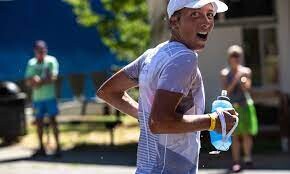
RUN: What was your fueling strategy when you first got into ultrarunning in 2011?
CD: “When I first got into ultrarunning, I had no nutrition plan. I didn’t know what I was doing. My first race was a 50K, and I remember not knowing that these aid stations would be buffets. My mind was blown when I got to them—all the options were overwhelming. I just started filling my pockets with jelly beans. In those first years, I did a lot of mimicking of what the people around me were doing. So if I came to an aid station and someone was grabbing pickles and drinking Mountain Dew, then that’s what I would do. If they were grabbing pretzels and cheese cubes, that’s what I would go for. It was just kind of roulette for me on what I would end up eating—if it would work, or if it wouldn’t work.”
RUN: You have told stories about a few famous bonks early in your career. When did you start to dial-in your fueling strategy?
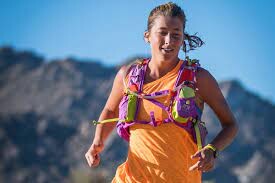
CD: “Initially, I never had a fueling plan at all. But then in 2017, I went to the Run Rabbit Run 100 in Steamboat Springs, Colorado, and Tailwind was available on course at all of the aid stations. I had a buddy who had started using it that year, and I remember just loving it and suddenly not having all the stomach issues and energy dips that I often had. I was like, ‘Oh, maybe this is what it’s like to have something reliable.'”
RUN: What is your current approach to race-day nutrition?
CD: “At this point we’ve gotten pretty dialed on the race nutrition plan for those 10-to 24-hour efforts or the events of 100 miles or below. I’m not a person who has my watch beeping at me ever to remind me to eat. I don’t get those kinds of reminders, and I don’t want to eat every 15 minutes or 30 minutes during a race. I’m going to just slow drip the calories I have as often as possible—basically it’s an eating contest on the move. Now I know my body functions pretty well with about 200 calories per hour during those efforts. So, depending on the distance between aid stations, I can rely solely on a bottle of Tailwind and then supplement with some chews or waffles or gels, because usually I get actually hungry feeling and having something solid helps with that. But mostly, I’m relying on Tailwind as my backbone to the whole plan and generally aiming for that 200-calorie-per-hour benchmark”
RUN: You had to overcome some stomach challenges in UTMB in 2022 and then at last year’s UTMB you seemed as physically challenged as you have ever been. How have you adjusted your fueling in those situations?
CD: “The past couple years (working with a nutritionist friend), we’ve been better at creating A, B, C and D plans—because sometimes the perfect nutrition plan that you have relied on isn’t going to work. Our approach is that’s fine, and here are some things you can start subbing in during a race that can cover your needs. I view race nutrition like a puzzle piece, and sometimes it fits into the puzzle right where we want it to, and sometimes we have to kind shift things around a little bit. I think one of the reasons a lot of us love ultrarunning is because, when things just aren’t going to plan, we have to problem-solve it.”
RUN: You’ll be doing a lot of your pre-Hardrock training in and around Leadville between 11,000 and 14,000 feet above sea level once the spring snow subsides. How are you able to fuel at such high altitudes?
CD: “That’s one thing I’m hoping to focus on a little bit more on in this buildup and this prep for Hardrock, because in the past couple times I’ve run it, I’ve struggled a little bit with taking stuff in. I would love to just try to intentionally train my stomach to be better at taking in those calories while pushing hard at 12,500 feet or 13,000 feet just to see if we can make some strides forward. So stay tuned on if that works or not.”
RUN: Do you have any bucket list events you want to tackle in the coming years?
CD: “Not specific things. I think I want to just keep finding the challenges that intrigue me and fire me up to keep putting in the work, the training, the time, the effort to go after them. And so whatever that is, there’s not a list of things I want to check off necessarily, but, I’m continuing to pour myself into this sport and see what’s possible while every one of my systems [muscular, digestive, endocrine, cognitive, emotional, etc.] is allowing that to happen. The Leadville 100 is on my short list of races I would love to do as soon as I can, but as far as a bucket list in general or what intrigues me, I’m still very interested in exploring the longer stuff and how our brains and our bodies can work together to take us over 100 miles. What does that look like to move efficiently for 200 miles or 500 miles? So that’s where I am putting a lot of my attention into—just finding ways to test myself on stuff that’s really long.”
by Brian Metzler
Login to leave a comment
Hardrock 100
100-mile run with 33,050 feet of climb and 33,050 feet of descent for a total elevation change of 66,100 feet with an average elevation of 11,186 feet - low point 7,680 feet (Ouray) and high point 14,048 feet (Handies Peak). The run starts and ends in Silverton, Colorado and travels through the towns of Telluride, Ouray, and the ghost town...
more...Why Jasmin Paris is about to become a household name
British ultrarunner Jasmin Paris made history on Thursday when she became the first woman runner to finish the Barkley Marathons, charging to the finish with only 99 seconds to spare before the 60-hour cutoff. But this is not the first time Paris, who runs free of sponsorships and is an environmental advocate, has achieved something remarkable in the trail running world. Here’s what we know about the 40-year-old ultra-trail champion.
Paris is a veterinarian and research scientist from Midlothian, Scotland. In 2019, she jumped to world attention on the ultra scene when she smashed the overall (men’s) course record–by 12 hours–at Britain’s 268-mile Montane Spine Race, finishing in 83 hours, 12 minutes, 23 seconds–while also pumping breastmilk for her infant daughter.
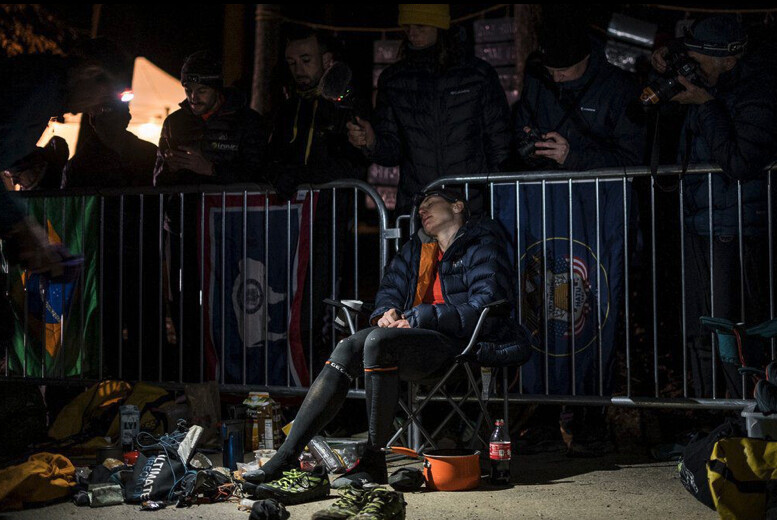
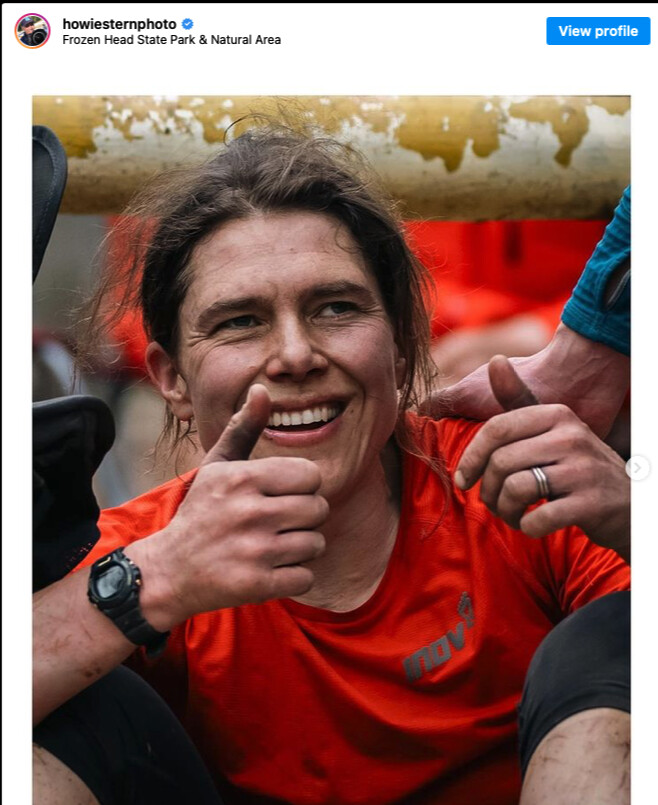
“When it was really difficult I made myself think about my daughter and imagined the different things she does—that kind of kept me distracted and entertained,” she told British Vogue after her Spine Race success.“Some of the time you don’t really think about anything. It’s mindful, you’re just putting one foot in front of the other.”
The Barkley Marathons is five loops of a 20+ mile course in Frozen Head State Park, near Wartburg, Tenn. (distances vary; the race is thought to be well over 100 miles) featuring thousands of metres of elevation gain, with a time limit of 60 hours. It was first run in 1986, and was inspired by the prison escape of James Earl Ray, who was serving time at Brushy Mountain penitentiary for the murder of Martin Luther King, Jr. (He was captured soon after.) Gary Cantrell (a.k.a. Lazarus Lake, or “Laz” to his friends) dreamed up a 100-miler in the vicinity of the prison, which is now abandoned and is a feature of the course. GPS watches are not allowed; each runner is issued a cheap watch set to “Barkley time,” i.e., the 60-hour limit. Runners must collect pages corresponding to their bib number from 13 books hidden on the course (they receive a new bib for each loop); missing pages mean disqualification. There is water available on the course, but no aid stations. Runners may only receive aid from their crew between loops, in camp, where they are on the clock.
Paris was always passionate about the outdoors, but only took up running in university. She began winning local and national fell-running and ultrarunning events, including the Scottish Hill Running Championships, British Fell Running Championships and then the 2016 Extreme Skyrunner World Series. Paris ran a hill race 10 days before giving birth to her daughter.
While Paris says it has been challenging to juggle training as a parent to a young child, she adds that it’s important to maintain a balanced life.”It doesn’t make you a worse parent if you have something else that is just yours; in fact I think that it’s probably inspirational to your child, she told British Vogue.”I hope my daughter will be inspired when she grows up to believe that she can do anything.”
Barkley creator Laz Lake asked Paris to run the race after her victory at the Spine Race—he thought Paris might be the only woman who could possibly finish. In 2o22, she completed three loops (which is dubbed a “fun run”); in 2023, she was eliminated after four loops, falling short of the 48-hour cutoff time to begin the fifth loop. Paris was only the second woman ever to attempt a fourth loop; the first was Sue Johnston of Vermont, in 2001.
Fellow British runner and two-time Barkley Marathons competitor, Damian Hall, made it to loop five for the second year in a row, but was unable to complete the race. He commented on Paris’s remarkable finish to his sponsor, Inov8: “It was still an amazing experience, and incredible to see Jasmin finish and make history. That wiped away most of my personal disappointment. It was the greatest sporting achievement I’ve seen in the flesh.”
“The final minutes were so intense, after all that effort it came down to a sprint uphill, with every fiber of my body screaming at me to stop,” Paris told The New York Times post-race.“I didn’t even know if I’d made it when I touched the gate. I just gave it everything to get there and then collapsed, gasping for air.”
Renowned photographer Howie Stern is a regular at the Barkley Marathons, and captured Jasmin throughout the race.”Thank you Jasmin for putting your heart and soul into the dark world that takes place in a little park in Tennessee, which has captivated and inspired women and men the world over,” he said on Instagram.
by Running Magazine
Login to leave a comment
This Teen Ultrarunner Wants to Take on the World's Most Prestigious Races
Last November, 17-year-old Sebastian Salsbury received an email reminder. He had 13 days to decide about entering the race lottery for the 2024 Western States 100 Mile Endurance Run, regarded as one of the most prestigious trail events in the world.
Rules stipulate that each lottery applicant must be at least 18 years old on race day. On January 20, Salsbury will finally meet the age requirement, five years after he technically ran a qualifying time to enter the lottery for the first time.
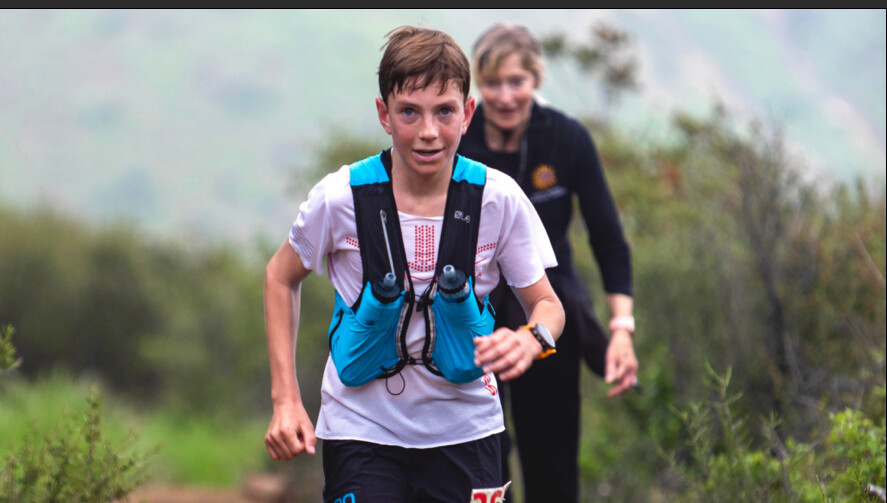
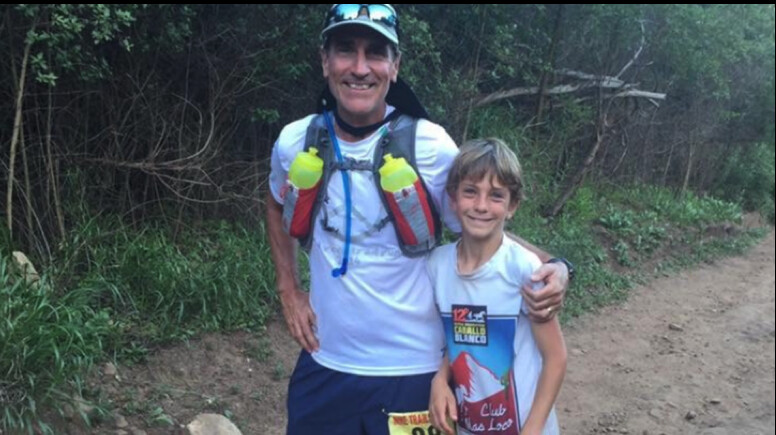
It's been a goal he's been progressing toward for years. In 2020, when Salsbury was 13, he completed the Black Canyon 100K in Arizona in 15 hours 49 minutes and 32 seconds, well within the 17-hour time limit necessary to qualify for the Western States lottery.
"It's hard to put that experience into words," Salsbury says. "It was one of the most beautiful courses I've ever been on. That race made me feel like I was doing the right thing in my life."
Starting Young
Salsbury, who grew up in Santa Barbara, California, was attracted to the trails at a young age. Throughout his childhood, his parents often brought him to nearby trails to hike. The hikes gradually transitioned into jogs, and Salsbury's relationship with the outdoors continued to grow. The mountains, he says, were a playground.
Though Salsbury played basketball, football, and soccer growing up, his love for running took over. He quit the other sports after junior high school to minimize risk for injury, he says, and to dedicate more time to running.
A few years after Salsbury's entry into racing-his first was a local 5K on the road when he was four-he ran the Santa Barbara Red Rock Trail Run. Despite being just nine, he kept up with his father for all 28 miles. The following year, for the Santa Barbara Nine Trails, Salsbury traversed 35 miles with nearly 12,000 feet of vertical gain from the Jesusita trailhead to Romero Canyon trailhead and back, again alongside his father, a road marathoner.
Next, Salsbury entered the Black Canyon 100K in Arizona. He recalled the point-to-point race as one of his most difficult running experiences to date.
"I was basically crying," Salsbury remembers, adding that his hydration vest kept digging into his ribs. "I loved the feeling of working hard and going through really low moments and overcoming them. I crave it."
Supported for the last 20 miles by his coach at the time, Tyler Hansen, Salsbury crossed the finish feeling both defeated and uplifted. The Black Canyon race gave him the confidence to continue challenging himself in ultrarunning.
"My best friends don't understand," Salsbury says about the pursuit of ultras, which he envisions including some of the most technically demanding and prestigious races in the world: the Western States 100 in California, Ultra-Trail du Mont-Blanc through the French Alps, as well as the Hardrock Hundred Mile Endurance Run in Colorado. Salsbury admits that running disrupts his social life, and also that he doesn't mind the solitude the sport necessitates. In fact, he welcomes it.
"I like the feeling of being alone in the mountains," Salsbury says. "It's a great way to free your mind."
Given that he is still a teen-the average age of trail runners is in the mid-30s-Salsbury has not been immune to negative comments over the years. "It's not cool at all to hate, but I can still see where someone would be coming from, seeing a kid doing all that stuff," Salsbury says. "There are going to be people that troll and hate for no reason. That's just life."
A Purposeful Progression
The training required to undertake ultras is out of this world for a typical high school runner. To ensure he's programming himself with sufficient miles without overloading his still-developing body, Salsbury sought the guidance of his longtime role model, pro trail runner Hayden Hawks. The two met when Salsbury was 14, and their camaraderie clicked naturally.
"I had lots of mentors help me at a young age in my running journey, and I felt the responsibility to do the same with Sebastian," says Hawks, 32. "We have taken a patient and gradual approach, developing strength, speed, and a foundation that will help him build into the longer distance races at an older age."
Hawks has coached Salsbury for the past two years, carefully mapping out a plan that tallies 50 miles weekly spread across six days. Salisbury complements the mileage with a combination of hiking, mountain biking, and intervals on an indoor bike as part of his cross training. Three days a week, he does strength exercises at Varient Training Lab in Santa Barbara. To fit it all in so he could have ample opportunity to train and compete, prior to the Covid-19 pandemic, Salsbury enrolled in West River Academy, an online private school program.
"I have zero regrets," Salsbury says. "The opportunity that it's given me to travel with my family and run and be able to guide my days how I want and learn at my own pace, I'm grateful for that."
The online program lasts up to three hours a day, which is "a lot less than standard high school," Salsbury chuckles. In 2022, he researched computer engineering and built a computer from scratch. This year, as part of the online curriculum, he's learning to speak German in addition to researching for a project about coffee and sustainability, which he is especially interested in as a part-time certified barista. Salisbury works at a local coffee shop twice a week.
So far, he's enjoying the unique balance of online learning and ultrarunning. "I like to keep myself busy," he says. "I've always had this next-level energy. Obviously it goes into running, but it's who I am as a person."
His days are hardly routine compared to the average high schooler. On a recent Thursday, Salsbury started the day with a three-minute cold plunge before he spent the remainder of the morning packing running shoes, thermal layers, his COROS watch, and a heart rate monitor ahead of a four-day trip to Boulder, Colorado, to train with a friend at altitude.
Living at sea level in Santa Barbara, Salsbury doesn't often have the opportunity to run at altitude beyond twice a year, mostly "just a vacation with my family where I get to do some running," he says.
As much as he has run over the years, Salsbury says he's been fortunate to never have had any serious injuries. This year, a growth spurt of eight inches led to severe shin splints, and Salsbury, who is now 6-foot-4 and 162 pounds, took four months off from running.
Now, life is back to business as usual. Salsbury is planning ahead. His next race is the La Cuesta Ranch 25K in San Luis Obispo, California, in late January. After he graduates from high school in June 2024, he wants to pursue a running career ideally full-time, though he hasn't stated when he aims to turn professional.
"I've always had the intention to be one of the greatest ultrarunners in the world one day. That will continue to be my goal," Salsbury says. "I want to leave a positive impact on the sport and be an inspiration to other athletes of any age, but obviously the youth because that's how I grew up. People can judge and say whatever they want, but I do want to be the best of all time."
by Trail Runner Magazine
Login to leave a comment
Rise of the “Illegal” Running Shoes
Super trainers are fast, fun, and maybe a little risky. Here’s what to know about these max-cushioned shoes.
Banned shoes emerged courtside long before they found their way onto a marathon course. Legend has it that nearly 40 years ago, Michael Jordan laced up a pair of red-and-black high-tops in violation of the NBA’s approved uniform colors.
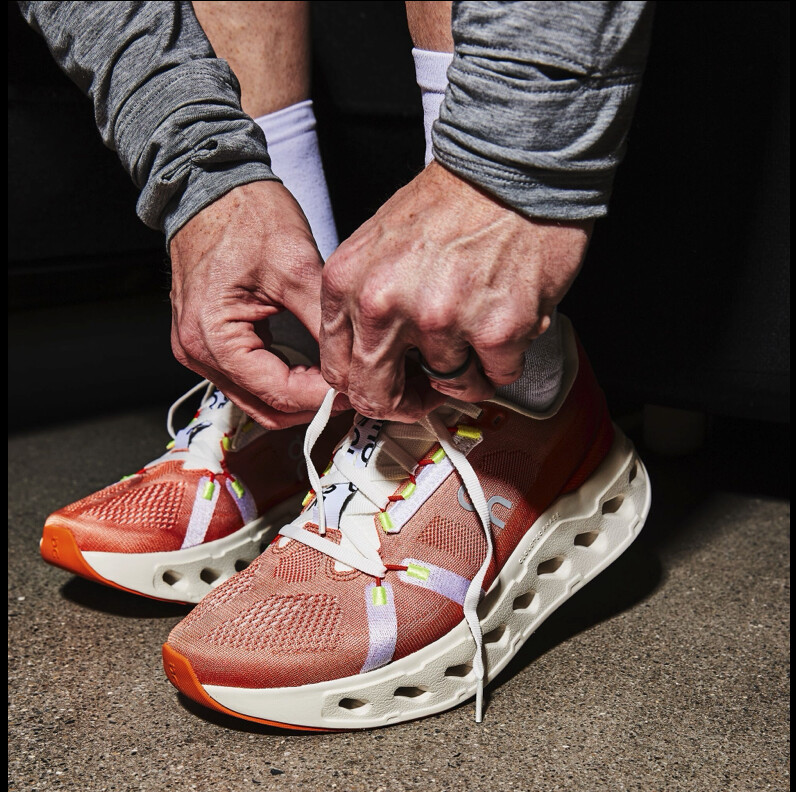
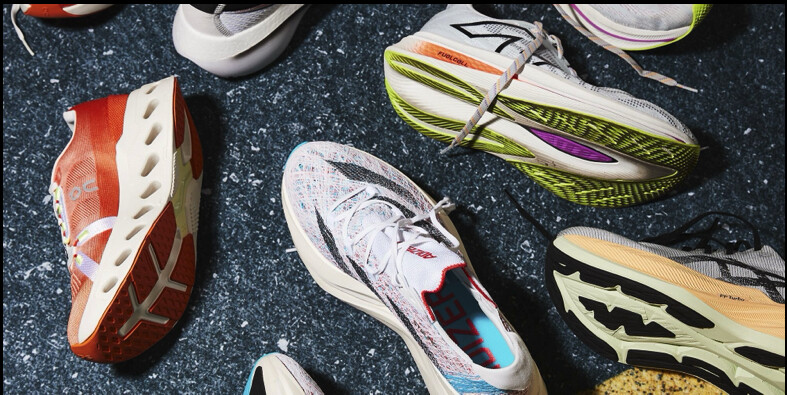
In 2010, the league cracked down again—this time, for reasons besides aesthetics—on a pair of basketball shoes that were shown to increase a player’s vertical-jump height. Today, Nike’s Air Jordan brand is a household name and multibillion-dollar business, and shoemaker Athletic Propulsion Labs (APL) has since released additional banned styles (Superfuture and Concept X) of its performance-boosting kicks.
Though some speculate these bans were mostly crafty marketing, the same can’t be said about the wave of “illegal” shoes that is flooding the roadways on the feet of runners. Super shoes have proven a true performance boon to both elites and recreational runners on race day. Now the tech has trickled down to shoes for daily runs, ushering in super-thick, though still permissible, shoes that have created their own category: super trainers.
What Is a Super Trainer?
Technically, a formal definition doesn’t exist. But we’ll establish some general parameters.
Super trainers share many of the same qualities as super shoes built for race day: a tall stack height, efficient midsole geometry, high-powered super foam, and usually some sort of plate. But these trainers aren’t meant for racing, like a Nike Vaporfly or Saucony Endorphin Elite—they’re designed for everyday mileage.
Super shoes for racing have to balance cushioning and propulsion, but still be lightweight. Super trainers, though, can have beefier constructions that help to extend their life spans. For example, shoe brand On guarantees only four marathons from the Cloudboom Echo 3—that’s little more than 100 miles. Super trainers can handle more mileage, and should have the typical 300- to 500-mile range of a normal running shoe.
To do that, they may have more outsole rubber for durability. Their uppers are usually softer and thicker than a racing shoe’s, as well, with comfortably cushioned ankle collars and tongues. They tie up with sturdier laces and offer a more forgiving fit overall, closer to what you’d expect from a workhorse daily trainer. And, since super trainers aren’t made to toe a starting line, brands can pile on midsole foam in excess of the 40mm limit imposed by World Athletics.
But they’re more than just extremely cushioned running shoes. Super trainers have additional mechanisms and “super foams” geared toward running efficiency and energy return, explained below.
Anatomy of a Super Trainer
If we break down a super trainer into its key components, we see a recurring theme: a stack of super foam in the ballpark of 40mm (or more), a carefully sculpted midsole shape for propulsion, and a plate that harnesses those pieces and holds it all together. This is the tech that puts the “super” in super trainers; it needs to interact with the foot and the rest of the kinetic chain in specific ways to deliver the intended ride and energy return.
Here’s what’s happening inside the midsole under your foot, and how these elements work to boost your stride.
1. Rocker Geometry
When we talk about a rocker sole, we’re describing the curvature of the bottom of the shoe’s sole. Both the heel and the toe curve upward, away from the ground, to give the shoe a more rounded base. The result is a shape like that you’ll find on a rocking chair. This is needed because the shoes are so thick, they don’t bend under the forefoot for a smooth transition during your gait cycle.
Shoe developers can also manipulate the inflection points of the rockers around a runner’s pace and foot strike to potentially manipulate transition time. Usually, you’ll find the most aggressive rocker designs in racing shoes. Still, pronounced rocker soles on super trainers are essential to make transitions comfortable.
→ How do rocker soles work?
Rocker soles in shoes function to mimic the natural rockers of the foot to make us feel more efficient. The foot has three functional rockers—the heel (first), ankle (second), and forefoot (third)—that we use while walking and running. The heel bevel in a shoe prepares the foot to contact the ground and smooths out the shoe’s ride when you land. Forefoot rockers assist movement during toe-off, which generally means the toes and ankle joint don’t have to work as hard.
For some runners, a stiff rocker sole can decrease demand on the calves by transitioning effort upward to the knee and hips. A runner’s experience will depend on their specific biomechanics, where the rocker is placed, and how their footstrike contacts it.
2. Super Foam
Polyether Block Amide, or PEBA, is a common foam compound for super trainer midsoles. (A popular trade name for the material is Pebax, made by a company called Arkema.) It’s the basis for foams like Nike ZoomX, Saucony Pwrrun PB, Puma Nitrofoam, and Asics FF Blast Turbo. Many of those brands leverage the same foam used in their top-tier racing shoes for their super trainer models.
Right now, PEBA-based foams lead the way for energy return. While current research and our own testing indicates that supercritical EVA and TPU blends are also impressive, PEBA has the edge more often than not. Why? It’s lighter than TPU and far softer and bouncier than supercritical EVA. Some iterations are firmer than others, depending on which brand’s flavor you try.
→ How does foam work?
Cushioning serves to absorb shock upon landing and provide overall comfort while running, but it can also return energy to the runner and stabilize the shoe. PEBA foams are especially lightweight, so brands can pile it on—both in thickness and in width—without the same weight penalty applied when using EVA or TPU materials. The additional width is just as important as the height. These shoes often need a wide platform of midsole material to remain stable.
Every brand’s PEBA-based foam compresses at a different rate, with varying amounts of responsiveness, so each offers a unique benefit based on the runner. For example, runners who land with lots of force can bottom out and crush a foam that’s too squishy, so they may prefer a firmer platform. A harder midsole can offer more support without any additional stability elements. On the other hand, a softer foam can provide more comfort, and research suggests that it may have a protective benefit for lighter runners.
Keep in mind that dozens of pieces within a shoe, as well as countless runner-specific characteristics, come together alongside a super foam to deliver its specific ride and response. It’s not always possible to parse each element individually.
3. Plates
Not every super trainer has a plate in its midsole, but it’s increasingly common. That’s because—regardless of whether it’s made from TPU, EVA, PEBA, carbon fiber, or a mix—a plate stiffens the midsole and can add support. It may also give the ride some extra pop, but it largely functions to stabilize the shoe. The Adidas Adizero Prime X 2 Strung, which has a heel stack height of 50mm, requires two stiff carbon-infused plates.
Some shoes need less support and utilize pliable materials with thinner rod constructions or forgo full-length plates for ones that extend only halfway along the midsole.
→ How do midsole plates work?
While plates can add propulsion, research suggests that the true hero is the foam itself. A plate mostly serves to “facilitate motion and add stiffness to the sole to balance out the softer compliant foams,” says Matt Klein, DPT and founder of the Doctors of Running website and podcast.
He explains that the effects of stiff-plated shoes are not clear-cut. “Everything we know [about super trainers] is applied from super shoe and maximal shoe research. These shoes shift work up to the knees and hips. The ankles may do less, but that doesn’t always apply. If the shoe is too stiff, the ankles will actually end up doing more work. But once a midsole gets so thick, it may not need a plate; the amount of material naturally stiffens the ride.”
What Are the Benefits of Super Trainers?
Simply put, these shoes are so much fun to run in. They can lend a bounce to your stride that feels like bounding on a trampoline. And since the springy sensation and high energy return can help you move more efficiently, running fast feels easier.
Plus, a review of 63 research studies concluded that these trainers can also help attenuate shock and dampen some of the hard impacts from training. So, runners recover from hard efforts more quickly; they’ll lace up the next day feeling fresher and less sore than if they’d worn regular running shoes. And for those eager to increase mileage, this may allow some runners to increase their weekly workload with less fatigue and fewer aches and pains.
“These have the benefit of having similarities to super racing shoes. These shoe types certainly increase the capacity of work you can do, so I suspect those running higher miles will probably benefit most from these,” Klein speculates.
But, the recovery boost from super trainers can make it tempting to tack on too many miles too soon or overcook the pace on easy days. “Just because you are less sore does not mean you are at a lower risk for injury. You can still get injured with overdoing things,” Klein says.
Our wear-testers report that they’re able to run faster paces with less effort in super trainers, but it’s still important to keep easy jogs relaxed. Double-check your training log and pull back on the reins if you notice spikes in mileage or intensity outside your typical training volume.
Are There Any Risks to Super Trainers?
Though they feel great, super trainers can have an impact on our natural gaits and biomechanics. “One of the injury risks for this shoe type is that it is so different from normal mechanics and footwear. The current evidence from super shoes and super-max stack-height shoes is that we tend to stiffen our legs in taller, softer shoes,” Klein says. “This is not bad short-term, but some evidence suggests long-term super-max stack-height shoes can actually increase joint loading due to that stiffening.”
“I suspect running in them a ton will cause less joint motion, as the body will stiffen up to find stability as shock absorption isn’t needed. This may be great for a recovery run/faster run, but trying to transition back to normal shoes can take time if you only run in these and super racing shoes.” Klein recommends making the transition slowly to avoid injury and keeping more than one pair of running shoes in your rotation.
“I do suspect that with the workload being shifted up to the knee and especially the hip, there may be an increase in injuries in those areas. The hip still has to work harder being on a softer, less stable surface. So, those with hip instability and strength issues may want to avoid super shoes, at least until these issues have been addressed,” Klein says. New runners should focus on building strength and experience before experimenting with super trainers.
There is little doubt that these shoes have effects at the point where our feet meet the midsoles as well as farther along our kinetic chains. Super trainers shift more of the workload of running to the hamstrings, which means that you won’t engage the calves and lower leg muscles as much. Moving some of that effort to larger muscle groups can be beneficial for some runners, like those who are struggling with calf or Achilles tendon injuries. But those who have a nagging hamstring strain may need to be wary. Whether or not it’s your goal, those upper leg muscles will receive more of a workout.
At the very least, one thing can be said for sure. It’s that all the foam underfoot is going to put a lot of distance between your foot and the ground. This limits the amount of ground feel you receive from the shoe. It can be easier to wipe out if you’re hopping a curb on a night run. And on rain-slicked sidewalks or technical trails, it can be tough to steer a thick and bulky midsole. If you’re prone to ankle rolls or need a keen sense of where and how your foot is landing whenever you touch down, a super trainer might not serve you well.
Will I Really Get DQ’d in a Race?
It depends. If you’re an elite runner, absolutely. But if you’re going for a 3:10 BQ, it’s unlikely. Ethiopian runner Derara Hurisa won the 2021 Vienna Marathon in 2:09:22 but was disqualified when race organizers found he’d raced in the Adidas Adizero Prime X, a different shoe than he’d declared on his prerace form. Another runner at a fall 2023 half marathon was disqualified after winning in the same shoe.
Our Favorite Super Trainers
Running shoes aren’t cheap. Maxed-out midsoles with top-end shoe tech only add to the bill. Most super trainers will cost you $180 at least, and there are options to be had for well over $200.
by Runner’s World
Login to leave a comment
How to Use the Run/Walk Method for Faster Times and Longer Distances
Adding walk breaks to your training runs and races just might provide your ticket to faster finishes or longer distances.
Many runners have a few dirty little secrets, like not quite making it to the bathroom or chafing in unmentionable spots. But one thing many runners also won’t admit to... walking. That is, unless you embrace the run/walk method, which involves adding precisely planned walk intervals to your runs.

The run/walk method can offer runners many benefits, including helping to fight off fatigue. It can even help you clock faster finish times and maybe even win a race that you thought was out of reach. Just look to Marc Burget for evidence. A ultramarathon run/walker, Burget, 50, won the 2016 Daytona 100 (miles) in 14 hours and 14 minutes which, at the time, was a course record.
“The idea that you should move from walking to running is the wrong framework,” Burget, director of operations at Bailey’s Health and Fitness in Jacksonville, Florida tells Runner’s World. “Instead, putting walks in my race plans allows me to go the whole 100 miles without becoming tired.”
Research supports Burget’s experience. According to a 2016 study published in the Journal of Science and Medicine in Sports, of the 42 runners studied, those who used the run/walk method in a marathon reported less muscle pain and fatigue and finished with similar times, compared to those who only ran.
So, while it’s true that runners typically move faster than walkers, it’s also true that during long races or training runs, taking well-timed walk breaks can help you reach your goals. To understand the run/walk method, here are common myths and truths about the training and racing strategy, plus how to test out the system for yourself.
Myth: Only Slow Runners Use the Run/Walk Method
Truth: Slow Walks Support Faster Finishes
In recent years, more runners and experts have learned that zone 2 running (that is, lower effort runs), improves many elements of fitness and supports your ability to run both long- and short-distance races without fatiguing as quickly.
Whatever distance you race, it’s important to manage your energy levels from the start, so you can make it to the finish without bonking. While fuel plays a role in maintaining energy, how you pace a race is also crucial.
“There’s a myth that a lot of runners perpetuate about banking time,” Chris Twiggs, chief training officer at Galloway Training Programs tells Runner’s World. “The time bank doesn’t exist. The bank that does exist is the bank of energy. When you walk during your run, you are investing in the bank of energy.”
Burget agrees. The first time he ran 100 miles, he planned to run the whole way, but because of exhaustion, he ended up walking about 20 miles. Once he started to train with the run/walk method, he cut his walking down to 10 to 15 miles thanks to 30-second walk intervals. Now, with experience, most of his ultras include eight to 10 miles of walking and he either alternates three minutes of running and 30 seconds of walking, or 0.3 miles of running and 30 seconds of walking, depending on his race strategy and goals.
How to use the run/walk method to get faster:
If you have your mind on a PR, the run/walk method could help you get there. You just have to practice.
“Your walk should be brisk, but not work,” says Burget. “You want your heart rate to drop down.” You also want to give your muscles a break from the intense effort to allow for a midrun recovery.
Because you’re walking, you also need to make your run intervals faster than if you’re going for a steady-state run. For example, let’s say you want to average an 8-minute per mile pace for a marathon. Try running a 7:40 pace for nine-tenths of a mile, then walk for 30 seconds, so that you finish a mile in eight minutes. “You’re not losing 30 seconds,” Burget explains. “You’re moving forward, but part of your pace is a walk.” Likewise, if you want to maintain an 11-minute pace, you could do a 40-second walk every three minutes of running at around a 10:20 pace per mile.
If you have been running for a bit but you don’t know where to start with your interval ratios and paces, do a “magic mile” run, both experts say. This will help set your goal pace for a race. With that magic mile time in mind, set your interval ratios, keeping in mind that generally, the faster your average pace, the longer your run intervals. For example, if you’re aiming for an 8-minute mile average pace, you may run three minutes and walk 30 seconds. But if you’re aiming for a 10-minute mile average pace, you may run 90 seconds and walk 30 seconds.
If you’re a beginner, Twiggs suggests starting your workouts by running for 30 seconds and walking for 30 seconds. If that seems too easy or you can feel yourself wanting to run more keep the 30-second walk, but run slightly longer between walks, he says.
You can keep track of your ratio using time or distance. Twiggs uses time, while Burget often pays attention to the mile markers in his races, walking for the last tenth of each mile. Play around with what works best for you.
“It took me a few months to figure out the ratio that works for me,” says Burget, who has also run a 2:50 marathon by alternating six-minute runs and 15-second walks.
When you want to actually increase your average pace per mile, do another magic mile to see how much faster you can go, and then either increase the speed of your run intervals, add more time to the run intervals, or cut down on the time of your walk breaks.
Myth: Only Beginners Take Walk Breaks
Truth: The Run/Walk Method Can Work for Everyone
While there are no statistics on how many runners use walks in their training or in their races, how long they’ve been running, or how “tired” any runner is when they walk, we can confidently say that runners who strive to incorporate walks into their runs are all ages and all levels of fitness.
Both Burget and Twiggs run ultras, something less than 1 percent of Americans did in 2023, and ultrarunners typically aren’t new to the running game.
In fact, planning your run/walk strategy for races can take practice so many experienced runners and walkers may turn to it. For example, Burget has learned to time his walks to match the location of hydration stops and elevation gain in his ultras so he can maximize his running potential. But that came with lots of practice using the run/walk method.
How to use the run/walk method to advance your race results:
Always study the details of your upcoming race and consider creating a strategy to match walks with water stations and hills. “Looking at the landscape when planning your run/walk is important,” says Burget.
“Walking hills is smart because we want to do what we can to conserve our energy so that when we expend our energy we get the most bang for our buck,” says Twiggs.
Running up hills during training will help you build leg strength, but in a race it could decrease your pace (and finish time) because it takes so much effort, adds Twiggs. Without planning, you might find yourself running up a hill (wasted effort) and then walking a descent as you recover. Planning ahead can help you flip that to maximize your energy and increase your speed.
The point: Go into your race with a clear plan that has specifically planned walk breaks so you’re not just slowing it down when you feel like it, which could be a detriment to performance, Twiggs explains. Playing around with your run/walk ratios during training will also help you set this in stone come race day.
Myth: Being a Run/Walker Will Limit Your Race Opportunities
Truth: Walks Can Help You Participate in Longer, Harder Races
The reason running is defined as “high” intensity while walking is considered “low to moderate” intensity is because it takes more energy to run than to walk. Typically, your heart beats more frequently when you run than when you walk in order for your body to produce that extra effort.
Break up those runs with walks, though, and you are giving your heart, muscles, bones, and joints a break. It’s helps with the deposit into your energy bank, as Twiggs says. The benefit of those deposits? You may be able to add to your race schedule, say by running a half marathon instead of a 10K, if that has seemed out of reach. If you think you can’t run a marathon, could you run/walk one?
To prove the point that adding walks into long runs can cut down on fatigue and help you go longer (or even run more frequently), take another example from Burget: In 2023, he ran seven marathons in seven consecutive days, aiming for a sub-three-hour finish for each race. While he ran just over three hours in two of the races, his other times ranged from 2:52:15 to 2:58:57. “I used the same interval for each race,” Burget says, “a 20-second walk during each mile.”
How to use the run/walk method to run longer:
While you experiment with run/walk intervals, try to notice how you feel in comparison to runs that don’t include walks. Do you feel like you can increase your typical run distance or duration by a half-mile or 10 minutes?
To progress to longer distances, you have a variety of options: You can increase the pace of your runs or shorten the walk breaks you take, says Twiggs, while still running for the same overall amount of time. (This will increase your average pace.) Or you can maintain your pace and your ratio, but add more rounds of intervals, so you run for a longer duration and therefore, distance, which may come easier than only running because of the added recovery element. Do what feels best for you.
In addition to helping you conquer longer distances, the run/walk method might increase your race options by also allowing you to take part in multi-day events, such as runDisney weekends or Philadelphia’s Marathon Weekend, which includes an 8K, half, and marathon.
While some runners, of course, take part in these events without using the run/walk method, “we’ve seen anecdotally that for millions of runners, this allows them to run races they would not have otherwise considered,” says Twiggs, because it can allow for that quicker recovery.
Login to leave a comment
Running Through the Night to Confront the Darkness of Substance Addiction
Ultrarunner Yassine Diboun found his own unique way to help those in recovery move through darkness together. It’s working.
Since 2020, Yassine Diboun has made it a point each year to black out one square on his calendar with a Sharpie.


It’s a gesture to signify that on this day, typically set around the winter solstice, this 45-year-old ultrarunner and coach from Portland, Oregon, won’t run during the day, as he does most every other day of the year. Instead, he’ll watch a movie with his daughter, Farah, or cook a meal with his wife, Erica, eagerly waiting for night to fall. Because that is when the action starts.
Diboun has become a fixture in Portland’s trail running scene, a Columbia-sponsored runner and one of the most electric and positive forces in the U.S. ultrarunning scene today. He is also an athlete in active substance addiction recovery since 2004.
And here, at the confluence of endurance and recovery, is where Diboun enacts an annual tradition in Portland called Move Through Darkness. From sundown to sunup, Diboun runs through the evening, covering a route that connects city streets with trails in Forest Park while accompanied by dozens of other runners.
On December 9, Diboun will start his fourth-annual Move Through Darkness run. It may exceed 70 miles. It may not. That’s not really the point, though in some sense it is, for the more miles he runs, the more pledge-per-mile dollars he gains to funnel into future recovery programs, the very support structures that saved his own life two decades prior.
In 2009, Diboun and his wife moved to Portland, where he pursued a career in coaching. One of the first things Diboun did upon arrival was to connect with the recovery community, which led him to The Alano Club of Portland, the largest recovery support center in the United States.
Diboun’s personal history of substance addiction is circuitous and complicated—documented extensively in Trail Runner, The New York Times, Ginger Runner interviews, and others—but what’s most important to know is that it led him down a path that wasn’t his own. Alcoholics Anonymous (A.A.) and the 12-step program threw him a lifeline and he white-knuckled it to shore, reinforced by commitments to a plant-based diet and a healthy dose of body movement. (That’s code for running a ton of miles.)
Such discipline brought him to the highest levels of ultrarunning. He’s a four-time finisher of the Western States 100 Mile Endurance Run (once in the top 10), a three-time finisher of the H.U.R.T. 100, in Hawaii, and he represented the U.S. at the IAU Trail World Championships in 2015. These accolades sit beside countless ultra wins and podiums.
His success story prompted Brent Canode, executive director of the Alano Club or Portland, to reach out to Diboun in 2018 with a proposition. Diboun had, by then, teamed up with mountain athlete Willie McBride, to start Wy’East Wolfpack in 2012. The business offers group functional fitness programs, youth programs, and personal guidance to get people outdoors and on trails.
Under Canode’s leadership, the Alano Club just launched The Recovery Gym (TRG)—a CrossFit-style facility offering courses for those in recovery, and Canode saw running as a natural extension of this program. He asked Diboun to spearhead a new running portion of the gym. For Canode, though models like the 12-step program were widely available and proven effective, he found the diversity of options for community lacking beyond that.
“What we learned was that a lot of folks don’t attend 12-step programs,” Canode says. “They haven’t found a connection anywhere else, and that’s a matter of life or death for a person in recovery.”
Together, the two started regular informal runs called the Recovery Trail Running Series, which evolved into a more formalized wing of the gym: Run TRG. This program quickly took off, offering evening group runs, outings that would often end in post-run dinners and fun gatherings. The groups grew bigger each week.
“We cultivated this community for anybody in or seeking recovery from substance addiction, and it really picked up some good momentum,” Diboun says.
When the pandemic shut everything down in March 2020, including The Recovery Gym and its new Run program, regulars instantly lost the group’s connection. Many relapsed and started using substances again. A few turned to suicide, including a prospective coaching client for Diboun who had met with him just one week prior.
“I know from personal experience that life can get too overwhelming at times and you get too stressed or overwhelmed and you can’t see anything,” Diboun says. “You can’t see any hope, so you just live recklessly, helplessly. In extreme cases, life can feel not worth living anymore.”
While running one evening by headlamp, Diboun thought about the fragility of hope, the pandemic, the recent suicides, and the ever-increasing need for community. The combination of isolation and mental health decline, paired with an uptick in running popularity during the pandemic (Run TRG, once relaunched, tripled in size), created an opportunity for Diboun to leverage his visibility as both a decorated ultrarunner and someone vocal about his addiction history.
An idea was born: Move Through Darkness.
For one night, sundown to sunrise, he would organize a run to crisscross the city, connecting various trail systems and raising visibility of the mental health challenges entangled with isolation and addiction. It would take place around the winter solstice, the longest night of the year.
The initiative would serve three main purposes: First, it would be a personal pilgrimage for Diboun, a reminder of his own ongoing relationship with sobriety. Second, it would offer another way for those in recovery to come closer during difficult times. And third, the event would raise financial support for the Alano Club of Portland, which serves more than 10,000 people in recovery each year through mutual support groups like A.A., peer mentoring services, art programs, harm reduction services, and fitness-based initiatives like The Recovery Gym and Peak Recovery, Alano’s newest program, which provides free courses in split boarding, rock climbing, and mountaineering. Over the last eight years Alano has won four national awards for innovation in the behavioral health field.
December 2020 was the first-ever Move Through Darkness event. About 30 runners participated throughout the night, joining Diboun in various sections of his sinuous route. Given that the invitation was to run upwards of 100K through the night in some of the worst weather of the year, the turnout was impressive. The group eventually made their way to Portland’s Duniway Track to complete a few hours of loops, encouraged onward by music.
One of those runners that first year was Mike Grant, 47, a licensed clinical social worker from Portland. Grant has been in long-term recovery with substance addiction and understands the initial hurdles of getting out there. During the event, Grant completed his first ultra-distance run by covering 50 miles. He hasn’t missed a Move Through Darkness run since.
This year, he’ll be joining again, in large because of Diboun.
“You hang out with Yassine for any length of time, and the next thing you know you’re running further than you ever have before,” Grant says. “He’s one of those people you just feel better when you’re around.”
The Move Through Darkness route is roughly the same every year, but it always starts and ends at the Alano Club, located in Portland’s Northwest neighborhood. This first year, his daughter, Farah, ran with him from Duniway to the Alano Club, which was a particularly special moment to share.
The fundraising component is a pledge-per-mile model, where you can pay a certain dollar amount for every mile Diboun will cover. All funds go to support the Alano Club, specifically the Recovery Toolkit Series. Other recovery-focused gyms are increasingly available nationwide, but The Recovery Gym is the only CrossFit affiliate in the U.S. designed from the ground up, exclusively for individuals in recovery.
Each week, TRG offers six to eight classes free of charge to anyone in recovery. Every coach holds credentials in both CrossFit instruction and peer mentoring for substance use and mental health disorders. An original inspiration for Run TRG was the Boston Bulldog Running Club, a nonprofit established in 2015 to provide running community reinforcement for those affected by addiction and substance addiction.
According to national statistics released earlier this year, 29 percent of U.S. adults have been diagnosed with depression at some point in their lives—the highest rate since such data was measured. Suicides in the U.S. reached all-time highs in 2022, at nearly 50,000 lives—about 135 people per day lost to self-inflicted death. In 2022, 20.4 million people in the U.S. were diagnosed with substance abuse disorder (SUD).
Oregon, specifically, is rated number one in the country for illicit drug use. In 2020, Oregon had the second-highest alcohol and drug addiction rates in the country, while ranking last in treatment options.
Canode says that, after 40 years of researching addiction and effective recovery, the single most important aspect of recovery success is authentic connection to a like-minded community. That’s why both Canode and Diboun are building an all-hands-on-deck approach to recovery through running, to strengthen connections through movement.
“In recovery, we know how to grind,” he says. “We are naturally great endurance athletes. We also know how to consistently move through darkness, which is especially true in the beginning of someone’s recovery journey. It’s often not rainbows and unicorns and lots of positivity. It’s a grind. It’s grueling.”
Annalou Vincent, 42, a senior production manager at Nike, is one of the many people who have reached out to Diboun from all over the Portland community.
“Finding Yassine and Run TRG saved my life,” she says. After starting a running practice in her thirties, she started feeling better and decided to question decisions like drinking alcohol. She eventually dropped booze and became a regular at the Run TRG. Vincent has worked closely with Yassine to develop and promote Run TRG, and has joined Diboun for various legs of Move Through Darkness over the years.
“I can’t imagine my life or my sobriety without running and this program, says Vincent. “Over the years I’ve seen it change the lives of many others. Move Through Darkness is an extension of that. This program and others like it are saving lives.”
Willie McBride, Diboun’s business partner, supports Move Through Darkness each year and has witnessed its evolution and impact.
“I think people really connect with this project because they understand those dark parts of life, and how challenging they can be. Darkness comes in all different forms,” he says. “But also the very tangible act of running all night, literally putting their body out there—coming together as a group sheds light right into that darkness.”
Diboun is reminded daily of his life’s work, to remain sober and offer his endurance as a gift to others, even when it gets difficult.
“I’m coming up on 20 years sober, but I’m not cured of this,” he says. “This is something I need to keep doing and stay on the frontlines.”
With record rainfall aiming for Oregon in December, this Saturday night calls for a 58 percent chance of rain showers, with the last light at 5 P.M. and the first light around 7 A.M. That’s potentially 14 soggy hours of night running. But this forecast doesn’t cause Diboun any concern. He’s used to it, used to running for hours in the dark, used to being drenched. He’s faced that long tunnel and knows that there’s always light at the end, as long as you keep trudging forward, and best when together.
“You keep passing it on,” he says. “You keep giving it away, in order to keep it. Gratitude is a verb.”
by Outside Online
Login to leave a comment
Who Is Courtney Dauwalter’s New Ultramarathon Partner? It’s Her Mom.
Here‘s how the Dauwalter duo completed a dream of crossing a finish line together
The last loop was quiet beneath the full moon. Their shuffling feet on the packed, pebble-tossed singletrack punctuated the sleeping Sonoran Desert as the duo moved through shadows of saguaro cactus and prickly pear. Millions of white pinpoints began to appear in the dark sky.
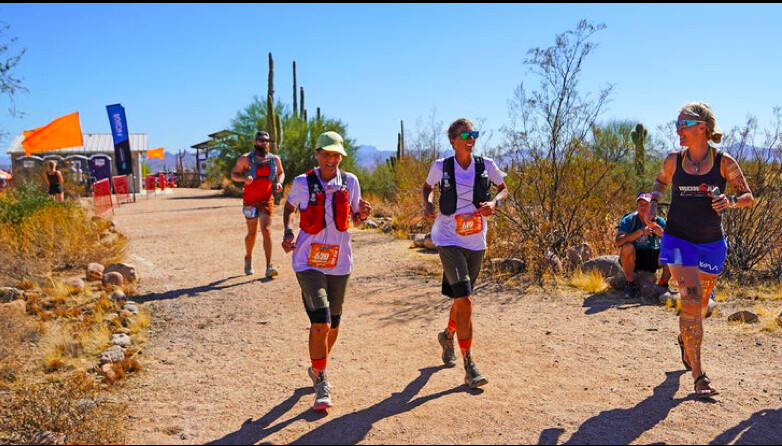
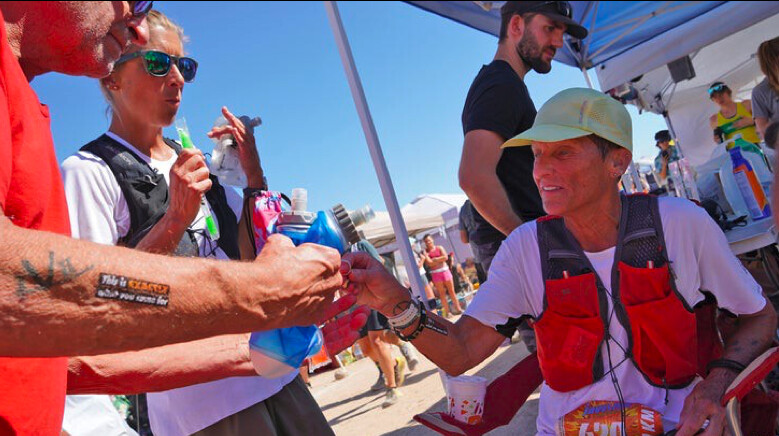
That’s when 66-year-old Tracy Dauwalter, mother of ultrarunner Courtney Dauwalter—who was coming off of historic back-to-back-to-back 100-mile wins of the 2023 Western States 100, Hardrock 100, and UTMB, including two course records—started resharing doubts with her daughter, who kindly reminded Tracy many times throughout the last 13 hours, “that’s not useful thinking, so let’s not think it.”
Occasionally, Courtney would redirect their attention, pointing out this unique section of the course that they’d been past twice before. This time, she built a 60-second container to stuff all those fears inside.
“Tell me all of your doubts and frustrations. You have one minute,” Courtney told her mom. “Once you finish, you can’t complain out loud anymore. It’s not serving us to get to this finish line.”
Tracy spewed all of her negative thoughts, from her rolling stomach to her aching muscles, which was an important reset to get out of the whirlpool of heavy thoughts. I signed up for this, Tracy humbly reminded herself. Nobody’s making me do this.
A dedicated team, the pair was running three loops side-by-side in matching long running shorts, white baggy tees, Salomon hydration vests, and cactus-themed socks, at the Halloween-themed Javelina Jundred 100K race. The ultrarunning event is held the closing weekend of October in the McDowell Mountain Regional Park, an hour northeast of Phoenix, Arizona. Temperatures can climb into the 90s by mid-morning and dip into the low 50s once daylight disappears behind the McDowell Mountain Range.
Now 38 years old and living in Leadville, Colorado, Courtney had participated in the event once before, in 2016, when she was the race’s outright winner. She set the then-course record for the 100K, one of several performances that drew national attention to her astonishing endurance and athleticism.
Tracy, who’d just recently started trail running, had covered ultra-distances at 12- and 24-hour events across flat gravel, but had never before run this far on a trail. They selected Javelina’s rolling 100K with 3,924 feet of vertical gain. The majority of the climbing is packed into the gradual ascent from the Javelina “Jeadquarters” aid station, which serves as the start and finish of the race and basecamp, to the far side of the loop, Jackass Junction.
It was exactly here, at this midway point, after slogging up the final climb over rolling hardened granite and sandy washes, where Tracy had a sticking point. Fortunately, Courtney was there to fill up her water bottles and point out all the tasty options when they reached the runner’s buffet.
“Please keep eating,” she said, as the electronic dance music bumped. A few hours earlier, they enjoyed a surprise pick-me-up of McDonald’s cheeseburgers, delivered by crew masters Dick Dauwalter, Courtney’s dad, and Kevin Schmidt, her husband. But one of the biggest highlights during the race for Tracy was watching Courtney interact and commune with so many people in the trail running community.
“Courtney does this amazing sport, but even more, I adore the person she is. It’s one of my favorite things to watch the love that’s out there for Courtney, and the way she responds. To be in that world with her was really special,” Tracy said. “She was also really kind to me, even when I was frumping and I’d fall down, she’d help pick me up.” Courtney let out a laugh.
“Mom, you only fell one time!” said Courtney, laughing.
“I know, but it was embarrassing,” Tracy said.
While Javelina was the mother-daughter’s debut trail ultra finish, side-by-side, the experience wasn’t their first race together. When Courtney was in high school, the duo finished a rollerblade marathon together in St. Paul. (Rollerblading is a major pastime in Minnesota, where Tracy grew up and still lives today.) Here, she met Dick and raised Courtney, a middle-child to two brothers.
While growing up, Tracy played softball and badminton. In college, she ran cross-country and track. “I’ve always been interested in sports and done them at a level that I could make the team. I was never a star. Being on a team is social and taxes your body while working up a sweat,” she said.
When the kids were interested in soccer, she and Dick organized an adult co-ed squad. Now, she jogs, plays volleyball, and golfs. She and Dick enjoy motorcycle tours, too, like venturing through the Elk Mountains in Colorado. “I’m not great at anything, but I can hold my own, and it’s super fun—I’m willing to do any sport,” she said. The motto was much the same for the kids.
"I thought that it would be so cool to share this sport that I love so much with this person I love so much. I knew she could do it.”
“They could try any activity. But once they committed, they had to see that season through—whether they enjoyed it or not, we were committed. We didn’t miss practices or games. We made sure those were a high priority for them and us. That drove our lives for many years with lots of fun times, but boy, that schedule was crazy—we’d slam-dunk dinner at 4 P.M. so that everybody could get to practice,” Tracy said.
An accountability mindset is one that leads to showing up in other areas of life from work to class to chores, following through on responsibilities and gritting out less desirable tasks. “When things get hard, like college classes, your option is not to quit,” Tracy said. “You dig in a little deeper, get help, and get it done, which is the same with any sport.”
But perhaps their most special ingredient is that the Dauwalters know how to have fun. “Having fun while doing those things is just as important,” Courtney said. “Our family always worked hard, but we play hard, too. All of that combined is what makes life special. Having that be deeply ingrained in who I am helps me in everyday life, but also, for sure, in ultrarunning.”
While watching Courtney grow up, Tracy noticed her daughter had a deep motivation as a person and athlete. One of her earliest memories was two-year-old Courtney, who could barely walk, repeatedly riding a Big Wheel tricycle downhill with a group of kids and insisting she’d wrestle the bike up the hill by herself. As a kid, Courtney and her siblings played soccer, often on the same teams. Later, they ran high school cross-country and track. To fill the winter months, she tried basketball, but she had a propensity to quickly foul out, taking the bench for the remainder of the game.
One day, she came home with a bright idea to Nordic ski instead, which was foreign for a family full of downhillers. They picked up the equipment, Courtney joined a competitive team, and she practiced in nearby school fields. “All she did was wipe out. All the time. Dick and I are thinking, ‘I wonder what this is going to look like?’” said Tracy.
During those foundational years, Courtney would rush home after a Nordic race to report the number of crashes she’d had. “In a 5K, I would be psyched if I only crashed nine times—tripping, planting my poles, tumbling the entire time. I was so bad,” she said.
But Tracy bought a beat-up pair of cross-country skis and started to practice alongside Courtney. “We learned together,” Tracy said. “It was more fun to crash with somebody than to crash by yourself.”
By the time Courtney graduated, she was an all-state runner and had earned All-American honors as a Nordic skier three times. She was a four-time state champion, and her team acquired two national championships. In 2003, Courtney moved west to Colorado, where she raced collegiately on the Nordic ski team at the University of Denver. Three years in, her DU team won 11 meets and the 2005 NCAA Championship.
“Courtney was really good at everything she did, and it wasn’t because she was a natural,” Tracy said. “Anytime she tried a sport, she didn’t have an immediate knack for it, but she hung in there to develop it. She was a hard worker and determined.”
Years later, in 2015, any remaining questions of physical stamina were laid aside—for both Tracy and Courtney, who proved to have a serious knack for endurance. Courtney broke the ribbon at her inaugural ultra race, the 2011 Prickly Pear 50K in San Antonio, Texas, and her curiosity about wanting to run longer continued to grow. The following year, she dropped out of the Colorado’s Run Rabbit Run 100 Mile race at mile 60 with throbbing legs, questioning her ability to cover that much ground in a single push.
Frustrated by not meeting her goal, Courtney registered for her first 24-hour race, the 2013 FANS Ultra Races, a more manageable format than an ultra on singletrack. Her family joined to crew and run laps, providing entertainment and support, including Tracy. They didn’t have much of a background in ultras and were green to any strategy.
Regardless, Courtney wrapped a total of 105 miles on that two-mile gravel loop around Lake Normandale Park in Bloomington, Minnesota, completing her first non-trail century-distance, and gaining confidence. Two months later, she crossed the finish line of the Superior Fall Trail Race 100 Miler in Lutsen, Minnesota, her first 100-mile distance on trail, and stood on the podium for second place.
Moving forward, the FANS Ultra Races became a family tradition. Courtney returned to the 2014 event, besting her first summer with 123.6 miles. Tracy decided, if she was going to crew and run laps with Courtney, she might as well sign up herself.
“She was like, ‘Heck, I’m going to spend the whole day out there anyways. Why not put some time on my feet?’” Courtney recalled.
In 2015, she tallied 109.2 miles while her mom, then 57 years old, covered 66.8 miles. Their annual pilgrimage continued in the 24- or 12-hour format, over the next several summers, coinciding with Courtney’s ultrarunning career picking up steam. She won the 2016 Run Rabbit Run 100 Mile with a 75-minute lead, and along with the title, the world’s largest ultra purse: $12,000.
By the summer of 2017, she retired from her position at the Girls Athletic Leadership School in Denver where she taught science and coached cross-country. “In an interview a few years ago,” Courtney said. “I was asked if I could run an ultramarathon with anyone in the world, who would it be? ‘My mom,’ I said. I thought that it would be so cool to share this sport that I love so much with this person I love so much. I knew she could do it.”
In an interview a few years ago, she was asked, if she could run an ultramarathon with anyone in the world, who would it be? “My mom,” she said. “I thought that it would be so cool to share this sport that I love so much with this person I love so much. I knew she could do it.”
Tracy heard the recording and, despite having never run on trails, she immediately called her daughter. “Let’s do it. I heard you want to run an ultra, so let’s sign up for something,” she said to Courtney. “If someone puts a challenge in front of me, it can even be pretty insane, and I’m a sucker for trying to rise to that challenge.” In addition to the competitive spark, the invitation felt sentimental.
Committed to doing an ultra together, they accepted that it might be a winding road to get there. The two picked the 2022 50-mile Superior Fall Trail Race in Lutsen. Mid-route, they missed the cut-off. Tracy shrugged and shook her head recounting the unfinished event. Courtney refused to let the DNF be a negative thing. “You learned so much in that first summer, mom,” she told her. “Dialing in all of those pieces helped immensely this year. And we decided, we’re not done. We still need a finish line together.”
As soon as registration opened in January, the duo signed up for the 2023 Javelina Jundred 100K. “I was nervous coming into this race because I was bouncing off of that epic fail of the first 50-miler we tried, which was a wake-up call. You have to prepare yourself,” said Tracy.
“It was not an epic fail,” Courtney countered.
That winter, Tracy clocked workouts on a treadmill. From April onward, she ran outside four or five days a week for 10 to 20 miles. Courtney researched singletrack trails around Lone Lake, which her mom became excited to explore. One of the biggest challenges of learning to run on trails is her tendency to shuffle and trip, Tracy confessed. Building confidence, she finished the Willow 20 Miler in May and Afton Trail Run 50K in July. Like her daughter, Tracy didn’t keep a close log of her mileage, and her training was not systematic.
Courtney’s advice, true and simple, rang in her mind: Spend time on your feet.
“People asked me if I coached her. Absolutely not,” Courtney said. “I did try to be helpful—harping on testing nutrition, wearing a pack so that her body gets used to one, and hiking uphills—so her race day could be much better. She was the one putting in the work and figuring out routes where she could do laps or get on hills. I admired from afar.”
“It helped that Courtney kept reminding me, ‘This was our run together, our race, and it could look however we could make it.’ If I crawled, that wouldn’t be disgusting. It got ugly, then it got not ugly,” Tracy added.
Staying lighthearted, Courtney countered, “It never got ugly. There was never a doubt that we would make it to the finish.”
Fortunately, the elation did come around. Next to her daughter, Tracy crossed the finish line of Javelina Jundred 100K in 17 hours and 38 minutes with a smile in the glowing lights, after staying up into the night running, eating, and sharing pain—but mostly, laughing—with her daughter. They’d gone full circle together, both on the circuit they’d traveled in the desert as well as in life.
“I think you beat me by, like, a half-second, mom,” Courtney said.
“I know,” Tracy bantered back. “I think I was really needing to be done, so I rushed with a half-second sprint.”
by Outside Online
Login to leave a comment
World 24-hour record for Miho Nakata
Japanese ultra-runner sets women’s all-time best by slim margin as Aleksandr Sorokin takes men’s title at the IAU World 24-hour Championships in Taipei
Japan’s Miho Nakata set a women’s world record when winning the IAU World 24-hour Championships in Taipei on Saturday (Dec 2) while Lithuania’s Aleksandr Sorokin retained his world crown and the British team won bronze in the men’s race, Adrian Stott reports.
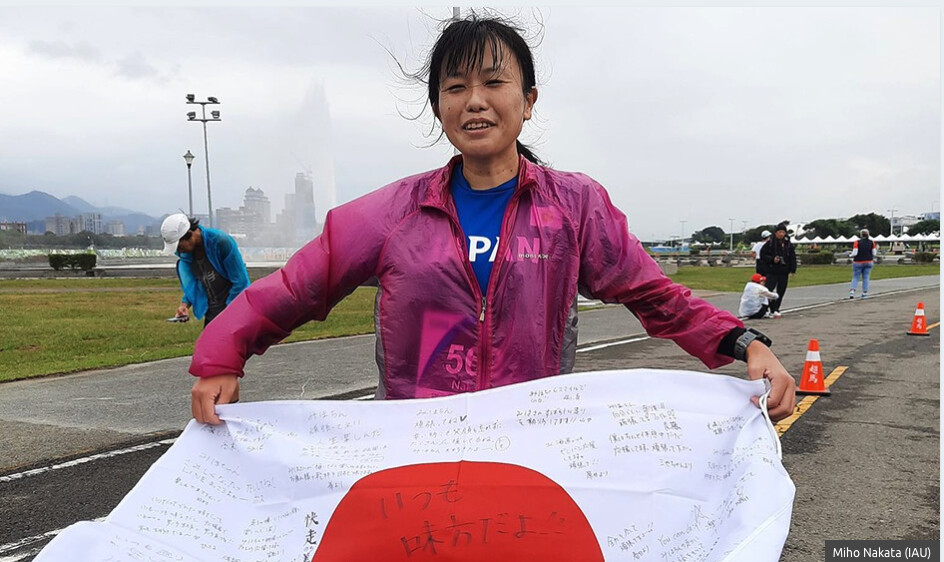
With final results still to be confirmed, organisers are reporting a distance of 270.363km (167.995 miles) which, if confirmed, will surpass the distance set by Camille Heron of 270.116km (167.842 miles) at the last edition of the championship in 2019 by a mere 246 metres.
Nakata had been the early leader and at six hours had reached 78km, with Finland’s Noora Honkala and Herron in second and third. She reached 100km in around 7hr 50min, a total of 10 minutes up on Herron’s split from her world record run in 2019.
At halfway, Nakata had accumulated 146km, on par with Herron’s record split at the 2019 event in Albi. Herron was lying second with 142km, Norway’s Line Caliskaner was on 140km with Spain’s Carmen Maria Perez and Honkala also on 140km.
Herron seemed to encounter difficulties and retired at this point, leaving Nakata to power on and reach 100 miles in approximately 13hr 25min with Spain’s Perez at about 13:45 and Honkala at 14.00.
By 20 hours, Nakata had reached 228.00km. Although still moving well it looked like she was falling slightly behind record schedule despite being 12km ahead of Perez, as Ukraine’s Olena Shevchenko moved up to third.
A strong final three hours by Nakata took her past Herron’s mark, seemingly in the final minutes of the race. Shevchenko took the silver, while previous champion and world record holder Patrycja Bereznowska of Poland took bronze.
Putting Nakata’s run in perspective, her distance was only beaten by four of the men in the championship and increased her 24-hour PB by 14km from 256.024km. She also has a 100km best of 7:19:12 when finishing at the 2023 World 100km Championships in Berlin.
Positions changed a lot in the last couple of hours, with the likelihood of several national records yet to be confirmed in both the women’s and men’s races.
In the team competition, the experienced Polish team paced well to take the gold medals. Japan claimed silver and Czech Republic the bronze.
Sorokin retains global title
Aleksandr Sorokin had a similarly emphatic victory in the men’s race, although falling short of his current world record.
At six hours he led Brazil’s Denison Da Silva by 2km, with Greece’s Fotios Zisimopoulos in third. Reaching the first landmark of 100k in just over seven hours, he was slowly stretching his lead out.
Sorokin hit 100 miles in approximately 11hr 35min and totalled 166km at halfway. This compared with a 170.9km split when he set his exceptional world record of 319.614km in Verona last year. Zisimopoulos reached halfway in 158km, with Ukrainian Andrii Tkachuk now third.
Sorokin maintained a strong pace in the second half of the race to take the victory, surpassing 300km for the third time in his career to retain his title. Zisimopoulos, who had broken the record in the 245km Spartathlon race in September, cemented his place in the world ultra standings, taking second place with over 290km to gain his first ultra championship medal. Tkachuk took the bronze.
Lithuania took the gold medals in the team competition, with Poland taking silver.
Superb pacing from the Great Britain and Northern Ireland men’s team saw them earn well-deserved bronze medals.
Daniel Hawkins led the British men home in 10th, Former European 24-hour champions Dan Lawson was 17th and British record-holder Robbie Britton was the third counter in 22nd place.
by Jason Henderson (Athletics Weekly)
Login to leave a comment
How Long Do Super Shoes Last? Here’s What the Latest Data Says.
Fancy new midsole materials like PEBA make you faster, but at the cost of durability
The eternal question of how long your running shoes should last became suddenly topical a few months ago, when Tigst Assefa set a world marathon record in what Adidas billed as essentially a single-use marathon shoe. This development sparked some important discussions about sustainability, accessibility, and fairness. But it also served as a reminder of how little we actually know about the useful life of running shoes, especially in the new era of thick-foamed super shoes.
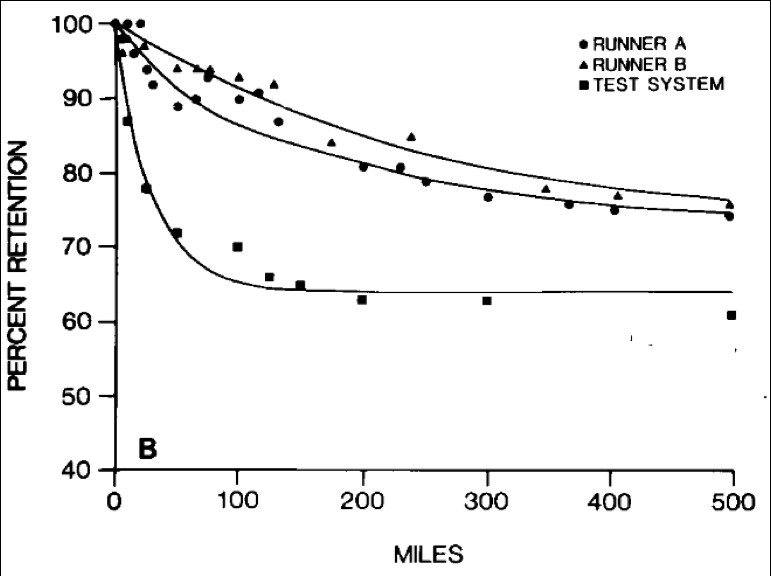
Fortunately, there’s some interesting new data in a study from researchers in Spain, led by Victor Rodrigo-Carranza of the University of Castilla-La Mancha. In the Scandinavian Journal of Medicine and Science in Sports, they compare shoes made with a modern super foam to a traditional EVA midsole before and after 280 miles, and find that the new midsole does indeed lose its magic more quickly—so much so, in fact, that the super shoe is no better than the regular shoe at that point.
Before digging into the specifics of the new study, it’s worth sketching in some context. The conventional wisdom that I’ve heard throughout my running life is that shoes typically last somewhere between 300 and 500 miles. This is based on some mix of cumulative experience and imperfect data, some of it published and some presumably locked away in shoe-company filing cabinets.
For example, there’s a 1985 study that measured shock absorption at frequent intervals between 0 and 500 miles, using a machine to simulate the impacts of running as well as two volunteers who racked up 500 real-life miles. Here’s an example of how shock absorption changed with mileage for one particular shoe:
The machine version of running obviously didn’t replicate the demands of in-person running very well, but the two human volunteers show similar patterns. Overall, the human testing found that shoes retained about 80 percent of the shock absorption after 150 miles, and 70 percent after 500 miles. You can see that the curve flattens out between about 300 and 500 miles, which is presumably where the conventional wisdom on shoe lifespan comes from. Conversely, you could argue that once you’re past 300 miles, the shock absorption isn’t going to drop much further, so if you’ve made it that far you might as well keep running in them until they (or you) fall apart. More on that below.
You might wonder whether shock absorption, as measured by a hydraulic machine, is really what matters to runners. More recent research has looked at other metrics: this 2020 study, for instance, used force-sensing insoles to measure the peak pressure on different parts of the foot, testing how it changed as a New Balance 738 shoe went from new, to 215 miles, to 430 miles. As the image below shows, the highest pressures are seen in the midfoot and forefoot:
Those pressures stayed virtually unchanged after 430 miles—but the midfoot peak pressure increased from 388 to 450 to 590 kilopascals, a 50 percent jump. It’s not clear exactly why the midfoot pressure increases. It could be that the relative lack of cushioning in the midfoot makes it less durable; it could be that the higher pressures on the rearfoot and forefoot break down the cushioning in those regions and shift load to the midfoot. Either way, it’s clear that the objective load on the foot has changed after 430 miles. And interestingly, the perceived cushioning reported by the volunteers picked up this change: those who reported feeling less cushioned in the midfoot in the worn shoes did indeed tend to have the highest peak midfoot pressures.
So the overall picture in the pre-super-shoe era was fairly muddy, but basically supported the view that shoes progressively lose their cushioning and reach bottom somewhere in that 300 to 500 mile range. Then came Nike’s Vaporfly in 2017, using a carbon fiber plate and a thick layer of cushioning to promise better running economy in exchange for a few hundred bucks—and, in the footnotes, less durability. The unsourced number that I frequently heard floating around after the Vaporfly’s release was that you should trust them for 100 miles or so.
It’s worth pausing here to say a few words about running shoe foams. Carlos Sánchez at RunRepeat has an impressive and exhaustive primer on the huge range of high-performance foams now on the market, which is worth digging into if you’re interested. A highly simplified history is that most running shoes used to use EVA (ethylene-vinyl acetate), then in 2013 Adidas’s Boost made TPU (thermoplastic polyurethane) popular, and then in 2017 Nike’s Vaporfly made PEBA (polyether block amide) the state-of-the-art. One study found that energy return was 66 percent for EVA, 76 percent for TPU, and 87 percent for PEBA.
While there’s been plenty of chatter about carbon-fiber plates, the weight of evidence is increasingly that most of the magic in super shoes comes from the foams. Unfortunately, the very property that makes them so good—their ethereal lightness—also makes them less durable. Of the more than three-dozen modern foams that Sánchez reviews, the main differences arise from the tweaks manufacturers make to trade off performance and longevity (along with price, of course). That makes it hard to issue general guidance about how long super shoes last: it depends on the shoe and the foam.
Still, one data point is better than zero, which brings us back to Rodrigo-Carranza’s study. The shoes he used were special prototypes manufactured for the study by On, almost identical except that one set had an EVA midsole while the other had a PEBA midsole. Both versions had a curved carbon-fiber plate. Twenty-two volunteers performed a running economy test to measure how much energy they burned at a given pace, once in fresh shoes and once in pre-worn shoes. (The researchers themselves ran exactly 280 miles in each pair of shoes to pre-wear them.)
One key finding: energy consumption in the new PEBA shoe was 1.8 percent lower than in the new EVA shoe. That bolsters the case that the foam itself is a big part of the magic, since both shoes had carbon fiber plates. (Not all PEBA foams are created equal, so we don’t know if On’s foam is as good as Nike’s ZoomX.) The other key finding: after 280 miles, there was no significant difference between the two shoes. The EVA shoe didn’t lose anything at all, whereas the PEBA shoe got 2.2 percent worse.
It’s not worth making any grand extrapolations from a single datapoint about when one type of shoe gets better than the other. Who knows what happens after 280 miles? For that matter, who knows what happened after 26 miles? Moreover, there are lots of other factors that might be relevant. One of the interesting claims in Sánchez’s review is that super foams maintain their properties even in frigid winter conditions, while EVA-based foams get much more rigid. In some shoes, firmness more than doubled after Sánchez’s freezer test. Maybe a worn-out super shoe is still a better bet than a newer EVA shoe for those of us who are latitudinally challenged. He also notes that shoe foams take more than 24 hours to recover from a run, and some recover faster than others, so it makes sense to alternate different pairs in order to maximize both comfort and shoe lifetime.
My own approach to shoe durability is, admittedly, not one that’s easy to generalize. I generally have two or three pairs on the go at any given time, and I run in them until they start to feel flat. It’s a noticeable sensation, especially if one of the other pairs in my rotation is relatively new and bouncy. Then, in the spirit of that graph above showing a plateau after about 300 miles, I keep running in them—but I pay more attention to how I feel during and after runs, and to whether the wear on the outer sole is changing the angle of my footstrike. Once I start to feel a few aches and pains, I retire the flat shoe. That approach works pretty well to keep me healthy, but the new data suggests that it’s probably not maximizing my performance. Anyone want to buy a pair of gently used six-year-old OG Vaporflys?
Login to leave a comment
U.S. Secretary of Transportation Pete Buttigieg Treasures Time on His Feet
He has toddler twins and a very big job, but the cabinet member makes running a priority.
When you’re a “transportation guy,” as Pete Buttigieg calls himself, there’s no better place to run than Gravelly Point Park, in Arlington, Virginia, under the flight path of planes on final approach at Reagan Washington National Airport.
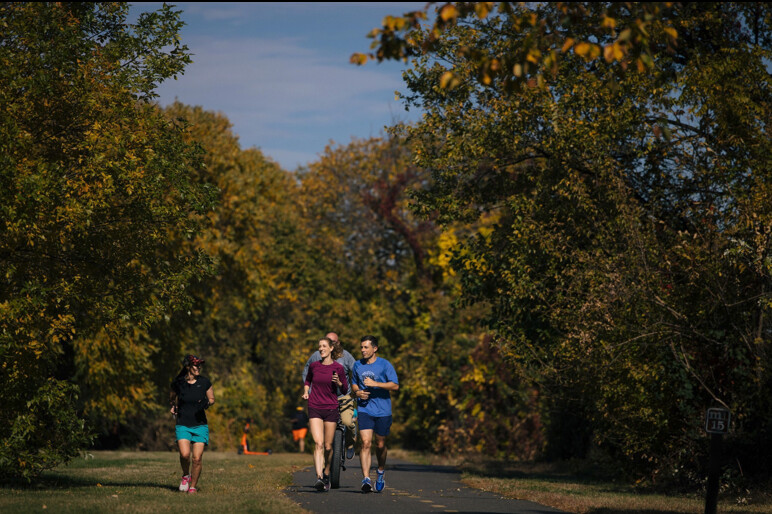
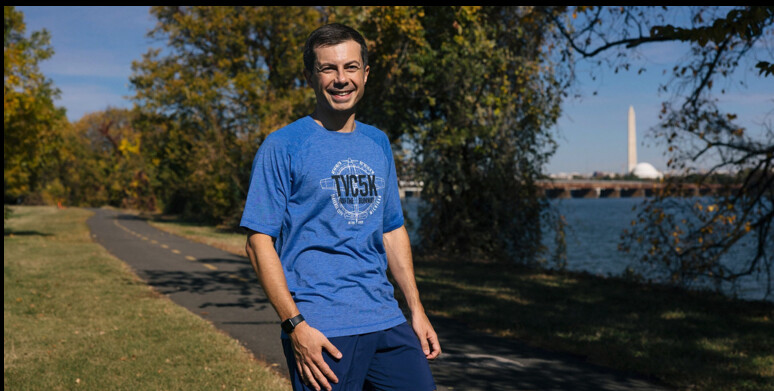
“It feels as though the planes are trying to land right between your eyes, and then you watch them go over your head,” said Buttigieg, the 41-year-old U.S. Secretary of Transportation. “It’s just really fun and motivating.”
Buttigieg—who in 2021 was sworn in as the youngest member of President Biden’s Cabinet—is (with all respect due to a government leader) a bit of a dork when it comes to planes.
“There it is!” he said, as a United Airbus passed close overhead. “You hear that swizzling noise in the air? That’s wake turbulence!”
“Turbulent” is a word Buttigieg uses regularly, although his political career has been mostly smooth sailing. In 2011, he was elected mayor of his hometown of South Bend, Indiana. Eight years later, he entered the Democratic presidential race as a longshot candidate and won the Iowa caucuses. He ended his bid in March 2020 and endorsed the man who’s now his boss, Joe Biden.
Recently Buttigieg squeezed a midmorning run with this reporter into a typically hectic day at the helm of a 53,000-employee department: getting his two-year-old twins fed, dressed, and off to daycare; meeting with the German minister of transportation; welcoming the newly confirmed FAA administrator to his post; meeting with colleagues at the Commerce Department; talking permitting processes at the White House; and then attending a state dinner for the Prime Minister of Australia. Wardrobe requirements included a suit, running clothes, and a tuxedo.
On days like that, running is a source of satisfaction and stress relief. As a cabinet secretary, Buttigieg is required to train with security; his detail trails behind him on a bike while he runs, or waits by the water’s edge while he swims. (When members of Buttigieg’s open-water swimming group tried to correct a hitch in the Secretary’s stroke, his security team protested, “Don’t fix that! It’s the only way we know which one is him!”)
For Buttigieg, knowing Secret Service members’ jobs revolve around his workout schedule is the ultimate in accountability. “It’s definitely kept me from hitting the snooze button more than once,” he said.
Apart from this interview, conducted at sub-10-minute-mile pace, and the occasional bit of bipartisan “jogging diplomacy,” as he calls runs with members of Congress, Buttigieg tends not to mix work with training. He runs about five days a week, usually early in the morning, when most people are too focused on their own workouts to recognize him.
“I get spotted a little bit, but not enough to disrupt my training,” Buttigieg said. “Once in a while somebody wants to take a selfie when I’m mid-run, and I’m never sure how to handle that. Usually I just do it.”
Humble run beginnings
As a teenager, Buttigieg did not take to running naturally.
“It’s difficult to overstate how unathletic I was,” said Buttigieg, who joined the track and cross-country teams at St. Joseph’s High School in South Bend. “I was the kid who was so far behind at a cross-country meet that I might take a wrong turn because there was nobody left on the course. So it meant a lot to me, years later, when I got to be speedier.”
His progression from back-of-the-packer to one of the fittest members of the executive branch took years. As an undergrad at Harvard, Buttigieg would run on the treadmill or along the Charles River, but never more than three to four miles. At Oxford, where he was a Rhodes Scholar, Buttigieg added rowing to his endurance repertoire. By his mid 20s, running had become a “comfortable habit”—and a gratifying one.
“There’s a level of coordination that I may never have to be good at basketball,” he said. “But running—the more you do it, the more rewarding it becomes.”
When Buttigieg joined the U.S. Naval Reserve in 2009, he excelled at the 1.5-mile run that was part of the requisite fitness test, getting close to a perfect score of 9 minutes flat.
“For a while I was the fastest guy in my unit, which felt great because I was always the slowest guy in my high school,” he said.
In 2014, during a seven-month deployment as a counterintelligence officer in Afghanistan, Buttigieg ran a half marathon at the U.S. base in Bagram. In addition to the typical instructions about course markers and fluid stations, the pre-race briefing included warnings to participants about the potential for rocket attacks. He ran his current PR of 1:42.
A triathlon two years in the making
Buttigieg continued to run throughout his mayorship of South Bend and his 2019–20 presidential run. In 2021, his first year as transportation secretary, he was training for a half-Ironman in Michigan when he and husband, Chasten, adopted premature newborn twins, Penelope and Gus. Suddenly, instead of miles, Buttigieg was counting ounces of formula. Long training runs were scrapped during sleepless nights and Gus’s hospitalization with RSV.
It took until this year before Buttigieg could try another tri. Preparing for a half-Ironman (1.2-mile swim, 56-mile bike, 13.1-mile run) is a major undertaking for anyone. But when you’ve got 2-year-olds, Buttigieg said, “physically redirecting and restraining them is a huge part of parenting.” He followed a 16-week training plan he got online and relied on Chasten to hold down the fort with their kids on weekend mornings while he did long runs or four-hour bike rides.
“I would try to make up for it later in the day, but there’s no way I could’ve done this without Chasten being very supportive,” Buttigieg said. “While there’s an ethos of self-discovery and self-reliance in endurance sports, it really does bring out how dependent you can be on others to support you.”
During the race, held in mid-September in Michigan, Chasten and the kids hung out at a nearby playground—“we were playing with fire when it came to naptime”—and were at the finish line when “Papa” crossed in 6 hours and 31 minutes, largely on the strength of a 2:05 half marathon leg.
“It was pretty thrilling, although there was a fair amount of pain,” Buttigieg said. “But the kids really got into it, and that’s part of why you do this, to be in good health for the people you love.”
Buttigieg said he was wrecked for a couple of days post-race, but he now hopes to take his fitness out for an occasional spin—perhaps a run at a half marathon PR. But he won’t undertake another 6-hour race anytime soon.
“I don’t think I can do something this time intensive again while I’ve got this job,” he said. “It’s too much to ask of Chasten.”
A runner’s perspective on infrastructure
After he averaged about 25 miles per week during his triathlon buildup, now it’s back to shorter workouts for Buttigieg. And with more than 100 miles of traffic-separated pathways up and down the Potomac, the nation’s capital is an endurance athlete’s paradise. “There are few better places to run in the whole world, I would argue,” he said.
The Washington area represents the kind of well-connected, accessible and pedestrian-friendly infrastructure the Department of Transportation wants to build more of through its National Roadway Safety program. For Buttigieg, helping communities around the country build separate paths for running and biking is about a population’s safety as much as its fitness.
“I worry sometimes that a path like this is viewed as purely ornamental,” he said. “I would argue that the recreational case is pretty compelling, but also fundamentally, safety is on the line. The very layout of our roads can either incentivize or discourage active transportation, and they can either make it safer or more dangerous.”
Buttigieg formed a new perspective on road design in 2016, when he was part of a group of U.S. mayors who traveled to Denmark. Buttigieg saw 1970s-era photos of Copenhagen, which now rivals Amsterdam for highest rate of bike commuting, and recognized the look of a lot of car-dependent American cities.
“That’s when the lightbulb went off,” he said. “It’s not some immutable Nordic cultural characteristic that changed things. It was some conscious decisions made by planners to make it more attractive and safer. By doing that, they reduced congestion, they reduced pollution, and over the long run, they increased safety.”
Buttigieg has a lot of priorities beyond encouraging active transportation. He wants to train more air traffic controllers. Strengthen HazMat requirements for railroads. Build more roads and bridges. Budget cuts or a government shutdown would make it harder to accomplish those projects.
When political roadblocks lead to frustration, he works through it with exercise. He is a transportation secretary who gets to where he needs to be, psychologically and physically, by putting one foot in front of the other.
“Especially in the early morning when the dawn’s just breaking over the river here, it’s hard not to feel even in our troubled Washington that there’s some magnificence to our nation’s capital,” Buttigieg said. “You count your blessings after a run, if not always during one.”
by Runner’s World
Login to leave a comment
30 Hours at Javelina Jundred, the Burning Man of Trail Running
Inside the spectacle of ultrarunning’s most festive top-tier 100-mile race
It’s a hot, sunny Saturday afternoon in the desert northeast of Phoenix, and Lindsay DesRochers is being chased by a dinosaur—as if 85-degree heat, a creaky left knee, and a hot spot on her right big toe aren’t enough to worry about during her first attempt at running 100 miles.
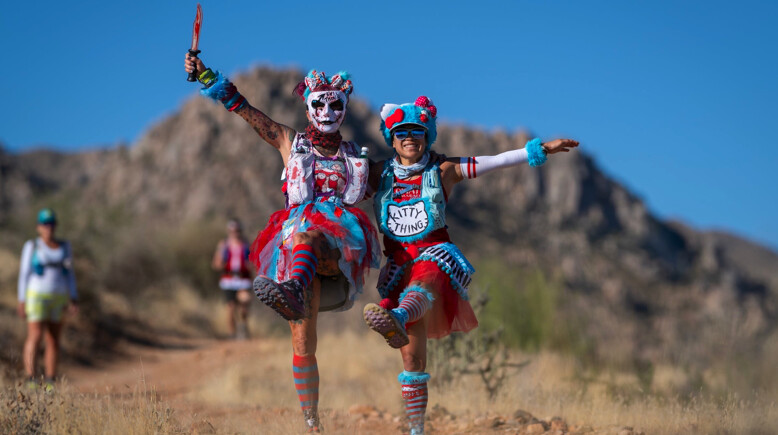
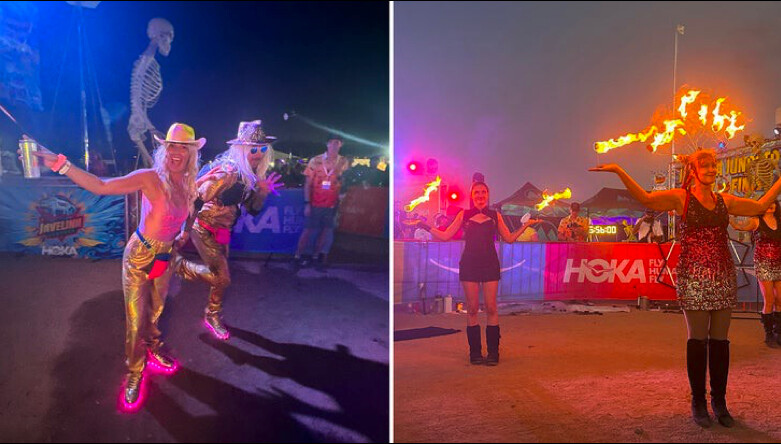
The 44-year-old senior creative recruiter from Scottsdale is 41 miles into the Javelina Jundred, and she also has to contend with a Tyrannosaurus rex who’s making her giggle. The dinosaur is, in fact, local trail running legend, Jerry Bloom, who is sweating and gasping for air inside an inflatable costume that’s kept afloat with a tiny battery-operated fan. He is dressed up as the dino-in-residence and runs alongside DesRochers briefly as she finishes the second loop of the five-lap course before sitting down to refuel and rehydrate in her crew tent.
“The problem with this thing isn’t the heat. It’s just that there’s no oxygen in here. If you run very far, you get oxygen deprivation,” says Bloom, 70, a three-time Western States and Hardrock 100 finisher who’s also run Javelina twice. “For me it’s all in good fun to support Lindsay. I’ve given up trying to be fast a long time ago. But what I’ve learned is that it’s not how far you go and it’s not how fast you go, it’s how you look while you’re doing it.”
Welcome to the Javelina Jundred—the biggest, wildest party in the trail running world.
It’s pretty obvious that the Javelina Jundred is the zaniest event in trail running and, to be frank, nothing even comes close to this dusty desert cavalcade of curiosities. It’s not quite the Burning Man of running, but it might just be better because, first and foremost, it’s a legit ultrarunning event.
More than 850 enthusiastic runners toed the starting line at 6 A.M. to begin the five-lap 100-miler, and about 400 more began the three-lap 100K an hour later. There’s also a single-loop, 19-mile nighttime race called the Jackass Night Trail for about 200 runners that includes a wild DJ’ed party at the Jackass Junction aid station and finishes as the Saturday night revelry is still going strong back at the race compound.
But because Javelina always happens on the weekend before Halloween, there’s a natural party vibe and a non-mandatory-yet-compelling reason for runners, pacers, and support crew to wear costumes. And, let’s face it, Halloween gives everyone license to fly their freak flag, so when you mix that with ultrarunning, just about anything goes. Only here it’s known as Jalloween.
This year’s most popular dress-up themes seem to be tropical and western, but, almost predictably, there are quite a few Barbie and Taylor Swift cosplayers, as well as a few heavy metal rock stars, glow-in-the-dark skeletons, and several very creepy clowns. Dozens more runners race through the desert wearing bunny ears, fox tails, and devil horns.
“This is a safe space for everyone to have fun in their own unique way,” adds Dan Gampon, a Hoka sports marketing representative from Hawaii. “It’s a fun way to give the people a chance to be weird and bring a part of themselves that they might have been wanting to bring out, and give them the opportunity just to have fun anyway they want to.”
Some crew tents are decorated with accouterments to match a particular theme, but most feature colorful holiday twinkle lights, camping chairs, sleeping bags, and coolers full of adult beverages. While there’s a stash of fancy engineered nutrition supplements and electrolyte drinks in every tent, there’s also the widest range of healthy and not-so-healthy snack food you can imagine. (I’m looking at you, guy simultaneously drinking a Red Bull and eating a handful of marshmallow Peeps.)
The Javelina staff and volunteers are fully into the Jalloween theme, too, especially race director Jubilee Paige, who dons several costumes during the 30-hour event—including getups she calls Race Director Barbie, Weird Barbie, The Dude, Cousin Eddie, Chef’s Kiss, and A Macaroni Penguin. She once again ends the event dressed as the Pope—a.k.a., “her Joliness”—because she considers Sunday “Jallelujah Javelina,” a day of celebration.
The Javelina Jundred was founded in 2003 by Phoenix ultrarunner Geri Kilgariff as an irreverent, party-oriented run on a multi-loop course, and gradually gained regional and then national popularity as word spread through the ultrarunning community about how much fun it was. Local ultrarunner Jamil Coury took over as race director in 2008. The next year he started Aravaipa Running, a Phoenix-based company that bought and now owns 75 other running events in Arizona, Colorado, Utah, Nevada, and New Hampshire.
Despite increased popularity and significant growth, Coury, Paige, and the rest of the Aravaipa crew have been able to maintain Javelina’s grassroots experience while growing it to about 1,500 runners in three events with at least that many pacers, crew, and family members hanging around the race compound. In many ways, it represents the best of both where trail running has been, but also where it could be heading.
“The race was born from a fun spirit of running with friends and looping in the desert—shout-out to Geri Kilgariff for her creation of the event in 2003,” Paige says. “But as it’s evolved, we saw opportunities to elevate the race to an ‘event’ experience for runners and crews—an ultra festival—the music and lights and entertainment just enhances that experience. However you experience Javelina, I just want you to have fun!”
As the sun begins to set, several top competitors in the 100-miler are scattered out on the remote sections of the course in hot pursuit of four Golden Ticket entries into next summer’s Western States 100. (Two tickets each for the men’s and women’s races.) That includes Boulder, Colorado, runner Jonathan Rea, who is back after a second-place finish a year ago, and—with newfound confidence from a fourth-place finish at the CCC 100K in Chamonix, France—is tearing up the desert trails on course-record pace. Triathlete-turned-ultrarunner Heather Jackson, who splits time between Bend, Oregon, and Tucson, Arizona, also takes it out hot, hoping to make up for a frustrating fifth-lap fade last year after unbearable quad pain reduced her to a walk and forced her to settle for a fifth-place finish in her 100-mile debut.
Earlier in the day, Denver’s Rajpaul Pannu and San Francisco’s Anna Kacius made quick work of the less-competitive, three-lap 100K race, finishing first and second overall, respectively, and setting new men’s (7:15:53) and women’s (8:13:07) course records in the process, while winning by more than an hour over their nearest competitors.
Ultrarunning GOAT Courtney Dauwalter from Leadville, Colorado, is out there, too, but she’s not racing for the win. She’s running the 100K with her mom, Tracy, a 66-year-old avid trail runner from Edina, Minnesota. They attempted a 50-miler in Minnesota last fall, but were timed out before the finish, so this year they chose the big party race in the desert where Courtney set a course record in 2016 before she became a household name. They’re not in costumes, but they’re running as Team Bucket List and wearing matching white shirts, cactus-themed socks, and olive-green-and-black shorts.
Because runners constantly revolve through the turnaround point at the start/finish area, everyone else is always on the move throughout the race compound. Some are drinking craft beers and mingling as they wait for their runners, while others are watching the race livestream on their phones or from the jumbotron in the Javelina Jeadquarters circus tent. Still others are devouring freshly cooked artisan pizzas made to order in the Freak Brothers Pizza mobile brick wood-fired oven.
Rousing cheers and applause catch everyone’s attention every few moments as an elite runner arrives—including the ever-smiling Jackson, who quickly heads out on her fifth and final lap with a 30-minute lead in the women’s 100-miler.
“Heather is just amazing,” says Troy Brown, 48, a trail runner from Coto de Caza, California. “She’s always smiling. I’m just a fanboy, but I like anyone who can smile that much through pain.”
After Jackson runs out of sight, Brown quickly shifts his focus to getting his feet into an inflatable T-Rex costume so he can participate in the costume contest, an informal event that brings out a sheriff riding an inflatable rooster, Minnie Mouse, a foursome of Teletubbies and, of course, several dinosaurs. There’s also a guy dressed as Aladdin wearing a large golden lamp around his waist who is joined by a scantily clad Jasmine character who not-so-discreetly rubs the lamp in a Not Suitable for Work (NSFW) scene that draws both raucous laughs and shocked gasps from the crowd.
One of the best dressed-up groups of the event is a foursome of women from California’s Healdsburg Running Company: Dominique Chevalier (“Western Barbie”), Krista Kappus (“Alien Barbie”), Saddie Alloway (“Rootin’ Tootin’ Diva Barbie”), and Susan Oh (“Disco Bob Ross”). But the costume contest winners are the Montana Mermaids, a bikini-and-grass-skirt trio from Bozeman—Lena Romeo, Kara Haskell, and Liv Bleskin—who were there to crew and support elite runners Rachael Norfleet of Montana in the 100K and Utah’s Ryan Montgomery in the 100-miler.
The sun begins to set, but the party’s just getting started as DJ Colter Stillwell pumps tracks through the sound system as a full moon rises in the eastern sky. One of the rowdiest dancers is Brendan O’Hara, a Colorado trail runner who’s dressed up in a red-and-white mouse outfit with flashing lights similar to what popular Canadian electronic musician Deadmau5 wears on stage. As lots of energized runners entered in the Jackass race are about to head out into the night, two professional fire dancers perform a mesmerizing routine adjacent to the start line.
Just after dark, Rea comes flying into the finish area, stopping just short of the finish line to pantomime deadlifting a colossal barbell before crossing the line in a new course record of 12:43:10. Seattle runner Blake Slattengren stopped the clock next in 12:58:07 to claim the second Golden Ticket, while Montgomery ran another strong race to take the final podium spot in 13:01:14.
Redeeming herself from last year, Jackson finishes strong to win the women’s race and finish sixth overall, thanks in part to the aggressive pacing of Devon Yanko. Jackson’s time of 14:24:47 is the second-fastest women’s time ever behind Camille Herron’s 14:03:23 course record from 2021. Spain’s Ragna Debats (14:55:27) outran Riley Brady (15:29:17) to earn the second women’s Golden Ticket.
Not long after midnight, the Dauwalters finish, too. Covered in dust, sweat, and even a little bit of blood—Tracy took a tumble on the first lap early the previous morning—they cross the finish line after 17 hours of running with big smiles and hug in a classic mother-daughter moment. Late Sunday morning, DesRochers makes it to the finish line, too, in 27:31:41, battling hard to overcome dehydration, an upset stomach, and nagging hip flexor pain at various points during the race.
“I was prepared for it to be hard, and I knew I was going to hurt. At some point, I was like, Oh, right, this is what running 100 miles feels like,” DesRochers says. “It was difficult, but I kept my positive mental attitude the whole way. I have a buddy who has a saying, ‘Forward is a pace,’ so I kept repeating that and kept putting one foot in front of the other and I didn’t quit.”
Something that’s especially apparent at Javelina is that everyone is celebrated as an equal, regardless of finishing times, trail running experience, athletic ability, age, or any other dissimilar details. The event goes out of its way to create an environment that promotes visibility and inclusion for everyone, and the community of participants seems to embrace it by cheering and encouraging for everyone the same.
It has partnered with Native Women Running, Latinos Run, and Black Men Run each of the past several years to bring their runners to the race, and it was also one of the first ultra events to offer a non-binary category. This year there were six non-binary runners racing over its three races, led by Willow Dolde in the 100-miler (20:01:29), Andreas Anderson in the 100K (13:54:30), and Tasha Hartwig in the Jackass 31K (6:42:07). (Although Brady, a non-binary runner from Boulder, was competing in the women’s division because they were racing for a Golden Ticket, they were also, unofficially, the top non-binary runner in the race.)
As the golden hour comes and goes early Sunday afternoon—and final finishers Holly Sitzmann, Jim Buckley, Brittany Edmiston, and Leslie Astle squeeze under the 30-hour cutoff with help from their pacers and crew—it’s clear that everyone at Javelina is celebrated equally and enthusiastically. That also includes two unofficial finishers—Rayna Rodriguez and Tatiana Orozco—who complete the 100-mile course just outside of the time cutoff, but are welcomed by a scream tunnel of remaining spectators and the adulation of Paige even though neither will receive a finisher’s buckle.
“Javelina is a celebration, and the invitation to run and participate at Javelina extends to everyone,” Paige says. “I want to ultimately show how amazing the community is and that this sport is for everybody and every body—the spirit of ultra is diverse and should be celebrated.”
by Outside online
Login to leave a comment
Want to Win a Race With No End? Work on Your Poker Face.
Harvey Lewis, who recently ran 450 miles to win Big’s Backyard Ultra, discusses the mental trickery that goes on during ultrarunning’s hardest race
Not many people can run 400 consecutive miles and still stand upright—fewer can complete this athletic feat and continue running. I think there’s just one person alive who could do it and then unleash a sprint that would make Usain Bolt proud. That’s Harvey Lewis, the newly crowned world champion for the niche sport of Backyard Ultrarunning.

Lewis, 47, won his title at the October 21 Big Dog’s Backyard Ultra in Tennessee—the race known simply as “Big’s” in ultrarunning parlance—by running 450 miles over the course of 108 hours. Lewis is also the star of the hilarious video below (credit to UltraRunning.com) which made the rounds on social media as the race was still going on. Give it a watch.
Some quick context: the clip was captured a the race’s 400-mile mark (yes, 400!), and the eight runners in it have been jogging around a 4.1667-mile loop every hour for four consecutive days. When the starting bell sounds, seven of the eight shuffle onto the course looking like extras from The Walking Dead. And then there’s Lewis, who cracks a grin, kicks up his heels, and Usain Bolts away. He looks like he’s having a blast.
As it turns out, he was. “I’m really fired up in that video,” Lewis recently told me. “There are times during races when I have to hype myself up, but not there. I am already so hyped up, just mentally and physically. That’s what you have to do to keep yourself in the game.”
The game that Lewis is referring to is the strategy—nay, the psychological warfare—that goes on during one of these grueling races. At Big’s and other backyard ultras, participants run around a 4.167-mile loop every hour, hour after hour, for days on end (the distance means they complete 100 miles every day). They start and finish in the same location, and can rest or eat or use the toilet in the time between each lap, which is never long enough for them to sleep for more than a minute or two. As the event goes on, participants drop out due to sleep deprivation or blisters or diarrhea or because their brains simply cannot fathom any more running. The winner is the final person left standing.
This twisted format was dreamed up by Gary Cantrell—known as “Lazarus Lake”—the designer of the infamous Barkley Marathons. Backyard ultras foster some unorthodox head games amongst the handful of elite runners. At some point, they become hardcore body-language analysts, eyeing each for signs of injury or exhaustion. Simultaneously, they mask their own ailments in an attempt to convince their peers that they are feeling just fine and dandy—even thought every one of their muscles throbs with pain.
“There’s a lot of poker faces out there,” Lewis says “If one of the competitors starts to show weakness, it just adds thunder to everyone else. Part of the game is showing that you’re strong.”
There are plenty of telltale signs that a runner is nearing the end: limping, wincing, sitting down. Some athletes, after running hundreds of miles, begin to list to one side like a torpedoed warship. Oftentimes, runners nearing the limit will finish each lap just a few seconds before the next one is to begin—the countdown is marked by three whistles and then a bell.
There are also all manners of tricks for covering up the pain. Lewis said that his toughest competitor at Big’s, Ihor Verys of Ukraine, maintained a stoic and expressionless demeanor—think Ivan Drago from Rocky IV—right until the moment he dropped out at mile 445. Dutch ultrarunner Merijn Geerts, who dropped at mile 417, told the Bad Boy Running podcast that he will purposely start a race looking disheveled so that competitors cannot notice a meaningful change in his appearance as the event goes on. “If someone looks very fresh from the beginning, and suddenly he doesn’t look fresh anymore, you know there is a problem,” Geerts said. “If you don’t look very [fresh] all the time, then your opponent doesn’t know you are suffering.”
Fibbing is another formidable tactic. As Big’s stretched past the two-day mark, Lewis heard some competitors respond truthfully to a familiar question that runners ask one another on the trail: how are you feeling? “I was surprised to hear people saying ‘I was hallucinating’ or ‘I have a blister on my foot,‘” Lewis said. “Loose lips sink ships.” Lewis, who teaches U.S. government at a high school in Cinncinatti, Ohio, told me that he’d never divulge his aches and pains to a competitor.
“I don’t know why anyone would ask me how I feel during a race,” he says. “I could have blood pouring out of my head and I’d still say, ‘I feel amazing!’”
And then there’s the whole sprinting thing. Running fast is absolutely a psychological flex—a way to show the competition that you are supremely confident and also feeling fantastic. Think of it as the backyard ultra version of Steph Curry’s highly-intimidating pregame warmup. Lewis’s mad dashes were an integral weapon in his psychological war chest, he said, and he sprinted out of the gate again and again during Big’s.
“It’s like here we are at mile 400 and I can just go man,” Lewis says.
Here he is starting mile 300.
Here he goes at mile 425, looking considerably less spry.
But the sprinting tactic can also backfire, because a sprint puts more strain on leg muscles than a steady jog. In June, Lewis participated in Australia’s Dead Cow Gulley Backyard Ultra, and after two days of racing he employed the sprinting tactic. But the maneuver began to wear his body down, and he dropped out at mile 375 with two competitors remaining.
“I did it way too much and got carried away feeling invincible and not reigning myself in,” Lewis admits. “Because the counter to it is to just run your own race.”
At Big’s, Lewis only sprinted at the start—he actually didn’t complete the loops fastest, and during many laps he finished several minutes behind Bartosz Fudali of Poland, who exited the race after completing 429 miles. For all of the psychological gamesmanship that goes on in a backyard ultra, Lewis said there’s really no way to overcome a runner who has a steady rhythm, an expert nutrition plan, and the steely attitude to keep going—no matter what. Lewis said his winning tactic was more about mindset than about mind games.
“I don’t care what distance anyone else goes—I’m just going to commit to going further,” he says.
by Outside Online
Login to leave a comment
This Ultramarathoner Runs With Her 5 Golden Retrievers and Shares Her Tips for Clocking Miles With Canines
With five golden retrievers of her own, Golbeck is the dog whisperer you didn’t know you needed.
I am not one of those people who has a love/hate relationship with running. I love it purely and wholly. It feels like my body was made to do it. I love being outside and moving, and the rush of endorphins is great. If I could run all day, I would.
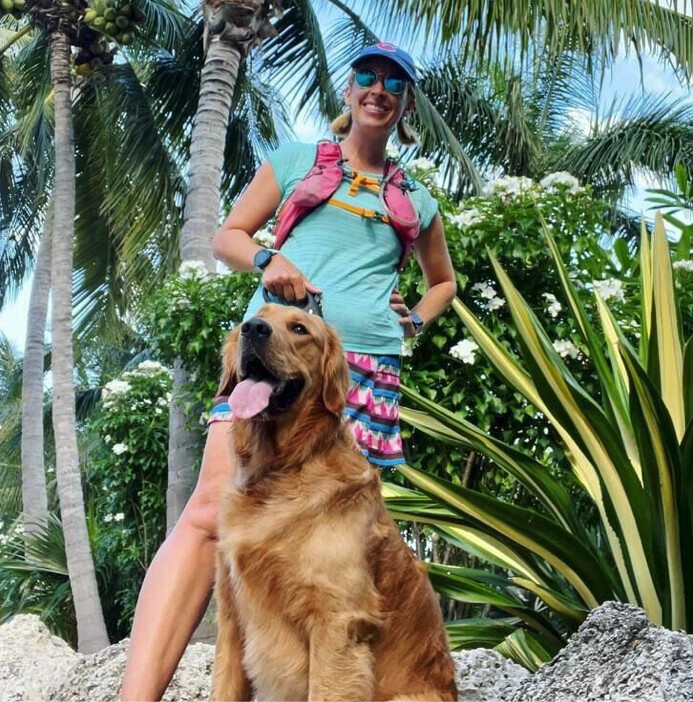
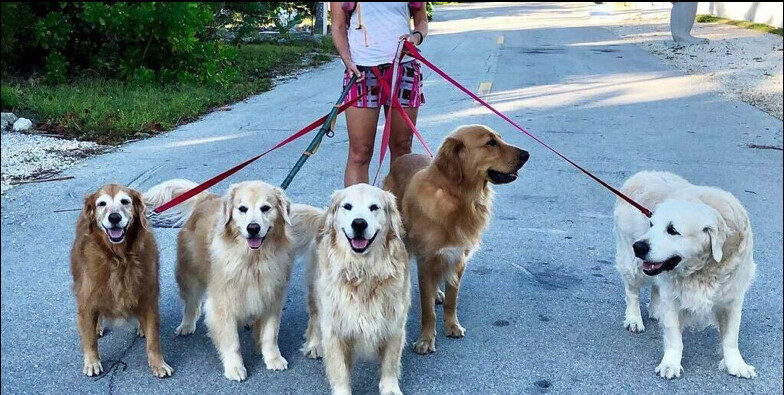
I started running ultramarathons to give myself permission to run forever, and found that even after running 100 miles or for 31 hours, I love it.
Like all runners, though, I have days when it’s hard to get out the door. Sometimes I’m tired, and I waste hours procrastinating when it’s cold and rainy out. Fortunately, though, I have five golden retrievers and they always need walks. Even in bad weather, one will run over with enthusiasm and joy, stretching their neck toward the collar. In those cases, to delay my run would be to deny them happiness, so suddenly it’s easy to go outside.
While I can walk five dogs at once—that’s me in the top picture with Swizzle, Venkman, Hopper, Guacamole, and Chief Brody—I never run with them all together nor do I do ultra distances with them!
While I have run with two dogs at once, it’s safest to run with just one, because when I do take two, we stop more often, and they inevitably get tangled. Then my focus becomes more on dog management than running.
In The Purest Bond: Understanding the Human-Canine Connection, Stacey Colino and I explore the science behind how relationships with dogs make human lives better. Certainly, dogs help humans move more and form better relationships in their communities. Science also shows that dogs enjoy running with us, both because of how it makes them feel physically and because they get to spend time with us.
One of my favorite workouts is to take each dog out for one or two miles until everyone who wants a run has had a chance to go out.
I’ve learned a lot about running with dogs over the years, so I’m sharing my tips for how to run safely and successfully with your own four-legged friends.
5 Tips to Better Running With Your Dog
If you want to start running with your dog, start by telling your veterinarian how far and fast you run, so they can give you specific information about your dog’s ability. Once you have the go ahead, follow these five tips to make your runs more enjoyable and safe—for both you and your pup.
1. Learn Leash Skills
When I was a graduate student, I tried to take my two golden retrievers, Pi and K, for a run. Suddenly, K spotted something exciting across the street, bolted, and pulled me off the sidewalk. I hobbled home with a sprained ankle.
To avoid unexpected accidents, work on your leash skills before you start running with your dog. Sure, a dog who pulls makes uphill runs easier, but a dog who bolts for squirrels or in traffic is a risk.
You’ll know your dog has solid leash skills if they run calmly alongside you with a loose leash, and you don’t have to pull to control them. They also should have enough self control to not dart out at animals or jump at sounds.
Your dog should also respond to commands such as “stop” or “wait,” and be able to respond to your speed, rather than you having to keep up or wait for them, especially if you want to run at a consistent pace.
If you have a scent dog, you may need to separate your runs from walks where they are able to follow their nose and go at their own pace. Habits like stopping to sniff can be managed with leash training.
My dog, Guacamole, a notorious stop-and-sniff dog, knows the difference between walks and runs, based on the way I hold the leash and, obviously, my speed. It’s like a form of non-verbal communication between the two of us. Guacamole understands that he is supposed to match my pace, whether I’m running or walking and he is able to adjust himself.
Good leash discipline is also useful when you encounter others on a trail.
2. Start With Short Runs
You won’t be surprised to learn that dogs are wired to run, according to research. Aside from having four legs, research shows that dogs also have an increase in endocannabinoids (eCBs) after a run. This is one of the main neurotransmitters believed to play a role in the runner’s high.
Of course, human runs and dog runs are very different. For example, while small dogs can be good running partners, toy breeds have to take a lot of steps to keep up with humans. Dedicated runners with dogs who may not be right for running can always consider using a jogging stroller to bring their pal along with them!
Some dogs may also be better walking partners. For example, dogs with smooshed faces (“brachycephalic”) or with short limbs, such as bulldogs and corgis, can have difficulty running and be at higher risk for injury. Again, check in with your dog’s vet for advice about how far, how fast, and how frequently your dog should run.
Natural runners, such as hounds, can still vary in the distances they prefer. My golden retrievers are comfortable with around three miles, but they are not built to be long-distance runners. Huskies, herding dogs (Australian shepherd, border collies, and others), and Vizslas are all good at going for distance.
All runners should follow the 10-percent rule for increasing their distance or intensity (an increase of no more than 10 percent each week) and this rule applies to dogs, too.
Remember, though, dogs can get the same overuse injuries as people. Be on the lookout for new limps, tenderness, or hesitation, which may indicate your dog is exceeding their abilities.
3. Learn Your Dog‘s Fuel and Hydration Needs
You need water on a run that’s over a couple of miles, and your dog does, too. Consider hydration for them, too, which means carrying at least a collapsible bowl and adding enough water to your supply to share.
If you have a breed that runs long distances, bring food, such as biscuits or treats, so they can stay fueled, too. If you’re going for a long run and don’t feel like carrying your dog’s supplies, you can find harnesses with pockets so your dog can carry their own food and water (and poop bags!), which will lighten your load.
Just like humans, my dogs are often hungrier on days that they run, so I take cues from them if they need more food. It can be a little tough to tease out when they are actually hungry because of the extra activity versus their normal habit of begging for extra food, but with attention, I have learned to tell the difference. When my dogs go to the kitchen after dinner looking for snacks or extra food or if the beg more aggressively for my food, it suggests to me that I need to feed them more.
If your dog pants hard for a very long time with a bit elongated tongue or they are more lethargic than usual after a run, it may be a sign that you went too far. Watch their recovery just as you should pay attention to your own.
4. Understand the Way Weather Affects Animals
Your dog may not need as much gear as you do, but it’s important to prepare for different weather conditions.
In hot weather, be sure to check the heat of the pavement. If it feels hot to your touch, it can burn your dog’s paws. In the Florida Keys where I live, I only take my dogs for nighttime runs during hot months.
If you live somewhere cold, your dog’s paws could literally freeze to the pavement. Plus, snow may form ice balls inside their paws, and the salt used to prevent icing on sidewalks can irritate their pads. An affordable and effective solution for snow and trail running are sled dog booties, used by mushers and their dog sled teams. For road running, you can also find options with a tougher sole.
Also, pay attention to your dog’s response to the weather. Even in mild weather, dogs can get overheated on a run. Usually, they will show this with excessive panting or by simply lying down and refusing to continue. It is crucial to give them a break in these situations, even if it means gently walking home and cutting your run short.
5. Get Them Safety Gear
In 2022, we fostered a dog named Nacho for six months. He was a very energetic 18-month-old golden retriever who needed a lot of exercise. I earned two visits to the orthopedic surgeon—once for a sprained shoulder and one for a damaged finger tendon—from those runs.
Not only had we not mastered leash skills, but I also had the wrong equipment. After those doctor visits, I switched to a waist leash so I could use my whole bodyweight to control him. You will typically weigh more than your dog, so these leashes may help you control their movement. However, some dogs are stronger than their owners, and it can be hard to balance when they pull you by the waist. So test out a waist leash on a shorter distance before you go long and see how it feels.
The scariest moments I have had with dogs is when they pulled the leash out of my hands and got away from me in the dark. In addition to the waist leash, which you can’t drop, I use LED collars at night.
You can buy plastic loops and collars with embedded rechargeable LEDs, or flashing tags for their normal collars. All of these gadgets give you a visual cue about where your dog is. They also make your dog—and you!—visible to traffic and to other people.
by Runner’s World
Login to leave a comment
Australian ultrarunner makes history by racing UTMB and Ironman World champs
Ultrarunner Lucy Bartholomew made running and triathlon history on Sunday, becoming only the second woman ever to finish the 171-kilometre Ultra-Trail du Mont-Blanc (UTMB) as well as the Ironman World Championships in the same year.
Bartholomew ran remarkably well at both events, taking a tenth-place finish at UTMB in 27:39:22, and completing what was only her second Ironman in 10:43:41, with a 3:31 marathon time.
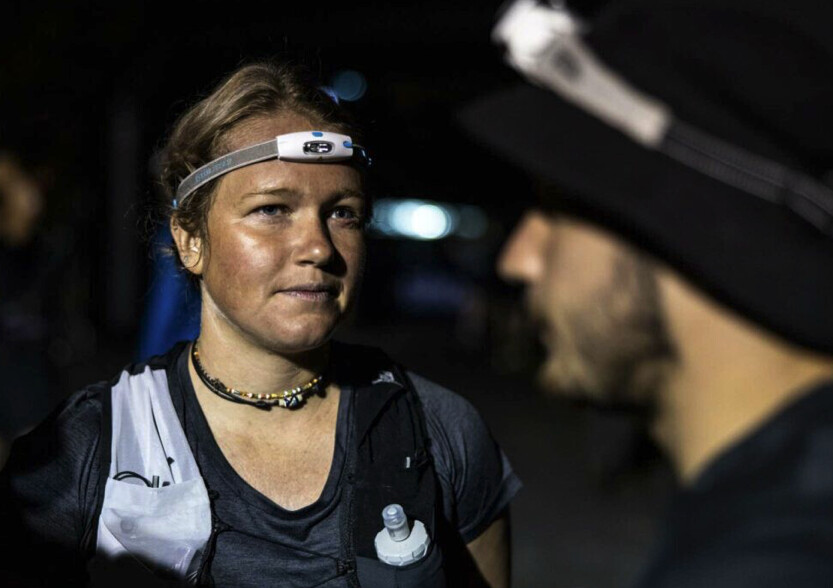
The double–nearly 400 kilometres of challenging racing–has only been conquered by one woman before Bartholomew: Ireland’s Diana Hogan-Murphy, in 2014. Bartholomew is also the fastest person of any gender to have completed both events in the same year.Bartholomew shot to fame in the ultrarunning world in 2018, when she was the third female at the Western States 100. The runner shared on social media that she lost some of the joy in racing in the years following her WSER podium, and after her 2022 race ended in a DNF, she wasn’t sure if she’d race 100 miles again.
“You show up (almost) every day to run so that you can run even more on the race day, finish and not be able to run, only to want to run, and then run to aid in the recovering of the running and to prepare for more running,” Bartholomew explained. “To take myself out of this cycle I decided to tick a bucket list idea to do an IRONMAN triathlon. It was a ‘one day, someday’ objective that I pulled forward to help pull me out of feeling stuck.”Bartholomew’s first Ironman, in Western Australia in December 2022, qualified her for the Kona World Championship event in Hawaii.
While the runner had only planned to complete one Ironman, she felt she couldn’t miss the opportunity to race in Hawaii. “Not being one who steps down from a challenge, it seemed right to go one more,” she said.
“I’ve swum, biked and run my way to fantastic recovery from UTMB and moderate triathlon fitness for Kona,” Bartholomew said pre-race. “It was a fun, fine balance to play with these two big events so close to each other.”
by Running Magazine
Login to leave a comment
3 Athletes on Why They’re Running the Marine Corps Marathon
One of the largest marathons in the world to draw in 30,000 runners from all 50 states
The 48th Marine Corps Marathon (MCM)—“The People’s Marathon”—is the fourth-largest marathon in the U.S. and largest urban ultramarathon (they offer a 50K and 10K, too).

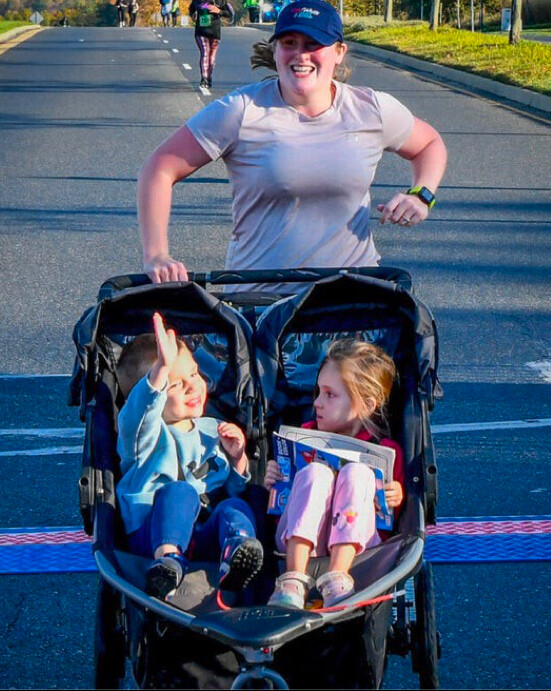
Each year, the U.S. Marine Corps holds the MCM a few weeks before the anniversary of its establishment. On October 29, 30,000 runners will toe the line in Arlington, Virginia, to follow the course as it winds through the nation’s capital. We caught up with three runners aiming for the finish line this year.
Rosie Gagnon, who lives in Berryville, Virginia, will be running the 50K MCM race in honor of her son, Marine Corps veteran, James Morris, who passed away by suicide in Ferurary 2018.
Even struggling through his mental health battles, Morris had endless confidence in his mother. Though Gagnon had been a runner for over two decades, Morris had encouraged her to run her first marathon. And when she completed that, he challenged her to dream even bigger–a 100 miler.
Morris passed away while Gagnon was training for this ultra, but she was determined to keep running in his memory.
“I actually bonked really hard,” Gagnon says, laughing. “I quit 60 miles in. I reached a point where I hit a wall–throwing up and crawling on the ground–and felt it was symbolic of what my son had gone through, because he got to the point where he couldn’t see how he could go on.”
The pain of this first race was disappointing but also a blessing. Morris says the experience taught her that, no matter how dark life gets, you keep putting one foot in front of the other.
Shortly after, Gagnon joined Wear Blue: Run to Remember, a group that honors the service of American military members through running. You may have seen one of them at races across the country wearing their bright blue shirts and the name of a fallen veteran. Gagnon challenged herself to run 100 ultramarathons in memory of Morris, and to raise awareness about military and veteran suicide. This will be her first time running the Marine Corps Marathon, and it will be her 60th ultra.
Running has become not only an outlet for spreading awareness about the importance of military mental health awareness and resources, but it’s been an outlet for grief.
“I used to wake up everyday wondering, ‘How can I live with this pain for another 40 years?’ and the one outlet where I found comfort was through running,” Gagnon says. “I focused on one race at a time, trying to get to that 100. I thought it would take longer, but it’s been moving pretty fast. I’m more than halfway through now!”
“If all I can do is put on shoes and run for somebody,” she says. “I’m going to do that.”
Between working a full-time job, managing clients in her running coach business, and raising three kids under the age of six, Kelly Vigil squeezes in training for the MCM when she can. Originally from northern Virginia, Vigil now lives in Charleston, South Carolina, and has run the MCM four times. This year, she’s running the 50K option.
“It’s my all-time favorite race,” she says. “When you get there, everything is taken care of,and everyone is super excited to be there. The spectators are amazing, which is hard to get in a marathon unless you’re running one of the major ones. At mile 21, you still have people cheering you on.”
Her husband was in the Marine Corps for six years, which makes her particularly connected to the race. Another reason is because Vigil used to work full-time in the charity running field, working with organizations to create their race programs.
“Athletes who are running for a cause aren’t necessarily going to feel more pressure, but there’s more meaning as to why they’re doing it,” Vigil says. “It helps them push forward when their body or mind isn’t in it anymore.”
As a mom of young kids, training isn’t always easy, but Vigil gets it done. Her long runs are timed so that she has an allotted amount of time to be away training on Saturday. Whatever mileage she gets done is what it is, and Vigil is happy with that.
“I’m not very strict with my training plan,” she says. “A lot of my running includes a stroller (with my two-year-old) or I might split up my runs in the morning and evening. I’m just doing what I can.”
Also a certified running coach, Vigil is currently working with other athletes who are running the MCM.
“Coaching keeps me in the community even when I’m not training for something,,” she says. “We’re all going after these different goals and doing what we can to stay consistent and do the work.”
For some, a commute to work includes traffic, to-go coffee, and a few swear words as someone cuts you off on the highway. But Jessica Hood’s commute to the office involves lots of marathon training.
Hood is extremely busy, so she puts in her miles by running to work. The total distance from her house to her office is about 14 miles, but depending on her training schedule, she’ll run seven or so and then hop on the metro bus for the rest of the way. Her office has a gym and showers, so she’s not taking a seat at her desk in sweaty running clothes.
“I do what I have to do and it probably takes a shorter amount of time,” Hood laughs. “You know, because you’d be sitting in DC traffic.”
Hood moved to the DC area about two years ago and works in finance, but her main passion is running. She began posting running content on social media in 2022 and developed a hearty following of 37k on Instagram and 81.5k on TikTok.
“It’s super cool how runners can get connected through social media,” she says. “I have a lot of running friends who don’t live in DC, but we all meet up at certain events and races across the country.”
Because of her influencer status, Hood is part of the MCM Social Media Influencer program, where she’s an advocate for the race. Though it’s sold out now, she spent months encouraging people to sign up through her posts online. This year will be her first time running the MCM marathon, though she’s spectated before and the energy was like nothing else.
“I thrive off of race day energy,” she says. “I love running and take it seriously, but it’s also about the fun of it and doing it with other people. So having a lot of people in my DC community running with me makes me so happy.”
Due to the race’s overwhelming popularity, early bird registrations for next year’s event opens January 1, 2024, with military members being able to register December 31. The Marine Corps Historic Half takes place May 19, 2024, and is part of the MCM series.
by Outside Online
Login to leave a comment
2023 UTMB Women’s Race
Was there actually any doubt that American Courtney Dauwalter (pre-race interview) would actually win UTMB? If her performances throughout the summer were any indication, it would have been foolish to bet against her. After winning and setting course records at both Western States 100 and Hardrock 100 earlier this summer, this win might just be the cherry on the cake, or the cerise sur la gateau, as the French would have it.
The legend of the sport led from the early miles, and in typical Courtney fashion, smiled and joked her way to the win with a time of 23:29:14.While Emma Pooley, of Switzerland, led for the initial kilometers of the race, it didn’t take long for Dauwalter to move to the front. Sporting her trademark smile and happily interacting with volunteers at aid stations whenever the opportunity presented itself, Dauwalter simply makes it look good.
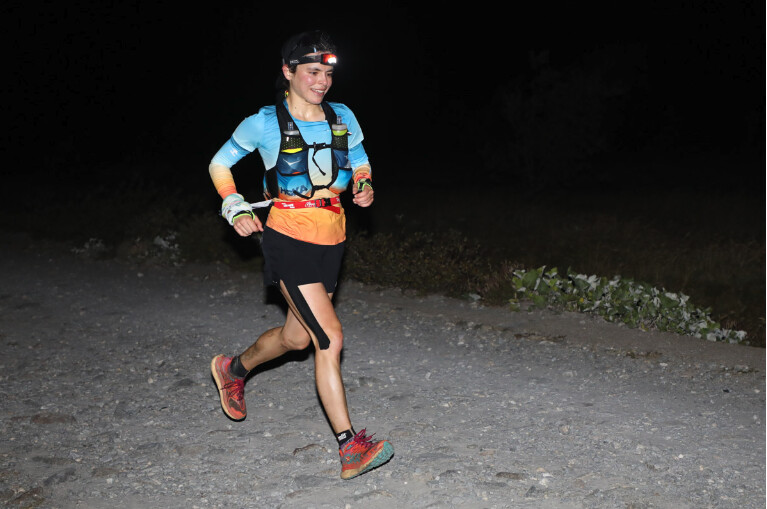
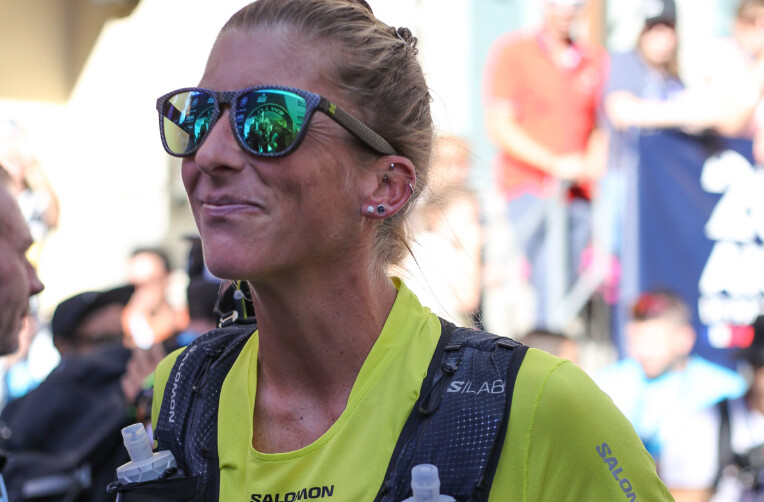
The top three women, Dauwalter, Pooley, and France’s Blandine L’Hirondel, came into Les Contamines, 32 kilometers into the race, within seconds of each other. It would be the last time we would see the front of the race together, as by Col du Bonhomme, 12 kilometers later, the gap between Dauwalter and second-place Manon Bohard Cailler, of France, was nearly 10 minutes. L’Hirondel and Chiina’s Fu-Zhao Xiang (pre-race interview) came through another two minutes later. Germany’s Katharina Hartmuth (pre-race interview) came over the dark col another five minutes in arrears. The situation remained essentially unchanged through Les Chapieux at 51 kilometers and Lac Combal at 69 kilometers, except the gaps were growing.
Nearly 10 hours into the race, Dauwalter came through Courmayeur at 81 kilometers, not even bothering to stop at the aid station. Bohard continued to keep the gap manageable at 18 minutes, but it was really starting to look like another runaway victory for the American for the top step of the podium. But the race for the rest of the top spots was just starting to get interesting. L’Hirondel and Xiang remained close in third and fourth, just a few minutes back of Bohard, and Hartmuth continued to lurk another 20 minutes back. This early in the race, there were still many within striking distance. Coming through Refuge Bertone at 86 kilometers, the top five remained unchanged and Canada’s Ailsa McDonald, Poland’s Katarzyna Solińska, the U.S.’s Sabrina Stanley and Leah Yingling, and Claudia Tremps of Spain filled out the top 10.
Somewhere before Arnouvaz at kilometer 99, Bohard took a fall that would ultimately take her out of the race. She entered the aid station walking gingerly, but was determined to keep going. This development opened up podium possibilities even further, and Xiang and L’Hirondel continued to run together at Grand Col Ferret, 50 minutes behind the ever-steady, smiling, and happy Dauwalter. Hartmuth was just 15 minutes off a podium position.
With the arrival of Saturday morning came renewed spirits for many. Dauwalter arrived to sun at La Fouly running 26 minutes under her own course-record pace. L’Hirondel and Xiang came in just under 50 minutes back, but now there was daylight, in the form of a couple of minutes, between the women. Hartmuth remained in fourth, 65 minutes down, Solińska in sixth, Yingling in seventh, and Spain’s Maite Maiora came through in eighth looking relaxed and focused. Stanley remained in the top 10. Bohard finally succumbed to injuries from her fall and would withdraw from the race.
By La Giète, 130 kilometers in, the gap between Dauwalter and second place was over an hour, but the fight between the rest of the top five remained tight. Xiang moved into second and Hartmuth third, just minutes apart, as L’Hirondel began to feel the distance and time in her legs and dropped back. Solińska and MacDonald continued in fourth and fifth, running together almost two hours behind Dauwalter and nearly 50 minutes behind second and third places. Things remained relatively unchanged at Trient at 144 kilometers. Dauwalter looked good, Xiang was 66 minutes back, and Hartmuth was a mere minute behind her. Solińska and MacDonald followed another 50 minutes back, with Maiora trailing them by 15 minutes.
With victory seemingly all but assured for the American, the battle for the other two podium spots started to get heated on the closing climbs and kilometers. Through Vallorcine at the base of the final major series of climbs, Hartmuth moved up into second after biding her time the entire race, now seven minutes ahead of third-place Xiang and fourth-place L’Hirondel, a further nine minutes back. Maiora led Solińska in fifth and sixth just under two hours behind the leader.
Near the top of the final climb at Tête de Béchar, 161 kilometers in, it was Hartmuth in second, 56 minutes down. L’Hirondel moved into third 15 minutes back and Xiang kept the pressure on for the final podium spot, trailing by just four minutes. The next gap to Maiora remained about 30 minutes.
Meanwhile, Dauwalter made short work of the final descent to the finish line in Chamonix, finishing in 23:29:14 and completing the ultimate trifecta of ultrarunning, winning the Western States 100, Hardrock 100, and UTMB all in one year. “Anytime you have a chance to take on a crazy challenge, I think we should,” she said afterward.The battle for the final two podium spots didn’t let up until the very end. Coming through La Floria, just four kilometers from the finish, Hartmuth led L’Hirondel by a mere nine minutes, and both women looked strong all the way to the finish. They would finish just over 40 minutes behind Dauwalter, Hartmuth in second at 24:10:52. L’Hirondel, the multi-time trail world champion, finished in third at 24:22:50 for her debut 100 miler.Xiang would fade away from podium contention in the final kilometers but held on for an incredible fourth-place finish, improving on her seventh place in 2022. But really, the excitement of her race finish was only added by receiving a marriage proposal on the finish line. Having met her now-fiancé — she said yes! — four years ago at UTMB, the proposal really was a perfect ending to her race.
Maiora finished fifth, an impressive result after her DNF in the race in 2021.
by Eszter Horanyi I run far
Login to leave a comment
North Face Ultra Trail du Tour du Mont-Blanc
Mountain race, with numerous passages in high altitude (>2500m), in difficult weather conditions (night, wind, cold, rain or snow), that needs a very good training, adapted equipment and a real capacity of personal autonomy. It is 6:00pm and we are more or less 2300 people sharing the same dream carefully prepared over many months. Despite the incredible difficulty, we feel...
more...Great North Run: 102-year-old walker set to be oldest entrant
At 102-years-old, Bill Cooksey hopes to become the oldest person to finish the Great North Run.
The centenarian, who walks about two miles a day to keep fit, will tackle the half marathon route from Newcastle to South Shields on 10 September.
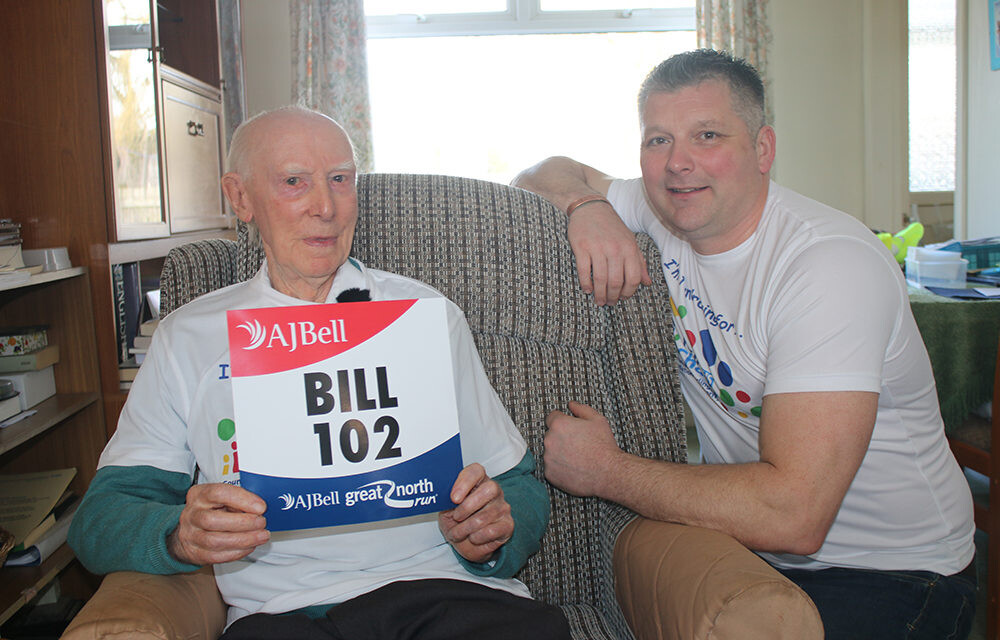
Mr Cooksey, from Newton Aycliffe, County Durham, is raising funds to support his local NHS Trust charity and will be accompanied by two others.
"I hope it will encourage other people to try the same thing," he said.
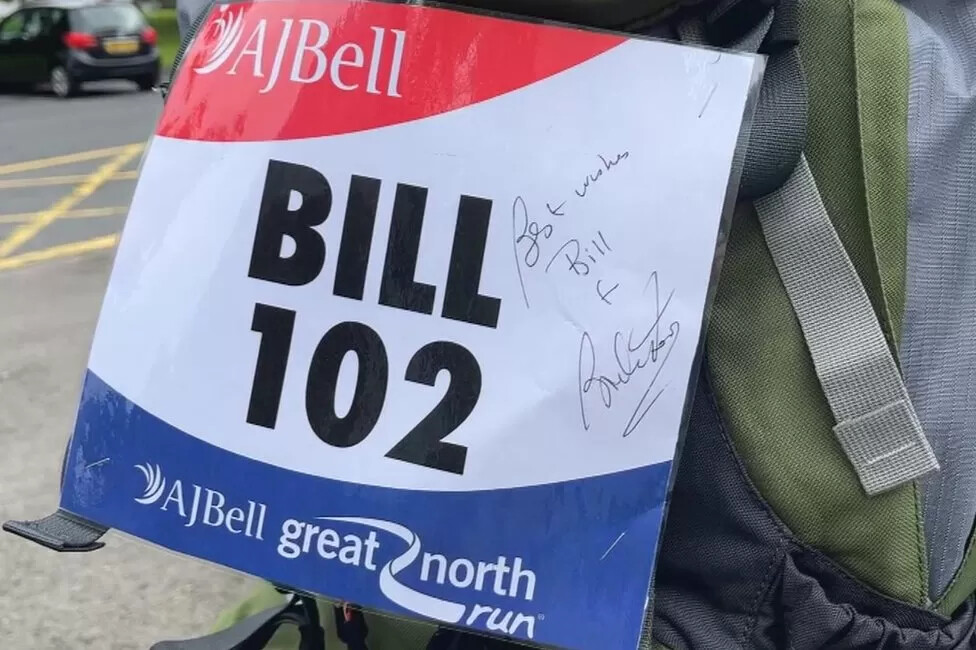
Due to his age, Mr Cooksey will be accompanied by his friend Gavin Hasting and Sue Jacques, chief executive of County Durham and Darlington NHS Trust.
The RAF veteran set himself a challenge of walking 100 miles (161km) when he turned 100 years old, trekking 10 miles a day for 10 days along the Locomotion Way between Newton Aycliffe and Shildon stations.
Not stopping there, the retired teacher clocked up 1,000 miles (1609km) on his tricycle to celebrate his 101st birthday.
He has been given a special Great North Run 102 number, signed by the half marathon's founder Sir Brendan Foster.
"Very often you get to the the same age and say 'that's it, I'm not supposed to be able to do this' but I just carried on as normal and I shall continue to do so until I am forced to stop," Mr Cooksey told BBC Radio Newcastle.
"I don't think that record will stand for long - there will be people out there who are much fitter than I am, and they will decide, 'well if he can do it, I can do it' - and good luck to them," he added.
Mr Cooksey, who was born in Wales, has enjoyed walking since his retirement in 1980.
He recently walked 12 miles (19km) between Seaton Carew and Hartlepool to test his fitness in terms of being able to do the 13.1 mile (21km) course.
The father-of-three encouraged everybody to walk at least two miles a day and has completed all the long-distance paths in Northern England.
"When I am doing an ordinary walk I don't make any attempt of hurrying, I just saunter along," he said, adding: "You go out to walk for solitude and to think about things."
He said he put his good health down to keeping active, as well as a good diet and lifestyle.
"The only thing I regret is having to give up dancing, I think that's another secret to good health," he added.
by Andy Watson and Chris Robinson
Login to leave a comment
Great North Run
Great North Run founder Brendan Foster believes Britain is ready to welcome the world with open arms after the launch of the event's most ambitious plan to date. The Great World Run campaign seeks to recruit one runner from every country in the United Nations – 193 in total – to take part in the iconic half marathon in...
more...3 Years After a Car Accident Put Him in a Coma, This Runner Finished an Ironman
Now he runs for his young son with an incurable heart disease.Whether it’s one mile or 100 miles, running is my time to reflect, and appreciate every breath, heartbeat, and mile along the journey, and to celebrate the gift of life.
I’ve always enjoyed running and I started competing in 6th grade on the track and field team for my middle school. I loved being a part of a team atmosphere, and as I entered high school, I still wanted to run, but my coaches preferred that I throw shot put and discus because I was doing a lot of strength training and some powerlifting at the time. I enjoyed the throwing events, but had an interest in running over the years, and would ask my coach to put me in a sprint relay or two throughout the season. Outside of track, I also started swimming competitively when I was 15, and when I wasn’t at swim practice, I was usually jogging.
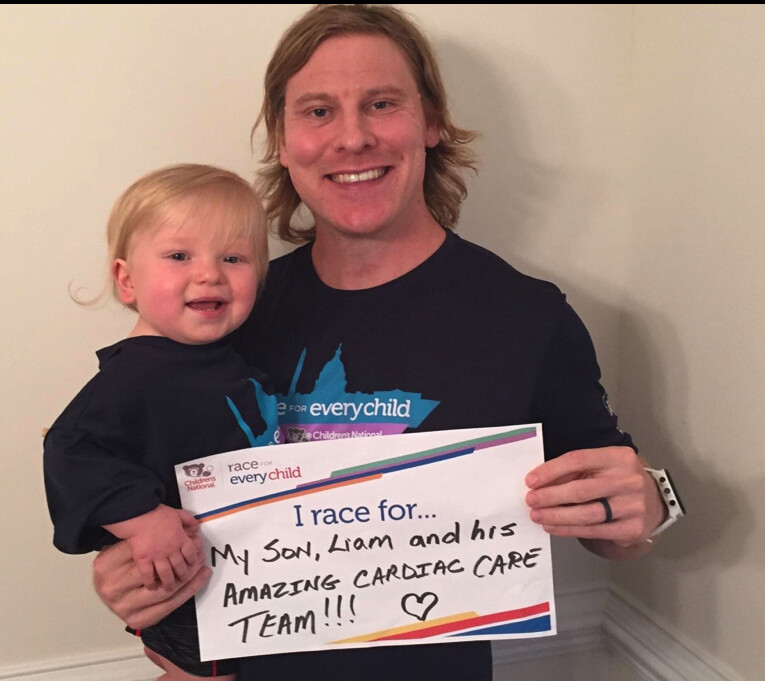
Growing up, I also had a dream of wanting to complete an Ironman triathlon. I saw the Hawaii Ironman on television when I was 5 years old and was inspired by the athleticism and inspirational stories of the athletes.
Unfortunately, one month after I graduated high school in July 2004, I was involved in a near-fatal car accident. The injuries were catastrophic: my heart went across my chest, I sustained shattered ribs, pelvis, left clavicle, and severe nerve damage to my left shoulder. Nearly every major organ in my body was damaged, failed, or lacerated. I also had a concussion from the impact of the crash and experienced 60 percent blood loss.
The EMS and rescue workers who got me out of the vehicle were later given awards for their work. I was then flown by a medevac to the hospital, and my trauma team explained to my parents that it would be a miracle if I survived the first 24 hours. Well, I did and I would spend the next two months in a coma, on life support. I was brought back to life eight times during the 14 major operations I had over that time.
When I came out of the coma, I had lost 100 pounds, and had to learn how to talk, eat, drink, tie my shoes, comb my hair, and brush my teeth all over again. The thought of walking was just that—only a thought—due to the damage to my crushed pelvis.
However, with help from my medical team, I was slowly able to stand, with restraint belts around my waist while being held up by physical therapists on each side. I then progressed to standing on my own with a walker, then a cane, and then shuffling my feet a few inches at a time across the floor to learn how to walk again.
After months of intense physical therapy, I was able to walk around my local high school track, which was a triumphant day. A few months after that, I was able to jog a mile around the track, and I kept progressing from there.
A year after leaving the ICU in 2005, I finally started college, and joined the swim team (even though I was just doggy paddling or doing light kicking with the kick board once or twice a week for 30-minute sessions.) Then two years later, in 2007, I was able to live my dream of crossing the finish line of the Hawaii Ironman triathlon, and also complete my healing process.
It was a team effort to save my life that terrible day and help me heal 100 percent from the EMTs, medevac team, pilots, surgeons, nurses, and physical therapists. So crossing the finish line at Ironman was my way of saying thank you to everyone who was a part of my journey and encouraging me every single step along the way.
Completing that race inspired me to continue racing, and eventually get into trail running, which I love.
Today, though, I run for my son, Liam. My wife, Pam, and I have two amazing children, Clara, who is 6 years old, and Liam, who is 4 years old. My children are my absolute world and they inspire me on a daily basis. My son, Liam, has a very critical form of congenital heart disease (CHD). CHD is a defect in the heart’s structure that’s present at birth, affecting nearly 40,000 babies each year in the U.S alone. His oxygen levels will always be lower than normal, so he gets dusky in color when he gets upset or cries.
Since birth, he’s undergone four major open heart surgeries, and other related procedures. His surgeries are palliative—not cures. He also has heterotaxy, which is when the organs are not in the correct location of the body, which can affect their ability to properly function. Liam’s lungs and liver are impacted, and he does not have a spleen so he is at higher risk for infections.
As Liam grows, he will require more cardiac operations. There is currently no cure for his type of congenital heart disease, and due to the cardiac defects that he has, there is an increased risk to liver dysfunction in the future.
We have been prepared that in Liam’s 20s or 30s, there’s a possibility he will need a heart transplant. This thought is very difficult for us as a family, but we hold onto the hope that medicine and surgical innovation will continue to advance over the next few years.
In Liam’s honor, I will be running the Grindstone 100K this year in Virginia. It is also my hope to raise awareness of congenital heart disease.
It’s been nine months since Liam’s most recent open heart surgery, and he is getting stronger each month. Seeing his improvement, and watching what he’s overcome has inspired and filled my heart with such gratitude. I’m going to get to that finish line for my son to celebrate his recovery!
I’m grateful for my family, and the second chance at life I was given after my near-fatal car accident, so having the opportunity to make it to the starting line of these events is a gift.
With Liam’s operations, running has been therapeutic for me—it’s a time for quiet reflection, and observing what my son has been able to overcome in his young life. It’s also a time to find inspiration on how I can help him, my family, and other families who are going through this journey.
Anxiety, depression, and PTSD can become overwhelming leading up to my son’s open-heart surgeries, but running allows me a physical and mental release from the stress.
When I get out there on the trails, I’m able to confront the concerns and worries that I have. Running has always been joyful, and these days it’s also my way to reduce stress, and inspire my children to see that when you work hard and set goals, you can achieve anything. Running is also my way to raise awareness on congenital heart disease and do all I can to help find a cure for the type of cardiac defects that my son, and many other heart warriors have. These tips have made my running journey a success:
1. Stay consistent
Each week I strive to hit a certain mileage that safely builds off the previous weeks, which then helps build a solid foundation for future training. The more consistent I am with mileage, nutrition, and pace, the better I feel at the starting line. I break larger goals into smaller, more achievable goals that over time help build confidence in my training. Over time, small goals can become big wins during the season!2. Rest and recover
In my first few years of running, I felt inspired to get out the door and train as much as possible each week. However, as I’ve been running more over the years, I have come to realize how important rest and recovery are after each training session. Having high mileage weeks is certainly an integral part of the training plan, but after every three to four weeks, I’ve found that taking the time to decrease the mileage during that “recovery” week helps keep me healthy and well rested.
3. Mix up your training and racing
I’m a bit of a hybrid endurance athlete, and I love to race in a variety of long-distance events, from marathons, to 100 mile ultramarathons. I have multiple goals in each discipline, and depending on the time of year and overall goals for the season, I’ll specifically focus on the upcoming race and how I can best prepare for it. This keeps it interesting! My weekly training plan includes swimming, biking, running, and strength training. The variety of the training and different goals has kept me feeling fresh and motivated.
Brian’s Must-Have Gear
→ PowerGel Green Apple: I’ve included Powerbar products in my training and racing since I started competing in sports in middle school, and they are a training staple of mine that I use every single day. During a training run or in the middle of a 100-miler, this is a delicious way to get much needed energy to keep running strong.
→ Nike Kiger 9 Men’s Running Shoe: These are my favorite trail running shoes because they are just the right amount of weight with optimum cushion. The way the shoe is designed, my feet feel secure, mile after mile, and I’m able to get an efficient and smooth foot strike with quick turnover. I also love the style and color range of this shoe, and they have the right amount of grip on technical terrain.
→Inner Armour Sports Nutrition Whey Protein Matrix: With the amount of training I do each week, recovery is essential in order to make the most of the next training session right around the corner. I’ve found great success in this protein formula because it tastes great, it helps hold onto the lean muscle mass when training, and aids the recovery process so I feel refreshed the next day when I get back out on the trails.
by Runner’s World
Login to leave a comment
How to safely increase your training volume
Lithuanian ultrarunner Aleksandr Sorokin recently shared his August Strava data on social media, and for most runners, it reads like a what-not-to-do training plan. The ultrarunner, who holds seven world records on the track and road including the 100K (road), 100 miles (both road and track), and 24-hour run (road) is known for his huge regular mileage and hammering out two 40K runs in a single day.
“31 marathons distance completed in August, Sorokin shared on Instagram. “It was a tough month with great work for some good results for the future.” While Sorokin’s monthly mileage is mind-blowing, for the rest of us, increasing training volume should be done slowly and carefully. Here’s how.
Make sure to build a strong base
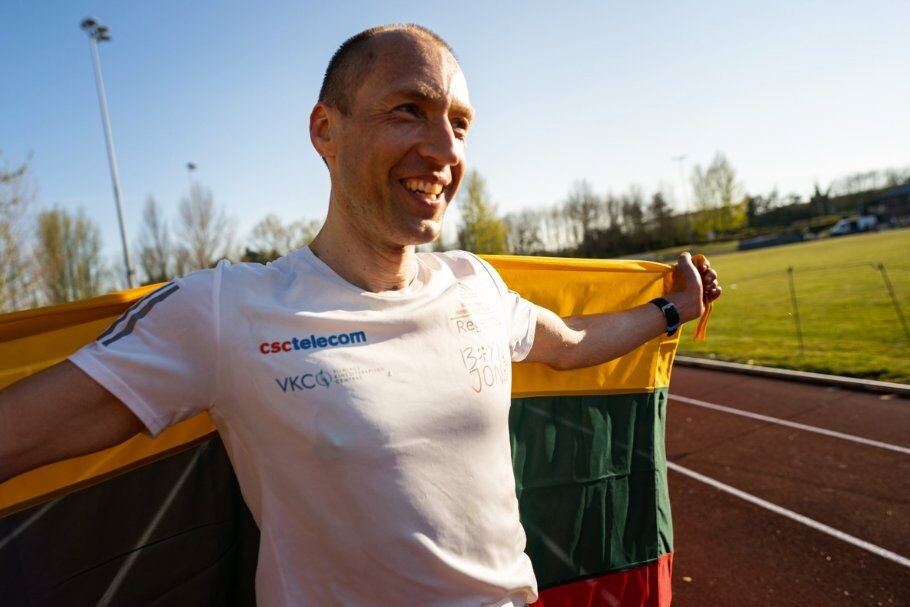
Before you start to really add mileage, make sure you have been running consistently for at least six months and have a solid foundation. These runs can (and should) be mostly done at a very easy pace–this will build your aerobic fitness and endurance.
Ignore the 10 per cent rule

The 10 per cent rule is commonly recommended for increasing training volume–and it may not be the best way to add mileage (mileage increases of not more than 10 per cent per week). There is no hard and fast rule that works for everyone, and you should maintain flexibility in your weekly volume to adjust depending on how you feel.
Volume should be added very gradually, allowing your body to adapt to the increased stress and reducing the risk of overuse injuries. For many runners, three or four per cent might be a better guideline, while others might be able to add 10 per cent or more without getting into trouble. Pay attention to how your body is responding.
Consider alternating hard and easy weeks
Periodized training is a popular method of training in phases or building blocks that usually include recovery weeks. While athletes often have three weeks that include some challenging workouts and one week of easier training to recover, alternating hard and easy weeks is a great option when adding mileage.
If you’re feeling extra tired or sluggish, take an extra rest day (or three). Paying attention to the messages your body is sending you is key to preventing injuries and building strength.
Focus on recovery
Whenever you’re adding volume or intensity to your running plan, recovery is the golden ticket to staying healthy. Prioritize rest and easy days. Make sure you are taking in sufficient calories and nutrients–this means on days when you aren’t running, as well. Recovery weeks or days are when the magic happens: your body works to repair microscopic tears in tissue and builds strength.
Increased mileage or focus on a big goal can also be challenging mentally. Make sure you are spending time on hobbies and interests outside of running and practising healthy self-care.
by Keeley Milne
Login to leave a comment
Martina Valmassoi ‘building up the excitement’ as she takes on 100 miles for the first time at UTMB
Martina Valmassoi will make her 100-mile debut on the biggest stage of all when she takes on the 2023 Ultra Trail du Mont Blanc (UTMB).
The Italian has enjoyed a stellar year, winning at Transvulcania La Palma Island by UTMB in May – which she credited to a change in mindset.
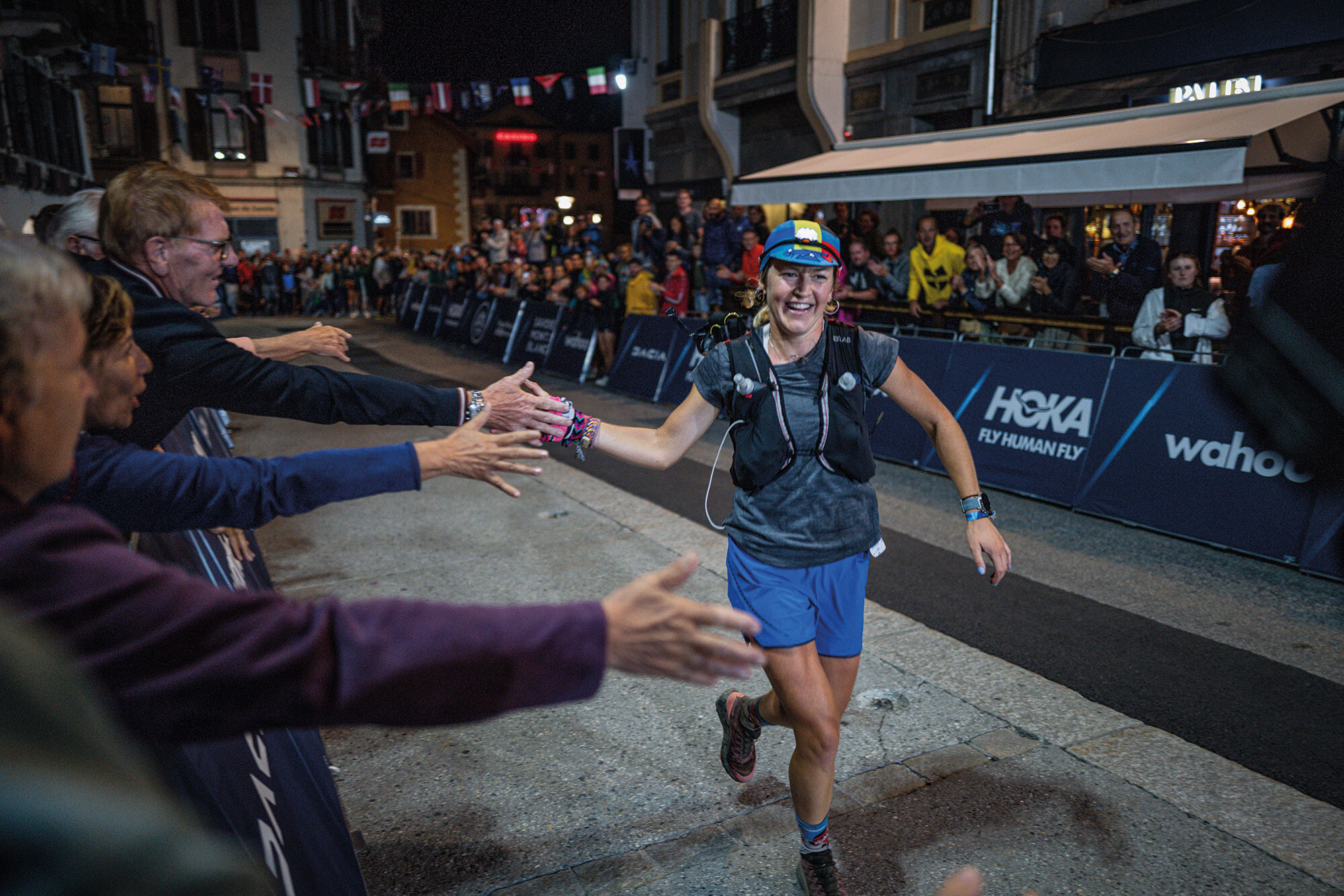
That triumph came a month on from victory at the Genova Trail Marathon and formed part of her recovery from a lengthy injury lay-off.
She has also since picked up fourth at the World Mountain and Trail Running Championships (WMTRC) Long Trail and third at the Marathon du Mont-Blanc.
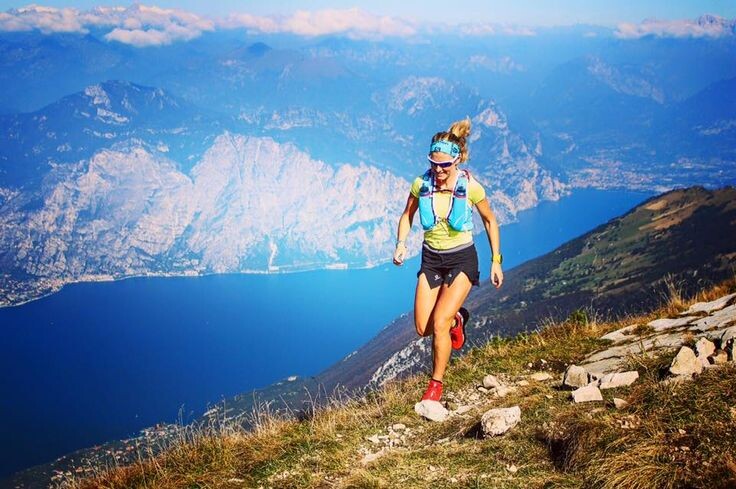
TDS triumph
Though she has never tackled the flagship race, Valmassoi has history at the UTMB event in Chamonix, having triumphed in the TDS in 2022.
She finished in 22:42:47, over 16 minutes clear of Spaniard Claudia Tremps as she bounced back from a DNF in the 2021 race.
At 91 miles, the TDS is a strong indicator of Valmassoi’s potential over the 100-mile distance, though she will be up against a stellar field in the UTMB, in addition to the added mileage.
“Less than a month until the big dance at the UTMB, my first 100-miler,” she wrote on Instagram.
“Building up the excitement as I’m building up the fitness.
“Is never easy to know if you are training properly, enough or too much but for sure listening at the signs that the body gives you is a great start.”
500km racked up
Valmassoi says her adaptation to the longer distance is going to plan as the weeks tick down to the UTMB World Series Finals and the UTMB itself, which starts on September 1.
“Training has been going pretty good lately,” she added in a recent post.
“About 500km and 30,000 meters on foot in the past three weeks and no majors problems.
“Now is time cut the runs short and focus on picking berries more!
by Olly Green
Login to leave a comment
North Face Ultra Trail du Tour du Mont-Blanc
Mountain race, with numerous passages in high altitude (>2500m), in difficult weather conditions (night, wind, cold, rain or snow), that needs a very good training, adapted equipment and a real capacity of personal autonomy. It is 6:00pm and we are more or less 2300 people sharing the same dream carefully prepared over many months. Despite the incredible difficulty, we feel...
more...Always Up for a Challenging Adventure, Alexi Pappas is Running The Leadville 100
Alexi Pappas is a busy woman. She’s equally glamorous and raw. She’s perfectly grounded and living in a fantasy. As an Olympian, filmmaker, writer, and speaker, she’s rarely in one place for very long. And the Leadville Trail 100 race was very much not on her radar even two months ago. But then she got an email.
“My manager sent me a message in June saying, ‘Just got word that Coros has an entry for Leadville,’” she recalls. “‘Let’s discuss this week and if it makes sense to run. I think it would be fun and epic, but let’s do whatever feels best and right to you.’”
For the 32-year-old Pappas, it feels like there are two kinds of goals to shoot for—the ones you set for yourself that feel like they were born with you. And then the ones that take you completely by surprise. Leadville is the latter.
In the 2016 Rio Olympic Games, Pappas set a national record in the 10,000 meters, representing Greece. After being an All-American collegiate runner for Dartmouth and Oregon, her long-time Olympic dream came true, and it opened all kinds of doors for her. It also allowed her to have the freedom to explore those unexpected opportunities.
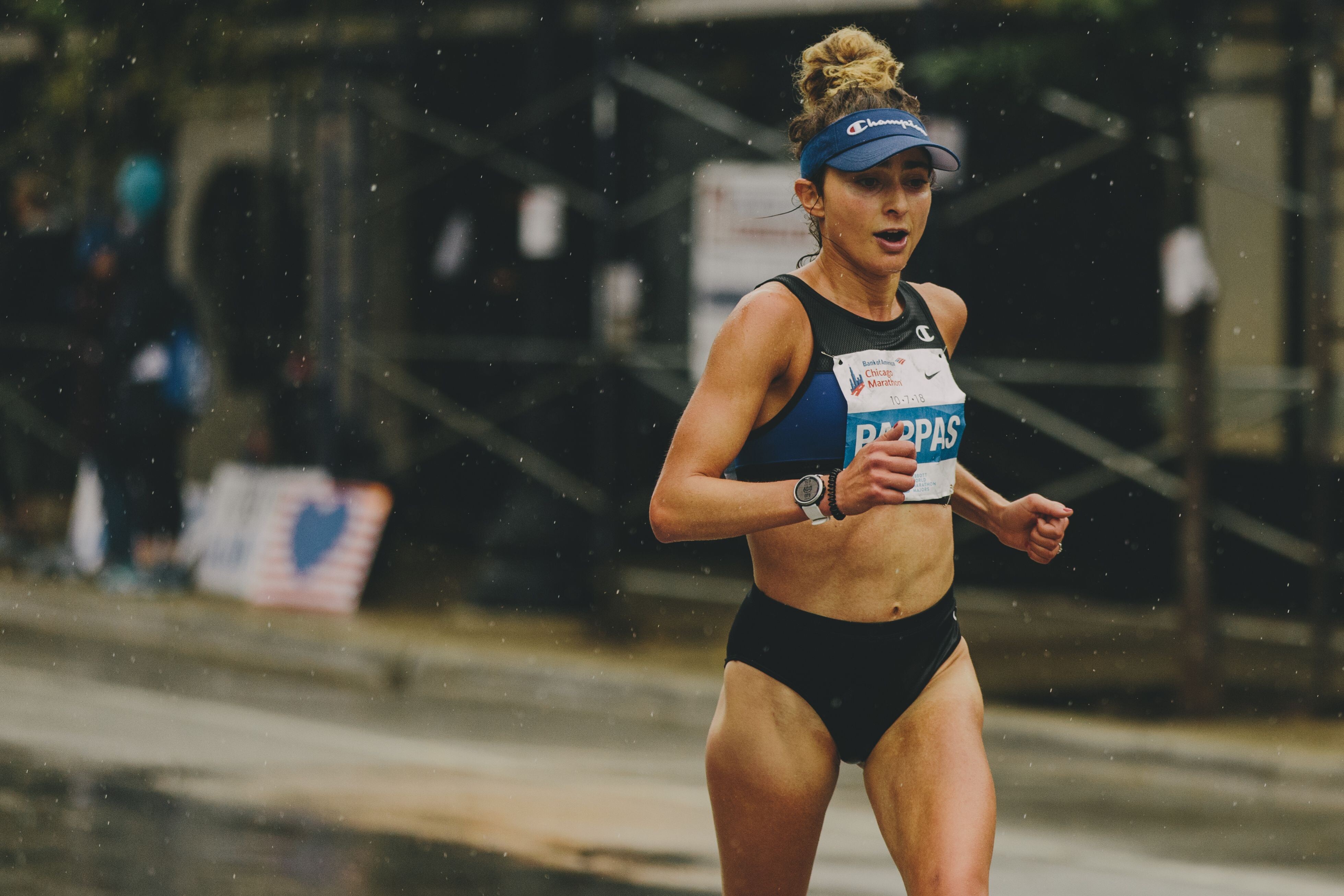
“I feel like there’s a period of time in your life as an athlete where you chase goals that you have for yourself. Maybe you have an Olympic dream. Maybe you want to run a fast mile. Then there’s a time when you can begin to embrace things that the universe brings to you, and not the ones you necessarily had in mind for yourself.”
She’s Still Immersed in Running
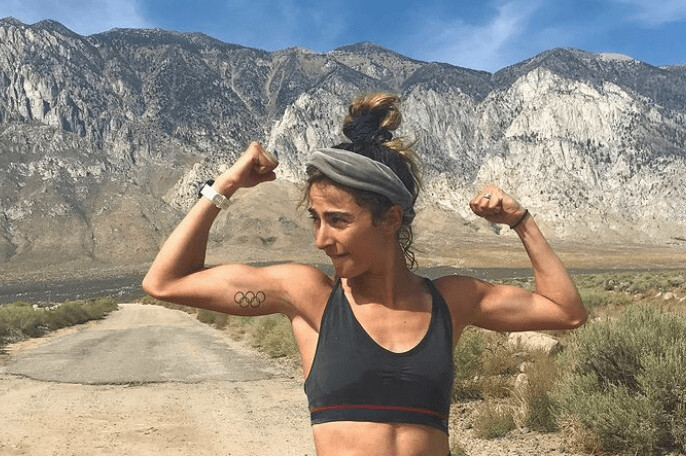
Pappas is a legit runner, having run that Olympic 10K at 5:05 mile pace and also clocking a 2:34 marathon in 2020. Although she’s backed away from competitive track and road racing, she’s still immersed in the sport in numerous ways. She ran the 2022 New York City Marathon in a custom bedazzled costume and paced Diplo, aka renowned DJ and music producer Thomas Wesley Pentz, through the 2023 Los Angeles Marathon in March.
Although she’s recently made a foray into trail running, Pappas, who lives near sea level in Alameda, California, admits that she’s less than perfectly prepared going into the Leadville 100. The out-and-back race, which begins at 4 A.M. on August 19 and has a 30-hour cutoff time, is situated between 9,200 and 12,500 feet above sea level.
“It’s a big honor [to be given entry into the race]. And it’s one I take seriously, but also I’m not in peak condition for this race. So I’ve been thinking a lot about it as a kind of mysterious unknown. What might happen? What might be possible? I do believe in myself.”
Pappas’ longest race to date is the Hoka Bandera Endurance Trail 100K, which she did in January. “For that event I entered the day before,” she admits. “So I didn’t have a crew. I didn’t even have a headlamp. I used my cell phone light.” Although she fared pretty well (finishing 12th in 12:08), Pappas learned that ultra events are more about solo adventure, with lots of other people solo-adventuring at the same time. Different from running in the pack on a track, where the whole point is to stay with the group.
And this time around Pappas will have a pacer, Michael Mitchell, and a crew to help her through aid stations and with motivation. “I feel like Michael is the right balance of personality and experience,” she says. “And my best friend since we were two-years-old will be there to crew, so I’ll have lots to look forward to. I figure we’ll make an event of it.”
Mitchell, accomplished On Running trail athlete and TikTok personality, is stoked to be part of Pappas’ race. “I am very excited to help Alexi attempt this incredible feat,” he says. “The Leadville 100 holds a special place in my heart as it was the first ultramarathon I ran.”
Mitchell’s experience in the race in 2021 solidified his love for the ultramarathon atmosphere and community. “I’m a fan of Alexi and all that she represents,” he adds. “Not only do I think she will be able to finish the race, but I know it will inspire her to continue her successes in the running world and beyond.”
Jumping at New Opportunities
Even though Pappas doesn’t feel perfectly prepared for what she’s about to embark on, that’s part of the fun. “I just don’t think this opportunity will happen for me again,” she says. “There are some opportunities that feel like you’ll be able to have them a million times. But this isn’t one of those. This is more like the Olympics. I have friends who said that about the Olympics—that they’d do it next time—and then their sport was taken out of the Olympics.”
Sometimes you have to jump at the chance, even when the thing you’re jumping at is 100 miles in the high alpine of Colorado.
Pappas lost her mother when she was just 4-years-old, and has a friend who has also lost a parent. “My friend told me that our parents would do anything to be in nature for one more day, and he suggested I think about that when [the race] feels long. To have gratitude for simply being alive in the beautiful outdoors, moving about nature, moving from one loving friend and food stop to the next, with plenty of trees in between.”
As soon as Pappas finishes Leadville, she’ll be onto the next thing, but she’s going to enjoy the journey as much as possible.
“I have a new book coming out two days after race day,” she says. “So I’ll come home and not be able to walk and just do the book release as well as I can.”
The book, Bravey, is an updated version of her 2021 New York Times best-selling memoir that’s been adapted especially toward young readers. She talks about unique experiences, like making her Olympic debut as a distance runner, but also common stresses like learning about compassion, forgiveness, and loss.
by Micah Ling
Login to leave a comment
Leadville Trail 100 Run
The legendary “Race Across The Sky” 100-mile run is where it all started back in 1983. This is it. The race where legends are created and limits are tested. One hundred miles of extreme Colorado Rockies terrain — from elevations of 9,200 to 12,600 feet. You will give the mountain respect, and earn respect from all. ...
more...9 Things Every Running Shop Employee Wishes You Knew
Yes, this shoe comes in other colors. No, that doesn’t mean you should buy it.
For two years, I worked at the best run specialty store in Minneapolis-St. Paul, Minnesota. For seven years after that, I worked for a running shoe brand. In that time, I learned there’s a sizable knowledge gulf between folks in the industry and most consumers. Even many consumers who pay pretty close attention to racing and shoe reviews weren’t always up-to-speed on the latest tech, how a certain brand fits or whether they need a neutral. stability, minimal, or trail shoe.
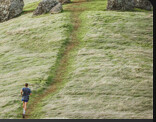
It’s our own fault. Brands create so many SKUs that it can be hard to keep up with each development. Stores stack so many models next to each other on the wall that it can seem impossible to know where to start.
I can ensure you we didn’t keep things convoluted on purpose. On the brand side, we wanted people to feel like they knew enough about our footwear to confidently buy shoes from our website. In the shop, we knew customers appreciated feeling like they were empowered to pick the right pair. If they felt overwhelmed at our store, we knew, they probably wouldn’t come back.
That got me thinking: What else did I wish every runner out there knew about shoes? So I jotted down this list. It’s far from comprehensive. Maybe there’ll be a part two.
Full disclosure: My wife works on the product team for the aforementioned shoe brand. But I think that gives me a valuable window into how brands ideate and produce their products, and I’ll do my best to be objective. Besides, I didn’t consult her on this. To counterbalance this, I’m going to go make some major purchases, also without consulting her!
One person I did consult, since he’s been in the shop game a lot longer than I have, is Jeff Metzdorff, co-owner of Mill City Running and Saint City Running. He will really hate that I called his cross-town rival the best shop in the Twin Cities, but them’s the breaks. In any case, here’s what came up for us.
Your coworker might love Asics. Your run club friend might hate Nike. That doesn’t mean you should buy Asics or avoid Nike. You should try both—and a bunch of others—to see what works for you. (FYI: Sizing can be different from brand to brand, so don’t be alarmed if you’re a full size bigger or smaller than you thought, or even a full size different from brand to brand.)
Every set of feet is different, and shoe choice is highly individual. Anyone who tells you with broad strokes to avoid or buy any one brand across the board might mean well, but they’re probably wrong. (And if they’re right, it’s a coincidence.)
So how do you know if a shoe is for you? It’s simple—if it’s comfortable when you put it on, there’s a really good chance it’ll serve you well. Shoes shouldn’t require a break-in period to feel good. (This is in addition to other considerations you should address before you’re trying them on, like whether the tread pattern will be sufficient for the surface on which you plan to run.)
Not to get all hippy-dippy, but your body is a pretty good judge of this sort of thing—and the (albeit very limited) science seems to agree.
They can absolutely contribute, to be sure, but it’s also tempting (and lazy) to point the finger to shoes alone when injuries happen. They’re part of an ecosystem that includes individual mechanics, stressors, your training, and other factors.
Being in the wrong pair of shoes won’t help your odds of avoiding injury, but if you’re in the wrong pair, you won’t blow out your knee in the first few steps. You’ll get some warning signs before an injury, so make sure you heed them if they appear.
Things like ramping up your mileage too quickly, or neglecting ancillary strength and mobility, probably play a bigger role in injuries than shoe choice alone. You’re not Indiana Jones trying to pick out the Holy Grail, so don’t stress too much.
All it often means is that the shoe contains more physical material like midsole cushion, or more expensive material like carbon fiber, and therefore was more expensive to produce. That doesn’t mean the $200 shoe won’t work for you, but don’t rule out the $130 shoe on this basis alone.
I’ve already covered this on the brand front—that just because your favorite athlete wears Hoka or On doesn’t mean you should—but this applies to shoe type, too. A lot of pros train and race in shoes that are lighter-weight and lower-profile than many of us should be using. They tend to be lighter, more efficient, and in more dire need of shedding ounces. (It’s their job to go fast, after all.) If you try and wear road racing flats in a 100-mile trail race because your favorite pro did it, there’s a good chance you’ll regret it after mile 50.
Of course, there are exceptions, but a lot of pros know very little about the shoes and brands they’re endorsing. So take those endorsements with a grain of salt.
“I need support.” I’ve heard it a thousand times, and I was only working the floor for two years. “Support” can mean more cushion. It can mean more medial stability, designed to mitigate overpronation. For a handful of people, it means the feeling that the arch is hugging the bottom of their foot when they step into the shoe. The list goes on.
Cushion can be good if it’s more comfortable for you – but an ultra-cushioned shoe won’t necessarily prevent injury at a higher rate than its more moderately-cushioned peers.
Medial stability is something pronators might need, although there’s been a move away from overtly-prescriptive footwear in favor of “inherently stable” shoes that work for a broader variety of folks in the last decade or so. (A shop employee should be able to help you decide whether you want a stability shoe.)
As for the arch, an insole that hugs the foot tightly might feel good at the outset, but it could be a one-way ticket to blister city. (Earlier I noted that comfort is king, but here’s one case where comfort now doesn’t necessarily translate to comfort later. Just don’t view arch-hugging fit as a dealbreaker.)
So, are you sure you need “more support,” whatever that means to you? Try some shoes on and find out!
I know, I know. They ruined your favorite shoe. Or even worse, they discontinued it. I certainly won’t try to convince you that the last model didn’t fit you just a little better, or feel a little more right. And this probably won’t ease the pain. But I can assure you that brands aren’t updating their shoes arbitrarily, or—as conspiratorially-minded YouTube reviewers occasionally insinuate—for marketing alone.
When a new shoe hits the market, the brands get a deluge of feedback from customer reviews, media reviews, store staff, and reps in the field. It’s too wide, it’s too narrow, the upper rips after 100 miles—stuff they would’ve liked to catch in testing, but didn’t until their sample size was the entire marketplace.
From the noise, some signals emerge, and they’ll chart a plan to address the most consistent pieces of feedback. It might be delayed by a model, because it’s usually a 12- to 18-month process to brief, build, and iterate a shoe before it launches. So the fifth version of a shoe often addresses the feedback they hear from the third version, for example.
That doesn’t mean you’ll like the new version as much as the old one. It would be ideal if everyone loved every update, but that’s not realistic, so the brands’ big bet is that more people will prefer the new version. That’s just business.
Does that mean they always get it right? (Stares at a pile of unused Hoka Clifton 2s in the corner.) Heck no. But they aren’t doing it just to mess with you. And let’s be real—sometimes your old favorite wasn’t quite as perfect as you remember it.
Where are you now, guy who took that size 8 Brooks Dyad off the wall, squeezed your toes into it, and declared: “This doesn’t fit!” without remorse? Did you think that ruled out the Dyad entirely? Did you tell your friends that Brooks shoes are too narrow? Did you not think we had a size 12 in the back that you could try on? Did you wonder why there was only one shoe, and where the matching half was? I think about you often.
And no, we don’t mind checking for you. If getting the color you want means you’re more likely to run, we’re more than happy to help.
To that end, we know it can be a touch intimidating to make your first run specialty visit. A display wall brimming with technical-looking choices and a floor staffed by serious (nutritionally- and sleep-deprived)-looking runners.
But, don’t be scared. Don’t worry about saying the wrong thing. Good shop staff meets you where you’re at, and wants to help get you on your way to enjoying a new pair of shoes. With any luck, you’ll turn into a lifelong runner and a lifelong customer.
You see, the stores need you more than you need them. If any staff treats you otherwise—and I know it happens—go shop at their competitor across town.
by Outside online
Login to leave a comment
New to Pacing? Three Expert Running Pacers Share Their Best Practices.
acing at long distance running events is common in North America, but it can also be intimidating. Here are seven essential tips from veteran ultra athletes. Emily’s stomach had definitely gone south. She couldn’t keep anything down, vomiting every few steps. Her pacer Buzz Burrell, a fixture in the ultra scene, had encouraged various forms of nutrition and drink with a side of optimism—it’s just a rough patch, aid station’s in a half-mile, the sun will be up soon. After all, that was his job, right? To lend the moral, emotional, and logistical support Emily needed to get to the finish line.
But when the hurling continued, he got out a flashlight and inspected the latest effluent. “It was blackish red, like a stomach lining,” he noticed. “And that’s when I said to my runner: ‘You know, I don’t think we ought to do this.’”

While that scene might be uncommon, it’s an example of the dire scenarios a pacer might encounter during an ultra-distance race. A pacer may need to be prepared to play all sorts of roles in service of helping a runner achieve their goals, even if it means knowing when to call it quits. They can be cheerleaders, drill sergeants, nutritionists, aide-de-camps, trail doctors, raconteurs, and comedians. It’s an art, one that requires close communication between pacer and runner.
While pacing is uncommon in European ultras (it’s not permitted in UTMB races, for example), it is a frequent feature in the U.S. Both on the track and in marathons, pacers are in from the start and step off somewhere halfway, but those who are pacing an ultra usually pick up their runner after the halfway point and accompany them for some or all of the last part of the race.
Some purists argue that the psychological advantage of having clear-thinking, uplifting company in the later stages contravenes the spirit of the endeavor, while others find it a way for friends or family to share in what might otherwise be a time-consuming and self-centered undertaking.
The practice of pacing originated as a safety precaution—race directors didn’t want runners to get lost or collapse out on the trail alone. The 345 percent increase in participation in ultras over the last twelve years guarantees that, while some runners are very experienced, there’s also an influx of neophytes who could benefit from the company of a pacer. And yet, at the same time, there’s a contingent who have never worn a pacer bib.
For those new to pacing, or some of us who have been thrown into the fire to pace a friend without any guidance, here are seven essential insights on the art of pacing from a few of the sport’s veteran pacers. Unsurprisingly, these three pacing pros are also experienced ultrarunners. In fact, it’s been suggested that pacing is an excellent way to learn the tricks of the trade before signing up as a competitor.
After interviewing these three experts, several themes emerged on what to expect when pacing a runner, and how to prepare and execute on your responsibilities:
Buzz Burrell: “You might be trudging along while your runner is throwing up, but I put a different spin on it. As a pacer, I’ve skipped the first 50 miles of the race, which means I’m feeling good, walking into aid stations, eating sandwiches. I haven’t paid a thing for this race! As a pacer, I can enjoy the beauty of the course. This runner might be a dear friend of mine, and I want to help him, but I’m also a free food kind of guy.”
Justin Grunewald: “I think the most common reason is to help someone you care about conquer their demons, and get from point A to point Z. For me, Tyler [Green] is a friend, but he’s also hugely accomplished. I learned so much from him by pacing, I think I could take 30 to 60 minutes off my time from what I learned from pacing.”
Nicole Bitter: “To be a part of a loved one’s attempt at achieving a goal, that’s almost better than if I did it myself. Some people can’t run 100 miles or don’t want to—pacing is a way to share in the experience. A lot of people find fulfillment in pacing, maybe more so than racing.”
BB: “This is critical. It’s not just two friends saying ‘Let’s go for a run together.’ First, discuss goals. Talk about possible scenarios.”
JG: “We talked about Tyler’s objectives. He’d finished second and fourth at States in past years and was completely overlooked as a top finisher this year, so he really wanted to go for it. He had dropped his pacer before, so he wanted someone who could go 32-33 miles. We talked about his intricate cooling routine and how it was going to go at aid stations.”
NB: “It’s critical to understand your runner and what makes them tick. I love to talk when I have a pacer. I want them to tell me funny stories, what happened earlier in the day. Some people don’t want to talk; they’re just in the zone.”
BB: “Be well-fed and well-hydrated, and know when your start time will be. Never become part of the problem; don’t be a liability. Know the pacer rules, like no physical assistance. Usually “muling”—carrying your runner’s food or gear—is not allowed, though it is at Leadville, so be aware of the rules. Know the course, the aid stations, and cut-off times.”
JG: “At Western States, cooling is 15 percent of the race, so everything had to go right at aid stations. Typically, about a half-mile out from an aid station, I’d ask what he wanted to drink. I’d get Coke, ice cubes, water in one bottle, Tailwind in the other.”
NB: “Make sure you and your runner are a good fit, that you’d want to spend some time with this person. Be confident you can cover the distance you’ll be pacing easily. Take care of yourself or you won’t be equipped to pace.”
BB: “It’s unlikely your runner will be feeling great. They may be sick. They may be on a bummer. It might be hot or stormy. I tell first-timers: ‘You feel bad. So does everybody else. This is what it looks like.’”
JG: “They might be too mentally fatigued to know what they need. Tyler told me his arms were numb, which told me he needed electrolytes. Hyponatremia and dehydration are really tricky to differentiate, but, in my experience, they almost always need more electrolytes.”
NB: “Expect the unexpected. You don’t know what could happen. You might not even get the chance to pace if your runner drops out. Keep a positive outlook, and be a problem-solver.”
BB: “The first-time runner needs stability, support, and mild encouragement. Remind them to start eating and drinking 45 minutes into it. Don’t wait until your stomach starts to go. The veteran probably knows this so you can get into actual pacing, behind or in front of them, moderating the ups and downs. For someone who just wants to finish, concentrate on putting one foot in front of the other.”
JG: “Normally, Tyler takes it out slower and picks people off, but this time the theme was ‘no regrets,’ so I reminded him of his objectives, of who he is, of how proud his family will be. He ran in front of me so I wouldn’t distort his view of rocks and roots.”
NB: “It’s nuanced. My husband is competitive so I usually talk about how we need to catch that runner in front of us. The hunt mentality. Or if we need to pick it up, I joke, ‘Wow, are you keeping up with me?’ Some races, like Western States, are dialed in to the tech, and can feed the pacer info on how far ahead or behind their runner is.”
BB: “‘It’ll be fine’ is our mantra, as long as it’s just a mental or emotional low. You can always come back from that. I’ve had runners say, ‘I’m out. I can’t do this.’ I have them sit down, take some deep breaths, let their heart rate come down. Heck, you can take 30 minutes at an aid station, change your socks, and march back out.”
JG: “I told him [Tyler Green] he was looking great. He hit a rough patch, so we focused on hiking 10 steps, running 10 steps. Relentless forward progress. I’d tell him things like, ‘In 800 meters there’s a downhill.’ Late in the race, no one wants to eat, so I kept thinking of what’s going to sound good, to get in some calories.”
NB: “My husband is usually in the zone, not talking, but he enjoys when I tell him stories and point out nice views.”
BB: “Personally, I’m always going to protect my runner’s health first. Finishing is second. There are thousands of stories of people getting through awful circumstances, but I’m not going to encourage them to go on if I think it’s damaging to their health.”
NB: “In the 2016 Western States, my pacer called my day. I had hyponatremia and we didn’t feel it was safe. It’s good to have a close friend make those tough calls.”
Being a good pacer is perfect training for becoming an accomplished ultrarunner. All of our expert pacers routinely switched roles in their many years in the sport. And for those new to the sport, pacing is a great way to dip your toes before actually signing up for a long-distance race. Regardless of whether you ever intend to go the full distance or not, the many roles of the pacer make for a rich, fulfilling experience.
by Outside Online
Login to leave a comment
Courtney Dauwalter to race UTMB this year
The U.S. ultrarunning phenom, hot off her record-breaking finishes at Western States and Hardrock 100, will be looking to best her own course record in Chamonix in September.
Ultrarunning sensation Courtney Dauwalter has announced she’ll be toeing the start line at Ultra Trail du Mont-Blanc (UTMB) in Chamonix, France on Sept. 1, setting the stage for what is sure to be one of this year’s most highly anticipated ultras, following her recent record-breaking wins at the Western States 100-mile Endurance Run and the Hardrock 100.
The 38-year-old shared on social media Friday morning—with an apparent mix of excitement and trepidation—her decision to take on the famed 170-km course, which features 10,000m of vert around the base of Mont Blanc.
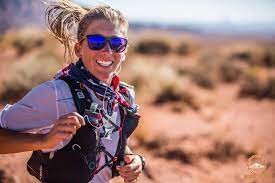
“We decided to do UTMB!” she wrote. “I have no idea how this will go, or what I’ll be able to squeeze out of my body & brain in one more 100 mile race this summer, but that makes it even more interesting to try! Mont Blanc, here we come! Race date: Sept 1”
The big question surrounding the September race will be whether Dauwalter, who holds the UTMB course record following her 22:30:54 finish in the race two years ago, will be able to best herself to claim the championships and course records at Western States, Hardrock and UTMB within a span of less than three months.
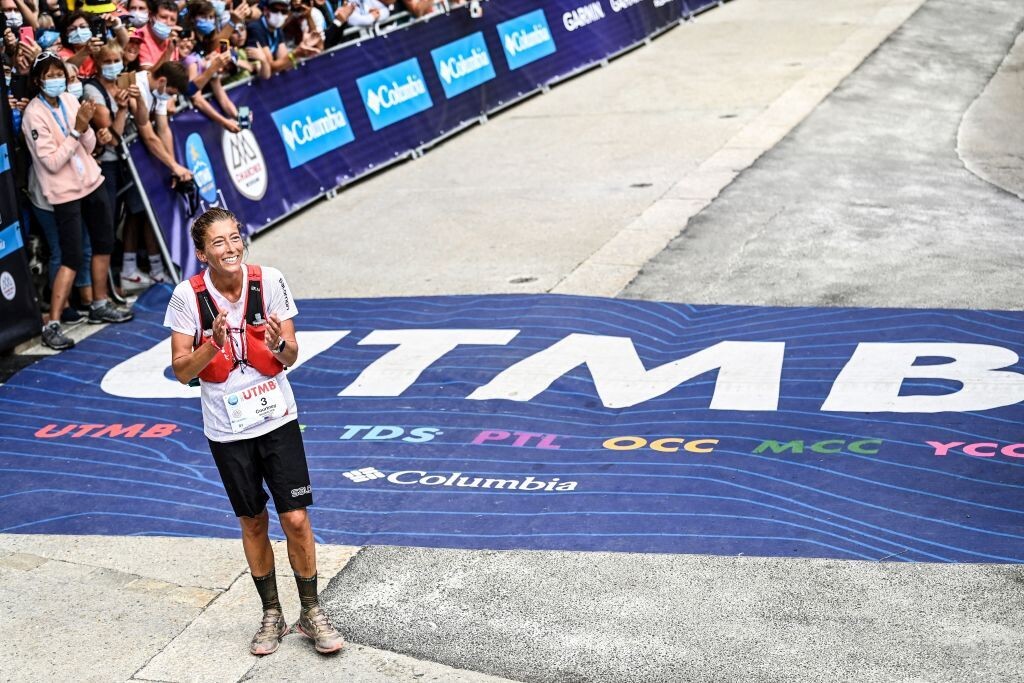
On June 24, Dauwalter not only demolished the Western States women’s course record that had stood for more than a decade (16:47:19 set by Canadian Ellie Greenwood in 2012), but beat most of the men, finishing in 15:29:33 and sixth overall.
Just three weeks later, she turned in another mind-blowing performance at the Hardrock 100 in Silverton, Colo., crossing the finish line in fourth place overall in 26:14:08. Dauwalter’s run was more than an hour faster than the counter-clockwise record set by Diana Finkel of South Fork, Colo., in 2009, and 30 minutes faster than Dauwalter’s own overall women’s course record set last year.
In addition to holding the course records at UTMB, Western States and Hardrock 100, Dauwalter, who is based in Golden, Colo., holds the record at Diagonale des Fous on Reunion Island.
by Paul Baswick
Login to leave a comment
North Face Ultra Trail du Tour du Mont-Blanc
Mountain race, with numerous passages in high altitude (>2500m), in difficult weather conditions (night, wind, cold, rain or snow), that needs a very good training, adapted equipment and a real capacity of personal autonomy. It is 6:00pm and we are more or less 2300 people sharing the same dream carefully prepared over many months. Despite the incredible difficulty, we feel...
more...What is the UTMB? Meet trail running’s most difficult race
We answer all of your questions about this hellacious footsport event
If you’re starting to dip your toes into the crazy sport of ultrarunning, a couple of things will happen. First, you’re going to need several pairs of the best trail running shoes in rotation at any given time to put up with all those miles pounding rocky trails, and second, it won’t be long before you hear mention of the UTMB.
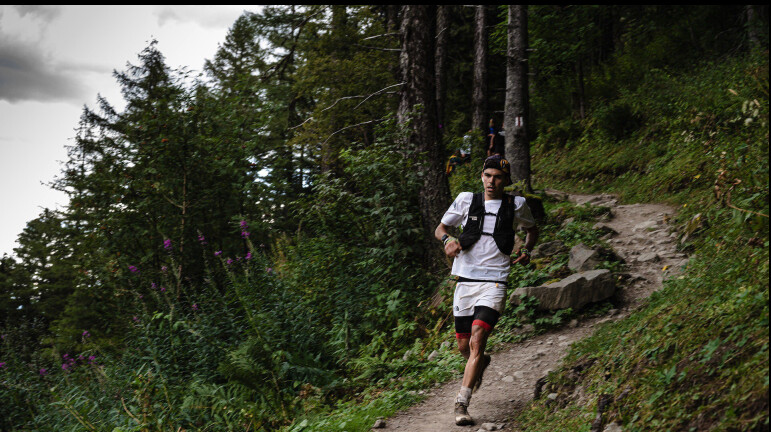
In fact, I recently attended the Arc’teryx Alpine Academy in Chamonix which holds a number of trail running clinics, and over the course of four days it was rare to have a conversation where the UTMB didn’t come up. Other participants in the academy wanted to know if our mountain guides had run it, how many times and whether they liked it (they don’t, considering it a tourist event) and mountain guides were keen to complain about how busy it made their favorite running trail.

But what is the UTMB exactly? Is it the ultimate goal for all trail runners? Why is it so hard? Here, we answer all of your questions about this hellacious footsport event.
What is the UTMB race?
UTMB stands for Ultra-Trail du Mont Blanc and is considered one of the world's premier trail ultra marathons. This demanding annual event follows the route of the Tour du Mont Blanc, a classic long distance hiking trail which circles the Mont Blanc Massif over 106 miles and passes through France, Switzerland and Italy. The UTMB begins and ends in Chamonix and is regarded as one of the most difficult races in the world.
The race takes place on the last weekend of August or first weekend of September and is today the ultimate in a series of events that take place around the world. Runners from all over the world aspire to compete in the UTMB. In the first year of the race, there were 700 participants, but these days, participation is capped at around 2,300 runners and other events have been created to allow for more participation.
The maximum cutoff for the race is 46.5 hours. In 2022, Kilian Jornet became the first to complete the UTMB in less than 20 hours (check out his race data to find out how he managed it) but most mere mortals can expect to have to run for two days and two nights to complete the race. Better bring some running gels then!
How does the UTMB race work?
Due to the event’s extreme popularity, you need to qualify to run the UTMB. That involves accumulating points through qualifying trail races over a two-year period. Qualifying races take place all over the world, from elsewhere in the Alps to Snowdonia, California, Mexico, Hong Kong and Australia. So if you’re serious about participating, you’ll have lots of time to train.
For each event you participate in and complete you’ll receive one running stone, which you can then enter into the lottery to be selected. You can enter the lottery at the UTMB website.
Why is UTMB so hard?
Besides the fact that at over 100 miles, it’s very long, competitors in the UTMB are also looking at 32,940 feet of elevation gain. In comparison, over roughly the same distance you could run the Leadville 100 in Colorado and gain only 11,000 feet (though at much higher altitude) or the West Highland Way in Scotland where you’d gain 10,300 feet.
The highest point of the route is 8,743 feet, which you’ll reach twice, in both Switzerland and France. That’s not extremely high altitude and it’s unlikely you’d experience altitude sickness at that height, but you’ll definitely notice shortness of breath and more challenging conditions, especially if you’re not already used to this altitude.
What you can also expect is more extreme conditions that come with trail running in the Alps. The altitude combined with the season means that the days might be swelteringly hot, while the temperatures at night could drop down around freezing at night.
How much does it cost to enter UTMB?
In 2023, the UTMB itself cost €335 to enter, plus administration fees. Of course, you’ll also have to pay registration fees for your qualifying events too. Your race will also include the cost of traveling to and from Chamonix, and accommodation while you’re there, but on the plus side the aid stations will be on hand to feed you during the race so you can save a little on those pricey Chamonix restaurants.
How many people have died in UTMB?
Sadly, deaths do occur in ultrarunning events and it’s perhaps more remarkable that for 17 years, no fatalities occurred during the UTMB, which not only places runners’ under extreme physical stress but entails a lot of night running. There have now been two deaths of runners in the UTMB, occurring in 2021 and 2022, both as the result of falls.
Do people sleep during UTMB?
Some runners somehow manage to do the UTMB without sleeping at all while others do sleep, but they’re not carrying a bivy sack and grabbing eight hours if that’s what you’re wondering. Sleeping during the UTMB looks like cat napping, and according to a 2015 study of 17 UTMB runners, the average time spent resting was between 12 and 17 minutes in total, and hallucinations were a common complaint, understandably.
Can you walk the UTMB?
Can you walk the UTMB? Well, yeah you could. Since the race is 106 miles and you have 46.5 hours to complete it, you technically could walk at a 2.3 mile per hour pace without any breaks and make the cutoff. Obviously though, you could just walk it at a time when the race isn't going on, save yourself €335 and enjoy far fewer people on the trail.
In all seriousness though, if you don’t already know, ultrarunning is actually hiking, and you’re not going to be running at the same pace you do on the tarmac back home. Even Jornet ran at an adjusted pace of around five miles per hour which isn’t exactly turbo speed (though it is if you maintain that for 20 hours). You’ll most likely walk the uphills and slow down or walk for rest periods, making up time on the downhills. And sorry, there aren’t many flats to speak of.
Login to leave a comment
2023 Hardrock 100 Women’s Race
If it wasn’t for Courtney Dauwalter (pre-race interview) running the Western States 100 just three weeks prior, crushing the women’s record there, and potentially being a bit worn out at the start line of the Hardrock 100, it would have been hard to find someone to bet against her winning the race this year. But if she were to falter, there were several women who were ready to jump at the opportunity.
For the first part of the race, it seemed like France’s Anne-Lise Rousset Séguret was going to do just that. While Dauwalter led in the very early miles of the course, Rousset opened up a sizable gap coming through Maggie Gulch at mile 15.5 and was moving with enthusiasm toward Pole Creek, the next aid station. She came into Sherman at mile 30 in seventh overall in 6:29, looking strong. Dauwalter was just six minutes behind, and Annie Hughes (pre-race interview) came in next, 52 minutes off the lead. With still many miles to run, it was still anyone’s race. Frenchwoman Claire Bannwarth (pre-race interview) came through just seven minutes later and was followed by Japan’s Kimino Miyazaki (pre-race interview), who was 1:22 off the lead but looking spry and happy.
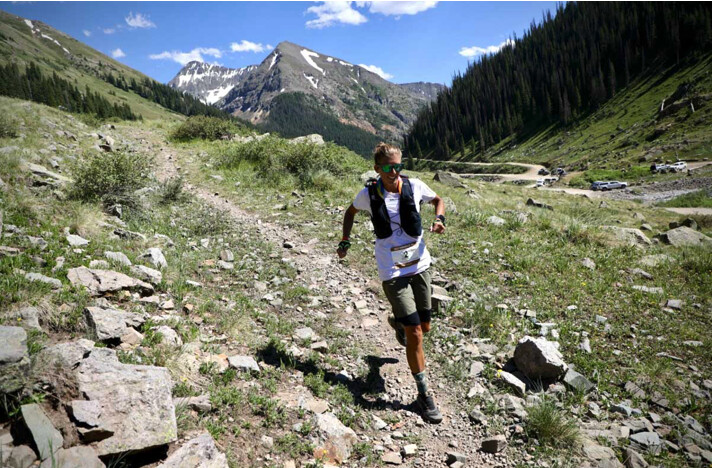
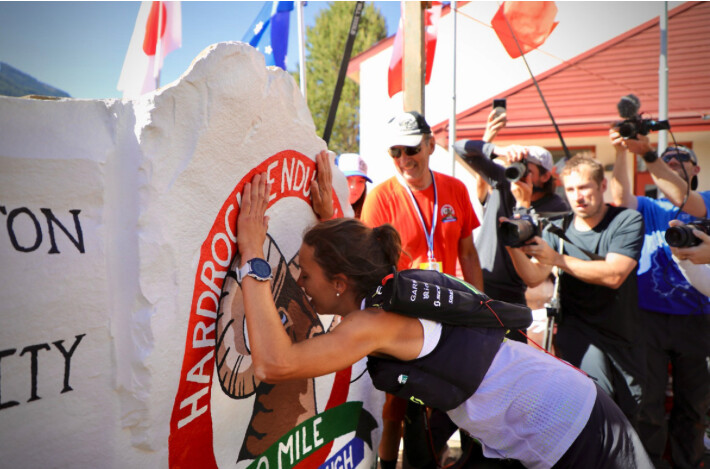
The top-two women came back together through Grizzly Gulch at mile 36 with Hughes trailing them at just under an hour back. When Rousset led Dauwalter into Grouse Gulch, mile 43.5, by nearly 10 minutes after traversing Handies Peak, the course high point, it seemed like maybe the Western States 100-Hardrock 100 double was going to be too much for Dauwalter to handle.
But it’s never a good idea to bet against the most dominant female trail ultrarunner of this generation. By mile 50, she’d closed the gap to four minutes, and in Ouray at mile 58.5, it was down to two minutes. When it came to the climb out of Ouray, Dauwalter made her move, and the elastic to Rousset finally snapped over the top of Virginius Pass. Dauwalter never looked back.
Meanwhile, Hughes stayed steady in third place while dealing with stomach issues and the rest of the women’s pack, including Miyazaki, Bannwarth, Christina Bauer, Whitney Mickelsen, Darla Askew, Becky Bates, and last-minute waitlist entrant Emily Halnon, who only got into the race the morning before, continued to chase — all within close proximity to each other.
Dauwalter ran into Telluride at mile 74.5, her pace still hovering just a few minutes over course-record pace, but now 23 minutes ahead of second-place Rousset, and executed the fasted crew stop of the Telluride aid station, getting in and out in under three minutes. She was on a mission.
Just 10 miles later, she was well below course-record pace, crushing the Bear Creek Trail climb out of Telluride and moving herself into third overall as some of the lead men began to falter. Rousset also continued her relentless march, and while she was 48 minutes back on Dauwalter at mile 84, she was only three minutes up on course-record pace.
In the end, there was no catching Dauwalter as she ran back to Silverton to kiss the rock with a new women’s counterclockwise course record of 26:14:08, besting the one set by the legendary Diana Finkel in 2009, and finishing fourth overall. She also set a new overall women’s record, beating her old time of 26:44:36, which she set last year.
Not only that, she set a new overall record for the Western States 100-Hardrock 100 double with a combined time of 41:43:42, beating Jeff Browning’s old record of 42:12:43 that he set in 2016.
Rousset would finish second after a gutsy run with a time of 27:29:55, which registers as the fifth-fastest time in event history, and Hughes would hold onto third with a time of 32:13:03 after spending nearly 100 miles battling stomach and breathing issues.With large gaps between the first, second, and third women, all eyes turned to the competition between fourth and 10th where the time gaps were tight and the women were often in the aid stations together in the back half of the race. Miyazaki and Bannwarth ran in close proximity to each other battling for fourth and fifth, while Mickelsen, Halnon, Bates, Askew, and Bauer seemed to maintain the same overall pace as the miles ticked by.
by Eszter Horanyi -I run far
Login to leave a comment
Hardrock 100
100-mile run with 33,050 feet of climb and 33,050 feet of descent for a total elevation change of 66,100 feet with an average elevation of 11,186 feet - low point 7,680 feet (Ouray) and high point 14,048 feet (Handies Peak). The run starts and ends in Silverton, Colorado and travels through the towns of Telluride, Ouray, and the ghost town...
more...Bill Rodgers is set to run his 43rd Quad-City Times Bix 7
In 1978, Bill Rodgers entered 30 road races and amazingly, astonishingly, he won 27 of them.
Over the course of his running career, he won 22 marathons, all during a thoroughly incredible 10-year period from 1974 to 1983.
He doesn’t win anything anymore, not even in his age group, but the 75-year-old Boston resident is still running, and he will be coming back to run the Quad-City Times Bix 7 for the 43rd time on July 29.
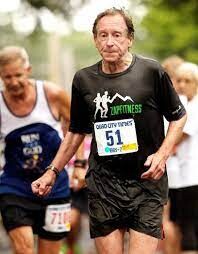
Rodgers said he thought he had done the Falmouth Road Race on Cape Cod about 35 times and the Cherry Blossom 10-miler in Washington, D.C., perhaps 30 times.
He never has entered any race as frequently as he has the Quad-City Times Bix 7, which is holding its 49th event this year.
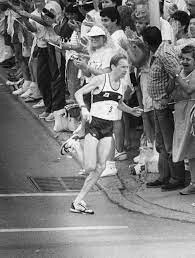
“And the Bix is probably the most challenging of them all,’’ Rodgers said. “But it’s a race I remember so well from that first time in 1980. I was still young and I could duke it out and I could race. Now I just try to hang on.’’
A man who once logged hundreds of miles in training each week now jogs 25 to 30 miles a week. He has done about 10 races this year, including Cherry Blossom. He said he now just went back to some of the old events he did during his heyday.
“But I’m back in the pack,’’ he said. “I’m way back in the pack because I’m 75 years old. It’s like a whole different thing. My strength used to be that I was a marathoner and I could do high mileage. I was a high-mileage runner. I wasn’t as quick as some runners, but I could do the mileage.’’
Not anymore. During the COVID-19 pandemic, Rodgers had a chance to sift through almost 50 years of running logs and he calculated that he has done more than 1,500 races and run at least 190,000 miles in his lifetime.
Most automobiles don’t last that long. And Rodgers hasn’t had the benefit of having a change of tires or periodic oil changes.
His body is feeling the effects of all that mileage. When he enters races now, he frequently finds himself trailing runners of a similar age who have fewer miles on their personal odometers.
“What I’m seeing is I see a lot of these runners who are in their 60s and 70s and they’re all ahead of me, but they just started running pretty recently or something,’’ he said.
He steps up to a new age group this year but doesn’t figure on being a contender to win it. The Quad-City Times Bix 7 course record for men ages 75-79 is 54 minutes, 58 seconds. Rodgers’ finishing time a year ago was 1:08:43.
Despite that, he still enjoys running.
“Now when I do 30 miles a week, I feel like when I was doing 100 miles a week,’’ he said. “I feel good, relatively speaking. No complaints with regards to running. I think it’s a great way to live.’’
Rodgers won the Quad-City Times Bix 7 the first two times he came here, in 1980 and 1981, and finished in the top 10 on seven occasions.
However, he is remembered almost as much for other years.
In 1995, he paused as he was coming down Kirkwood Boulevard to catch women’s leader Olga Appell just as she collapsed from heat exhaustion. He made sure that Appell received medical attention before jumping back into the race.
Login to leave a comment
Bix 7 miler
This race attracts the greatest long distance runners in the world competing to win thousands of dollars in prize money. It is said to be the highest purse of any non-marathon race. Tremendous spectator support, entertainment and post party. Come and try to conquer this challenging course along with over 15,000 other participants, as you "Run With The Best." In...
more...Hardrock 100 preview: will Courtney Dauwalter do it again?
The Hardrock Hundred Mile Endurance Run (HR100), known for its high altitude, deep elite field and challenging entry process, begins Friday at 8:00 a.m. E.T. This year’s event, the first ever to be live-streamed, promises to be a thriller. Runners will encounter over 10,000 metres of elevation gain while facing extreme weather conditions, navigating treacherous terrain and attempting to avoid altitude sickness.
Only 140 participants get to line up at Hardrock each year, and this year’s contenders include the remarkable Courtney Dauwalter, fresh off a jaw-dropping performance and course record at the Western States 100, and other well-known elites. The race will be live-streamed on the Run Steep Get High YouTube channel. Here’s what you need to know to follow along.
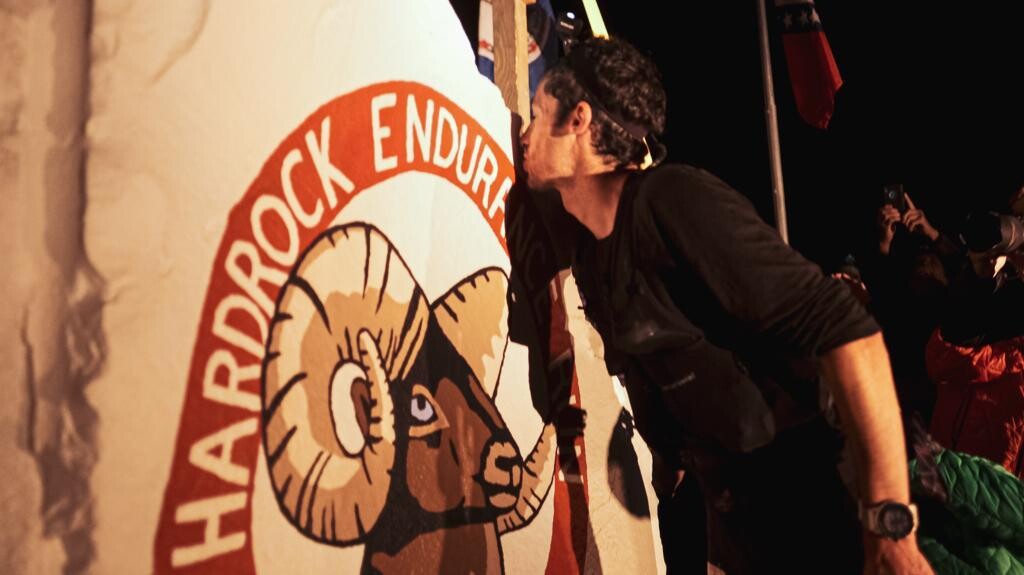
HR100 both begins and ends in Silverton, Co., and athletes are above 3,300 metres elevation for much of the race. It was founded in 1992 as a tribute to the miners who used to follow “their mules and instincts, prospecting the San Juans for gold, silver, and other metals,” the race website explains. With a finishing cutoff time of 48 hours, athletes know they are in for a long haul. The course switches directions every year, and this year runners are moving counter-clockwise around the looped course.
The women’s race
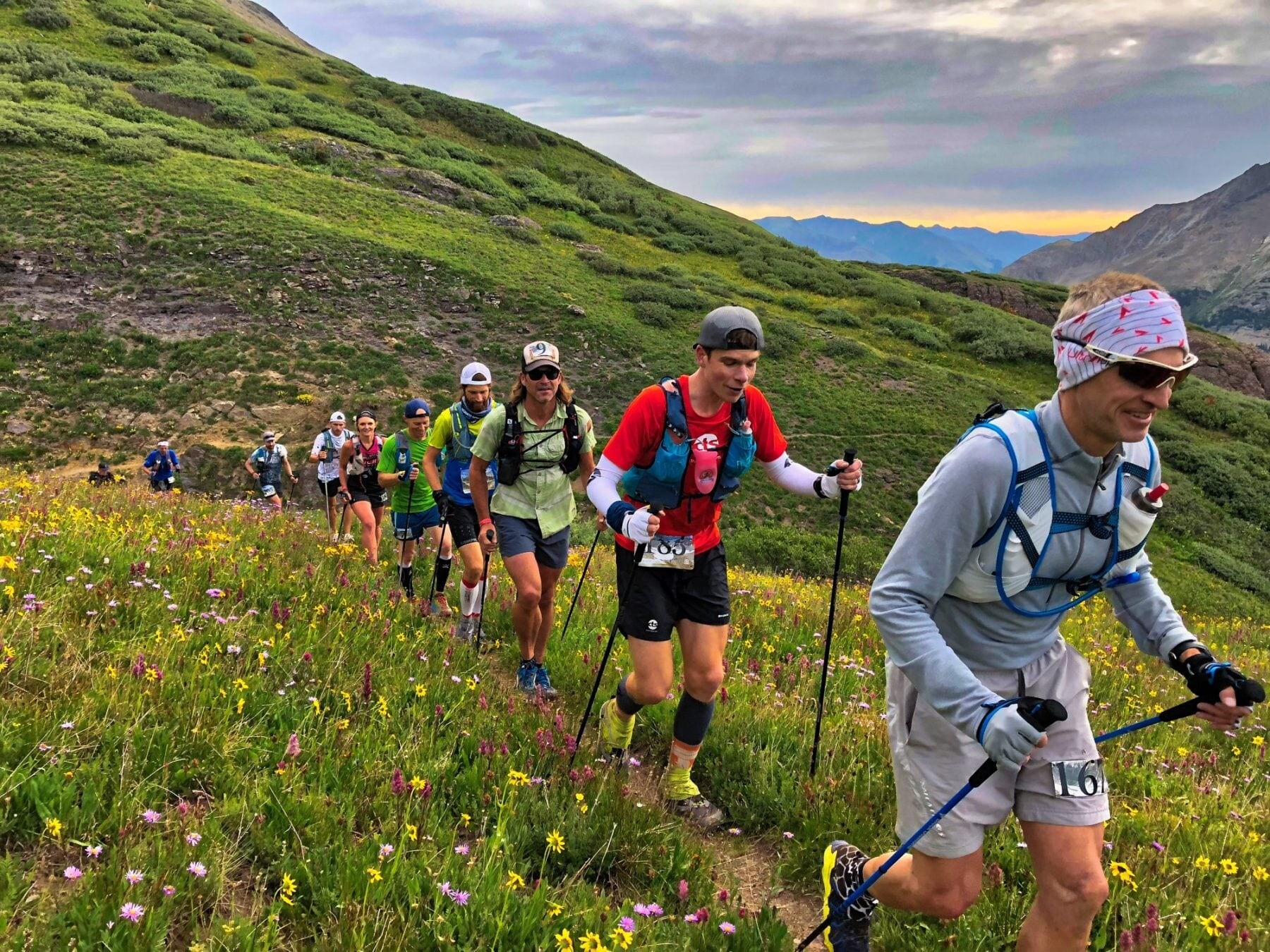
All eyes are on the phenomenal Dauwalter this year (but when are they not?) after a stunning performance three weeks ago at Western States, where she set a blistering new course record (78 minutes faster than Canadian Ellie Greenwood’s from 2012) and placed fifth overall. Canada’s Stephanie Case, who was second last year, has withdrawn from this year’s event. 60-year-old legendary ultra machine Pam Reed of Jackson Hole, Wyo., will be tackling the third part of her WSER/Badwater 135/HR100 triple this year.
Leadville, Colo.-based Dauwalter holds the course record for HR100 in the clockwise direction (26:44) from 2022; this year runners will move counter-clockwise, and that course record is 27:18 for women, set by Diana Finkel in 2009, and Dauwalter will most certainly be looking to challenge that time. Will her legs be tired? Will she win the entire thing? We can’t wait to find out.
Also from Leadville, 23-year-old trail phenom Annie Hughes won the Run Rabbit Run 100-Miler and High Lonesome 100 Mile in 2022, and the Leadville 100 Mile in 2021. She’s a high-altitude ultrarunning champ, and has also compiled some wins in really long races–she won the Cocodona 250 Mile in 2022 and Moab 240 in 2021.
If you haven’t heard of France’s Claire Bannwarth, it’s time to brush up: she was the first woman in the 432-kilometre 2022 Winter Spine Race (by more than 24 hours), and will be making her North American racing debut at HR100. Bannwarth races prolifically and runs long–she will be jumping into the Tahoe 200 Mile race a week after HR100.
Colorado’s Darcy Piceu, fresh off the waitlist, is a veteran of HR 100, with the 2023 edition being her 10th running. Piceu boasts three wins and five second-place finishes, and she was fourth in 2022.
The men’s race
With Kilian Jornet, last year’s winner (and course record holder in the clockwise direction) not returning this year, the podium seems up for grabs. None of the other top four men from 2022 will be headed to the San Juans, but a very accomplished group of athletes will be lining up and fans will be eager to see who holds up to the HR100 test.
Ohio’s Arlen Glick is a master of the 100-mile distance, running 12:57 to win the Umstead 100-miler in April and taking a speedy third at October’s Javelina 100. Like Dauwalter, Glick raced at WSER last month. He placed 14th, while he took third in 2022. Glick will be a hot contender and fascinating to watch at HR100.
California-based Dylan Bowman is a Hardrock veteran, placing second at the 2021 edition. Bowman has had a lower racing profile in the past year while working on Freetrail, a media business and trail running community. He’s been training in the San Juans pre-race and is eager to showcase his ability.
France’s Aurélien Dunand-Pallaz has over 10 years of ultrarunning success, but gained notoriety in 2021 when he took second at UTMB and won Spain’s Transgrancanaria. He missed the 2022 edition of HR100 for the birth of his child and is a favourite in his debut this year.
Oregon-based trail running legend Jeff Browning will be taking on his sixth Hardrock at age 51. Browning won in 2018, and finished fifth the past two years. In October, Browning won the Moab 240 in 57 hours, and more recently, he showcased his fitness by winning the Bighorn 100.
by Keeley Milne
Login to leave a comment
Hardrock 100
100-mile run with 33,050 feet of climb and 33,050 feet of descent for a total elevation change of 66,100 feet with an average elevation of 11,186 feet - low point 7,680 feet (Ouray) and high point 14,048 feet (Handies Peak). The run starts and ends in Silverton, Colorado and travels through the towns of Telluride, Ouray, and the ghost town...
more...2023 Western States 100 Women’s Race
None of the first four women from last year’s race — Ruth Croft, Ailsa MacDonald, Marianne Hogan, Luzia Buehler — returned. That made Zimbabwe’s Emily Hawgood (pre-race interview) the highest returning finisher from 2022. Hawgood’s pretty much a race local now too, living in nearby Roseville, California. But it was 38-year-old Courtney Dauwalter (pre-race interview) that came into the race as a favorite. She won here in 2018 in 17:27 and was looking to avenge a late drop at the 2019 race.
Dauwalter was first up the Escarpment. At 2,500 feet, it’s the race’s biggest climb and it happens right away in the first three miles. But 2022 UTMB winner Katie Schide (pre-race interview) was right there too. Schide, an American who’s lived in France for the past seven years, hit the top in 46 minutes with Dauwalter and the two dropped into the Granite Chief Wilderness together. Already Dauwalter and Schide, age 31, had a three-minute lead on third-place Ida Nilsson (pre-race interview) from Sweden.
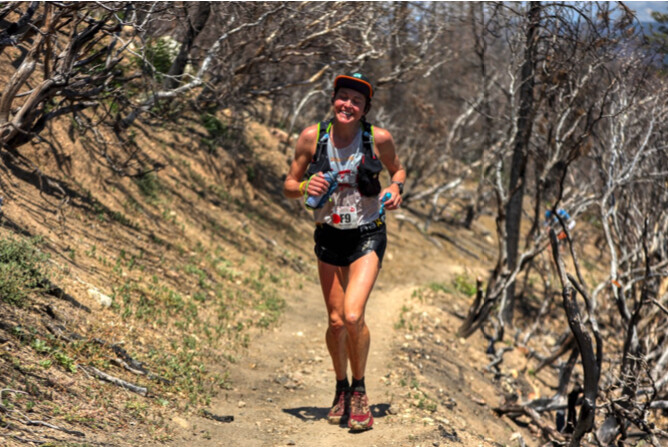
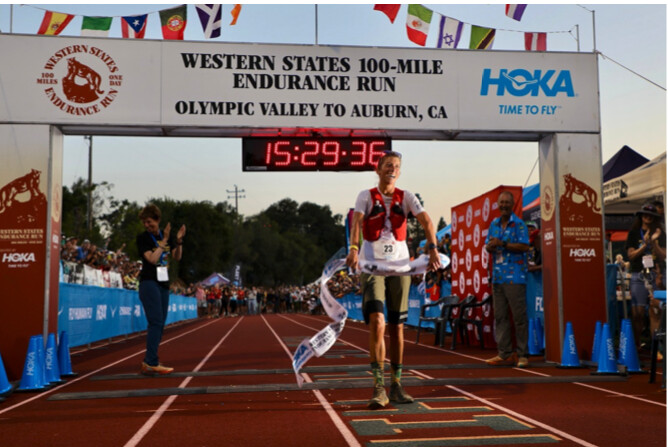
By mile 11, Lyon Ridge, Dauwalter and Schide’s lead on third-place Nilsson had ballooned to eight minutes. And then it got even bigger as the two completely broke away from everyone else. At mile 16, Red Star Ridge, no one was within 14 minutes of the front two. Nilsson, Hawgood, 2023 Black Canyon 100k winner Keely Henninger (pre-race interview), Taylor Nowlin, professional triathlete-turned-ultrarunner Heather Jackson, Canada’s Priscilla Forgie and Jenny Quilty, and 2022 sixth-place finisher Leah Yingling (pre-race interview) all ran inside the early top 10.
The Mosquito Fire limited crew access this year and everyone met their crews for the first time at mile 30, Robinson Flat. Dauwalter was in at 5:07 and out within a minute, and still on her 2019 splits. Schide took a longer break and changed shoes, exiting the aid station three minutes behind the leader. The two had completely broken open the women’s race. Nilsson, in her 100-mile debut, had been alone in third to this point, but was now joined by Henninger, Hawgood, and Nowlin.
At mile 34, Miller’s Defeat, the course record watch started. Dauwalter and Schide were under Dauwalter’s own 2019 splits and Ellie Greenwood’s 2012 course record pace. Dauwalter was five minutes up on Greenwood’s splits, and Schide was three minutes faster. Even more, the two were over 30 minutes in front of third-place Hawgood at mile 38. Dauwalter and Schide were out front for the win and the course record, and the other contenders grouped behind them.
Dauwalter was red hot up the Devil’s Thumb climb at mile 48, but Schide hadn’t given up much time. She took longer in aid and left six minutes after Dauwalter. Hawgood, Nowlin, and Henninger came in together next, now 40 minutes behind second-place Schide.
At Foresthill, Dauwalter was 25 minutes up on record pace. Schide conceded only another two minutes over the last stretch and was 11 minutes behind Dauwalter. While Dauwalter and Schide were still off the front, the race dynamic was heating up behind. The third- through eighth-place women were all in Foresthill together with only three minutes separation. Hawgood was there first among the chase group, but Hungarian living in Hong Kong Eszter Csillag quickly jumped from eighth at mile 52 to fourth at mile 62. Nilsson was fifth, and Henninger, Katie Asmuth, and Nowlin were all there too.
Dauwalter ran 2:10 from mile 62 Foresthill to mile 78 at the American River. Only the men’s winner would run a quicker split on this day, and only eight men have ever run a faster split in the race. Dauwalter was five levels better than everyone else, and she was boldly racing without a pacer too. Schide stayed comfortably in second, but fell further behind Dauwalter’s quickening pace and river conditions necessitated that everyone cross the American River in a boat this year.
From Foresthill to the river, Katie Asmuth vaulted into third, past Eszter Csillag and Ida Nilsson. Asmuth was seventh at Foresthill and picked up four spots on the downhill Cal Street stretch, outrunning common expectations in coming back from injury. All three women split faster from Foresthill to the river than Schide did and even if the front two were gone, the women in general were running really fast. There’s bound to be some bad luck in a 100 miler though, and Henninger fell just before the river and dislocated her shoulder. She would then drop from the race at mile 80, Green Gate, due to that injury.
Dauwalter’s incredible second half and incredible race brought her to the Placer High School track finish in 15:29. Dauwalter completely shattered the record books and set a new standard that is likely to last for a lifetime. Ellie Greenwood’s 16:47 course record had stood since 2012. Dauwalter will next race the high altitude 2023 Hardrock 100 in Silverton, Colorado, on July 14. Dauwalter is the Hardrock course record holder, too, but Western States plus Hardrock will certainly be a challenging double.
Schide challenged Dauwalter early, and outpaced the rest of the women’s field in doing so. Schide was in second for much of the day, ultimately finishing as runner up in 16:43. That was also under the old course record.
Csillag, who was fifth at the 2022 UTMB, had a remarkable second half to finish third in 17:09. It is the race’s fourth-fastest run ever. And she just edged out Asmuth, who moved up from last year’s ninth-place run to finish fourth in 17:21. Asmuth’s time was just inside of Ruth Croft’s winning time from last year, and is the race’s fifth-fastest ever.
Hawgood earned a second straight fifth-place finish. In 2022 she was able to finish fifth in 18:16 and in this year’s faster race Hawgood was fifth in 17:26. That time ranks eighth-best ever and is just faster than what Dauwalter ran to win in 2018.
Taylor Nowlin improved her finish place by one from prior year, but like Hawgood greatly improved her finish time. Nowlin was sixth in 17:40. One-hundred-mile debutante Ida Nilsson was seventh in 17:43, and Priscilla Forgie was just minutes back in eighth at 17:46. Leah Yingling was a repeat top-10 finisher in ninth at 17:49. For perspective, no year had seen more than three women finish under 18 hours before. But this year nine women finished under 18 hours. It is the new standard for women’s racing at Western States.
The 25-year-old Meghan Morgan took the prized 10th-place finish in 18:11, thereby guaranteeing a chance to automatically return next year.
by Justin Mock I Run Far
Login to leave a comment
Western States 100
The Western States ® 100-Mile Endurance Run is the world’s oldest and most prestigious 100-mile trail race. Starting in Squaw Valley, California near the site of the 1960 Winter Olympics and ending 100.2 miles later in Auburn, California, Western States, in the decades since its inception in 1974, has come to represent one of the ultimate endurance tests in the...
more...2023 Western States 100 Men’s Race
There’s nowhere to go but up at the start of the Western States 100, and Jia-Ju Zhao from China charged the opening climb. Despite snow, Zhao hit the top in 42 minutes. Slower to the top, Frenchman Mathieu Blanchard (pre-race interview) and Brit Tom Evans (pre-race interview) turned to greet the brilliant sunrise together.
Zhao won the Ultra-Trail Mt. Fuji 100 Mile in April 2023 and is a two-time winner of the Doi Inthanon by UTMB 100 Mile in Thailand. He pushed his early lead to five minutes at Lyon Ridge, mile 11, while 2022 fourth-placer Tyler Green led the early chase group. Green had finished as high as second here before, in 2021, but was running more aggressively toward the front earlier than ever before.From mile-15 Red Star Ridge to mile-25 Duncan Canyon, the chase group started to make up time on Zhao. Tom Evans, Chinese runner Jia-Sheng Shen, and Dakota Jones (pre-race interview) were among a group that cut four minutes from Zhao’s lead over just nine miles. Evans was third here in 2019 in 14:59, and Jones had just biked 680 miles from his home in Utah to the race start.
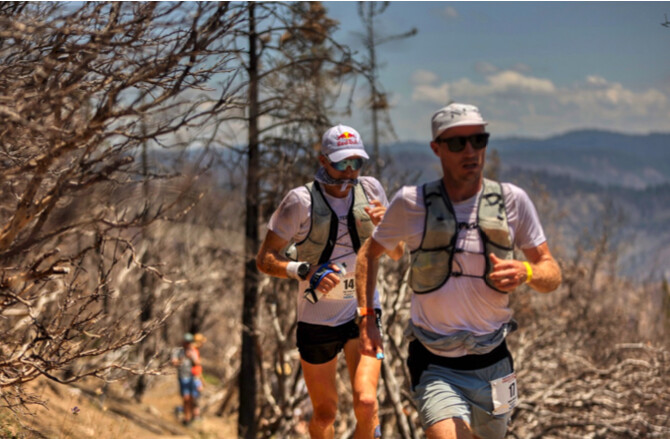
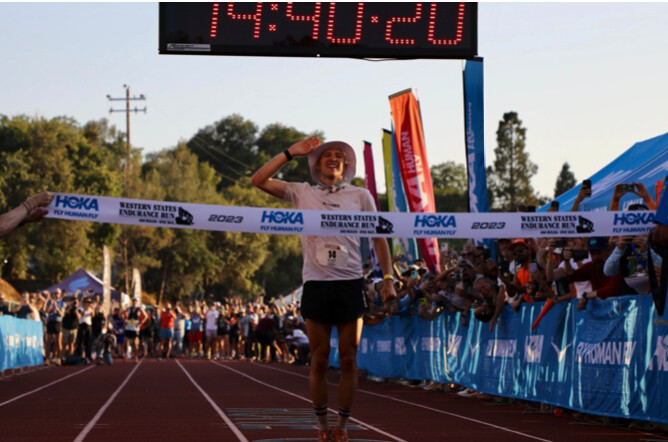
Zhao was quickly swallowed up in the next five miles to Robinson Flat, mile 30, and soon fell out of the top 10. A lead trio of Tom Evans, Dakota Jones, and Jia-Sheng Shen came into aid at 4:45, meeting their crews for the first time. At mile 30 and with Zhao falling backward, Anthony Costales (pre-race interview) was fourth, and then he was with Tyler Green at mile 38 in fourth and fifth. The two would barely separate the rest of the race.Evans and Jones dropped Shen on the climb to Devil’s Thumb, mile 48, and the two leaders came into aid together in 7:03. Four minutes back Costales had caught Shen on the big climb, and Tyler Green, Jeff Colt, New Zealand’s Daniel Jones, Ryan Montgomery, Mathieu Blanchard, and 47-year-old Ludovic Pommeret were inside the top 10. Those six were 14 minutes apart. 2022 third- and second-place finishers Arlen Glick (pre-race interview) and Hayden Hawks (pre-race interview) were back in 11th and 16th, respectively. After earlier moving up, Hawks had just lost several places and would later drop with injury at mile 55. Other top-10 finishers from 2022 Cody Lind, Scott Traer, and Alex Nichols were all noticeably outside the top 10 too.
As the race shifted to its mile-62 Foresthill hub, Evans gained some separation on Jones and entered the aid station first, but as Evans changed shoes and socks, Jones didn’t wait and exited first. Jones was now in the lead by himself for the first time and he was overheard voicing his intention to break Evans. Some 11 minutes back of those two leaders, Green and Costales were again together and in third and fourth. Shen and Jeff Colt were just minutes back of those two, and Colt was remarkably almost an hour faster than a year ago when he finished 11th.Jones and Evans separated leaving Foresthill and anticipation ran high for their next steps. The two had been together for nearly the entirety of the race to this point. Jones wanted to make a move and Evans wanted to keep up with (the) Jones. The duel ended quickly and dramatically though. Tom Evans dropped a 5:54 downhill mile and hit Cal 2, mile 71, in 10:12. That surge pushed Jones eight minutes back at mile 71. It was just nine miles from Foresthill to that split on Cal Street, but the front two had shattered and moved in opposite directions the rest of the race.
Evans ran alone to the river crossing at mile 78, and ultimately to the finish. Tyler Green, Anthony Costales, Jeff Colt, and Jia-Sheng Shen all overtook Dakota Jones on the way to the river too. Forget about Elm Street, Jones was having a bit of a nightmare on Cal Street.
Evans, the 2022 UTMB third placer, continued to put time on the field the rest of the way. He finished in 14:40 and that’s the race’s fourth fastest finish ever. The mark trails only Jim Walmsley and Jared Hazen in 2019, and Walmsley’s 2018 mark too. Evans was a runaway winner, but the rest of the top 10 was much more closely packed.Tyler Green pushed on in second, and held off an Anthony Costales chase over the last 15 miles. Green finished in 15:04. It was his second runner-up finish and a big personal best for the course. He was able to finish with his baby boy on his shoulders. Green’s 15:04 was the race’s 11th-fastest finish ever. Costales was third in 15:09, the race’s 13th-fastest finish ever.
Jia-Sheng Shen and Daniel Jones both finished fast. Shen clocked 15:19 and Jones was fifth in 15:22. Mathieu Blanchard and Ryan Montgomery both overtook Jeff Colt late. Those three — Blanchard, Montgomery, and Colt — finished in 15:37, 15:38, and 15:42, respectively. Local runner Cole Watson bettered his 2022 14th-place finish with a ninth-place 15:54.
In 2019 the top 10 all went under 16 hours. This year’s 10th-place man Janosch Kowalcyzk from Germany just missed matching that feat. He finished in 16:09.
Seven of last year’s top 10 returned, but only Tyler Green was able to again make the top 10. The 2022 top 10 finishers Ludovic Pommeret, Arlen Glick, Scott Traer, Cody Lind, and Alex Nichols finished 12th, 13th, 15th, 16th, and 28th this year, respectively. As earlier mentioned, 2022 runner-up Hayden Hawks dropped.
After running near or in the lead through Foresthill, Dakota Jones finished 17th in 17:00.
Early leader Zhao’s high risk, high reward start ended with a drop at Michigan Bluff, mile 55.
by Justin Mock I Run Far
Login to leave a comment
Western States 100
The Western States ® 100-Mile Endurance Run is the world’s oldest and most prestigious 100-mile trail race. Starting in Squaw Valley, California near the site of the 1960 Winter Olympics and ending 100.2 miles later in Auburn, California, Western States, in the decades since its inception in 1974, has come to represent one of the ultimate endurance tests in the...
more...2023 Western States 100 Women’s Preview
The 2023 Western States 100 is just around the corner and we’re here to take a look at the pointy end of this year’s women’s field. Before we get started, in case anyone needs a reminder of this unique, point-to-point, net downhill course, here are the stats for the standard course: 100.2 miles, 18,000 feet of climbing, and 22,000 feet of descending.
At the time of writing this, we don’t know if the huge snows of this winter or last year’s wildfire on the course will necessitate any significant course modifications for this year’s running. However, we know the race organization is doing everything they can to host the race on the normal course. We also know that those conditions will likely play into the competition, with snow present on the first 25 miles of the course for a spicy warm-up, as well as miles of wildfire-exposed course that’s likely to make the middle miles feel more severe than normal. And, also, we are expecting the normal race-day heat.
Last year’s race further showed how much faster the Western States women’s field has gotten in recent years. While Ellie Greenwood’s 2012 course record of 16:47 has remained untouched, 15 of the 24 fastest women’s times at the race have been logged in just its three recent races — 2019, 2021, and 2022 — with those 15 times logged by 13 different women. Ruth Croft’s 2022 winning time of 17:21 was the third-fastest women’s time ever while fifth-place Emily Hawgood’s 18:16 would have won the women’s race in all but 10 other years.

We’re in for one heck of an exciting women’s race at this year’s Western States 100. None of last year’s top-four women are returning while everyone who finished between fifth and ninth will be returning. Lining up aside those five will be another half dozen women, each of whom could make a push for the podium, including a couple of the world’s best 100-mile racers at the moment. Another dozen strong women will add to the excitement in running for the top 10.
As you’d guess, iRunFar will be there to report firsthand on all the action as it unfolds starting at 5 a.m. U.S. PDT on Saturday, June 24. Stay tuned!
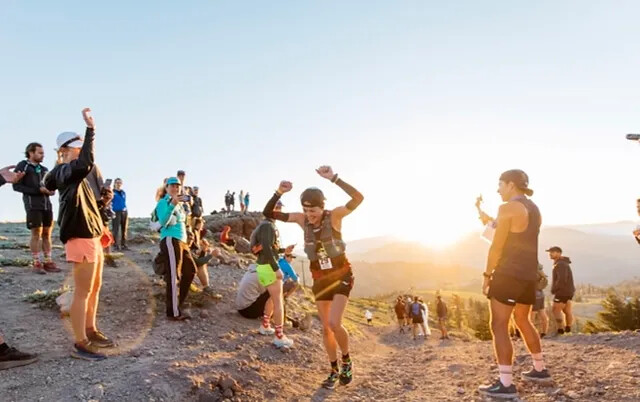
A special thanks to HOKA for making our coverage of the Western States 100 possible!
Emily Hawgood – 5th, 18:16:02
Well, look at that, Zimbabwe’s Emily Hawgood comes into the 2023 Western States 100 as the top returning women’s runner after her fifth-place finish last year. That fifth place is no fluke as over the past two years, Hawgood has been seventh at the 2021 Western States 100 as well as taking 10th and sixth at the past two UTMBs. Living over here in the U.S., she ran and won the same local 50k both last year and this February.
Leah Yingling – 6th, 18:32:31
After many years of quieter success, Leah Yingling made herself known with a great 2022 season. In addition to taking sixth at Western States in 2022, she was third at the Bandera 100k, third at the Transgrancanaria Advanced 60k, second at the Canyons 100k, and 19th at the Trail World Championships 80k. She’s started her 2023 just as strong with a second place at the Way Too Cool 50k in March and a win at the Bull Run Run 50 Mile in April.
Taylor Nowlin – 7th, 18:46:42
Although she’s run ultras since at least 2016, I’d have to say that 2022 was Taylor Nowlin’s best season to date. Not only did she take seventh in her 100-mile debut at Western States, she also took fourth at the Black Canyon 100k and ninth at CCC. We can’t find any race results for Taylor so far this year, so we’ll have to wait until race day to find out what kind shape she’s in.
Camille Herron – 8th, 18:51:54 (2022 post-race interview)
What a journey it’s been for Camille Herron at Western States! She DNFed in both 2017 and 2019 before finishing in 27:28 in 2021. She kept at it last year, finishing eighth in 18:51. I’d hypothesize that what’s sure to be a snowy course in 2023 could challenge that inspiring progression, but she’ll surely come into the race fit if her recent racing is any indication. In December she clocked 13:02 for 100 miles at the Desert Solstice races before setting the 48-hour world record of 270.5 miles this March.
by Bryon Powell
Login to leave a comment
Western States 100
The Western States ® 100-Mile Endurance Run is the world’s oldest and most prestigious 100-mile trail race. Starting in Squaw Valley, California near the site of the 1960 Winter Olympics and ending 100.2 miles later in Auburn, California, Western States, in the decades since its inception in 1974, has come to represent one of the ultimate endurance tests in the...
more...2023 Western States 100 Men’s Preview
The Western States 100 is set for 2023. The iconic point-to-point, net-downhill course takes in 100.2 miles, 18,000 feet of climbing, and 22,000 feet of descending, as it starts at the Palisades Tahoe ski resort in Olympic Valley, California, and finishes at Placer High School in Auburn.
Environmental conditions will play into the race’s competitive story this year. With record snowfall throughout the upper elevations of the Sierra Nevada, the mountain range through which the race travels, runners will encounter plenty of snow over the course’s first quarter, along with numerous high water crossings lower down as all that snow melts.
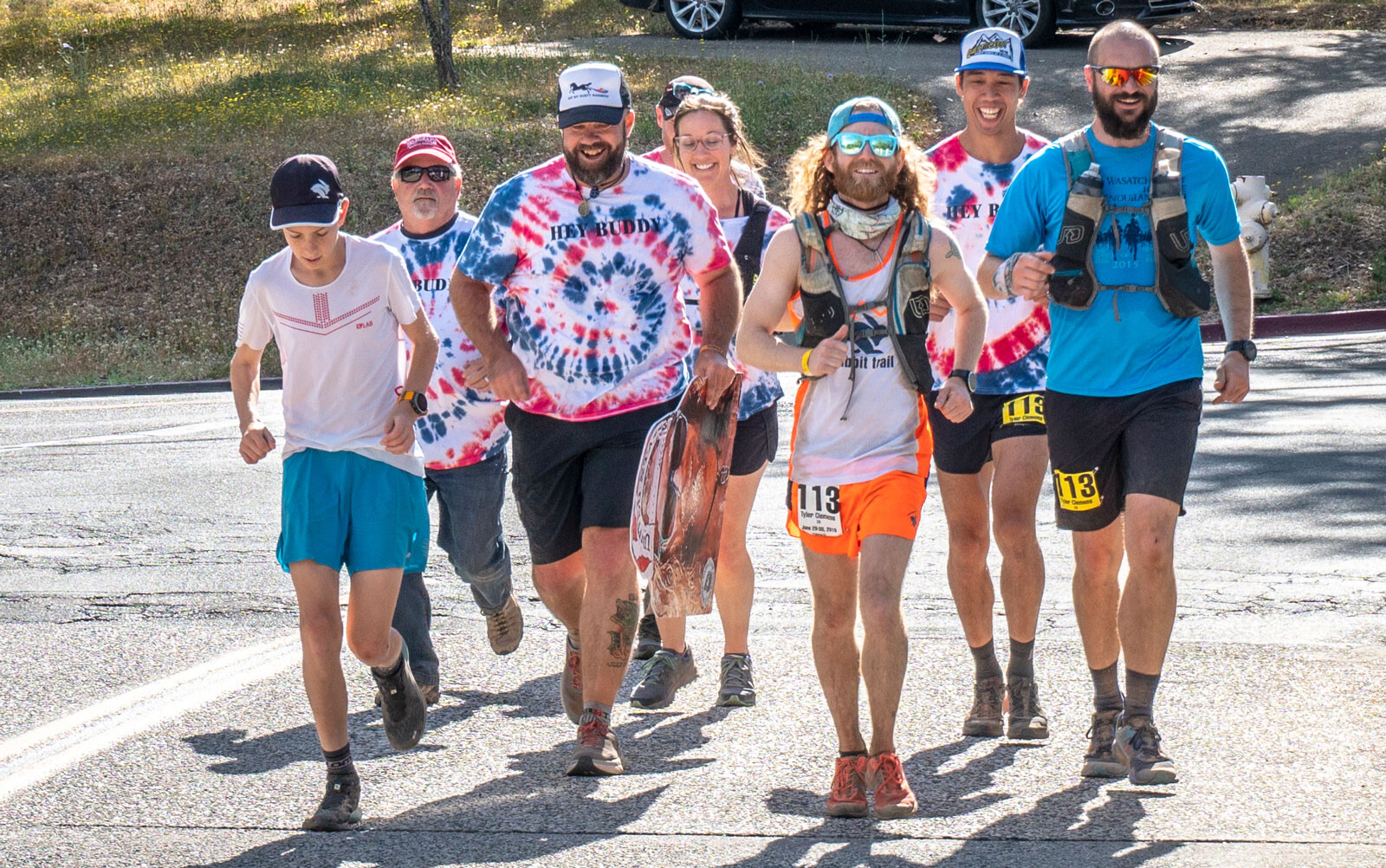
Some 16 miles of the course were burned over by last fall’s Mosquito Fire, leaving miles of shade-less terrain. And of course, there will probably be weather at play, with the event’s notorious heat likely to encompass the middle and lower elevations of the course.
The men’s race at last year’s Western States 100 was sharp, with just 50 minutes separating the first and 10th finishers. Seven of that stellar line-up are back this year, as well as some serious additions like the U.K.’s Tom Evans, French-Canadian Mathieu Blanchard, and Dakota Jones.
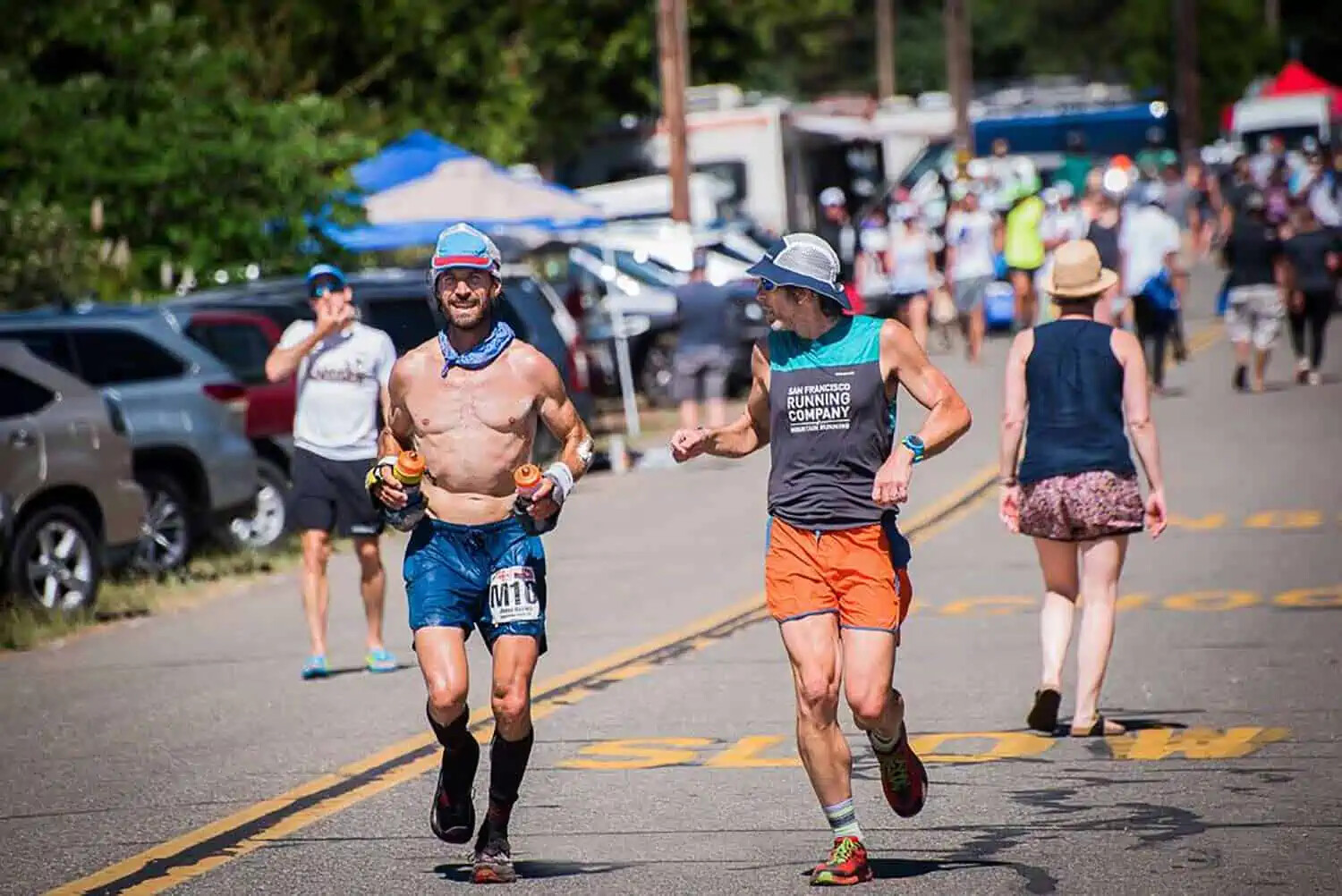
Although there are notable absentees including reigning champion Adam Peterman and course-record holder Jim Walmsley, the depth of this men’s field suggests it could be an even tighter race this year.
As you’d guess, iRunFar will be there to report firsthand on all the action as it unfolds starting at 5 a.m. U.S. PDT on Saturday, June 24. Stay tuned!
A special thanks to HOKA for making our coverage of the Western States 100 possible!
Be sure to check out our in-depth women’s preview to learn about the women’s race and, then, follow our live coverage on race day!
The top 10 runners in the 2022 race were invited to return for 2023. Unfortunately, reigning champion Adam Peterman is out with injury, and seventh-place Vincent Viet of France has opted not to return. It also looks like fifth-place Drew Holmen has withdrawn, as he just finished fifth at the Trail World Championships 80k, held in Austria 15 days before Western States.
Hayden Hawks – 2nd, 15:47:27
Last year’s second-place man, Hayden Hawks, was pretty jovial in his post-race interview about not being able to best race winner Adam Peterman. But without the reigning champion present on the start line, this could be Hawks’s year. Despite struggling with the heat last year, his finish time knocked two hours off his eighth-place finish from 2021, and there are lots of indicators that he could have more to offer on this course.
Some of his previous top performances include a 5:18 win at the 2020 JFK 50 Mile and a win at the 2018 Lavaredo Ultra Trail. So far this year, he’s warmed up by winning the Canyons 50k and taking second at the Tarawera Ultramarathon 100k.
Arlen Glick – 3rd, 15:56:17
Arlen Glick surpassed a lot of people’s expectations when he took third at Western States last year. Although he went into the race with bag of form in the 100-mile distance — having won the Javelina 100 Mile, the Mohican 100 Mile and the Burning River 100 Mile all in 2021 — this was his initiation into mountainous ultrarunning. He took to it very well, running a stormer to place third, and has since logged more mountain miles, taking second in the Run Rabbit Run 100 Mile later in 2022, before returning to the 2022 Javelina 100 Mile to place third.
Tyler Green – 4th, 15:57:10
Tyler Green took fourth at Western States last year, and forced third-place Arlen Glick into an uncomfortable sprint finish as he closed on him in the race’s final moments. In terms of placing, he was back from his second-place finish in 2021, but improved his finish time by about 14 minutes in his third go at the race. In 2019, he placed 14th in a time of 16:51, in what was a very fast year.
Following on from Western States last summer, he had a below par run at the 2022 UTMB, making it just inside the top 50, but showed he is back on form with a third-place finish at the 2023 Transgrancanaria. Last year in his pre-race interview he spoke about stepping back from his day job of teaching to focus more on track coaching and his own running, so that may have allowed him to come into this year’s race with better preparation than previous years.
Ludovic Pommeret (France)
Ludovic Pommeret, sixth at last year’s Western States, went on to inspire veteran racers everywhere with a commanding win at the 2022 TDS at age 47 — almost an hour clear of second place on the demanding route. Some of his other top performances include a win at the 2016 UTMB, where he also took fourth in 2021, and a win at the 2021 Diagonale des Fous.
He’s probably at the other end of the spectrum of Arlen Glick, in that his best performances have been on courses more mountainous than this one, but he’s still not to be underestimated.
Not many ultra-trail runners have made Kilian Jornet sweat to the degree that French-Canadian Mathieu Blanchard did at last year’s UTMB. The two battled it out all day for a close finish, in which Blanchard took second place — under the existing course record — thus earning his Golden Ticket into Western States. He’s been mixing it up a lot this year, taking second in the 146-mile Coastal Challenge Expedition Run stage race in Costa Rica, third in the Marathon des Sables, and running 2:22 in what looked like a fairly casual effort at the Paris Marathon.
by Sarah Brady
Login to leave a comment
Western States 100
The Western States ® 100-Mile Endurance Run is the world’s oldest and most prestigious 100-mile trail race. Starting in Squaw Valley, California near the site of the 1960 Winter Olympics and ending 100.2 miles later in Auburn, California, Western States, in the decades since its inception in 1974, has come to represent one of the ultimate endurance tests in the...
more...Lululemon launching six-day ultramarathon for women in 2024
Lululemon will launch a six-day ultramarathon next year–a step into new territory for the athleticwear brand that it says is aimed at promoting and better understanding the potential of women in endurance sports.
The company says the Further six-day ultra will kick off on March 8—International Women’s Day—on a certified looped course at a location to be announced. Ten athletes are slated to compete in the event: Camille Herron, Devon Yanko, Kayla Jeter, Leah Yingling, Mirna Valerio, Montana Farrah-Seaton, Stefanie Flippin, Vriko Kwok, Xiaomeng Jia and Yoon Young Kang.
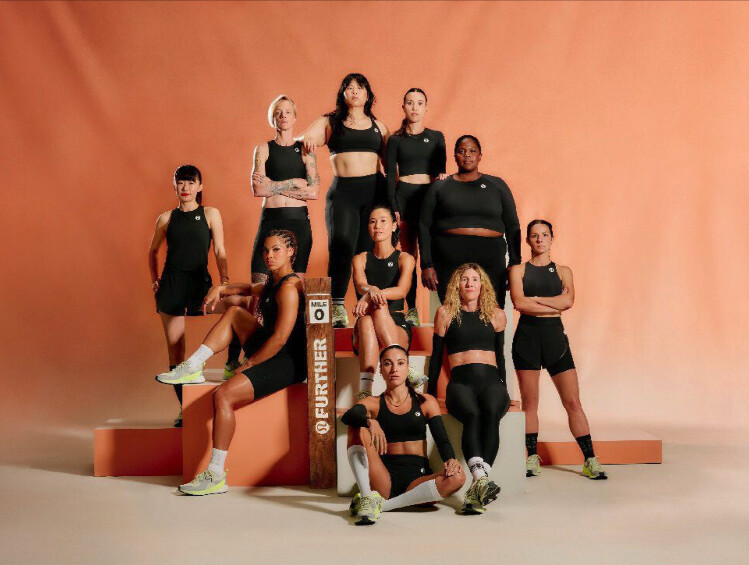
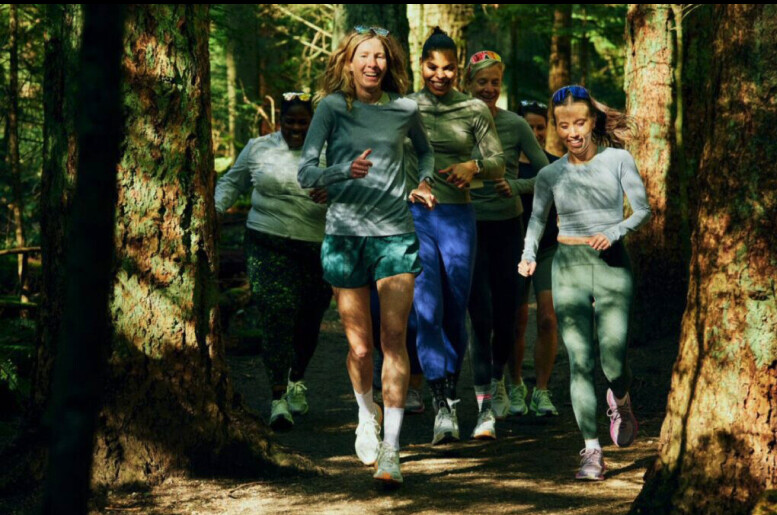
“Women are continuing to redefine what’s possible,” says Herron, the American ultrarunner who set the 48-hour women’s world record in Canberra, Australia in March by running 435.336km. “It’s important we have the platform and opportunities to showcase what we’re capable of. Further represents this to me. I’m honoured to join this phenomenal group of athletes, elevate women’s running and celebrate our human potential.”
The multi-day event will give the runners the chance to run the furthest distance of their careers with the opportunity to set world records, says the company.
Lululemon says it will be partnering with Canadian Sport Institute Pacific to conduct research studies on athletes during training and the ultramarathon itself to better understand female endurance performance and human endurance performance in general. Each athlete will have access to sport science and medicine support to inform personalized training programs spanning physical, mental and emotional support. Findings from the research are expected to be published at the beginning of March.
“Women are continuously setting new ultramarathon records, with the difference between male and female performance appearing to get smaller the further humans run,” says Trent Stellingwerf, senior adviser of innovation and research at Canadian Sport Institute Pacific. “However, there is limited research in this space, which creates a biased understanding of human endurance as women are heavily under-represented in sports science.”
Lululemon cites an an audit of select sports science and sports medicine journals that found only four to 13 per cent of published studies were female-only. The new research is intended to address the “limited knowledge around female athletes while bringing awareness to the need for additional research,” says the company.
“Women are historically underserved when it comes to opportunities to compete, research devoted to the pursuit of their goals, and product innovations built with them in mind, yet they continue to push the boundaries of human possibility in sport regardless of the inequities they face,” says Nikki Neuburger, Lululemon’s chief brand officer. “Further is grounded in our purpose at lululemon to unlock greater possibility and well being for all, and we see it as an opportunity to better serve women, solving for their specific unmet needs. With Further, we aim to inspire belief in what is possible for women when they’re supported with resources typically reserved for men.
Canadian multi-day ultramarathoning pioneer Trishul Cherns tells Canadian Running that while organizing a multi-day race may seem to some as unusual territory for Lululemon, he sees many positives in the Further project.
“From my perspective, it puts the spotlight on something close to my heart, multi-day running. The goal of the Global Organization of Multi-Day Ultramarathoners (GOMU) is to make multi-day running mainstream,” says Cherns, who adds the Further project “puts a spotlight on women in multi-day running. Ultramarathons are not just 100 mile trail runs; they are diverse–10-day, 1,000-mile, 3,100-mile races on tracks on roads—just like the group of women that make up this project.”
He applauds Lululemon’s effort to invest more resources and attention to women’s sports. “Their focus is on data capture to further sports science and research on women’s endurance. Brava!” says Cherns. “It’s very true that women are sorely under-represented in the research data and the science of female performance is marginalized or non-existent … Only recently has the discussion of women’s menstrual cycles on sports performance even been openly talked about by women athletes, let alone the subject of serious study.”
Along with its announcement of the Further multi-day ultramarathon, Lululemon unveiled the Blissfeel Trail, the company’s first road-to-trail running shoe. The company says the insights it gains from the Further project will help the company expand on products designed to support women as they go further on their runs.
by Running Magazine
Login to leave a comment
Unexpected ways bib pins can hold your race together
Safety pins might just be the most overlooked, but essential, bit of running gear on race day. Woefully neglected—I can’t count the number of times I’ve slapped myself on the forehead with an “I forgot pins!” on my way home from a race expo—bib pins do the heavy lifting for our paper-mounted timing chips as well as helping draw the line between the rule-abiding runner and the unbibbed “bandit.”
For trail runners, these sharp and shiny unsung heroes are particularly precious, as I was reminded last weekend during my attempt at running 100 miles at the Sulphur Springs Trail Race in Ancaster, Ont. I only made it 100 km, but my race would have ended much sooner had I not used my bib pins in unintended ways when things started to fall apart. Here are a few ways bib pins have come to my rescue that may be helpful to keep in mind when you have to MacGyver your way out of trouble on the trails.
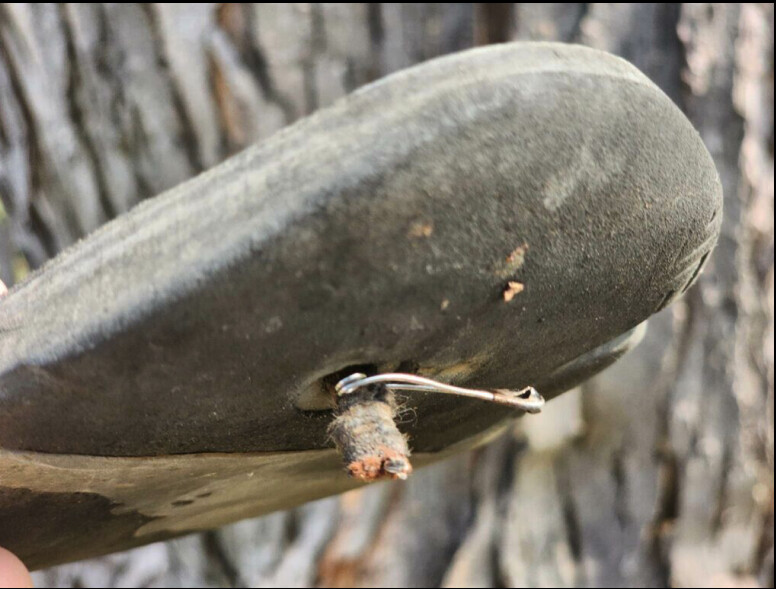

Emergency repairs
For my third 20-km loop at Sulphur Springs, I switched from shoes to sandals, as my feet have a tendency to puff up like bread in the oven. Seven kilometres into the loop, the whatchamacallit that kept the straps of my left sandal connected to the sole broke off, making the sandal unwearable. I texted my wife/crew leader to meet me a bit further down the trail with my backup footwear. It was only when I saw her, after she had run 20 minutes to bring me exactly what I’d requested, that I remembered I couldn’t take the footwear from her. (Having her carry my gear is against the race rules, and would disqualify me.)
I hung my head, contemplating having to run the next 13 km barefoot, but a glimmer of light from the corner of my race bib caught my eye. Eureka! I removed the shiny bib pin, threaded my sandal strap through the hole of the sole, and fastened the safety pin to the bottom. To my surprise, the bib pin kept my sandal from unravelling for the rest of the loop. That one tiny pin took care of everything (except the apology I owe my wife for making her run all that way for nothing).
Clutch adjustments
My longest training run leading up to Sulphur Springs was 60 km. Those long runs are crucial, not just for getting your body and mind in shape, but also for testing your gear for comfort and fit. My new hydration vest passed all the quality-control tests during my training: it was snug and comfortable and its pockets gripped my water bottles firmly enough that I didn’t have to hear “squish, squish, squish” for hours on end. But on race day, at around the 75-km mark, that vest turned into an iron maiden, inflicting untold pain as it rubbed against my upper torso. I tried applying more lubricant to my chest, but it was useless, as the damage was done, and I was going through too much liquid to risk going without it. What saved the day, or at least made it bearable to continue for another 25 km, was taking two pins from my race bib and using them to cinch either side of my vest. That crucial adjustment kept my vest from rubbing against the worst hotspots.
Blister management
I haven’t had to perform an emergency blisterectomy for a while, not since I learned to throw sandals into the mix. But on my first 50-miler at Sulphur Springs some years back, my ever-swelling feet outgrew my toebox. They say you can’t make an omelette without breaking a few eggs, and sometimes the same holds true for trail runs and blisters. It’s never pretty, but using a bib pin to pop a blister can at least make continuing on your race bearable. I don’t recommend letting the pin do all the work, as it can raise the risk of infection—use a small bottle of alcohol to sterilize the pin, and bandages to keep the deflated blister tightly wrapped. This will help your feet stay as comfortable as possible.
by Running Magazine
Login to leave a comment


